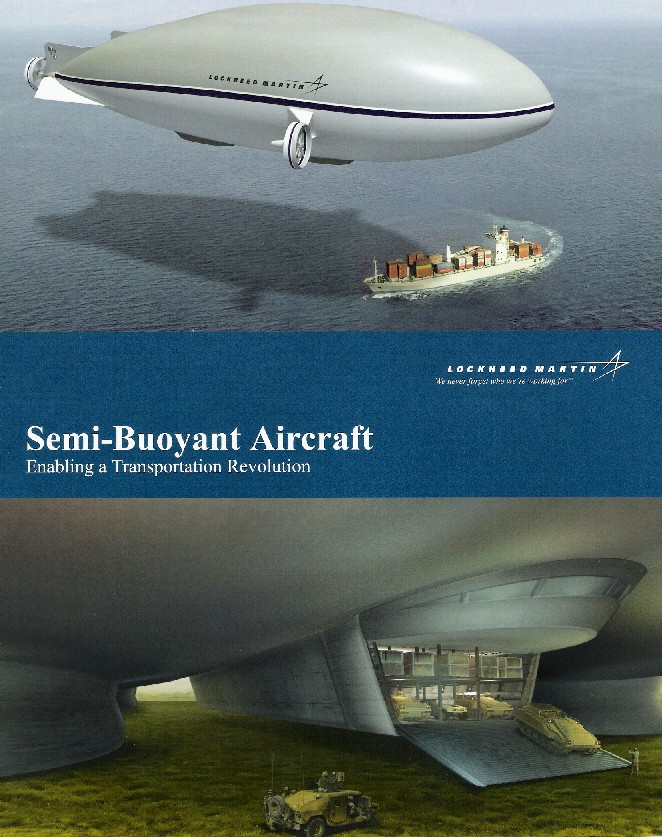
"He who can no longer pause to wonder and stand rapt in awe, is as good as dead; his eyes are closed. To raise new questions, new possibilities, to regard old problems from a new angle, requires creative imagination and marks real advance in science. Logic will get you from A to B. Imagination will take you everywhere."
LIGHTER-THAN-AIR
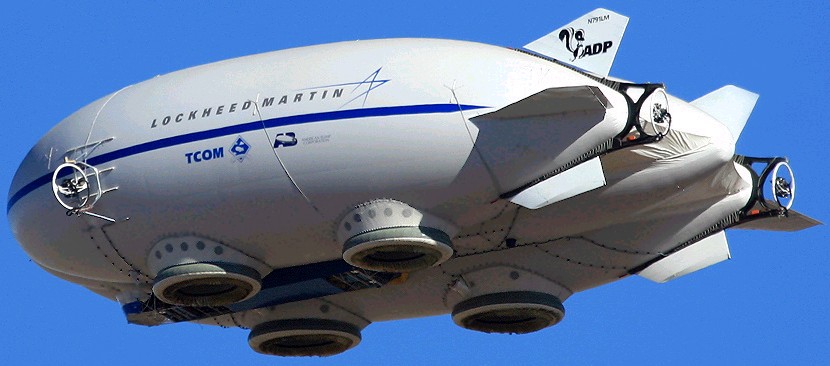
youtube.com/watch?v=W3n5cUaG5fg
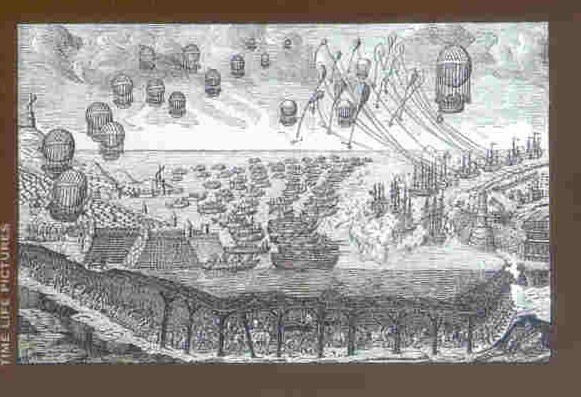
 USAF officers want Hybrid LTA Strategic Airlifters with air cushion landing gear to create suction with the ground for connection to the ground when landing even in high winds!
USAF officers want Hybrid LTA Strategic Airlifters with air cushion landing gear to create suction with the ground for connection to the ground when landing even in high winds!
Air Force Journal of Logistics, Volume XXIX, Number 3/4 File Format: PDF/Adobe
The first known way (that at least historians accept) for men to fly was by Lighter-Than-Air aircraft. Today's Lockheed-Martin "Skunk Works" P-791 LTA hybrid heavy lifter with air-cushion landing system (ACLS) is a good contrast for the drawing of the LTA balloon attack envisioned during the 1800s. LTA hot air ballons probably were used by even ancient peoples. We think Leonardo Da Vinci discovered LTA and probably flew the first gliders by men in the post-ancient era judging from his mysterious art work showing scenes only perceptable from the air and his strange health problems we suspect received from glider crashes.

"For once you have tasted flight you will walk the earth with your eyes turned skywards, for there you have been and there you will long to return."
- Leonardo da Vinci (1452-1519)
Da Vinci destroyed most of his books pertaining to military inventions so one has to wonder what he was actually able to do.
The drawing above show's Napoleon Bonaparte's idea for airborne mine attack on the British.
LTA is making a big comeback since America's military needs to move anywhere across the globe and deliver tracked AFVs to then dominate a fight. Agile see-thru blimps that can remain undetected are also needed to provide 24/7/365 continuous overhead presence to smother insurgencies in sub-national conflicts.
Agile Clear HyperBlimp Model shows Sky Camouflage, too

Robert Rist and Brian Martin founders of Ohio Airships, Inc. of Mantua, Ohio, presented a slide show on the company's Dynalifter prototype now under construction.
Airborne Aircraft Carriers & Chuck Myers' HULA
www.navyleague.org/sea_power/jul_03_01.php

Speed, Huge Payloads Are Attractive But Experts Remain Wary of Uncertain Costs
The comeback trail for military airships is getting wider and smoother in the aftermath of Operation Iraqi Freedom. The conflict underscored once again the military's need to rapidly transport huge volumes of defense materiel long distances at rapid speed, especially to landlocked areas. The sight of the 4th Infantry Division's equipment awaiting off-load in the Mediterranean made some defense strategists more determined than ever to infuse the Pentagon's logistics chain with greater speed and flexibility. The unit was assigned to northern Iraq, but Turkey refused access rights to the United States.
Army Lt. Col. Michael Woodgerd said "40 to 50 x C-17s would not have changed the fate of the 4th Infantry Division. Airships could have made a difference."
Woodgerd works on ultra-large airlifters and other lighter-than-air issues for Arthur K. Cebrowski, the Pentagon's director of force transformation. They view airships as a potential transforming technology that could place a sustained competitive advantage in the hands of U.S. forces. In a Sea Power interview in June, Cebrowski said the Navy soon would come under "tremendous pressure to improve high-speed lift." In addition to very high-speed ships, the solution will be found "in work on airships. Probably, but not necessarily, hybrid airships."
Other high-ranking Pentagon strategists are touting the values of lighter-than-air vehicles as a means to speed up the Defense Department's transportation system. Vice Adm. Joseph W. Dyer Jr., commander of the Naval Air Systems Command (NAVAIR), told other members of the Navy's senior air staff that a lesson of the Iraqi war is the need to reduce the build-up time prior to a campaign. Speaking at the Naval Aviation Symposium 9 May 2003 in Pensacola, Fla., Dyer said he is assessing lighter-than-air craft as a means to rapidly deploy forces to world hot spots. Other possible solutions, Dyer said, are seaplanes or Wing-in-Ground Effect craft that resemble flying boats and travel over the water on the air cushion created by their own hulls and wings.

NAVAIR has done some preliminary work on a conceptual family of hybrid aircraft called HULAs, or Hybrid Ultra-Large Aircraft. Envisioned for several military missions, especially long-range heavy lift, the HULAs would be lighter-than-air vehicles with a payload of several hundred tons. NAVAIR is discussing the concept's feasibility with the Pentagon's Defense Advanced Research Projects Agency.

Airships also are being developed for other defense tasks, such as border surveillance and telecommunications relay. The Missile Defense Agency (MDA) is developing the High-Altitude Airship (HAA), an unmanned craft for surveillance tasks linked to border security missions that would operate at about 70,000 feet. The Aeros Corporation, Tarzana, Calif.; Lockheed Martin's Naval Electronics & Surveillance Systems-Akron unit, Akron, Ohio; and Boeing's Unmanned Systems Unit, St. Louis, Mo., have contracts to further develop the HAA concept.
The comeback of lighter-than-air vehicles in the military began, sort of, in 1985 with the launch of an aerostat at High Rock Grand Bahama Island by the Coast Guard and the Customs Service. Today, the Tethered Aerostat Radar System created to search for drug traffickers is run by the Air Force and comprises about a dozen radar aerostats at sites from Ft. Huachuca, Ariz., to Puerto Rico. Purists would not consider them true airships, however. The last flight of a genuine U.S. military airship occurred in 1962 when the Navy disestablished its lighter-than-air unit at Lakehurst, N.J.
The resurgence of U.S. military airships depends in large part on the fate of programs like the HULA and HAA. Typically, conceptual efforts like these lead to traditional defense procurement programs to fulfill a military requirement. Cebrowski's Office of Force Transformation favors a different approach: the creation of what Woodgerd calls "a value network" to encourage and accelerate the development of lighter-than-air vehicles by government and industry. The utilization of the vehicles would be based on the Civilian Reserve Air Fleet (CRAF) program, and the Voluntary Intermodal Sealift Agreement, which permit the Pentagon to mobilize civilian aircraft and ships, respectively, in time of war.
Therein lies a hitch, however. Industrial use of airships is minimal and limited primarily to advertising. That is why Woodgerd wants to bring together government and commercial organizations that share an interest in lighter-than-air vehicles, or simply in the things that airships can do. Large construction firms and gas and oil companies, which move huge payloads, could be among the Pentagon's partners should some sort of sharing arrangement materialize, Woodgerd said. Currently, industry interest in airships is limited to feasibility studies on moving large payloads over difficult terrain, such as in the Arctic or Siberia, said an industry source.
Nonetheless, the tremendous potential of lighter-than-air vehicles continues to entice military strategists. Airships would not need airfields for their operations. The loading and off-loading of weapons and materiel would be radically reduced. And airships could bypass choke points and even operate from sea bases.
Equipped with airships, military forces could move tons of materiel at approximately five times the typical speeds attained today, Woodgerd said. Current modes of transportation, principally sealift, require 32 days to ship six Army Apache helicopter battalions from Ft. Campbell, Ky., to Saudi Arabia. Using airships, the first helicopter attack battalion would be ready to fly in 13 days, according to Woodgerd's calculations. Three attack battalions would be ready for operations in 26 days, he told Sea Power, while the remaining command and support units would be on-scene in 32 days. He bases his comparison on the use of 20 notional airships with the capabilities of the Cargolifter 160, named after the German company that designed it. The airships would be deployed in CRAF-style phased airlift.
Woodgerd, who began working on airship issues in early 2000 at the Center for Army Analysis, said the airships of old "reached their technological end-point in the 1930s, but the technology has advanced" and it is now possible to build much larger, safer airships. It remains to be seen whether the benefits outweigh the costs in military and commercial markets.
Heavier-Than-Air (HTA) Flight Schematic
PEA = Pilots, Engine and Airframe
Methods of flight
CTOL = conventional powered take-off and powered landing on wheels or tracks or skis/skids or aircraft belly
CATO-SKL = Wright brother's Flyer launched by catapult, landed on skids
STOL = take-off and landings within 300 feet
The first airplanes with thick wings and even a second set of wings (bi-planes) from 1903 to 1943 were all STOL and capable of taking off from grassy fields. From the middle of WW2 onward planes became heavier and heavier requiring longer and longer runways to the current absurdly long runway jets with thin wings to enable faster flight. Long runways are easily detected and attacked by the enemy and having to fly from them to other long runways places the pilot in a dependency and a predicament if he has an in-flight emergency or the weather will not let him reach the long runway he requires.
Why boundary layer control (BLC) or Burnelli type lifting body fuselages has not been employed to lower landing and take-off speeds so ALL planes are STOL and much safer can only be attributed to corporate greed and military ego.
300 feet or a football field can be easily smoothed by a bulldozer within a few hours.
STOLskis, STOLskids, STOLbelly, STOLtracks, STOLaircushion
The above landing gear types can rapidly slow down a plane upon landing much faster than rolling wheels except for air cushions. German gliders landed on a center skid wrapped with wire to come to a stop as fast as possible; they even landed on top of Belgian forts for a surprise attack. Air cushion landing gear would be gentler on the aircraft by keeping it completely out of contact with the ground but would facilitate STOL by increasing the places where aircraft could operate from but would need some kind of thrust reversing to keep the landing roll short.
LTO-LL = Long take-off and Long Landings over 300 feet on land or sea
The impediment to land aircraft size is the current wheels need smooth runways and widening them is costly and often not available so the Airbus double-decks its A380 into a 550+ passenger tube & wing deathtrap tragedy waiting to happen. In contrast, seaplanes have unlimited runway length possibilities and are safer when flying over oceans since they can land there in an emergency and taxi or float for rescue.
Seaplanes flying low over the water can exploit wing-in-ground effect. Someday when the airliners are bankrupt financially as they are now morally, they will see that SAFETY is the issue and maybe then they will start using safer airliners which should be seaplanes for overseas flights.
LTO-LLaircushion
If we perfected air cushion landing gear, seaplanes would not even have to touch the water and could take-off and land in very rough sea states. Land planes with air cushion landing gear would be able to land on far rougher and uneven ground than current wheels and even tracks can tolerate.
JATO-LL = Jet (actually rockets) assisted take-off to cut down on LTO run but plane has to land back on long runway
ZELTO-LL = zero length (vertical) take-off and long landing
STO-BAR = short take-off but arrested (tail hook) recovery; first Naval aviator LT Eugene Ely did this from battleship USS Pennsylvania in 1911
SKI-BAR = Russian and Indian Navies use ski jumps to launch CTOL jets using only a part of the flight deck
CATO-BAR = catapult take-off but arrested recovery; what USN planes do from large aircraft carriers today
SeaTO-SeaL (STOSL) = sea take-off and sea landing
The key mistake of the USN large seaplane patrol community in the 1940s/50s was to accept the STOSL handicap which meant the tender ship has to come to a full stop to crane the big seaplane to it or run lines to it to refuel it. In 1942, a large PBM Mariner was successfully catapulted from a barge that could have eliminated 50% of the sea state hassles so these big seaplanes would be CATO-SL like the smaller seaplanes were on destroyers/cruisers/battleships.
The Germans had earlier cat-launched 4-engined landplanes from ships from the Antarctic.
Sea landings could have been improved by having the tender ship's stern lower a ramp and have the large seaplane taxi up onto it while the ship was moving and then have it be raised from the water as SEALs come ashore today in small boats.
Certainly the USN aircraft mafia brass did not want to invest much if any R&D money into improved seaplane tenders and when they realized seaplanes even with boat hulls had been perfected by Glenn Martin to fly even faster than land planes---which are what aircraft carrier planes are using artificially crated dry landing runways on top of ships---the Navy egomaniacs had to pull-the-plug on seaplanes lest their aircraft carrier cash cow racket be revealed to the taxpayers for what it is.
JATOseatoseal = JATO sea take-off, sea landing
JATO was successfully used in COMBAT in WW2 and the post-war era to improve both large and small seaplane sea take-offs; while very helpful when the seaplanes were on their own, it still meant if on a ship tender that it would have to stop and offload them into the water for take-off.
CATO-SeaL = catapult take-off and sea landing
One of the dirty secrets the USN carrier mafia doesn't want you to know is that you DO NOT need a large aircraft carrier flight deck to launch planes if you shoot them off with catapults. The USN brass use public ignorance of this fact to squeeze money out of them for oversized supercarriers that stroke their egos and budgets. Small catapults on swiveling turn tables can launch small seaplanes without the ship having to turn into the wind to help the plane take-off.
CATO-SLskis
Had we continued operating military seaplanes it would have become apparent that a boat hull would not be necessary to land on the water since skis which can also retract to eliminate any aerodynamic drag penalty, can keep a plane afloat as long as it keeps moving. In retrospect, its too bad Stroukoff didn't convince the USN to adopt his pantobase skis because all that would then have to be done is improve seaplane tenders to have a capture rear ramp so these aircraft could taxi up onto them and be raised out of the water even while the ship was moving. The small or large seaplanes could be craned onto catapults for launch for the next mission.
VTOL
Vertical Take-Off and Landing
VTslownoisyflightVL = conventional helicopters
VTslowquietflightVL = NOTAR helicopters
VT250mphnoisyflightVL = compound helicopters
VTsubsonicnoisyflightVL = Harrier lightly loaded
VTtransonicnoisyflightVL = F-35B lightly loaded
STOVL = short take-off, vertical landing, Harrier, F-35B JSF fully loaded but uses entire LHA/LHD flight deck length
SKI-VL = Royal Navy and others to safely launch STOVL jets
Methods of Escape
PEAcrashland = no-inflight escape
This is the current immoral set-up of civilian and military transport flight. Only option is to crash and burn. Tube & wing planes are flimsy, full of volatile fuel and the seats are not even facing backwards to provide modicum of crash protection. Cheapskate airlines dangle engines under wings necessitating long stork landing gear placing people in tubular fuselage dozens of feet above the ground, if planes land wheels up, engines will grind into ground or runway, catching fire, exploding the volatile fuel inside.
PEAcrashland-BOP = in a more moral and humble past, people in military planes were at least given bail-out parachutes to escape in-flight emergencies if G forces and aircraft was not spinning too badly
PEAcrashland-ESP = as aircraft performance increased the ability of pilots to climb out became doubtful and ejection seats to separate men from aircraft and parachute to safety were fielded in MILITARY JETS. Other than one model of Russian helicopter all helicopters are crashland only.
PEAcrashland-RP = some people who want to live have not bought into PEAcrashland fatalism and have fitted ballistic recovery parachutes to some civilian planes. Some military planes have tail chutes to recovery from spins and help on landing braking. Military men think world revolves around them and if they eject from plane the civilians owe them a brand new plane and have no interest in economy at salvaging their plane by a RP or much concern that their fuel laden lawn dart may slam into the pampered civilians and kill them and their children.
PEAcrashland-ESP-RP = what should be the minimal standard in all military aircraft; planes built to crashland safely on water or land or aircrew ejects and plane descends by recovery parachute; same or differing chute for spin recovery/braking also
FIXED-WING
Fixed-wing aircraft converted from civilian airliners or bombers could only drop Paratroopers through fuselage openings and drop equipment bundles through the door or underwing shackles. This made it necessary to tow gliders to deliver artillery, jeeps and light tanks. Gliders also provided a stealthy silent, surprise landing to take out key points like bridges and forts.
Delivery means:
Forced-entry Parachutes
ALL the world's combat Airborne operations (Airdrop/Airland)
Exiting the aircraft-in-flight:

CDS bundles leave rear ramp of C-141B Starlifter
Cargo from Wing-shackles
Cargo Containers from wing ordnance hard points
Door cargo bundles
Floor cargo bundles
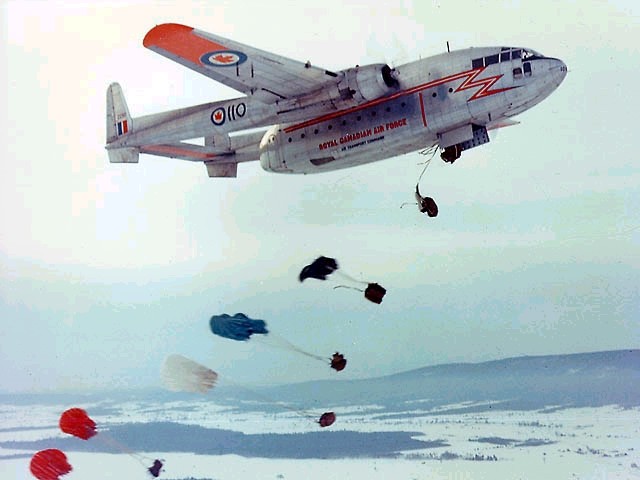
The C-119 had a "paratainer" system feed by internal monorail cables out through aircraft floor for simultaneous cargo + paratrooper drop accuracy
www.ruudleeuw.com/c119-info.htm
Chuck Lunsford wrote me the following in explanation: "that Canadian airplane is dropping 'para-tainers.' Full name was parachute containers, and they were bundles hung from a rail that went from back to front in the center of the cargo compartment. A winding motor would pull them toward the front where they would drop off the rail and fall through the hatch.The paratainer hatch was in the floor just behind the forward bulkhead. The doors in the cargo floor were opened manually inward, and the outer doors electrically or hydraulically. The switch to open them was on the forward bulkhead in the cargo compartment. Nobody knows much about dropping paratainers--I never did it, nor did anyone else I'm in contact with. We don't know if the pilot actuated the automatic drop mechanism, or if it was done by crew chief or loadmaster in the cargo compartment.
The order to drop would have been given by the pilot, but whether he had a switch, or just turned on a green light (or maybe he shouted down the flight-deck ladder) nobody knows. The only other picture I have ever seen of a 119 dropping paratainers was a C-119B/C doing it in Korea while simultaneously dropping troops. Unfortunately, I lost that picture. There may have been some safety reason we never used them, but we never did, not even in the big maneuvers where we were dropping food and gasoline to the mudsloggers of the U.S. Army. For those, we removed the clamshells, and all the drops were 'push it out the back'. "
Bill Reid wrote me in May 2006:
"The system for the para-drop from the bottom doors of the C119 was called a monarail drop. A very unreliable system, so it was not used often. The captain would notify the loadmaster over the intercom and use the light system at the same time.
I was on one monorail drop in six years of flying as a Flight Engineer. It was for an air force day airshow. We were supposed to do the drop over the runway in front of the crowd. Instead the the system jammed up and we droped across a highway and a trailer park!!
Thank goodness no damage was done and no one was hurt on the ground. The aircraft was 22131 and the date July 1st, 1961."
In May 2006 Andre Swygert made me aware of a posting on the HistoryChannel.com bulletinboard by John M Hays, which I here reproduce in part:
"I missed the opening few seconds of the segment of Mail Call tonight, about the way combat cargo hits the DZ. There were all sorts of whistles, gongs, etc., demonstrated as to how cargo gets right down on target.
Then following was a segment on the "Dollar Nineteen". I was assigned to the 921st TAG of the 433 TCW at Kelly AFB, TX. Our unit was equipped with C-119s, the newest manufactured about 1953.
The C-119 had a hard time hitting a 40 acre target with cargo using the drag (out) chutes that extracted the cargo over the DZ. Our unit's senior loadmaster (do not remember his name) noticed a long ago feature on the plane that had long ago been abandoned.....the "paratainer" gear.
The C-119 had a power cable system on which were hung paratainers (about the size of a 15 gallon grease drum) with a small cargo chute attached. There was about a 4'x 4' "bombbay" door toward the front of the cargo deck. The system was probably last used during Korean hostilities. When the plane passed over the DZ, the door was opened, the paratainer system cable was put in motion and the containers dropped out the door in the floor. The problem was that only about 4000 lbs. of cargo could be suspended on the cable and the containers' opening was pretty variable, the chute pins being pulled by a static line, rather than the chute being pulled out by the line.
Our loadmaster came up with the idea of rerouting the cable with a few new pulleys. And wrap that cable around cargo pallets to be dropped with the chutes being pulled out the packing as they exited the plane. It worked! We could hit within a few feet, instead a few hundred yards o the DZ target. I don't recall who came up with the idea of calling it "Sling Shot," but that was the system's ultimate identity. It worked like a charm.
Some of us in the PIO were drafted to document the process and accuracy with still and motion pictures.... sometimes being suspended over the back door of the plane in cargo nets with no room for a parachute ourselves.
After a year or so, Sling Shot became SOP in the Reserve units flying Dollar Nineteens. It was more accurate from 500' than a C-130 making a ground level parachute extraction approach....but the C-130 didn't have the old paratainer hardware.
Ultimately the 433rd was awarded a Loening Trophy as the best AFRes unit and we all got some kind of ribbon to wear.
The next year we flunked the Operational Readiness Inspection when the aircrews on our night drop assumed the red flares marked the DZ at old Hondo AFB. It seems that the flares marked an 18 wheeler with a load of watermelons and a flat tire. Another trucker with a similar load had stopped to help his buddy... Our three plane formation was perfect! They crushed every melon and bent severely both truck beds and smashed the cabs with the simulated "heavy loads" they deposited on that Texas Farm to Market road about 10 miles from the DZ..."
John M Hays
His posting 28Jan05
Container Delivery System (CDS) from t-tail/rear ramp or side doors
Paratroopers through hole in floor
Paratroopers through the side door(s)
Paratroopers through t-tail/rear ramp
Cargo/vehicles through t-tail/rear ramp
Descending to the ground:


C-17 Globemaster III unloads a Type V airdrop platform with ground vehicles during a LVAD at 900 feet
www.youtube.com/watch?v=x-ppX5wY5pU&mode=related&search=
Low-Velocity Airdrop or "Heavy Drop"?
Consider this.
When a HEAVY vehicle is DROPPED 5-10 feet from the rear ramp of an USAF transport planes is it a HEAVY load?
Yes, it is.
Is it being DROPPED?
Yes it is.
So really LAPES is "heavy drop", too, isn't it?
But the dumbass enlistedman-who-doesn't-know-shit, calls it by its proper acronymn but not the other form of airdrop at 600-900 feet by its proper name; in fact, he calls it "heavy drop" which is stupid because its not only the wrong term it can also describe LAPES which like a moron he calls it something else even though if he were consistant it'd be a form of "heavy drop", too.
So if you call heavy drop at 5-10 feet by its accurate term, "LAPES" but not refer to heavy drop at 600-900 feet by its proper term you LOOK LIKE AN IGNORANT DUMBASS and probably are one because its a lack of understanding and professional study that has caused you to call LVAD the slang term "heavy drop".
So thanks to a bunch of idiot "Airborne" types beating their chest that LAPES is no longer being done in typical look-at-us-we-are-doing-risky-things self-adulation, we have a moronic Army and DoD that thinks there's no way to airdrop light tanks to the battlefield because the understanding of Airborne Warfare has been short-changed by morons using slang and the CAPABILITY gets short shrift.
Go read the airdrop rigging manuals that date back to the 1960s. Its called LVAD.
Its about making WE THE AIRBORNE not look like ignoramasses not the "legs". Ignorant dumb Airborne types call LVAD "heavy drop" because it shows they haven't studied a single book on air delivery or Airborne Warfare tactics, techniques and procedures. Some folks mention "LAPES" on their web sites, but need to mention its companion technique, LVAD or else they look like snobby, arrogant Airborne dumbasses.
We need the help of Airborne veterans today to not to stroll down memory lane but to unfu*k our Airborne so we can get the Bin Ladens of this world by effective 3D maneuver that has light tanks ie; M113 Gavins parachute dropped and airlanded to surprise and overwhelm the enemy with tracked shock action not M16 versus AK47 "BlackHawk Down!" debacles.
Can we stop for one minute being the proverbial, dumbass enlisted man and think like professional tacticians?
If we keep talking about the good 'ole days while we need to LEARN SOMETHING THAT WE NEED TO USE TODAY (airdrop light tanks) there won't be any safe America to pop open a beer to enjoy a BBQ because YOU WILL BE THE BBQ--a nuclear one.
High-Velocity Airdrop
Delayed-opening
Freedrop
GPES
LAPES
GPES & LAPES had their finest hour to date at the Vietnam war battle of Khe Sanh (scroll down and see C-130 YOUTUBE videos) resupply a Forward Operating Base (FOB) safe enough for a fly-over at 5-10 feet above ground level (AGL). GPES is the better of the two techniques because the load is hooked out of the aircraft without need of even extraction parachutes but to pay for this capability, up-front the FOB on the ground must stage equipment. This is the minimalist way to airdrop supplies and it should be SOP for all FOBs to have GPES gear.
LAPES doesn't require anything from those on the ground except that it be safe to fly-over very low. It has added costs in extraction parachutes. Both techniques are very, very dangerous and are no longer SOP by the USAF after the LAPES crash at Fort Bragg shown below where the pilot actually was TOO LOW and the LAPES platform with a M551 Sheridan light tank rolled off the rear ramp and touched the ground and the aircraft at the same time, ripping the tail from the fuselage.
This accident resulted in the discontinuation of LAPES in favor of LVAD. However, what should have happened is modifying C-130 rear ramps with wheels so in event the plane is too low, a LAPES platform will not smash the ramp into the ground and rip off the tail but will slide off as the ramp rolls with the aircraft.










Follow-on Airlanding
The downside of civilian aircraft is generally they are low-wing designs resulting in the landing gear holding them high off the ground, requiring Material Handling Equipment (MHE) to lower cargo and stairs to have Soldiers walk down to the ground. Military cargo aircraft are usually high-wing designs so the fuselage is lower to the ground so a front/rear ramp from the aircraft allows roll-on/roll-off loading/unloading without need of MHE. Airland operations use different type internal loading than airdrop.
Load/offloading
Small Pallets

During WW2, the standard 40 inch by 48 inch warehouse pallet was loaded into airplane side doors using forklifts. These aircraft did not have a T-Tail or a Twin-Tail and a rear opening for airdrop so they had to land and then off-load their cargos. Today there is no reason why the Containerized Delivery System (CDS) pallets which are on plywood to slide out of aircraft don't have pallet tongue slots so they can be lifted and moved once on the ground.
463L/ECDS LARGE pallets
These balsa-wood core, aluminum covered wonders are jealously guarded by the USAF. Fragile, they don't like them abused in any way. We need a better system for fitting cargo into USAF aircraft that is not so pampered, that can be passed onto the Army without the time loss/complication of breaking bulk and returning the 463L pallets back to the USAF. ECDS seems to be the answer.
Vehicles strapped/chained to the floor
Vehicle stacking
When vehicles are loaded into aircraft often they use up floor space but leave overhead space unused; vehicles that can stack themselves like the Flyer-21 or having scaffolding like the Russians do with their AN-225 cargo jets can maximize airlift efficiency. Future vehicles should have stack capabilities whenever possible.
Flyer-21 self-stacking feature
Russian vehicles stacked inside AN-225 cargo jet
Russian stacking system scaffolding details
PLS system flat racks
A lot of time is wasted "breaking bulk" of air-delivered items from 463L pallets into truck loads even if they are slide off ERO over the rear ramp; or using MHE to move the 463L pallets until they can be broken down. The next generation USAF C-130 Hercules replacement, the ATT and the Army Chinook replacement, the FTR/JHL should employ the Palletized Loading System of flat racks to load/unload themselves, so after the cargo is off the aircraft, PLS equipped NATO/U.S. Army trucks and the Future Combat System to replace the M1/M2 series AFVs can re-supply themselves without breaking bulk. The AMS-SG proposes that the FTR/JHL be a pod-equipped aircraft that can self-propel itself in some versions, carrying inside PLS flat rack modules, or current Gavin/Ridgway/Buford and in the future the FCS.
Side cargo doors
Rear ramps
Front ramps
Side Paratroop doors
Bombbay Doors
A very interesting way to lower cargo to the ground from aircraft with elevated landing gear and vice-a-versa is to have a bombbay floor that raise/lowers by cables. This was actually done with the C-74 Globemaster I aircraft.
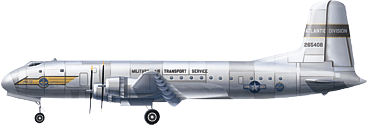
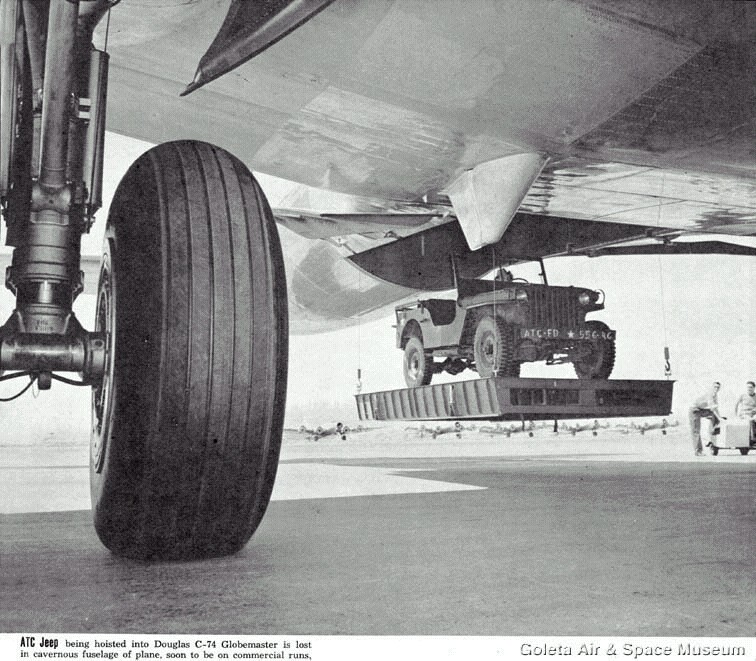
Research reveals that while the Russians were the first to air-motorize armored cars and air-mech tanks in war games by both airdrop and airland, the Germans deserve credit for the first airlanded air-motorized, air-mechanized combat operations on Crete in 1941 and North Africa in 1942. We do not buy into this notion that a military maneuver has to be in the face of enemy fire to be important, but to make the distinction for others who need the self-validation of combat, we'll refer to airland/airdrop operations into contested territory as "assault" operations. The British deserve the credit for the world's first combat air-mech assault delivering 20 Tetrarch light tanks and 9 Bren gun carriers by Hamilcar heavy glider into Landing Zone "N" on D-Day, June 6, 1944.
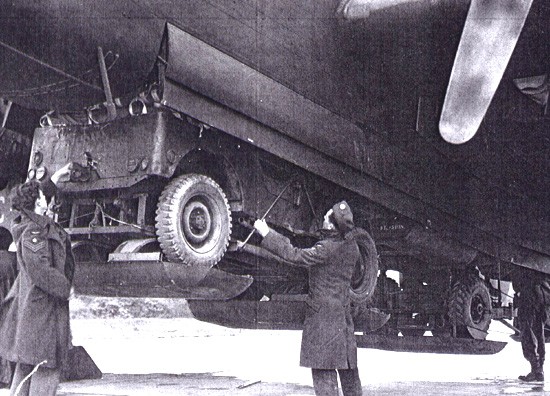
Jeep with 57mm anti-tank gun rigged to airdrop
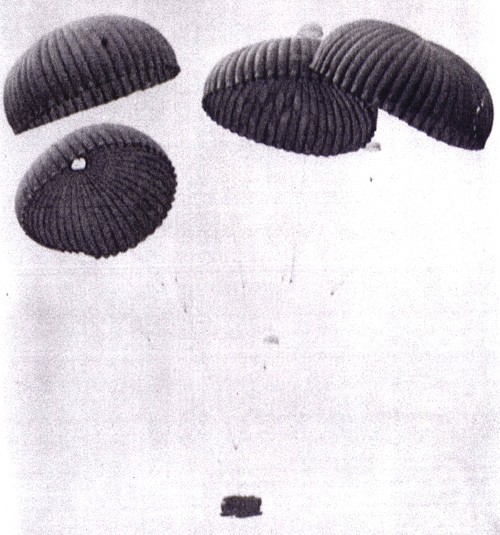
Moreover, Keith Flint reveals in his book, Airborne Armour on page 131, that on June 10th, 1944 "the Halifax squadrons involved successfully dropping six 6-pounder anti-tank guns and their towing jeeps by parachute into the airborne bridgehead" making the British the first to parachute drop wheeled combat vehicles in an air-motorized assault. What is significant about parachute vertical airdrop landing (VADL) is that if you can pay for it up front by complicated special preparations, no one has to land a fixed-wing aircraft to the ground, but simply get close or fly over the spot desired. The parachute decelerated load like the Paratrooper human "crash-lands" more or less vertically, requiring less space than sliding to a stop as in a glider. The rigging of items to do VADL is a complicated art form requiring dedicated Rigger professionals. If the parachute air items are not recovered, its very expensive for continual operations but the cash-strapped French could do multiple airborne assaults in the first Indo-China war so there's no excuse why we can't be less lazy than the current craving for a smooth runway to airland pampered USAF t-tail transport planes. What we need to do is to use sturdier TRACKED ARMORED M113 Gavins that can be VADL delivered with minimal amount of air items instead of fragile wheeled trucks like the jeep which as you will see below needs a lot of TLC to survive parachute delivery.
Translated from French into English from:
http://souvenirsas.ifrance.com/PgeLargageJeeps.htm
When British Airborne Divisions were setting-up, the question of transport, the routing and the delivery of their heavy materials was posed quickly. The glider took the principal role then, but for the SAS which operated in the greatest secrecy, using very small drop zones (DZs), the parachute remained the best means to put on the ground very heavy loads like a 4x4 small truck "jeep" for example. Its crew also had to be parachuted in separately... this operation in fact very little described and explained up to now!
It was SAS use that transformed the jeep beginning in 1944, to be able to be parachuted. The now Brigade-sized SAS reconstituted itself for future operations of unloading and of release of jeep-mobile teams into Northern Europe and it was necessary at the same time to develop all the concurrent techniques to insure the success of their missions. It was a mission common to the RAF - CLE to develop these new techniques.
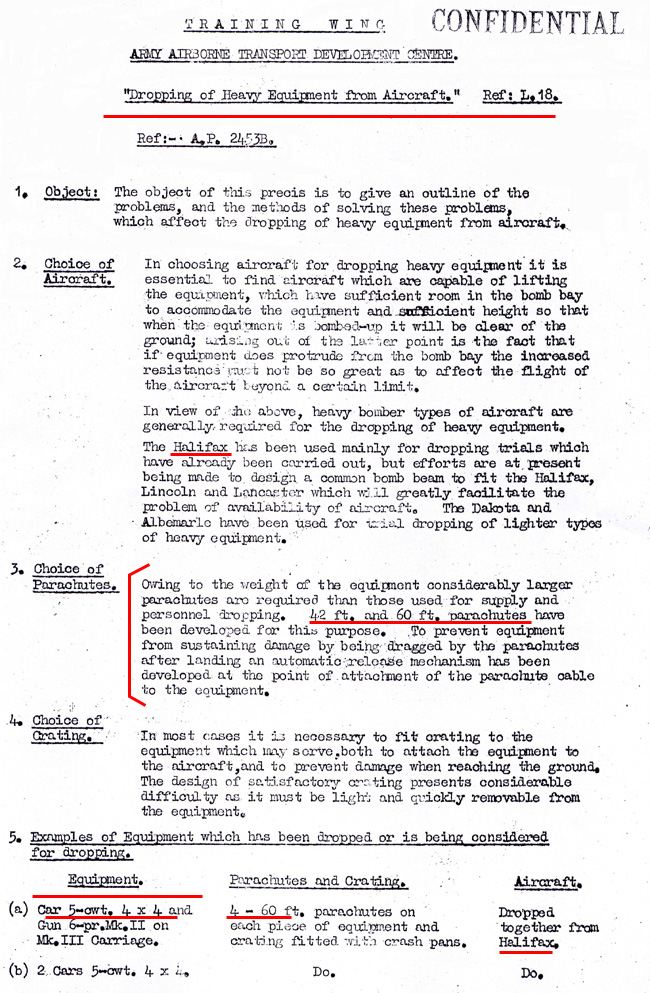
The principal transformations carried out, which all were not intended to facilitate the dropping were:
Lawful modifications envisaged by the three plans that we have in our files, M.E 8/534 and M.E 8/535 "Details of modifications for S.A.S. Cars 5 CWT 4X4" and "Details for mounting for Vickers 303 MMG one Bus 5 CWT 4X4" ME8/SK/622.
- modifications of the chassis before vehicle, statement and reinforced (see photographs)
- modification of the avoid-shock before addition of additional fuel tanks under the seat before and two side tanks protected by layers from caoutchous-foam to the back from where
- removal of the back seat
- assembly of a pivot enters the tanks to adapt a machine-gun
- possibility of oter the wheel which was on this model of jeep maintained in place by a nut "butterfly" (for the dropping)
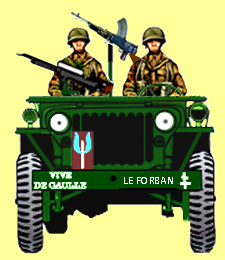
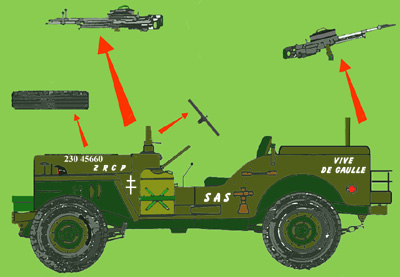
At far left flying prepared for the dropping - seen on the right, the wing nut
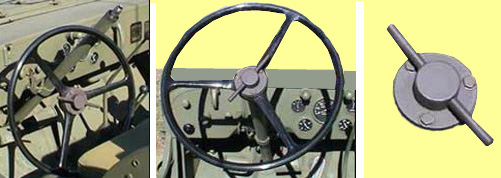
The detachable steering wheel of the Airborne jeep
Here are the problems which the RAF (298th & 644th Squadrons) had to face:
The dropping of a loaded vehicle is a very delicate operation. It is necessary to take account of multiple factors which all have their importance:
- weight of the load to be released
- its transport (out of compartment or outside)
- the system of dropping and the adapted support (plate shock absorber for a jeep for example), parachutes (some are then to create)
- constraints - weight - force of the wind - catch to the wind of the "parcel" - speed of the plane during the flight
- identification of the DZ - contact with the team on the ground - visual and radio
- the constraints approaches the zone altitude of dropping - reduction the speed of flight - direction of the wind - drift
The failure of the first droppings of jeeps at the time of the preliminary drives without protection entraina quickly, the creation of a "plate" of maintenance and transport of the vehicle provided with foam rubber shock absorbers thick to absorb the shock with the landing, straps, hooks and snap hooks of maintenance of the vehicle during all the operation. It then remained to define the model and the number of parachutes which would be useful for a successful dropping. After several tests, the parachute with heavy material, 42 foot diameter was retained. One would then use it in bunches of four per vehicle.
The unit was moreover to be easy "to dismount" once on the ground, the jeeps leaving immediately Drop Zone by their own means. The dropping at night was only authorized if the conditions which the jeeps are released is in clear weather (directives of the QG/SAS)
It as should be specified as if Airborne Divisions were installation on broad and roomy DZ, it was not the case of those used by the S.A.S which were to be discrete, very camouflaged from sight of the omnipresent enemy, very protected, that could be exfiltrated from quickly at the speed of dropping a "handkerchiefs from the pocket".
The DROPPING OF the JEEPS EAST GOVERNED LIKE the WHOLE OF the OPERATIONS Of AIR TRANSPORT AND AERO DROPPING BY "AIR MINISTRY AIR PUBLICATION N° 2453 B - ABN FORCES AND SUPPLY BY AIR - BEG DROPPING" WHOSE FIGURE IN OUR FILES COPIES; THIS ALLOWING US TO CARRY OUT EC CHAPTER
SAS jeeps had characteristics inherited from modifications made to operate in the deserts of North Africa - which already made them very different from the standard G.I. models. Thus it did not have windshields, no back bench, a machine gun mounting different from the "desert" model and which thus lost the possibility of the ground tripod firing option. One was not going to remain in one location for very long and the jeeps were still going to evolve/change throughout 1944 -1945; in particular on the level of the shielding before which was non-existant on the desert model and the models used in 1944. As for their weapons for firepower, it was decided that they would be released within containers "C". The British SAS even made use of guns as large as 37mm---which they placed in trailer of their jeeps. As was the case for Squadrons parachuted on the Center of France!
CONDITIONING OF THE JEEPS FOR DROPPING.
The three operations necessary to preparation of a jeep:
- disassembling and conditioning of the rear one
- and accessory-delivered out of containers
- installation and fixing of the vehicle on the plate shock absorber and dropping
- installation of the 4 parachutes: two on the cap and two in back place - Mle heavy loads 42 feet
* Installation with the planes:
- 1 jeep with trailer or 2 jeeps alone by Stirling
or
- 1 jeep and trailer or 57mm or 75mm towed gun or 2 jeeps by Halifax
The dropping of the jeeps required:
- that the crews are parachuted in first
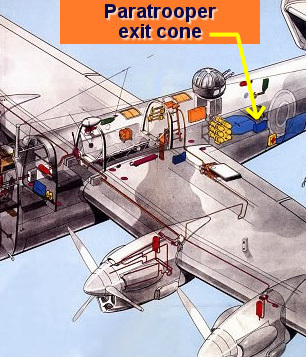
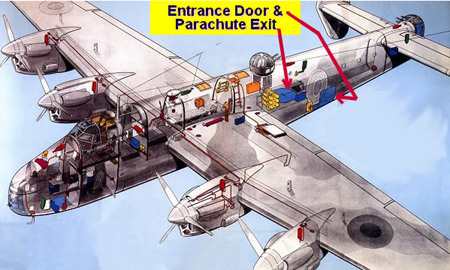
Paratrooper exit cone - "Bath-tub" of evacuation of the parachutists
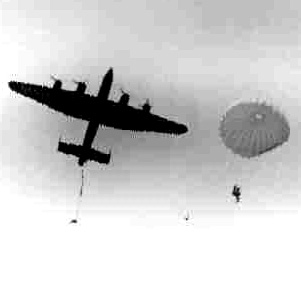
Sight of lower part of Halifax: the figures indicate the usual position of the bombs. The yellow central parts show the position of a jeep and its trailer or 2 jeeps. Under the wings the yellow sites indicate the position of containers which will be released with the vehicle.
Compartment of transport of the bombs, it is in fact under this compartment that the jeep(s) was hung
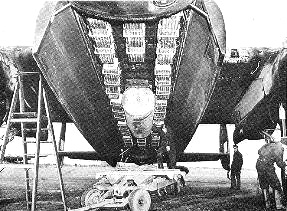
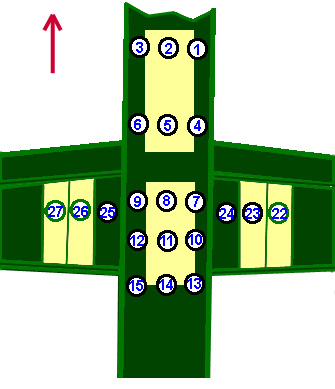
Under the wings the containers which will be released at the same time as the jeep.
- or that a time ago necessary between the parachuting and the dropping of the vehicles
- that the D.Z is recognized with the folding screen and profits from a committee of reception on the ground "
Regulations of QG SAS
Note of March 30, 1945 - Signed Prendergast
Forecasts of operation AMHERST
EXTRACT OF the BOOKLET AIR MINISTRY AIR PUBLICATION No. 2453 B - ABN FORCES AND SUPPLY BY AIR - DROPPING
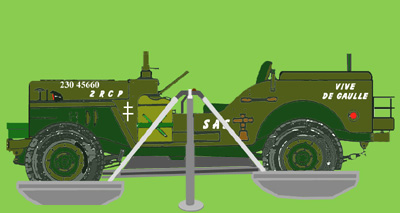
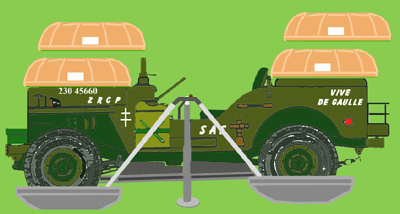
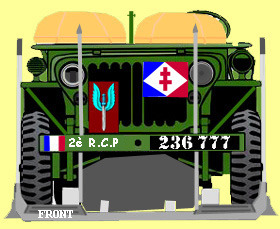
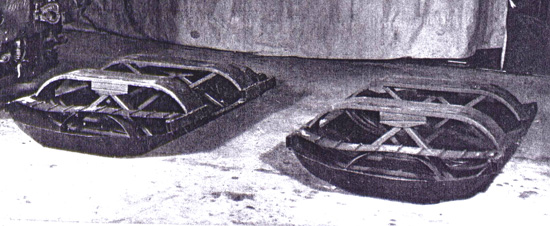
Details of the shoes officially named shock absorbers "CRASH-PANS"
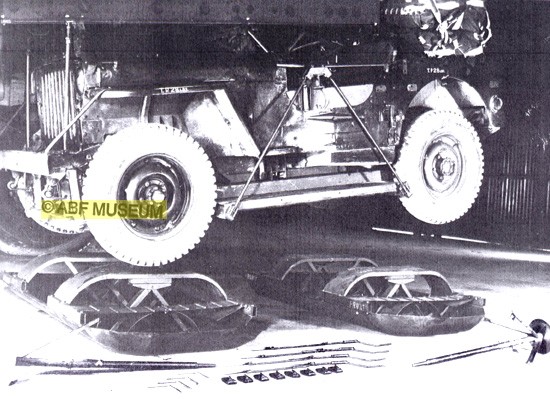
One sees clearly on this photograph, the transformation of the chassis before jeep and legs of reinforcement tube being pressed on to avoid shocking the framework of the vehicle
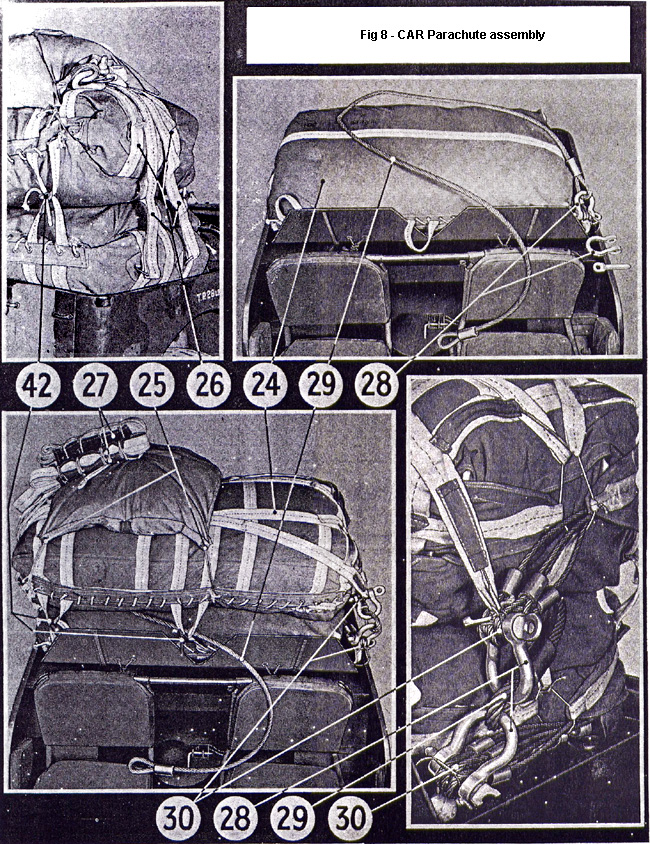
Assemblies of the parachutes on the back of the jeep. They are posed on a removable light sheet plate which covers all the back part. This plate is definitely visible on the right on the photo in top.
24. Bags of the parachutes
25. Bag of opening delayed of the straps
26. Double longes of maintenance of the parachutes in 2X2 bunches
27. Rubber band of maintenance of the automatic strap of opening
28. Snap hooks 914G type
29. Cable of suspension of the extractor-parachutes unit
30. 4 cables and 1 strap of pulling up 42 - bindings (pulling up 400 lbs.)
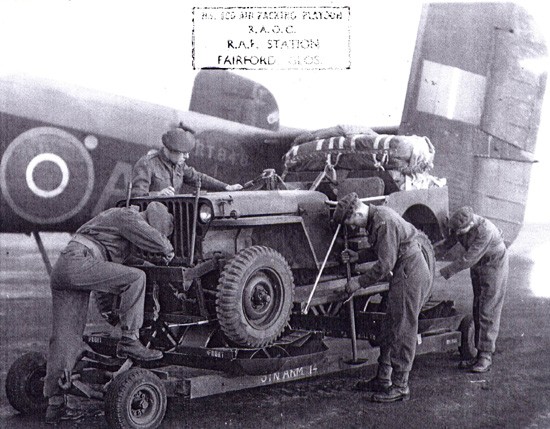
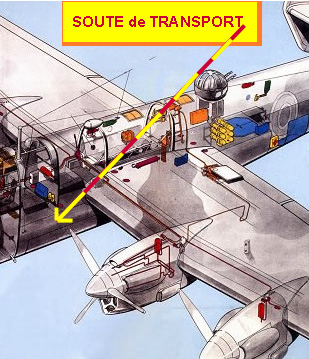
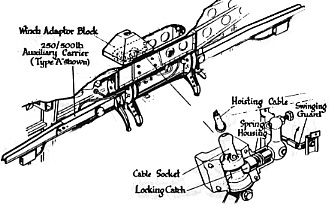
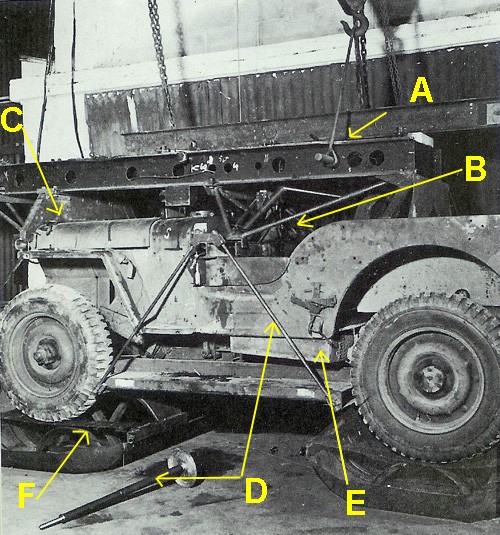
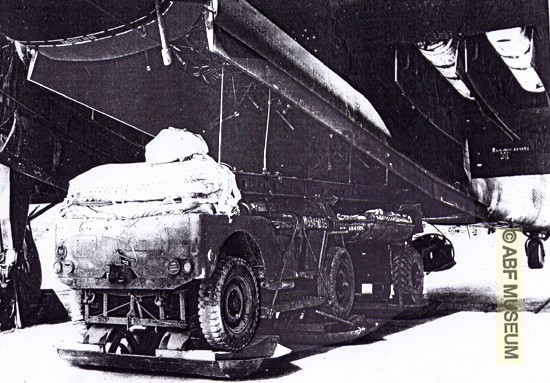
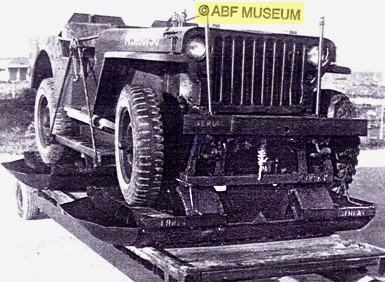
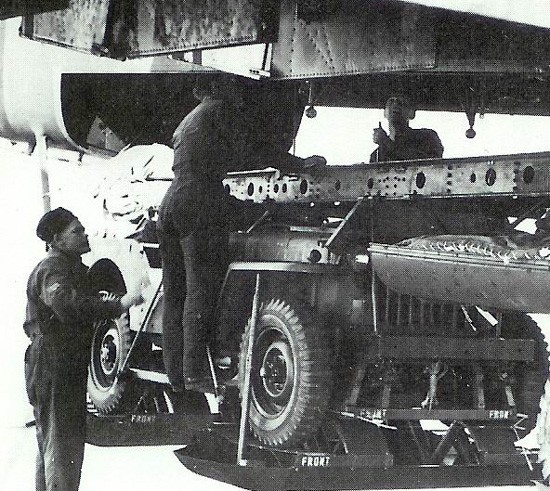
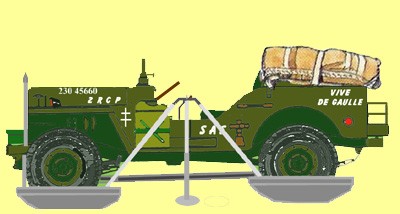
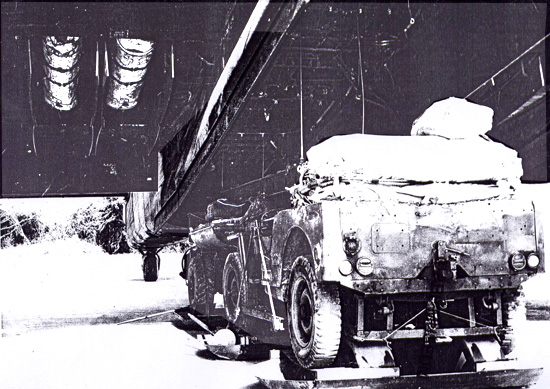
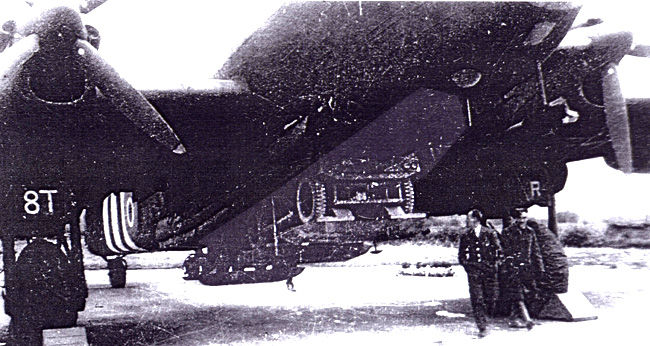
To be able to release the jeeps by means of bombers "Halifax " A MK-3 and MK V, and some since "Stirling Shorts" one due oter the doors of the bomb bay and the jeep was placed at this place. It in fact was suspended under the fuselage and it is the Warrant officer Bomber who actuated the device of dropping as for the "drops" of containers. At the beginning, with the drive, the jeeps were released without plate and some were crushed. A plate intended to deaden the shock at the time of the contact on the ground was created thereafter and numbers it parachutes was changed to 4 instead of 3. (parachute with heavy material 42 ft) the jeeps were parachuted only for the S.A.S, the vehicles of Airborne Divisions all being transported by sailplanes.
A FIRST FRENCH OPERATION
- SUNFLOWER X (code name R.A.F):
OPERATIONS RECORD BOOK R.A.F. Station Tarrant Rushton
- Summary of Events - SECRECY.
June 17th, 1944: 1058 hours. Mass takeoff by aircraft of No. 644 Squadron - 15 Halifax-Hadrian combinations took share. `SUNFLOWER X' - 2 Halifax aircraft from each of No. 298 Squadron and No. 644 Squadron dropped 4 jeeps, 12 containers, 12 troops and 4 spare wheels for jeeps one DZ `Dingson 9'. Two aircraft from No. 298 Squadron and No. 644 Squadron dropped 4 jeeps, 20 containers, 4 troops, 1 pannier and has bundle of stretchers and blankets one DZ `Bullbasket 6'. Weather cloudy to dawn, later to fair to fine.
June 27th, 1944: Special operation `PROFIT VII' 1 Halifax piloted by Squadron Leader NORMAN of No. 644 Squadron dropped two SAS troops, 1 jeep, six containers and one pannier containing W/T sets one DZ. Weather cloudy with light showers afternoon and early evening.
August 4th, 1944: Squadron "Jeeps" 4th SAS (French), DZ Malachappe, Morbihan. N.W. Auray operation LOST
6 Halifax aircraft from No. 298 Squadron 6 jeeps dropped by parachutes
Signed: H. QUINLAN, (Flight Lieutenant)
FOR GROUP CAPTAIN (COMMANDING)
RAF STATION TARRANT RUSHTON.
The Parachutists of France-Free had always been appreciated by the British Command and thus Lt Marienne had set up at their request a Section of Experimentation of the airborne techniques within the 1st B.I.A which inter alia had remprté the famous record velocity emission per stick equipped since C-47 Dakota. For the chapter "Jeeps", French had been also largely solicited.
The technique well developed, it only remained to try out it in natural size and it is what was made in the night of the 17 at June 18, 1944. The 4th B.I.A still comprised "Squadron Jeeps" in its flow chart and a Group of 4 jeeps was brought back to Fairford there to be affrêté and embarked (Pon Grandière). The four jeeps which answered in the name of baptism of "Pirate", "Pirate", "Corsaire" and "Flibustier" were embarked on board 4 Bombers "Halifax" of the 161ème Groupe and were released a few hours aprés with the top of the DZ Baleine which bordered the PC of Nouette on the commune of Sérent meadows of St-Marcel.
The operation in it even was a mitigated success because only one jeep fell on the DZ the others fell into the trees which it borden and it took hours to recover them, extremely fortunately all intact. The Vickers machine-guns had less chance. Conditioned in containers with lighters, those in contact with the ground fused, causing irrevocable damage to the firepower of the jeeps. One needed Sergeant Gall to show the ingeniousness of an arms manufacturer to dismount the remainders and to assemble of them what remained parts to reconstitute... and then only one of them! The jeeps were thus armed only with a F.M Bren, the more so as dice the following day, they had to deliver combat then following the dispertion of the Base "Dingson" aprés the combat St-Marcel being camouflaged under the straw in farms of the area and Vickers K Gun required by radio thus did not arrive...any action and any dropping being temporarily suspended.
The British had less luck and several jeeps were wrecked. One of them having fallen in a large tree and is folded in the middle in "V" shape.
When with the remainder of Squadron "Jeeps" of the 2nd RCP, on August 3 with Malachappe, Morbihan. N.O. Auray within the framework of operation LOST 6 jeeps joined by parachuting. It was the last parachuting of jeeps for Brigade SAS the following day 12 jeeps were air-transported by gliders. At mid-August, 2 RCP passing from the "motorized" mode accepting its jeeps in Normandy where they were unloaded just like Squadron Jeeps of 3 RCP. But there they were completely normal jeeps and not having undergone the transformations intended to parachute them. It is only for Operation "Amherst" that a batch of special jeeps were allotted but it is known that they were not released because of the bad weather.
Astonishing photos showing the dropping by a SAS jeep by 4 x 42 foot parachutes. This operation was carried out by the RAF at the time of the filming of the mythical movie "BATTALION of the SKY". There is not much documentation of the dropping of the French jeeps in Brittany in June and July 1944.
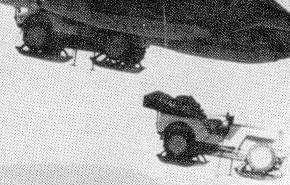
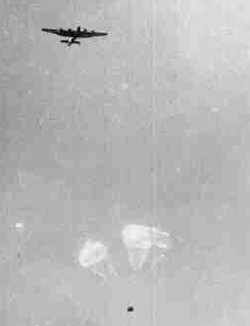
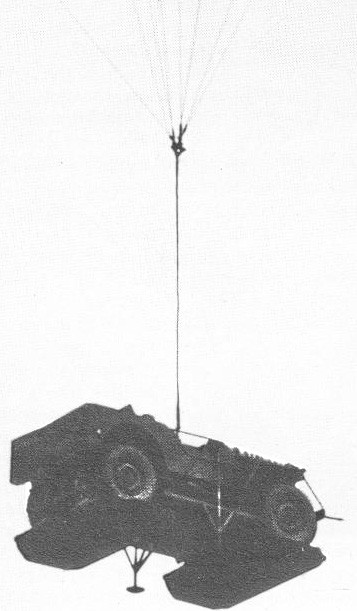

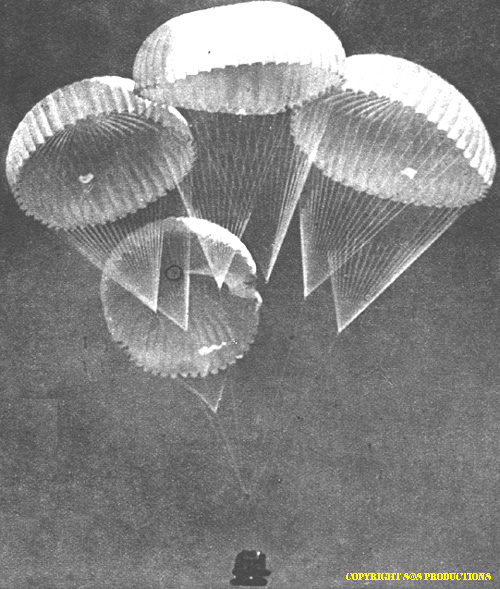
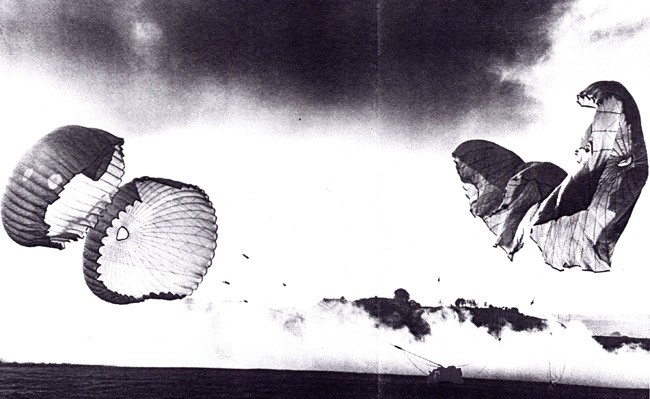
CHARACTERISTICS OF THE HANDLEY PAGE HALIFAX MK V and MK VII

Heavy night bomber modified to the transport of the parachutists and of their heavy material like to the towing of the heavy gliders "Hamilcar" for vehicles. Nickname given by the Paras "Halibag"!
ENGINE: 4 piston engines Bristol-board Hercules C out of star of 1.800 CH
PERFORMANCES: maximum speed alt 6.705 m, 502 km/h; rise 6.096 m in 50 mn; practical ceiling, 7.315 Mr.
WEIGHT: With vacuum 17.690 kg - maximum on takeoff, 30.845 kg
DIMENSIONS: Scale: 31,75 m - length: 21,82 m - height, 6,32 m - surface wings 118,45 m ²
ARMAMENT: 1 put of 7,7 mm in the turret from nose, 4 in 1a dorsal turret and 4 in the turret of tai
CAPACITY: maximum 5.897kg
RANGE: 3330 km
Copy official Note treating of the problem of heavy load release of jeeps
System of dropping of bombs used for the dropping of the containers - On the right the compartment from where the jeeps were released, the two doors were dismounted beforehand.
Rare documents of time (1944) showing the dropping of a jeep then of its crew. R.A.F
It can transport 16 Parachutists equipped and two Dispatchers, also 3629 kg of load out of containers in the low part of the fuselage (bomb bay). The principal door which is also useful for the exit of the parachutists is located in the back floor of the apparatus and opens internally or outside. A luminous device "red-green" actuated by the Dispatcher and a cable of fixing of the "static-line" (S.O.A) are installed in the fuselage. Also, the apparatus can carry a jeep on plate of dropping.
Other Airdropped gun-jeep operations:
Operation Dingson - 160 men and 4 jeeps of 4 French Parachute Battalion (4 SAS) parachuted into Vannes area of Brittany to organize local resistance, establish a local base of operations, and harass enemy forces in the area. (July - October 1944)
Operation Franklin - 186 men from 4 French Parachute Battalion (4 SAS) deploy in 31 jeeps to support U.S. VIII Corps during the German Ardennes Offensive. (Belgian Ardennes, December 1944 - January 1945)
Operation Hardy - 55 men from 2 SAS (with 12 jeeps) parachuted into eastern France to establish a base on the Plateau de Langres, northwest of Dijon and carry out intelligence and harassment operations. (July - September 1944)
Operation Kipling - 107 men and 46 jeeps from "C" Squadron 1 SAS parachuted into the area west of Auxerre, central France, and tasked with aiding the Allied airborne landings due to take place in the Orleans Gap. (August - Sept. 1944)
Operation Lost - Seven men from 4 French Parachute Battalion (4 SAS) parachuted into Brittany, France to meet up with parts of 4 SAS and conduct large scale operations against the enemy in the area. (June - July 1944)
Spenser - 317 men of 4 French Parachute Battalion (4 SAS) mounted on 54 jeeps, infiltrated enemy lines and conducted operations designed to effect major casualties to the retreating German Army. (August - Sept. 1944)
Operation Wallace - 60 men from 2 SAS in 23 jeeps (divided into three groups) landed at Rennes, tasked with strengthening SAS bases in the area, later attacked the German HQ in Chatillon. (1944)
Streamlined External Loading (SEL)
Russians actually streamlined external load (SEL) carry armored cars and light tanks under TB-series bombers to include AIRDROP WITHOUT PARACHUTES! (Free drop) These are the works of Grohovskiy with TB-1, TB-2 and TB-3 bombers.
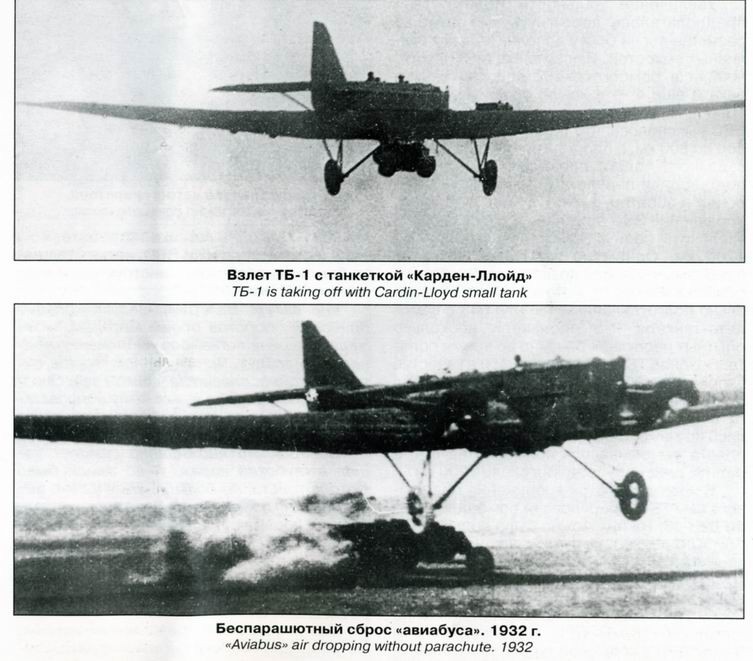
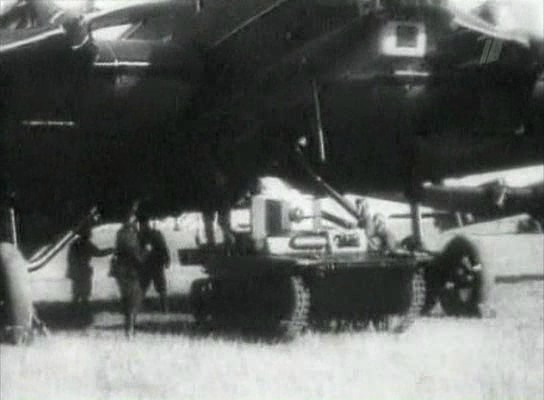
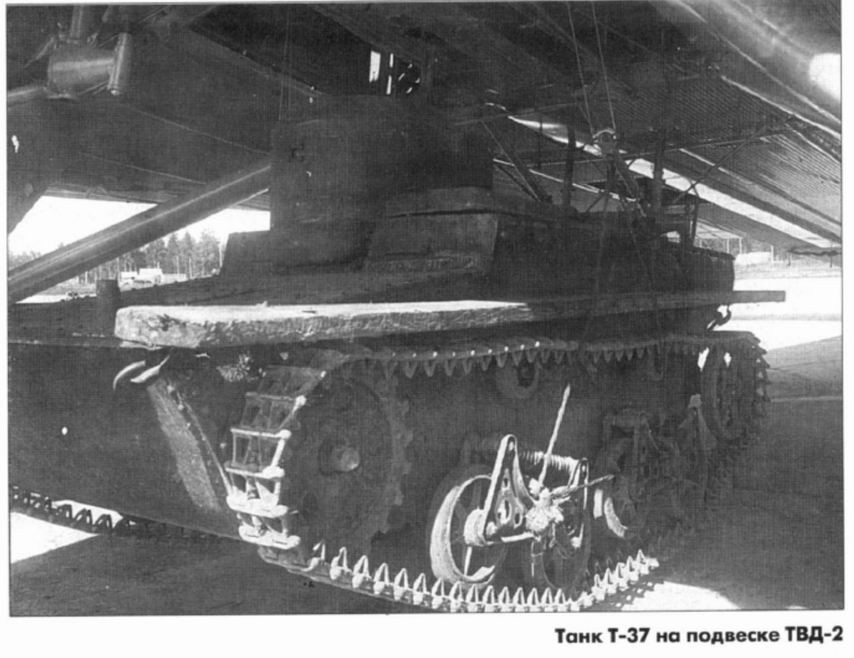
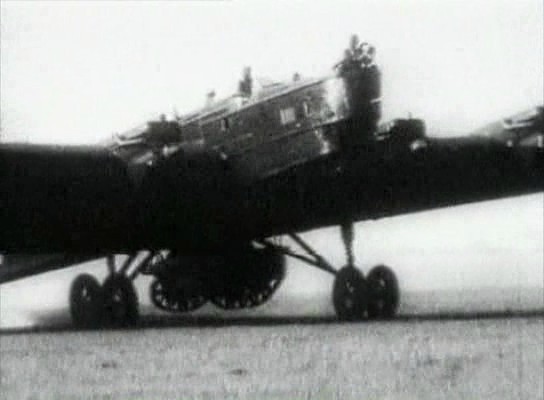
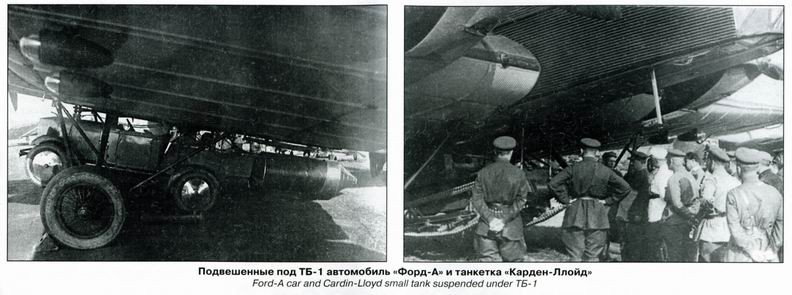
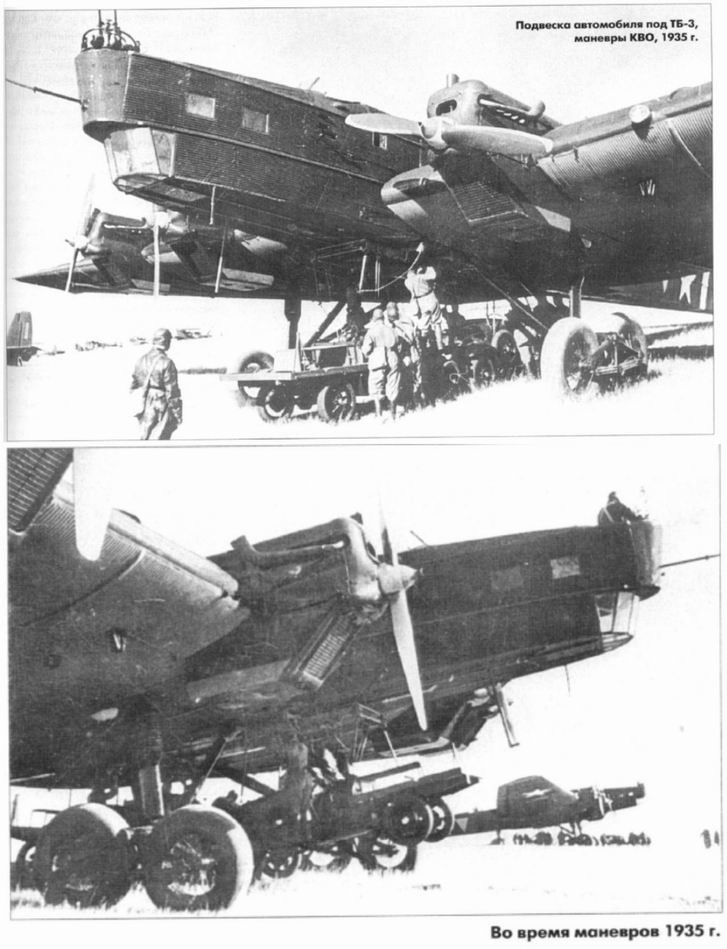
American SEL Experiments by Walter Christie & Vincent Burnelli


Here's an actual pre-war B-17C SEL carry of a Christie light tank

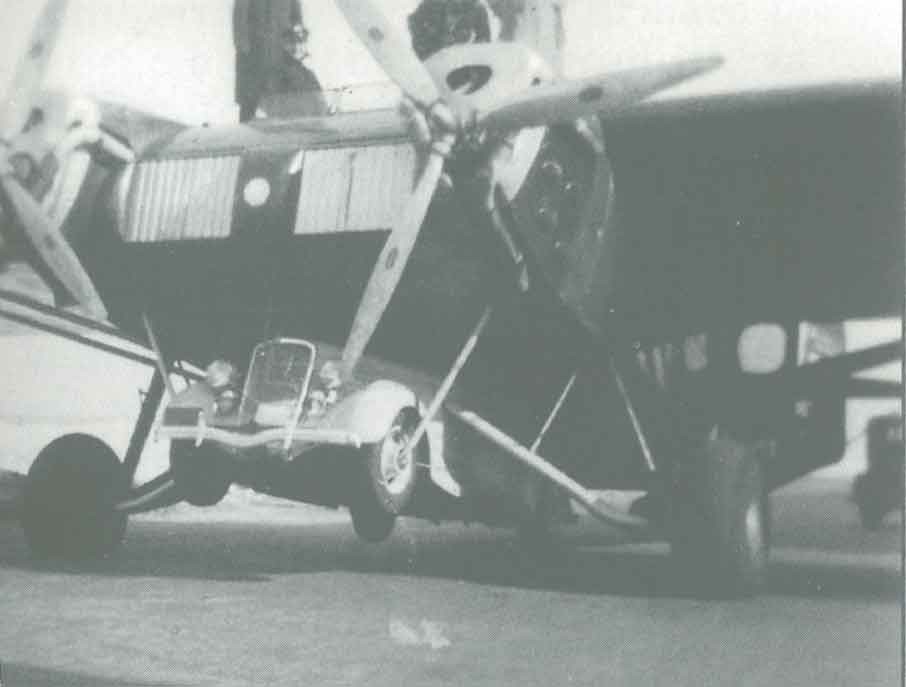
In the 1930s Burnelli experimented with carrying cars under his lifting fuselage aircraft as depicted above. In WW2, we experimented with M22 Locust light tanks underslung C-54 four-engined transports without turrets. Tests showed upon landing the chassis could be driven to the tail and the turret re-attached after being lowered from the fuselage side cargo door in under 10 minutes--but a C-54 needed a runway to land on. Task Force Smith flown in by C-54s to defend South Korean could have taken turretless M22s and reattached a better turret with 106mm recoilless rifles to stop the 100 x North Korean T34/85 medium tanks leading the enemy invasion--had we taken then MG Gavin's advice in 1947.

Detachable pods/gliders
Towed gliders
Towed Tanks/Gliders-Airplanes
Not only had the Russians done aircraft-suspended vehicle delivery or Streamlined External loading--SEL under TB-1 TB-3 bombers T18 and T27 light tanks and D-8 armored cars in the 1930s, legendary American inventor J. Walter Christie proposed it in 1932-35 to deliver tanks, but of course it was rejected--how many Tanker and Paratrooper lives in WWII would have been saved had we followed through on the idea to give them 3D maneuver, armored mobility and fire support? Burnelli offered a lifting fuselage plane to offload tanks.
Air/Ground Vehicles


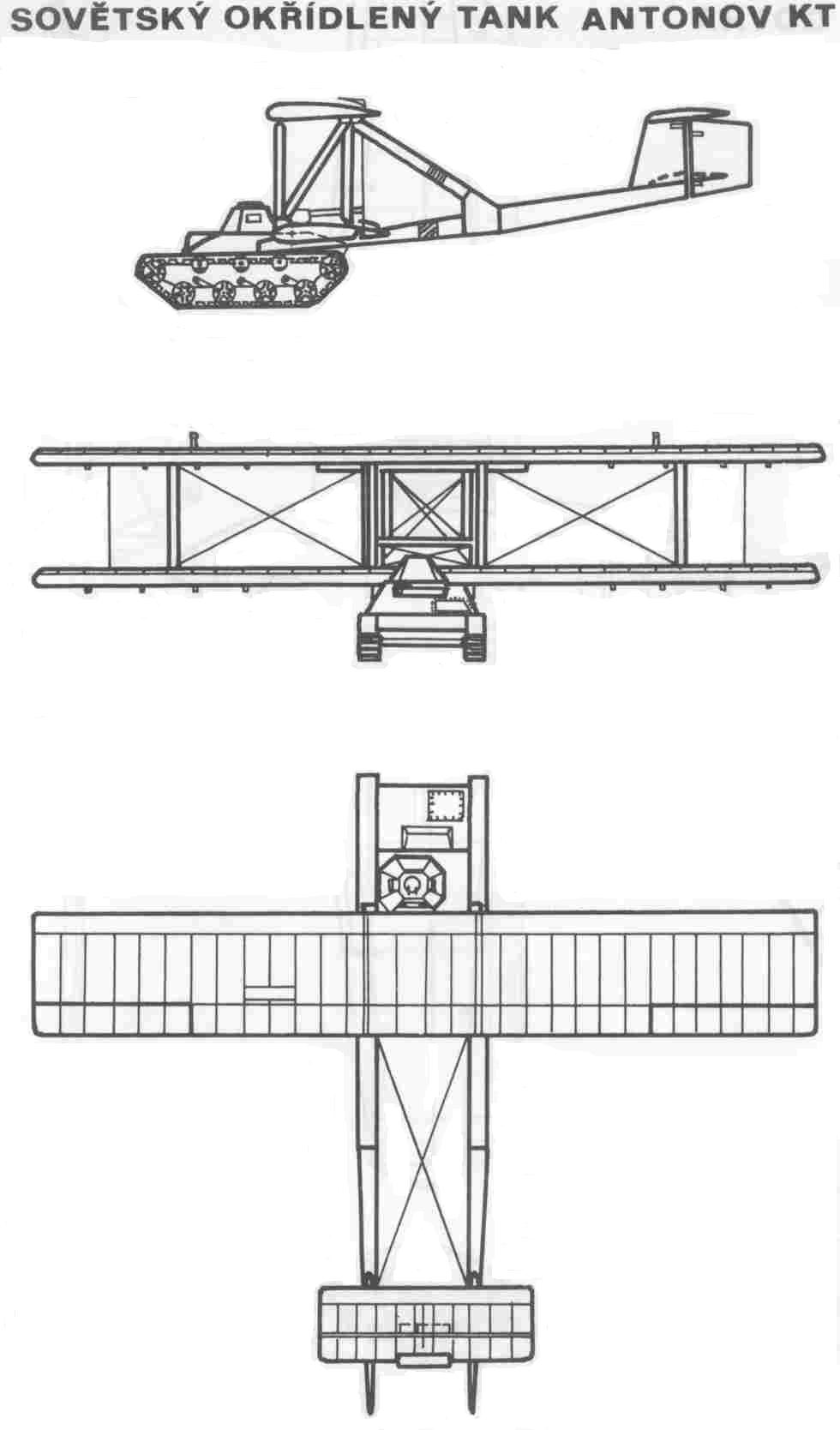
Legendary Walter Christie's M1932 Flying Light Tank is still the best concept to date and still demands fulfillment using today's technologies.
With WW2 underway, ways to make tanks fly are explored....
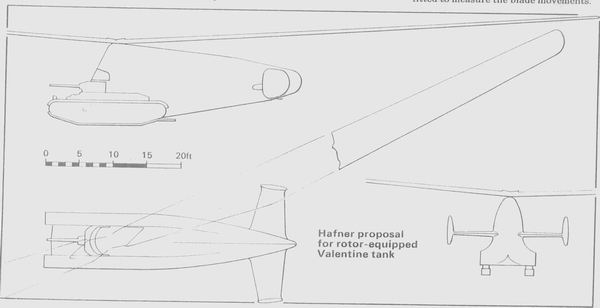
Hafner's Valentine medium tank with rotors to be towed in flight

Russian Antonov A-40 KT-40 fixed wings to tow a T60 Light tank as a glider
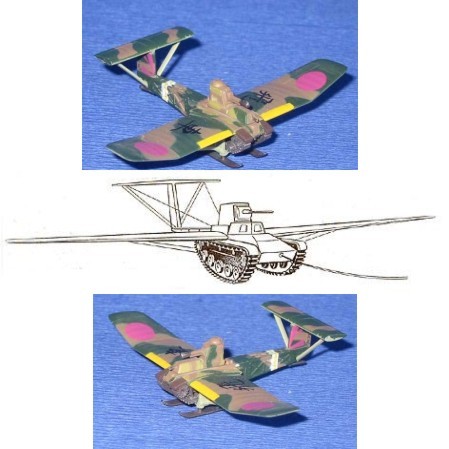
Japanese KU6 Light Tank Glider Combo
Project Maeda Ku-6
Even air/ground vehicles are considered...
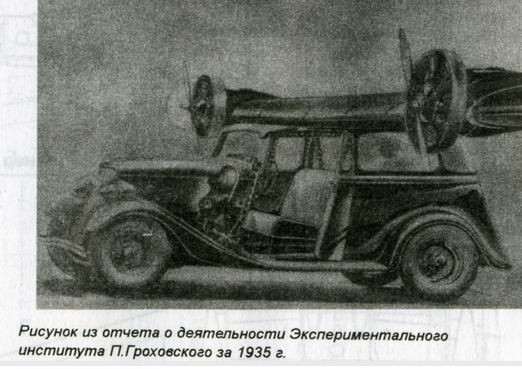
Grohovskiy G-26 (Attempt of the creation flying car)
Christie and the Russians experimented with making the light tank into a glider and having it shed its wing/tail upon landing---a great idea that predates even Simpkin's Air/Land vehicle concept. He even came up with the first "KIWI" pod idea to expedite civilian air travel in 1932!
http://blog.modernmechanix.com/2006/07/10/flying-tanks-that-shed-their-wings
Flying Tanks that Shed Their Wingsby Lew Hold
Imagine those two formidable weapons of modern warfare, the airplane and the armored tank, combined into one terrible machine of destruction! Fantastic as the idea sounds, it is fast taking physical shape as a reality for Uncle Sam's army. The whole amazing story is presented to you in this important article.
IS WAR, already made terrible to contemplate by the invention of too-efficient methods of destruction, on the verge of being banished forever by an amazing new weapon so horrible in its possibilities that nations of the world will not dare to risk its fury?
This is the idea conjured up by J. Walter Christie, noted builder of tanks for the U. S. Army, who has been secretly working on the most revolutionary war invention since the discovery of gunpowder-an armored tank which flies as swiftly as a bombing plane, and which, by simply shedding its wings when on the ground, can travel over any terrain with guns blazing at speeds of 70 miles an hour!
Changes Modern War Strategy

The entire strategy of modern warfare will have to be altered when Mr. Christie's flying tank is proved practical. Trench warfare, which played such an important part in the World War, will be well-nigh impossible, for with a swarm of a hundred flying tanks descending into No-Man's Land, no infantry in the world could resist the withering fire.
Nor is the flying tank so grotesque an idea as might appear at first glance. During the late war no one even conceived the possibility of an armored tank's being propelled through the skies on wings like an airplane, driven by an airplane motor.
Flying Tank Now Being Built

Yet Mr. Christie's tank, he promises, will do precisely that. Because of his success in building speed tanks for the army and his extensive knowledge of this phase of warfare, there can be no doubt that he knows just what he is doing. He is not a man given to exaggeration, and the fact that the tank is now taking shape in the plant of the United States Wheel Track Layer Corp., at Linden, N. J., proves that the idea has advanced beyond the paper and plan stage.
In the words of the inventor, "The flying tank is a machine to end war. Knowledge of its existence and possession will be a greater guarantee of peace than all the treaties that human ingenuity can concoct. A flock of flying tanks set loose on an enemy and any war is brought to an abrupt finish."
Details of the tank's construction are astonishing. The flying fortress will be armed with a 75 millimeter gun, with supplementary small machine guns. Personnel will consist of two men. The body of the flying tank is amazingly light because of new principles of construction closely guarded by the inventor. In fact, the finished product, ready for military duty, will not weigh over four tons.
Its lightweight engine can develop 1,000 horsepower, and by an ingenious system of gearing the motor drives both the back axle, for propelling the tank on the ground, and the propeller for flying duty.
Take-off Problem Solved
Eight large wheels are provided on the tank, with twin pneumatic tires over which the caterpillar tread fits. With the special springing equipment, pneumatic tires and patented caterpillar track, Mr. Christie's tank can make 70 miles an hour across rough country, it has been calculated, and as much as 100 miles an hour on a smooth surface. Its speed makes it a difficult target for enemy fire.
"It is an established fact that a single pair of wings can support this tank in the air," Mr. Christie explained to the special representative of Modern Mechanics and Inventions. "Any aviator can tell you in two minutes the exact wing spread required.
"The most serious difficulty seems to be the take-off. Several of my flying friends have told me that many army planes require three-quarters of a mile of prepared ground for a runway and they insisted that my machine would need a still greater starting space. There were also those who doubted that my tank would even leave the ground.
"After three years of experimentation, I was prepared to meet their queries and their doubts. This is the solution: My machine will work up to a flying speed while it is still on the ground. At a hundred yards the tank will be going fast enough to rise the moment the power is transferred from the wheels to the propeller, no matter on what kind of surface the tank is traveling.
"The caterpillars will function on any condition of base. The Christie speed tank which has been already acquired by the United States government bears testimony to that advantage.
Treads Simplify Landing Problem
"The other hazardous stumbling-block, the landing of the flying tank, has also been overcome. My machine can alight on very limited space. The pilot can observe his air speed by means of his instrument board. When he switches from being a pilot to being a chauffeur he will know his land speed, both on the caterpillar tracks and on wheels, whichever he may choose to bring into use.
"All that the man at the controls has to do is to start the wheels of the caterpillar in motion and adjust them to the air speed.
This is done merely by keeping an eye on the speedometers. As soon as the tank touches the ground, he brakes it as he would an auto truck.
"If he wants to liberate the tank from the wings, he has only to press a lever and that operation is completed in a jiffy. Then if he wants to, he can proceed along a highway on the rubber-tired wheels at a rate of 100 miles an hour."
That is how Mr. Christie's latest invention will work. But he has already begun to plan for a further improvement on this device. He will soon begin work on a detachable airplane as applied to the armored tank. The plane will deposit the tank at a desired post and then return to bring up others, or engage in other maneuvers.
In connection with these latest experiments, a valuable peacetime use of the flying tank principle suggests itself.
One of the several problems confronting passenger air lines today and, from the passengers' standpoint, certainly the most annoying, is the business of getting passengers to and from the airport-the actual point of arrival and departure of the airplane itself.
Airports are perforce located at a considerable distance from the downtown district of a city and it naturally follows that the larger the city the more inaccessible will be the airport or air terminal. In the minds of prospective air passengers the immediate accessibility of bus and railroad facilities contrast pleasantly with the annoyance attendant on purchasing a ticket, riding out to a field, transferring to a plane and repeating the performance at the flight destination.
The time-saving feature, most practical appeal of air travel, is thus not so much in evidence or even may be totally absent in flights of less than 300 miles.
Bringing Airports Close to Town
Several remedies for the situation are feasible. One, and the most frequently heard of, is to build airports in the heart of a city, by utilizing the tops of large buildings with or without the aid of catapult launching devices, by spanning whole blocks of streets with wide bridge-like structures or spanning convenient rivers in a similar manner. All these ideas have been mentioned at different times. All of them suffer from one common disadvantage.
To bring an air terminal into the heart of a city would not only result in air traffic at an altitude we are obliged to regard as unsafe, but would further imply taking off and landing over these crowded centers. The airplane of today is hardly suited to operating under the conditions just outlined and therefore this otherwise attractive solution of the problem must, for the time being at any rate, be abandoned as a serious consideration.
Another course is open and fantastic as it may appear at first glance the idea has been approached a number of times and there are no serious difficulties in the way. The idea involves the building of passenger planes in two distinct and self-contained units. One, the airplane portion, would contain all the essentials for flight and consist of wings, tail surfaces, motors, pilot's control room and the landing gear.

The passenger cabin complete would form a second separate unit. Capable of being attached or detached automatically from the airplane unit, this cabin would have the appearance of a large bus or Pullman car and would be capable of independent operation on the ground by means of a light motor driving wheels which would be drawn up when cabin and plane formed a single flying unit.

Such a combination would enable passengers to enter the cabin at a central depot in the city itself, travel out to the field (in extremely large cities where the passenger traffic justified the expense, on special roads) and there be instantaneously attached to the airplane portion of the combination to proceed by air to its destination.
Leaving our baggage at the checking counter, we then repair to the excellent restaurant to obtain a light meal and pass the time until our plane time arrives. As the time approaches for the plane-car to leave we retrieve our baggage and pass through the door to platform No. 5, to see immediately before us a smooth metal buslike car into which passengers are now pouring. A capable attendant relieves us of our baggage and we enter the car and pass along the central corridor to the small but comfortable observation room in the rear.
Glancing through the windows which surround this compartment, we notice numbers of other plane-cars. Some are standing at their respective platforms, others are arriving or departing through the low doorless exits of the vast hall. At 5:15 to the dot our car glides smoothly forward and we pass out of the hall onto a wide high-speed road which leads directly to the flying field.
Travelling at an even sixty, we arrive at the field to see a number of curious looking planes lined up before the service hangars. They appear to be all wings and tail and are lined up over sets of trough-like tracks which serve to guide the wheels of the cars into exact position as they arrive to be hooked up to the plane units. Into one of these sets of tracks our car wheels presently glide, the car stops and the ground crew busies itself locking the connections into place.
A few moments pause and then the motors of the plane, which have been idling as we approach, burst into a mighty roar and in what seems to have been but a few minutes since we entered the car at the central depot we are sailing high over the city on our way to Minneapolis.
Descending at the Wold-Chamberlin airport at Minneapolis our wheels have scarcely touched the ground and the plane approached the concrete apron before the landing gear is retracted, the car wheels extended and the release gear operated to allow our. car to shoot forward on the ground once again under its own power while the airplane unit is run into the service sheds to await the car's return with a fresh load of passengers for the return flight. Minneapolis air traffic being insufficient to justify the expense of a special speed road we proceed along the ordinary highways and city streets to the loop district and pull up inside the central depot to leave our car exactly three hours from the time we entered it in the Chicago central depot.
A flight of fancy? Perhaps. But not beyond the bounds of possibility. Until such time as planes are capable of arrested flight or are so dependable that they may be operated from the heart of a great city without undue risk to either passengers or inhabitants, this may well prove to be the most satisfactory solution of the airport problem. It is true that the necessity of taking passengers to the field has not been eliminated but the inconvenience element has been totally done away with and furthermore, in the case of large cities where the volume and radius of travel warrants the expense, high speed airport roads will permit the cars being shuttled back and forth at speeds quite impossible under present conditions.
A modification of the detachable car unit described in this article would lend itself admirably to freight purposes. In this case the freight cabin or car need not be equipped with motor or ground wheels but could be detached directly onto skeleton trucks or trailers for distribution at the terminal airports.
Still another application of the idea would be of inestimable value to sport planes. Arrived at a field the owner-pilot could detach and park the airplane unit and proceed in what would then become a lightweight closed car to his city destination. The car in this instance would in all probability resemble the little three-wheeled "tear-drop" car illustrated in the April issue of Modern Mechanics and Inventions.
Christie M1932

Produced in 1932 by U.S. WHEEL TRACK LAYER CORPORATION
Total production = 1. CREW: 3
ARMAMENT: Could carry one 75mm cannon and one or more machine guns.
ARMOR: 0.375" to 0.5". (Thicker armor could be installed).
MAXIMUM SPEED: 60 mph on tracks, 120 mph on wheels.
SUSPENSION: Similar to 1931 model but with a maximum vertical movement of 24 inches; wheels of duraluminum with Firestone pneumatic tires. The two rear wheels had a slightly greater diameter than the front pairs.
TRACKS: Forged steel plates; 11" wide; 7" pitch; track pin 3/8" diameter.
GENERAL ARRANGEMENT: Cannon in front; crew in front center; engine & final drive in rear.
DIMENSIONS: Length: about 22 ft.; Width: about 7 ft; Height: about 5' 8".
WEIGHT: about 5 tons.
ENGINE: Hispano-Suize, 12 cylinder, V-type, 750 HP, forced water cooling. HORSEPOWER Per Ton: 150.
TRANSMISSION: Sliding gear, 3 speeds forward, 1 reverse. It had a power take-off for the flying propeller. One modification provided for a transfer gear case to propel a helicopter roter above the vehicle for lift purposes. OBSTACLE ABILITY: Could jump across a 20 foot trench from a 45 degree slope.
FUEL RANGE: unknown.
FUEL CAPACITY: 89 gallons.
SPECIAL FEATURES: Of very light construction throughout for airborne role. Chassis consisted of a double hull which enclosed the suspension springs. The inner hull was made of welded duraluminum plates, and the outer hull of welded steel plates. Rear ground wheels were driven through a knee-armed gear box when the tracks were off.

Originally it had been proposed that the chassis be equipped with a disposable biplane and propeller assembly. Using this arrangement the vehicle would become airborne by taxiing along the ground on its tracks to gain momentum and then transferring power to the propeller. Later plans contemplated carrying the tank by a special aircraft and releasing it close to the ground. In this case dual air-speed indicators would enable the tanks driver, before being dropped, to accelerate his tracks to a speed equaling that of the aircraft. Adaptation of these concepts and designs in the form of permanently installed, high-speed track-laying airplane undercarriages would permit the operation of large aircraft from unimproved fields. The M1932 was modified twice and then sold to Russia, who had a keen interest in the flying tanks idea.
WHAT IF? An ultra-light tank or tankette. For infantry fire support or cavalry operations?

Let's say we employed the Christie M1932 flying tankette.
WW2 begins.
ETO = European Theater of Operations
Instead of driving overland in M3 Stuart light tanks with 37mm guns, kicking up dust clouds for miles in North Africa, seen by the Afrika Corps, a swarm of M1932 flying tankettes with 75mm guns lands at night and in force to recon a key mountain pass. They discover the Germans and open fire with hull-mounted 75mm guns that blast their Mark III light tanks to smithereens as they run around them with 60 mph speed. The flying tankette cavalry commander decides to hold this ground and radios back for the main body. The main body avoids the ambush waiting for them at Kasserine and hits Rommel in his rear. However since timid Fredendall is in charge he orders the cav troop back to base. Rommel attacks our bases and loses a lot of tanks and men because we are alerted but Fredendall gets fired and replaced by PATTON.
Patton takes over and flies a huge force of flying tankettes into loosely-held German territory to cut off the retreat of the Afrika Corps. He repels the attack at El Guettar and goes on the defensive. The fleeing Germans do not fall back and fight another day, they are annihilated as they fall into the sights of the flying tankettes. No more Afrika Corps, sooner.
Sicily: the flying tankettes with Airborne Paratroops take Messina...or block the German withdrawal to the Italian penninsula, they seize Rome right after we land at Anzio, forcing Lucas to get off his ass and catch up with the main body...shortening the war....we have Rome in 1943 and are in southern France by year's end...MAYBE WE DON'T EVEN NEED TO LAND AT NORMANDY AT ALL?
PTO-CBI = Pacific Theater of Operations, China-Burma-India Theater
Imagine launching the flying tanks from some sort of aircraft carrier to LAND on islands and take them from the inside-out....landing strips are cut out from the jungle by paratroopers for the flying tankettes or fighters, bombers and transports.....the flying tankettes shed their wings and fan out on the ground offering paratrooper infantry fire support....
A real, 3D air/ground maneuver, mechanized CAVALRY. Something we still lack today.
The beauty of the flying tank is that NO ONE HAS TO ASK AVIATORS "MOTHER MAY I?" to fly as when dependant upon a mother aircraft from another unit. You (your tank) are your own aircraft.
More on Detachable pods and ISO Containers...

General James Gavin's KIWI pod concept from his book, Airborne Warfare
www.youtube.com/watch?v=RCbOobGmRBc
The detachable pod as envisioned by General Gavin in 1947 in his book, Airborne warfare, has the biggest pay-off in terms of speeding air delivery. Instead of unloading the aircraft, the pod detaches and the aircraft can fly away to get another pod. See C-120 aircraft listing below. If the pod has an APU, it can drive itself to an area out of the way of incoming aircraft for off-loading. Most importantly, the pod can be supplied to EVERY UNIT IN THE U.S ARMY so they all can have a "place holder" so they can get into the 3D Air-Mech-Strike warfare business. They can train on the pods at home station, have them loaded for "C-1" combat readiness. It eliminates needing an aircraft present to conduct Air-Mech-Strike training. These "pods" could be standard 20 foot and 40 foot ISO Sea/Air/Land containers in use by the entire world! Just look at a container ship to see them action. The same pods used in the FTR/JHL should be able to attach to USAF B-52G/H heavy bomber inboard wing hardpoints for SOF insertions as a specially-designed glider pod. Ideally, the ATT should be able to carry two FTR/JHL pods inside its fuselage or under its fuselage, side-by-side or a maximum number of PLS flat racks.
Pods from Tractor-Trailer trucks: AIRCRAFT HAVING A DETACHABLE POD
Robert H. Reno, 1961
www.google.com/patents?vid=USPAT3361396&id=i4ZvAAAAEBAJ&pg=PP1&dq=pod+aircraft#PRA1-PT3,M1
Pods that detach in-flight:


www.google.com/patents?vid=USPAT5110071&id=vOsZAAAAEBAJ&pg=
Personnel capsule extraction apparatus Henry J. Hunter et al
Abstract
A personnel capsule extraction apparatus having a personnel capsule mounted on extraction platform which is ejected from a low flying aircraft at an altitude between five and ten feet above the ground. A drougue parachute is utilized to deploy a large extraction parachute which pulls the personnel capsule out of the aircraft.
Patent number: 5110071
Filing date: Apr 18, 1990
Issue date: May 5, 1992
Inventors: Henry J. Hunter, Clifton W. Marshall, Kenneth Cunningham,
Marvin A. Tingdahl
Assignee: The United States of America as Represented by the
Secretary of the Air Force
Primary Examiner: Virna Lissi Mojica
Current U.S. Classification
244/137.3; 244/140
International Classification
B64D 0112; B64D 0114
Ground-to-Air Recovery
WWII OSS light plane snatches of agents
Glider recovery by low-flying C-47s
Fulton STAR/MC-130 Combat Talon Is
Best film the depiction is the NVA General "snatch" mission ending the John Wayne film, "The Green Berets", or Sean Connery at the end of the 007 film, "Thunderball".
Actual Cold-war spy mission using Fulton STAR "SkyHook"
Gliders




Suspicions are that man has ALWAYS been technologically advanced as Graham Hancock in "Fingerprints of the Gods" reveals. Proposing that ancient people flew in gliders is actually conservative in light of the fact that ancient texts called OOPARTs (out of place artifacts to our prejudiced world view) indicate ancients flew in flying machines and engaged in nuclear warfare with technology superior than what we can do today given to them by fallen angels. The Great Pyramid in Egypt has 150-ton stones that we have today have only 1 crane on earth that could lift. How did they do this?
After WWI, Germany was not allowed to pursue a powered flying program so they threw themselves into gliders and discovered a warfare practical application: the silent assault. Their success with gliders in the early days of WWII, led to the Allies developing gliders to even deliver light tanks on D-Day and the Rhine River crossings!
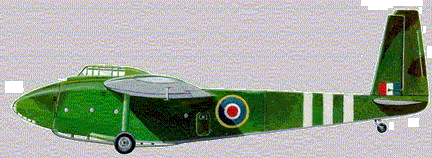
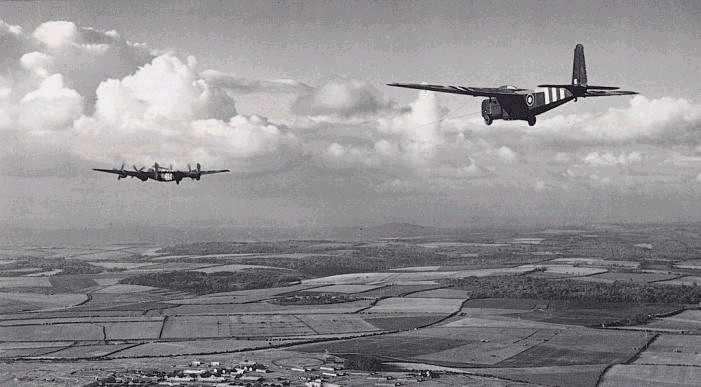
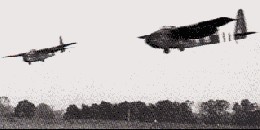
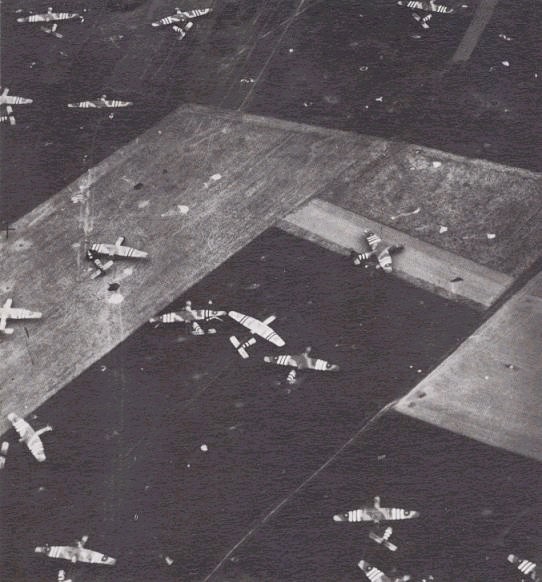

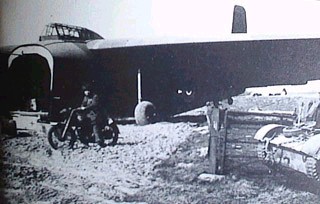
During WW2, gliders were towed and released by the thousands to deliver stealthy commandos or assault troops or large amounts of cargo too heavy for existing piston-engined planes. Rather than throwing these albeit wooden gliders away, a snatching system was perfected so a low-flying plane with a hook could recover the glider and bring it up into the air to be towed back to base for re-use. They were even used to recover personnel as the report below from the aftermath of the WW2 battle for the Remagen bridge illuistrates.

COMBAT REPORT: www.combatreform.org/gliderpickupatremagen.pdf
After WWII, the rear ramp or opening clam-shell equipped aircraft to parachute drop large loads like howitzers and vehicles eliminated much of the need for the supply glider. Helicopters also took some of the delivery tasks once they gained turbine engine power. However--when the glider vanished, the assault glider attributes were lost and are now only partially attainable through stand-off parachuting using steerable wing-shaped parachutes. At some point the glider will return in order to regain stealthy,stand-off Air Assault capabilities to avoid air defenses---its problems of towing and guidance solved by modern technology means and the need to be towed eliminated by being a pod that is released by its "mother" aircraft. Glider pods would be recovered by the FTR/JHL Speed Crane with rotors deployed to hover over the pod, re-attach and fly back to base for re-use.
Pods-in-action in short-story technothriller: Bad day in Taiwan and at the DMZ
At the end of WW2, the Allies and Axis were alread contemplating adding engines to gliders to fly them back for re-use instead of trying to "snatch" them. The XC-122 glider became the C-123 powered cargo plane. The Hamilcar X was powered and could fly itself back to base when empty. The Germans powered their Gigant 321 gliders into the 323 models.



The Japanese Teishin Shudan airborne special forces transported Type 95 Ha-Go light tanks in KU-7 Buzzard gliders that at war's end they were fitting with engines not unlike our C-82 Packet.

www.airpower.maxwell.af.mil/.../cc/torrisi.html
In the 17 November 1999, Air & Space Power Journal - Chronicles Online Journal, "Gliders - Rethinking the Utility of these Silent Wings for the Next Millennium", Steven A. Torrisi points out there are still things gliders can do that powered aircraft with built-in fuselage volumes cannot do:
1. crash-land into unprepared terrain
2. Be pre-loaded with Army vehicles/equipment/supplies
3. crash-land with stealth if launched from an off-set
He shows excellent comparisons on what the German Me-321 glider could carry compared to today's powered C-130:

And then compares the gliders of WW2 and what they could carry:

Then states the mission successes of gliders in WW2 combat:

Keith Flint in his masterpiece book, Airborne Armour shows that a male "tank" with a gun big enough to destroy even heavy German Tiger tanks within the size and weight constraints of the Hamilcar or a larger glider like the German Me-321---was possible in WW2---the British just didn't do it. Flint ever the conventional male tank enthusiast, notes a 75mm gun-equipped Mark IV medium tank with 80mm thick armor protection was transportable by a Me-321 glider. Flint wants his 360 degree spinning turret with a big gun and thick armor protection to keep enemy big gun shells out, so to have his cake and eat it, too he wants a bigger transport plane. Do-able, look at today's C-17 Globemaster III turbofan transports that can lift 70-ton M1 Abrams tanks---if you have 3, 000 feet of smooth ground to land on. If you want to surprise the enemy by landing at unexpected places and swarm him with greater numbers to get decisive victories, then you need lighter tanks. Having a turret limits the space you have for a gun or a loader and adds weight you can do without when being light enough for WW2 piston-engined Airborne transport, and Flint shows how the American M22 Locust light tank had to have its turret removed to attach directly to the piston-powered 4-engine C-54 transport plane of that time. Flint describes that upon landing, the pilot could drop the chassis 14 inches to the ground and the Driver could hop in and take it back to the tail and the turret could be lowered into position by untrained men in under 10 minutes! The author also sheds new light on the C-74 Globemaster I that its ingenious bomb bay floor could raise and lower an intact M22 Locust light tank in 1945. However, the American concept of C-54/Locust requires a smooth RUNWAY to pre-exist and Flint duly notes this is a tactical planning handicap the glider that essentially CRASH LANDS onto any open area that is flat--doesn't have. He expertly describes how to crash land, a glider on skids can accommodate uneven, unprepared terrain best. However, with the excellent Hamilcar heavy glider, experienced pilots kept its wheels on so they could steer with braking and avoid obstacles like other gliders during the crash land. Two Hamilcars at Arnhem have their wheels stick into the soft ground causing them to roll-over killing 3 men, so the ideal cow pasture glider/airplane should have skids with small wheels not likely to stick in back for ground steering. Flint doesn't connect-the-dots that after WW2 regulars in an air force are not going to want to crash-land in ANY aircraft and the glider land-anywhere capability was lost not because it was "obsolete" which is the author's favorite word to dismiss something he doesn't like.
Something Flint does like and justly so is the awesome Hamilcar glider. Its two pilots sat tandem like in a fighter plane on top of their armored loads protecting them from enemy anti-aircraft explosions. Vents took exhaust gases out so the tanks inside could be started up for a quick drive-off upon landing. The shock absorbers could be lowered quickly upon landing to get a good angle for the tracks to drive out.
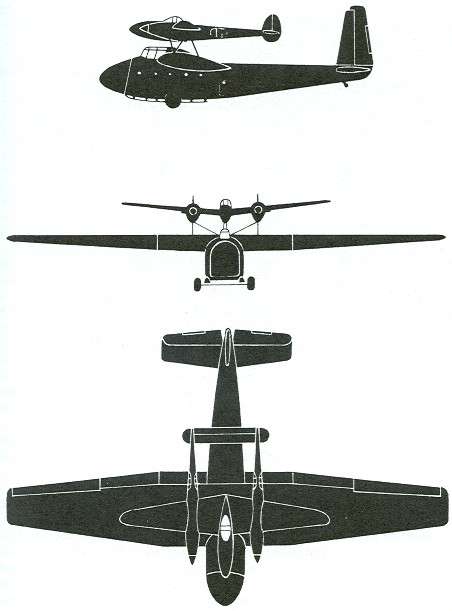
Very smart, but Flint reveals some more stunning facts about this great assault cargo glider---an U.S. Army Air Force (USAAF) officer saw a German Me-109 on top of a small German assault glider and proposed we put a P-38 Lightning twin-engined fighter on top of the Hamilcar. An American C-54 or B-17 or B-24 4-engined plane tows the Hamilcar/Lightning into the air, then disconnects and flies back to base for another glider combo to take-off. From that point on the P-38's engines would keep the Hamilcar glider aloft all the way to the target since the power to take-off is drastically more than what's required to stay aloft! Physicists point out the same is true with our cars, you don't need 200 hp once you get to 60 mph, only a fraction of this power so driving around with a bug engine is inefficient. It gets better. Once over the target area, the P-38 pilot releases the Hamilcar to land with its light tank and troopers and the fighter-bomber is now free to strafe the ground of enemy ack-ack guns, troops, tanks, trucks etc. or shoot down enemy fighters! Such an arrangement would free up our glider tow planes and get ALL OF THE HAMILCARS WORKING DELIVERING COMBAT POWER TO HOLLAND would have worked wonders during Operation Market-Garden where German mortars needed continual silencing by fighter-bombers to relieve pressure on LTC Frost's men at Arnhem bridge. General Gavin says the lack of en masse airlift is what doomed Market-Garden.
This realization that the power to fly once take-off was achieved resulted in the Hamilcar X fitted with two engines from "obsolete" aircraft of its own. When fitted with the most powerful engines available the Hamilcar COULD FLY ITSELF ALL THE WAY TO THE OBJECTIVE WITH ITS FULL LOAD OF LIGHT TANK(S). Now this is a class/type of assault transport WE DO NOT FULL UNDERSTAND even today. This is a POWERED CRASHLANDING GLIDER. This is a minimalist aircraft that if it breaks up in a rough landing, OK. We can accept this because we want to land where the enemy is not expecting us. We are not putting millions of dollars into it, its made of wood. This is NOT the C-130s we have today that are not only heavier and cannot crash-land but need runways, handicapping us with having to seize an airfield or stretch of road.
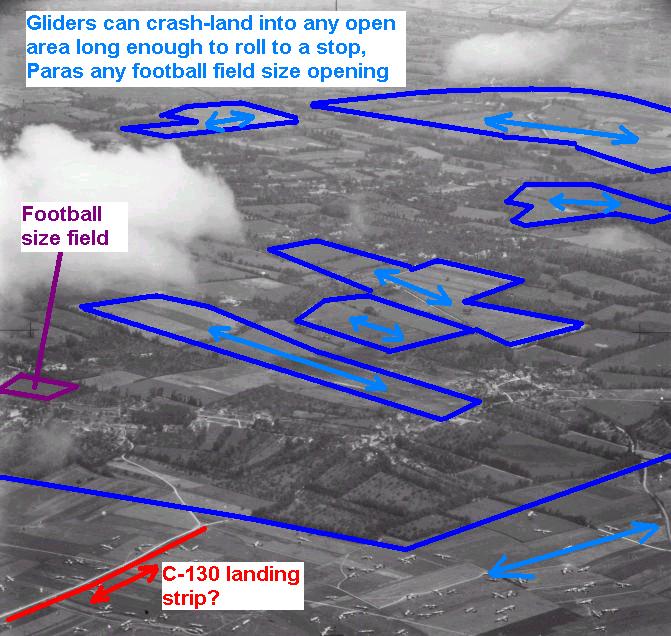
LZ "N" on D-Day, notice all the British gliders at the bottom and the many places they could have landed in BLUE. The one place today's C-130 could have landed in RED, a small road would mean one plane-at-a-time and forever to land an effective military force--parachute airdrop is far faster
When Gavin is talking about a "cow pasture" powered plane he is talking about a plane that can CRASH LAND either on skis, skid-wheels or tracks or simply drops a KIWI pod that does the skidding to a halt. Yes, if the powered Hamilcar isn't wrecked it could take-off again and fly back to base, but when the pampered, doesn't-want-to-get-dirty U.S. Air Force heavyied up our own CG-20 glider to the point that it became a RUNWAY dependant airplane we lost the capability to land anywhere. Regulars in peacetime don't want to crash-land and pilots certainly don't want to be stranded and have to fight as ground troops if their powered glider can't take-off and get them back to base. What we're saying is that the USAF's laziness and cowardice to not have to fight or get dirty has ruined our Airborne warfare capabilities because we now have to work around their planes that cannot and will not land anywhere.

LZ "N" today: the USAF cannot airland there, only airdrop from overhead, this is regress not progress
The USAF has also refused to field technologies that would enable extreme short take-off and landing (ESTOL) on their existing planes or to fund a vertical take-off and landing (VTOL) assault transport because it helps the Army win wars by maneuver and they want to try to win wars by themselves using Douhet firepower bombing.
The U.S. Army Airborne should adopt a Land-with-Power concept of operation. We should parachute drop M113 Gavin light tanks to carry paratroopers and some with large cannon assault guns and others bulldozer blades and Rhino Snot soil sealant trailers from existing USAF C-130s and C-17s so they need not have to land and we need not have to seize a runway. We then build the runway ourselves just as we were going to do as Flint points out in Holland using British flown Hamilcars to carry our bulldozers and airfield combat engineers. This force in light tanks is Gavin's Sky Cavalry and Grange's Air-Mech-Strike Force that has armor protection, superior cross-country mobility, firepower and vital supplies to not just "seize and hold" but can go to where the enemy is and collapse him, an American blitzkrieg. In the meantime, we should press the USAF to field a C-17 derivative that can drop 10 ISO container BATTLEBOXes from a few feet over the ground without complicated parachutes in one pass or at higher altitudes glider pods for stand-off coup de main assaults and to create a VTOL assault transport that can deliver one M113 Gavin and a 9-man squad anywhere in the world while being invisible to radar. The American airhead becomes a fortified BATTLEBOX operating base, dispersed, hardened and with self-sufficient solar/wind staying power requiring minimal resupply sorties of fossil fuel and food since it can collect its own water and shoot the enemy's ammunition.
Cactus Air Force Sort Of....
One of the downfalls of American "air power" is its refusal after the 1947 U.S. Air Force separation from the U.S. Army to develop the technologies to operate fixed-wing aircraft from unimproved ground---Army Lieutenant General Gavin's "cow pasture" aircraft. Extreme Short Take-Off and Landing (ESTOL) technologies like tracked and air cushion landing gear and eventually vertical take-off and landing (VTOL) capabilities would enable nearly any flat open area to become a take-off and landing strip for observation/attack and transport planes. However, without this technological push, aircraft are stuck in the rolling tire landing gear "rut"--pun intended. If expedient surfaces are smoothed and not secured by aluminum matting or Rhino Snot sealant ruts can form that when an aircraft rolls into them rips off its landing gear. The photo below of Landing Zone "N" in Normandy on D-Day, June 6, 1944 showing many British gliders on it reveals the kind of grassy fields Gavin wanted his Airborne forces to be able to land into and take-off from that was once possible with gliders but no longer today.
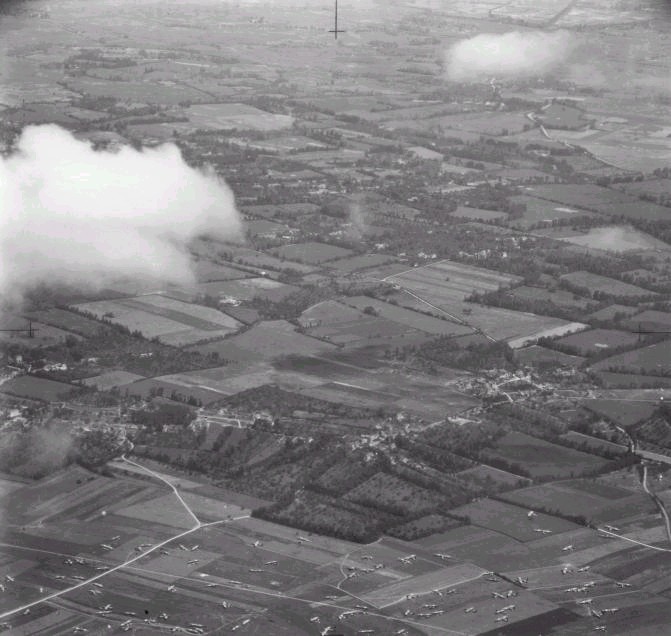
Static Forward Air Base Security Math: Poor Force Structure Quality cannot be Saved by Quantity
Stuck--pun intended---with wheeled landing gear, aircraft have been restricted to how little of this smooth runway they can live with by their SIZE which drives runway thickness/hardness and their required run LENGTH to create lift. The length of the runway then drives the force size needed to guard it by area formula which translates into basically 6x its length. If a runway is 10, 000 feet long, at the bare minimum it needs 60, 000 feet of perimeter defended just to keep enemies off the runway from cratering it or placing obstacles on it. Generally, effective small-arms fire range is 300 meters or 1, 000 feet so to keep small caliber 7.62mm bullets out, the perimeter needs to grow in all directions by 2, 000 feet because you need stand-off from the front and back ends of the runway. So a 10, 000 foot runway requires 72, 000 feet of perimeter to keep small arms fire away. Most small man-portable air defense systems military jargon for shoulder-fired surface-to-air missiles (SAMs) have 2.5 mile or 13, 200 foot range. To keep MANPADS away, the air base needs from its 10, 000 foot ends another 13, 200 feet added for a total length of 36, 400 feet which multiplied by 6x equals a perimeter of 218, 400 feet or 41.36 miles. To protect a minimum sized air base with a 10, 000 foot runway from direct fire weapons (small arms fire up to heavy machine guns and MANPADS) requires an infantry force of 41 companies!
www.globalsecurity.org/military/library/policy/army/accp/in0754/ch1.htm
IN 0754 PREPARE AND PLAN AN INFANTRY COMPANY DEFENSE
"Units will occupy defensive frontage approximately one-third of that occupied in open areas. An infantry company, which might occupy 1,500 to 2,000 meters in open terrain, will likely be restricted to a frontage of 300 to 800 meters in urban terrain, depending on the density of buildings and rubble, and the street patterns."
This translates to 10+ battalions or 3+ brigades or 1 division of 10, 000 men just to defend the air base---somewhat. This doesn't defend the air base from long range mortar and artillery fires of 7 kilometers and 30 kilometers from decisively shutting down the runway and the French para's supplies as Giap's VietMinh did to Dien Bien Phu in 1954 with hidden 105mm howitzers and 20mm anti-aircraft guns. To create a "recon & security" perimeter to keep enemy mortars and artillery out of range of incinerating exposed aircraft laden with fuel, weapons and troops requires an R&S perimeter of 120 kilometers or 378 kilometers requiring 80 to 252 infantry companies or 2 or 6.3 divisions of 20, 000 to 63, 000 men! However to do static air base security right, one needs the INNER perimeter of 1 division to keep out any "leakers" who get by the OUTER R&S mortar/artillery perimeter of 2 to 6.3 divisions. Thus, to keep one single air base like DaNang or Tan Son Nhut safe in 1965 from Viet Cong direct fire and direct high explosive emplacement "sapper" attacks would require 1/3rd of the entire USMC to rotate in for 1 year or 1/20th of the U.S. Army. To actively patrol a R&S perimeter large enough to keep mortars/artillery out would require the entire USMC plus 3 Army divisions (1/7th of the then 20-division U.S. Army) for just one year then having to be completely spelled by Army thereafter at least for a 1 year hiatus with 1/3rd of the active duty U.S. Army. In 3 years of guarding such an Gavin-style enclave, the entire U.S. Army would have gone to Vietnam, but it might be not so financially costly or lethal to our forces that we could stay there indefinitely to prop up a friendly nation-state government--which we failed to do when we stopped just defending air bases and mission-creeped into career ticket-punching self-validating sweeps for the sub-national and nation-state enemy all across Vietnam. Once we took over fighting from the inept ARVN we began to be financially/casualty bled by the VC/NVA, whose leadership in Hanoi knew we couldn't sustain indefinitely. So if the VC/NVA couldn't instigate a battle defeat like a Dien Bien Phu ("Super Bowl") they would defeat us by making it too costly over time to stay in the "game" ie; we "stop playing football because our knees are shot". One way to defeat "Walter Payton" is have him "retire". War is not just won by duels between armies (battles). Sun Tzu's warning that prolonged wars bring about defeat is not heard by war racketeers who profit from our troops being bled for career officer's to advance by "combat experience".
Had we kept to Gavin's enclave strategy (see his 1968 book, Crisis Now) and refused the enemy battles to bleed us, sallying forth only as needed--say if the NVA tried to cut South Vietnam in two which Moore's 1st Cavalry stopped at LZ X-Ray (but at needless high costs because he didn't have M113 Gavin armored personnel carriers) there is a chance that we would have had American ground forces in position to defeat NVA invasions in 1972 and 1975 in a WW2-style super bowl-type climactic linear battle we somewhat understand. We lost forfeited Vietnam because we couldn't afford to show up because when we were there our "limited war" military incompetence made our presence too costly to maintain.
Better Sub-National Conflict (SNC) Means Begin with Better Aircraft and Tanks
The point here is that we need the qualitative means to prevail in non-linear, sub-national conflicts (SNCs) where civilian life all around, tries to co-exist amongst rebels trying to overthrow the government. First, we must secure the threatened nation's borders with a Morice line type barrier with fencing and sensors patrolled by indigenous troops who we train and equip to a high standard to be an air-mobile cavalry in M113 Gavin type, all-terrain, tracked armored fighting vehicles. Flying overhead are observation/attack fixed wing planes to keep 24/7/365 pressure on any outsiders trying to infiltrate to help the rebels. MacNamara was right about his line on the DMZ to keep the NVA out and unprofessional stupidity of the validate-their-penis-by-gun-battles USMC that refused to build this necessary impediment to infiltration to create a linear separation damned our entire effort in Vietnam. The entire existence of such incompetent egomaniacs as the USMC breeds is counter-productive to the national security of the U.S. and the entire non-adaptive, obsolete outfit should be disbanded. Inside the country, walls and checkpoints manned by indigenous troops would deny warring factions or individual rebels the ability to infiltrate high explosives to car bomb and land mine attack. Americans would have primarily a training/equipping role of the indigenous government workers and have a low-key presence so as to not inflame the locals to rebel against us. We need to create a non-linear battlefield stability corps (NLB-SC) composed of older, more mature adults who have budgets direct from Congress that are ready and equipped and funded to get a nation-state government back on its feet not this "Phase IV" ad hocery that damned us in Iraq. Details:
www.combatreform2.com/johnpaulvann.htm
Now we are back full-circle--pun intended---to static air base security driven by our bullshit Air Force's desire to fly too fast and too high with thin-wing fighter-bombers that need long 10, 000 foot runways and to live in comfortable bases with a slice of excessive American consumerism replicated inside sure to infuriate the locals with our excess. By realizing we need slower aircraft to differentiate friend from foe in SNCs, these aircraft can also land on shorter runways or better yet no runways at all, drastically reducing our troop presence on the ground.
The USAF Air Commandos led by legendary genius Brigadier General Heinie Aderholt realized that aircraft slower than 600+ mph jets would be needed just to differentiate "limited war" enemies who try to belt buckle hug American forces on the ground to deny us being able to bring land/sea artillery and air strikes against them as General Ridgway did to them in the Korean war by WW1 style trench lines to create adequate separation. The Air Commando aircraft depicted below show what can be done with slower aircraft and rolling wheel landing gear.
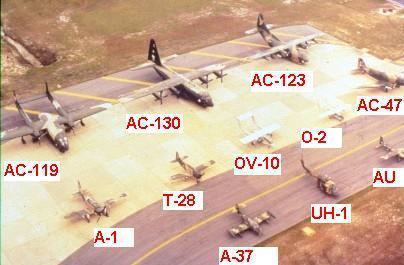
The biggest aircraft depicted, the gunship version of the C-130 simply cannot at 150, 000 pounds plus land on anything less than 3, 000 foot runways, ending up with the Army having to defend a base perimeter of 10 miles against direct-fire weapons, 25 miles against heavy mortars and 62.5 miles to keep long-range 155mm artillery out of range. This still translates into a brigade of Army troops for close-in protection and another 3 or 6 brigades (30, 000 men) for long-range outer protection. With an Army of 30 brigades, one air base defense for one year would require 1/30th or 1/10th or 1/5th of the Army to occupy. "Air Power" using even STOL aircraft is killing the Army by having it maintain its existence through easily ambushed truck resupply convoys or make the taxpayers go broke having to Dien Bien Phu airlift supplies in at a cost of $64, 000/flight hour by C-17. We have more than one such air base in Iraq so that 150, 000 troops are there doing mostly nothing but consume supplies and keep our airplanes safe is costing us $2 BILLION a week--expenses we cannot sustain so we will have to leave the "playing field" because we cannot afford to keep the "stadium" (air field) open.
Let's return to Aderholt's planes...
Notice next the C-123 gunship with two engines that could operate from 2, 000 foot runways. This was originally the CG-20 heavy glider with rear loading ramp that Gavin wanted to crash land into cow pastures but the pampered USAF heavied up into a static runway dependant plane.

If our bases can shrink to 2, 000 foot runways the security reduction pay-off is a base perimeter of 5 miles for direct fire, 12 miles for mortars and 30 miles for tube artillery such that 1/2 a brigade for close security and 1 brigade for a mortar perimeter or 3 brigades for artillery defense. This is progress towards smaller FOBs that justifies the new twin turboprop-engined C-27J which can airdrop/airland a M113 Gavin light tracked AFV to effect 3D air-mech Sky Cavalry maneuver as Gavin insisted we need. For VTOL air assault operations a reduced-size "Mini-Gavin" can be air-meched by CH-47 Chinook helicopters. This should be the largest plane operated by a small nation's air force since it can deliver real army ground combat power without excessively sized air bases. If we applied ESTOL technologies, the areas to land could be decreased by another half and we'd regain the glider land-anywhere capability we lost when the USAF was born.
The U.S. Army Airborne should adopt a Land-with-Power concept of operation. We should parachute drop M113 Gavin light tanks with the latest armors to counteract land mines and advanced shoot-on-the-move firepower and stealthy electric drive band-tracked 60 mph+ off-road mobility to carry paratroopers. Some with large cannon assault guns and others bulldozer blades and Rhino Snot soil sealant trailers from existing USAF C-130s and C-17s so they need not have to land and we need not have to seize a runway. We then build the runway ourselves just as we were going to do in Holland in 1944 using British flown Hamilcars to carry our bulldozers and airfield combat engineers. This force in light tanks is Gavin's Sky Cavalry and Grange's Air-Mech-Strike Force that has armor protection, superior cross-country mobility, firepower and vital supplies to not just "seize and hold" but can go to where the enemy is and collapse him, an American blitzkrieg that can surprise, encircle and kill/capture Bin Ladens/Noriegas like we did with light tanks in Panama in 1989. In the meantime, we should press the USAF to field a C-17 derivative that can drop 10 ISO container BATTLEBOXes from a few feet over the ground without complicated parachutes in one pass or at higher altitudes glider pods for stand-off coup de main assaults and to create a VTOL assault transport that can deliver one M113 Gavin and a 9-man squad anywhere in the world while being invisible to radar. The American airhead becomes a fortified BATTLEBOX operating base, dispersed, hardened and with self-sufficient solar/wind staying power requiring minimal resupply sorties of fossil fuel and food since it can collect its own water and shoot the enemy's ammunition.
Container Transport Planes: "Cow Pasture" KIWI Pod Aircraft for Speedy, Minimalist Air Delivery
LAPES (Low Altitude Parachute Extraction System) from 5-10 feet has been discontinued from USAF use due to a fatal accident at Sicily Drop Zone on Fort Bragg, North Carolina when a M551 Sheridan light tank on a platform as it rolled off the rear ramp of a C-130 caught both the ground and the edge of the ramp, ripping the plane's tail off. The pilot was actually TOO LOW. The idea of LAPES--using the minimum of parachute materials to get a load to the ground is sound, it just didn't go far enough because it was trying to WORK AROUND A FUSELAGE, subsidizing a pre-existing inefficiency.
LTG Gavin realized this long ago in 1947, in his book Airborne Warfare [www.combatreform.org/airbornewarfare.htm] that the most efficient way to be already loaded and ready-to-fight is to be already be in a KIWI POD, and the fastest way to get this stuff to the ground is not to pull it out break-bulk from inside a fuselage but to DROP THE ENTIRE KIWI POD. If you drop the pod you don't have risks of getting caught up inside the fuselage.
We have Gavin's KIWI pods today--they are called ISO shipping containers. These containers can be made into "BATTLERBOXes" for specific Army missions like being bunkers for troops to live in as well as carry everything the Army needs to fight etc. The early-model Sikorsky CH-54 SkyCrane VTOL helicopter was ahead of its time but required special expensive lightweight pods to conserve its limited 15-ton payload that the Army couldn't afford to buy. The Army today doesn't need costly single-application pods, there are millions of ISOs that can travel by land, sea or air available at less than $5, 000 each. What the Army needs is the USAF to do its damn job and supply a fixed-wing SkyCrane-type transport plane that can deliver 100 tons and drop its BATTLEBOXes with extreme STOL "cow pasture" landing capabilities.
This is a bugaboo because the fighter-bomber jock USAF wants to try to win wars by firepower bombing and doesn't give a damn about helping the Army to win wars by maneuver. The USAF has for over 6 decades refused to supply the Army with a plane that can land on any cow pasture by conveniently only creating runway dependant transports that could parachute airdrop things IF the Army takes the time to rig them with expensive and costly parachutes. This is fine to take a drop zone by assault but afterwards for RESUPPLY the USAF wants a secure and smooth, long 3, 000 foot minimum runway which places Army Paratroopers in a suicidal position of having to first take a heavily-defended airfield or build-one-from-scratch. The latter is do-able but it takes TIME we may not have provided us by a laggard enemy.
All of this complication can be solved by simply creating a C-17 SkyCrane derivative that can carry and DROP 10 x 20-foot BATTLEBOXes from very low altitude as in ZERO---because the plane itself touches only a small air cushion and as it flies forward, ISO containers are dropped in sequence from back to front without ANY special parachutes or platforms.
The BATTLEBOXes might be lined with SKEDCO plastic on the bottom to slide easier along the ground---but that's it. The KIWI Pod C-17 doesn't need a smooth surface for landing gear wheels because its Air Cushion Landing System (ACLS) enables it to land on any roughly flat unprepared surface to then commence BATTLEBOX dropping from such a low actual height that no position-righting parachutes are needed nor any parachutes to pull it out from the fuselage BECAUSE THERE IS NO FUSELAGE! There will not be any LAPES/Sicily Drop Zone type accidents, after the C-17 SkyCrane has dropped its BATTLEBOXes, it takes-off and leaves the assault zone even if its considered "secure" because we don't want the bottleneck of "MOG rate" that occurs when wheel landing gear planes need to after landing taxi back to an upwind take-off position, hogging up the runway. With C-17 SkyCranes there wouldn't be any runways---just an open area with lanes marked on it so multiple C-17s can essentially touch 'n go and drop their BATTLEBOXes.
After the C-17 SkyCrane takes-off from its designated lane, 10 x special M113 Gavins tracked armored fighting vehicles with forklift tines on their front bulldozer blades drive to the 10 x BATTLEBOXes and pick them up like the video game "Pac-Man" and drive them to the collection point, clearing that SkyCrane lane for another pod drop-off sortie. The British figured out they needed tracked armored vehicles to clear supplies off exposed drop and landing zones by glider-landing Bren gun carriers in 1945, and we are long overdue to use this method.
The C-17 SkyCrane-BATTLEBOX would dramatically speed the delivery of supplies to Army forces because there'd be no parachute/shock absorber rigging cost/complication and at 5 tons per BATTLEBOX there'd be plenty of ammo, food, water to grab by simply opening the doors of the ISO containers and getting what you need. The Army just has to grab the entire BATTLEBOX and move it to where it wants it, to include arranging them as walls to create fortified forward operating bases. All that requires for this to occur is for Congress to order and fund Industry/USAF to create and field C-17 SkyCranes to create the EFFICIENCY up-front to deliver containerized supplies without having to work around built-in cargo volume fuselages--current transport aircraft are like old fashioned cargo ships and need to become containerized to be maximally efficient like the container ships the entire world depends on.
Fighter-IN-A-Box: Ground-Mobile Observation/Attack Planes Evade Enemy Targeting
Notice the observation/attack prop planes....capable of high G diving attacks, the heaviest, the A-1 SkyRaider can deliver fighter-bomber ordnance loads of 16, 000 pounds and this capability reduces down to the observation planes capable of only hundreds of pounds or rocket or gun pods. However, the beauty of these "grasshoppers" is that they can operate from 1, 000 feet or less strips and be ground-mobile in ISO container "BATTLEBOXes" if their wings fold or detach like V-2 missiles were in WW2 and impossible to target as Gavin notes. We could have a small grasshopper/large grasshopper team of observation/attack planes or if really hurting for money have just the attack utility plane do it all---observe, attack and transport small teams of men. If AUs can be made to diving attack effectively or have swiveling cannon on their bellies to be stand-off gunships, then they'd be actually OATs--observation/attack transports. Imagine if OATs had tracked or air cushion landing gear---they could ESTOL land nearly anywhere and operate from camouflaged and dug-in BATTLEBOXes ORGANIC to Army ground MANEUVER UNITS--in other words--no static bases needed at all if in a temporary nation-state war situation. Now look at the amazing A-37 Dragonfly capable as a microjet of 500 mph---able to fly slow as well, this jet could shoot down with air-to-air missiles enemy fighters that stray into the Army's low-level air space if they leak through the USAF's fighter-bombers as commonly occurs. We'd have the low altitude Army Air Forces with a 24/7/365 "maneuver air support" air presence we need to overlap with the medium-to-high altitude USAF that currently has the former mission but doesn't want to do it. A return of the Army Air Force would reduce our land foot print during SNCs and empower Army 2D/3D maneuver during nation-state war, by getting technologies for ESTOL and VTOL on the right track instead of being ignored by the USAF or botched by the USMC with the overly complex flawed V-22.
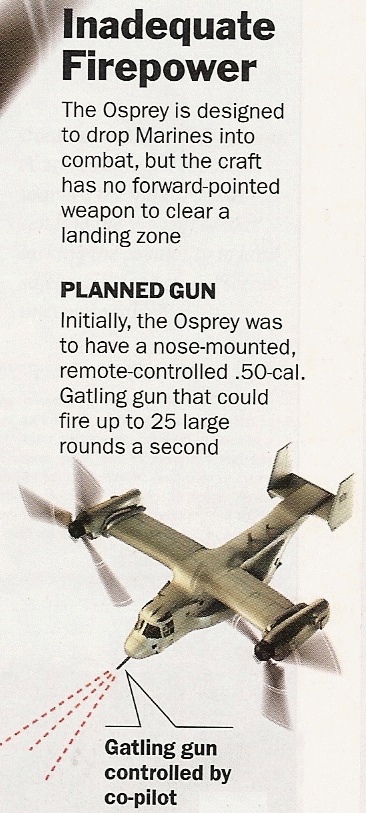
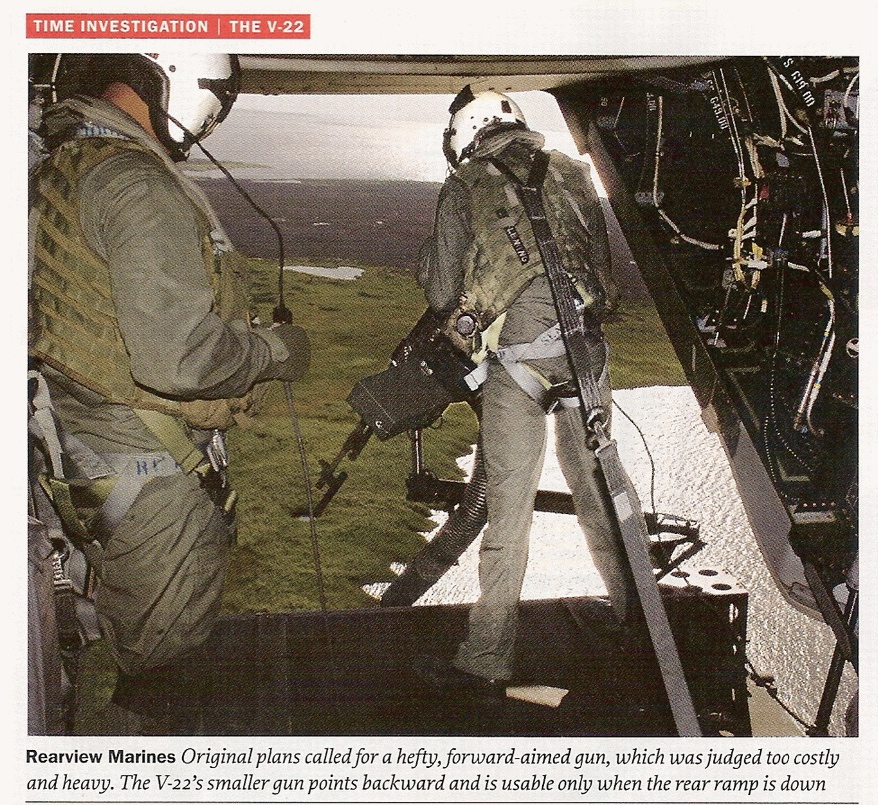
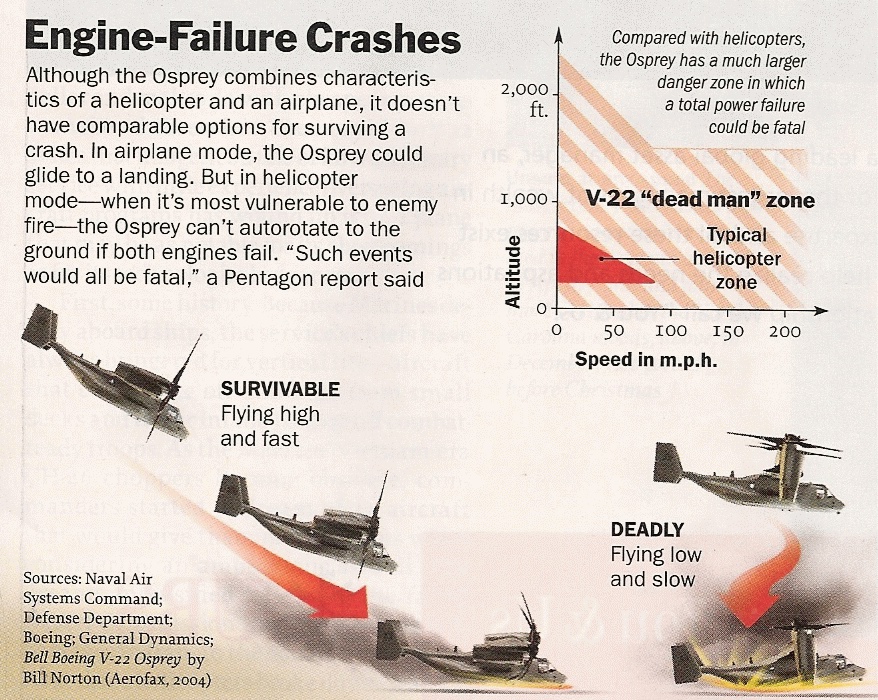
A brief word about the supercarrier Navy/expensive flooding well-deck marines and their lying Midway myth/Iwo Jima re-enactment bullshit sure to pick up on the need to reduce American land presence to try to further their own egorackets. First, there are places in the world where its not cost efficient to fly carrier planes inland. Second, where a watery edge is near a SNC, the grotesquely inefficient supercarrier is a dismal failure as its presence bleeds the taxpayers dry. To make matters worse, the F-18 jets fly too fast to render effective close air support for the Army. If we are to seabase for SNCs, we need affordable container ship aircraft carriers or the large mobile offshore base (MOB) operating useful-to-SNC planes---like the prop-plane SkyRaiders and Corsairs were in Korea operating from smaller fleet and escort carriers. The MOB will again offer real not make-shift runways to operate planes at sea---if we need C-17s to land Army troops ashore the MOB can facilitate this without a bunch of marines dying on a beach to self-validate and seize an air base we didn't need in 1944 to drop atomic bombs on Japan by B-29s and we certainly don't need today. If we want to try to bomb civilians and make their government leaders cry "uncle" this is best done by heavy bombers from land bases or large seaplanes capable of inflicting enough hurt to have effect not handfuls of short-range fighter-bomber "lawn darts" from aircraft carriers.
Either Army Air Forces or Air Commandos---or both
The time has come for Congress to admit the separate service USAF has been a huge mistake and create forces that will prepare for SNCs and act as a Sky Cavalry in nation-state wars. Either the USAF Air Commandos get the job with direct budgetary access to Congress so they don't have to "mother may I" budget in-fight internally with the fighter-bomber egojocks running the USAF brass or the Army gets funding to form its own low altitude Army Air Force with this mission area taken away from the power-hungry, centralizing USAF that doesn't want to do the job. If transport planes transfer to Army ownership/operation then the Army culture of blue collar assholes playing back-stabbing games will have to cease in order to retain the services of the smart adults in the USAF who will not tolerate such childish bullshit. If not, the C-130s and larger transports will remain USAF operated but Congress should mandate their development be driven by Army needs for cow pasture ESTOL operation and end the pampered air base subsidization by deliberate emasculation of transport aircraft landing capabilities. If we don't create sustainable force structures to prevail in limited wars don't complain when we continue to have self-created defeats like Vietnam and Iraq.
NOTES
General Gavin's most important works are online:
Airborne Warfare (1947)
www.combatreform.org/airbornewarfare.htm
Harper's magazine article "Cavalry and I don't Mean Horses" (1954)
www.geocities.com/gavinpetition/cavalryandidontmeanhorses.htm
War and Peace in the Space Age (1958)
www.geocities.com/gavinpetition/warandpeaceinthespaceage.htm
Crisis Now (1968) can be bought used from amazon.com
www.geocities.com/gavinpetition/crisisnow.htm
Powered-aircraft
JU-52 "Iron Annie"






Separate equipment containers being loaded under JU-52s prior to Crete operation

JU-52 fuselage used as a realistic jump door trainer (good idea U.S. Army should adopt)
JU-52 right cargo doors to load/offload Kettenkrad motorcycle half-tracks and LG 40 75mm or LG42 105mm Recoilless Rifles. Picture above shows a motorcycle and side car, dismantled 20mm anti-aircraft gun and a towed anti-tank gun being loaded into a JU-52.
German Paras History
Note: lack of control hanging from single point under parachute, no long rifles/machine guns jumped attached to the body, separate container dependant
www.youtube.com/watch?v=hURjXxbyQ9k
PART 1
www.youtube.com/watch?v=4r0myiKCp4E
PART 2
www.youtube.com/watch?v=qYCMpBloqww
Crete: Operation Mercury
PART 1
www.youtube.com/watch?v=ZIyRk33pf30
PART 2
www.youtube.com/watch?v=Lwx9F7YzO_U
JU-52 can be best seen in the Clint Eastwood movie, "Where Eagles Dare"
Air-Mech-Strike Model Building: 1: 72 scale JU-52
Italeri minesweeper (ditch the magnetic thingee use German Luftwaffe markings)
http://cgi.ebay.com/Italeri-1-72-Model-Airplane-Kit-German-Minssweeper-Ju52_W0QQitemZ160128111474QQihZ006QQcategoryZ50299QQcmdZViewItem
or
1:72 scale JU-52 civilian Lufthansa and buy German Luftwaffe decals
www.squadron.com/ItemDetails.asp?item=IT0150
Decals
www.squadron.com/NoStock.asp?item=ETD7216
1: 72 scale Kettenkrad motorcycle half-track
www.squadron.com/ItemDetails.asp?item=HE31113
1: 72 scale LG42 105mm recoilless rifle
www.squadron.com/ItemDetails.asp?item=KPT72310
Me-323 "Gigant"


An Me323 unloading a tank destroyer based on a PzKpfw II tank chassis. This is almost certainly a Marder II, equipped with a 75 mm PAK 40 gun. At around 11 tonnes, this would be close to the limit of the Me323's theoretical payload - in practice, the limits were probably exceeded on many occasions, with consequent reductions in safety margins. We are not aware of an injection-molded kit of the Marder II in 1/72 scale, but there are still plenty of vehicles that could be used with an Me323 kit. If Italeri speeded up the re-release of the huge ESCI back-catalog at their disposal, then the choice would be greater still.
The British took 3 years to design and field their Hamilcar heavy gliders to fly in Tetrarch/Locust light tanks and Bren gun armored personnel carriers, the Germans designed and fielded Me-321 glider squadrons in under a year! In less than another year, they had a 6-engined powered version, the Me-323 in service. Keith Flint writes in Airborne Armour on pages 206-207, about how the Germans used their Me-323s in 1942 to do the world's first air-mech operation with tracked armored tanks:
They were not cleared for flight on instruments, and so could not be flown at night to avoid enemy interference.
Operations the Mediterranean began in November 1942 with the Gigants formed into Kampfgeschwader (z.b.V.) 323, with three groups of 6 aircraft plus a headquarters with three aircraft. The main task was flights from Italy to Tunis and Bizerta carrying supplies for the Afrika Korps. The Gigants usually flew in mixed streams with large numbers of Ju-52, three-engined transports, along with a large fighter escort. The missions continued through to April 1943, but losses to fighters en-route, and on the ground in Tunisia, eventually led to the withdrawal of the aircraft. The last straw was on the 22nd of April, when 14 out of formation of 16 Me-323s were shot down by RAF fighters, with another destroyed in a strafing attack on the airfield at Tunis. During December 1942, some Gigants had been moved to Russia to take part in re-supply missions to Stalingrad. Operations in Russia, after withdrawal of the aircraft from the Mediterranean, continued until at least May 1944, with main bases in Warsaw, Kecskemet (Hungary) and Focsani (Rumania).
The aircraft were assigned to Transport-geschwader 5 (Transport-wing 5), which consisted of two Gruppe, although according to William Green "the Messerschmitt transport was never available in really substantial numbers".[11] Production of the aircraft ceased in April 1944, and following continuous losses on the eastern front TG5 was disbanded in August 1944.
The Me-323 was used primarily as a normal transport aircraft, carrying supplies, men and fuel and evacuating casualties. There is evidence, however, that armoured vehicles were transported on at least one occasion in the Mediterranean. In Frank Vann's biography of Willy Messerschmitt he quotes the following letter to Messerschmitt regarding operations in November 1942:
The first Me-323 flew with an assault gun and the necessary ammunition to Bizerta immediately after our landing in Tunis. It unloaded there without any trouble and returned to its home base without any damage. It was this assault gun that we have to thank for being able to break through the ring of American tanks drawn up in a circle of 12 kilometres diameter around Bizerta. On the very first day 8 tanks were destroyed by it and on the next day that total went up to 28. More assault guns were flown over with the Me-323 and these opened up for the troops the possibility of driving the Anglo-Americans even further back.
...The transport of the assault guns was necessary because the Straits of Otranto had been completely mined by the enemy. This had the result that one of our transport ships loaded with tanks was blown up.
This information might be thought to dent the unique reputation of 6th AARR as the only unit to fly tanks into action in World War Two, but it must be pointed out that the German armoured vehicles were flying as part of a transport mission .rather than an assault landing. The type of assault gun is not mentioned, but they cannot have been the Wehrmacht's standard assault gun, the Sturmgeschutz III, as these vehicles would be too heavy for the Me-323. They would appear to have been one of the versions of the Marder self-propelled gun.

Me-323 Air-Mech Op in Russia
www.youtube.com/watch?v=6e639Ec9lsQ
This important video shows that the 20, 000 kg payload capacity of the Gigant was capable of air-meching Czech-built Pz.Kpfw. 38(t) LIGHT TANK weighing at 9.7 to 9.85 tons
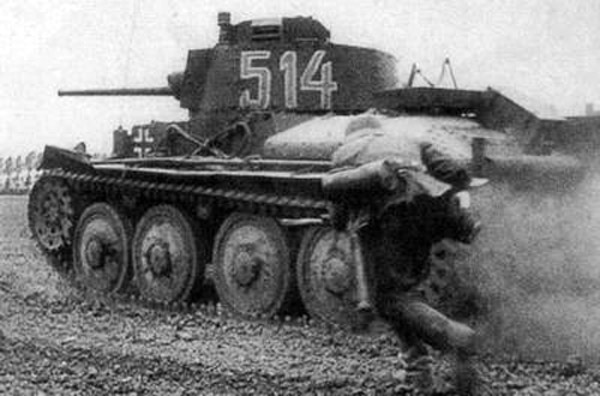
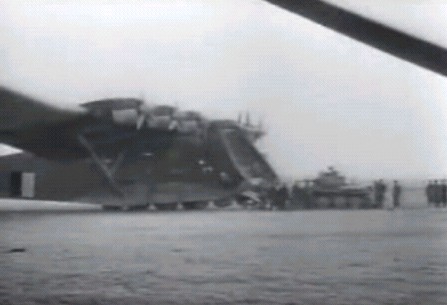
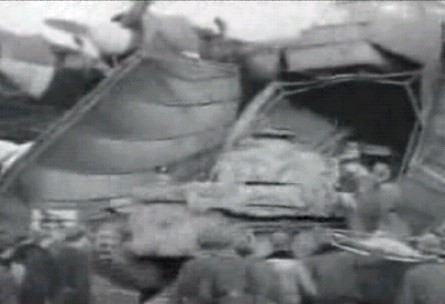
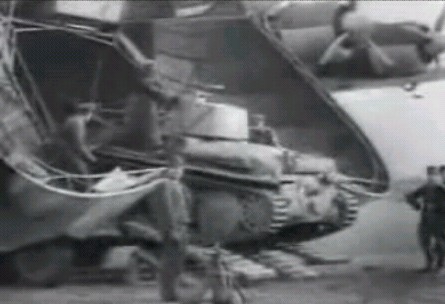
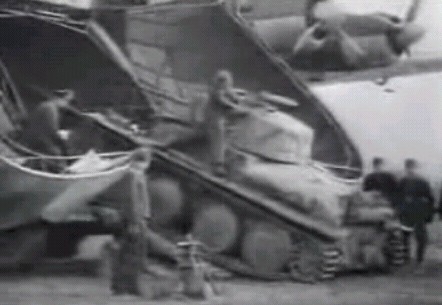
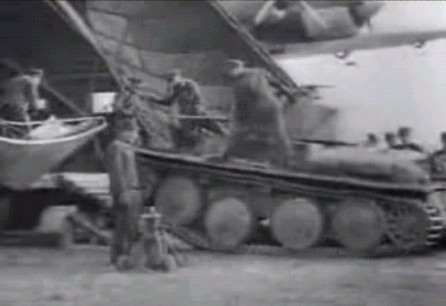
Me-323 Air-Mech Testing
www.youtube.com/watch?v=oIN6JCy02j8
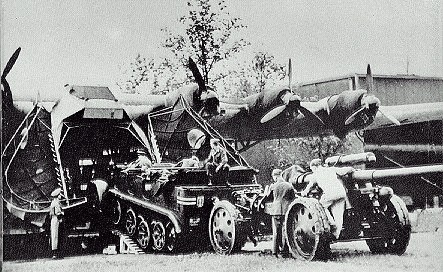



The business end of the Me323. It could transport up to 120 fully-equipped troops.
The genesis of the Me-323 Gigant (giant) transport was in a 1940 German requirement for a large assault glider. The DFS 230 light glider had already proven it's worth in the famous attack on the Eban-Emael fort in Belgium (the first ever assault by gliderborne troops), and would later be used successfully in the Crete invasion in 1941. However, the prospective invasion of Great Britain focused minds on the need to be able to airlift vehicles and other heavy equipment as part of an initial assault wave. Although 'Sealion' was cancelled, the requirement was still a valid one with the focus now on the forthcoming invasion of the USSR. On October 18th 1940, Junkers and Messerschmitt were given just 14 days to submit a proposal for a large transport glider. The emphasis was still very much on the assault role: the ambitious requirement was to be able to carry either an 88-mm gun and half-track tractor, or a PzKpfw IV light tank. The Junkers Ju-322 "Mammut" reached prototype form, but was completely unsatisfactory and was scrapped. The Messerschmitt was originally designated the Me-261w, was then changed to Me-263, eventually becoming the Me-321.
The initial production order was for 200 x Me-321's. Some sources say that all 200 were delivered, other say only 150. The last 100 had an enlarged flight deck to allow for a side-by-side pilot/co-pilot arrangement - the early machines had just one pilot. With a construction mainly of tubular steel, the glider was enormous, with a length of 28.5 m and a wingspan of almost twice that. Rather like the Me-163 Komet, the Me-321 had a detachable wheeled dolly for take-off, and a skid arrangement for landing. Given the lack of heavy bombers and powered cargo aircraft available to the Luftwaffe, getting the glider airborne was always problematic. Underwing RATO packs for take-off were only a partial solution. One towing option was the Troikaschlepp: three Bf-110's towing the glider together, with the centre Bf110 being 20 m ahead of the other two. This was a highly dangerous arrangement, and one test ended in utter disaster with the loss of all four aircraft and crew, and all 120 troops on board the Me-321. A better solution was the Heinkel He-111 Z (Zwilling, or twin), which involved two He-111's joined together with a new central section and a fifth engine. Although the Me-321 saw considerable service, it was never used for a Maltese invasion, or for any other such undertakings.
Early in 1941, the decision had been taken to produce a motorized variant of the Me-321. It was now realised that a serious heavy-lift requirement would exist outside the specialized assault role, and that a huge glider that needed specialised towing aircraft, rocket packs and other equipment was simply not the answer. After much study, it was decided to fit six French Gnome-Rhone GR14N engines. These were in production and readily available, and could easily be bolted on the wing, which consequently needed to be strengthened. A cabin for a flight engineer was added in each wing between the inboard and centre engines, although the pilot could override each engineer's decision on engine and propeller control. A brand-new permanent landing gear was bolted on to the side of each fuselage, and gave the resulting Me-323 superb rough-field performance. Compared to the Me-321, the Me-323 had a much-reduced payload of between 10 - 12 tonnes, which was the price that had to be paid for an aircraft that could operate autonomously. Even with the engines, RATO packs were still frequently used.
Just under 200 x Me-323's were built before production ceased in April 1944. There were several production versions, beginning with the D-1, which is the subject of this kit. Later D- and E- versions differed in the choice of power plant and in defensive armament, with improvements in structural strength, total cargo load and fuel capacity also being implemented. Nonetheless, the Me-323 remained significantly underpowered. There was a proposal to install six BMW 801 radials, but this never came to pass. The Me-323 was also a short-range aircraft, with a typical range (loaded) of 1,000 - 1,200 Km. Despite this, the limited numbers of Me-323's in service were an invaluable asset to the Germans, and saw intensive use. The Me323 was something of a "sitting duck", being so slow and large an aircraft. In the final weeks of the North African campaign in April/May 1943, 43 Gigants were lost, along with much greater numbers of Ju-52's. In terms of aircraft design, the Me-323 was actually very resilient, and could absorb a huge amount of enemy fire - the Afrika Korps' nickname of Leukoplastbomber (Elastoplast Bomber) was somewhat unfair. However, no transport aircraft can ever be expected to survive without air superiority or at least, comprehensive local air cover, and it is believed that no Me-323's survived in service beyond the summer of 1944.
Air-Mech-Strike Model Building: 1:72 scale Me-323 Gigant + Czech-built Pz.Kpfw. 38(t) LIGHT TANK
1:72 scale Me323 model
www.squadron.com/ItemDetails.asp?item=IT1104
1:72 scale Pz.Kpfw. 38(t) LIGHT TANK
www.squadron.com/ItemDetails.asp?item=UM0341
C-47 "Dakota"

PART 1: Design
www.youtube.com/watch?v=X__vBwb9OBQ
PART 2: Airdrops over New Guinea in WW2
www.youtube.com/watch?v=VmDI_t7vt8Q
PART 3: MEDEVAC
www.youtube.com/watch?v=s1FAo61MhlY
PART 4: D-DAY AIRBORNE LANDINGS; C-124s and C-130s to replace them
www.youtube.com/watch?v=eqbBx_3GjDY
PART 5: THEY TRY TO REPLACE THE C-47: C-123; ECM and AC-47 "Spooky" gunships
www.youtube.com/watch?v=jhP3bfOiDjk
PART 6: AC-47s blast the NVA/VC
www.youtube.com/watch?v=KBuz_Sb2InI
The "Dakota" or "Sky Train" is probably the greatest aircraft to ever fly, period. Not only has it dropped the most Paratroopers and towed the most gliders--ITS STILL IN SERVICE TODAY!. C-47s have dropped Paratroopers in WWII, Korea, Vietnam, Algeria, Israel, Rhodesia, South Africa...
Another attribute is that the C-47 is able to land on grassy fields (Short Take-Off and Landing) capability. Small jeeps and tractors could roll on/off when ramps are connected to the left loading door. The only criticisms are that the plane is unarmored (can be fixed) and uses piston engines (can be replaced with turboprops) and the plane is slow and floor is at a steep angle without a rear ramp to air-deliver vehicles easily. Thus, in WWII it was impossible to airdrop jeeps by C-47s and gliders were necessary. The French were able to deliver M24 Chaffee light tanks to Dien Bien Phu in PIECES using Dakotas and Bristol C170s.
An excellent film on the French Foreign Legion at Dien Bien Phu and Algeria is Anthony Quinn's "Lost Command" based on the book "The Centurions" by Jean Larteguy.
The cargo floor sloping and inability to heavy drop is what led to its replacement eventually by cargo gliders that became the piston-engined powered C-122 and later C-123 and eventually the next greatest aircraft of all time: the turboprop C-130 Hercules, all of these aircraft could deliver vehicles through a high t-tail and rear ramp.


AIRLAND


Notice these troops are having a HELLUVA time rolling their howitzer into their DC-3/C-47 mock-up and the real thing!

UPDATE! Basler BT-67 Turboprop Super Dakotas flying all over the world with Allied Militaries and to the South Pole! They are better equipped than the U.S. Army is today! Can now lift 10, 000 pounds of cargo! Aircraft flies faster, at lower operating costs with lower infared/noise signature since exhausts flow over top of wing.




United States
Basler Turbo Conversions, LLC, Oshkosh, Wisconsin
Cargo & Training
U.S. Forest Service, Missoula, Montana & Ogden, Utah
Firefighting
Aerocontractors, Smithfield, North Carolina
Paratrooper Training
U.S. Air Force, Hurlburt Field, FL
Training
Antarctica
ALCI, Patriot Hills, Antarctica
Adventure Tours
Bolivia
Bolivian Air Force, Trinidad, Bolivia
Troop & Cargo Transport
Canada
Kenn Borek Air, Arctic and Antarctic Operations
Colombia
Colombian Air Force, Colombian National Police, Bogota, Colombia
Drug Enforcement, Troop & Cargo Transport
El Salvador
El Salvadoran Air Force, San Salvador, El Salvador
Troop & Cargo Transport
Guatemala
Guatemalan Air Force, Guatemala City, Guatemala
Troop & Cargo Transport
Mali
Mali Air Force, Bamako, Mali
Personnel & Cargo Transport
Mauritania


Mauritania Air Force, Nouakchott, Mauritania
Personnel & Cargo Transport
Republic of South Africa
Spectrem Air Surveys, Johannesburg, RSA
Geophysical Surveys
Thailand

Royal Thai Air Force, Bangkok, Thailand
Firebombing, Cloudseeding


To help with loading cargo on the tilted floor, Basler offers a winch!
Basler Turbo Conversions, LLC
255 West 35th Ave. P.O. Box 2305
Oshkosh, WI 54903-2305 USA
Telephone: (920) 236-7820
Facsimile: (920) 235-0381
Email: basler@baslerturbo.com
Apparently, the scientists stranded-by-choice on Antarctica (living in converted SeaBox shipping containers) are not getting enough resupply ski-equipped 4-engined C-130 flights from the Air National Guard bureaucracy and have resorted to leasing a twin-turboprop converted C-47/DC-3!



Notice they were able to get two tracked snowmobiles and an ice sled inside!
C-46 "Commando": first with 2 doors for simultaneous Paratrooper exits

German JU-252: lift the tail with the rear loading ramp!


Nord 2501 Noratlas: no more uneven cargo floors!
www.geocities.com/CapeCanaveral/Hangar/2848/noratlas.htm
When France agreed to sell 12 Dassault Ouragans to Israel in 1955, it also insisted that Israel purchase 3 Nord Noratlases. The IAF did not want the Noratlas, a new aircraft that would require changes to its training and maintenance arrays. France, however, was the only country willing to sell jet fighters to Israel and the IAF grudgingly agreed to buy the new transport as well. This was the uninspired beginning of the type's long career with the IAF, during which it played an important part in Israel's various conflicts. Dan Tolkovsky, IAF Chief-of-Staff during the signing of the initial Noratlas deal, would later comment that this imposed sale turned out to be quite a blessing.
Two pilots and three mechanics from the 103rd "Elephants" transport squadron flew to France in September 1955 to study the new aircraft. On November 1st the first Israeli Noratlas landed at Tel-Nof AFB, flown by its Israeli crew, while the remaining two Noratlases were delivered during January 1956, this time by French crews. Commonly known as the Nord, the type was operated by the 103rd squadron alongside the IAF's C-47s. The Nord provided the IAF with new capabilites which it soon put to good use. During April 1956 the Nords participated in the delievery of the IAF's Dassault Mystere IVAs, escorting the fighters on their way to Israel. More Mysteres were delievered during August, and once again they were escorted by Nords all the way from France to Israel. As tensions were increasing in the Middle East following the Egyptian nationalization of the Suez Canal in July 1956, A Nord especially fitted with additional fuel tanks carried the Israeli delegation sent to France to lay the foundation of Franco-Israeli military cooperation.
The IAF's three Nords saw extensive use during operation "Kadesh", Israel's part in the Suez Campaign launched on October 29th 1956. During the early hours of October 30th the three Nords begun dropping supplies to the paratroops at the Mitla Pass, a strategic point the troops had jumped into only a few hours before. More such supply flights were flown on subsequent days while one Nord even landed at a makeshift airstrip to evacuate casualties. More flights were flown in support of the Israeli effort in the southern Sinai, flights that also envolved inserting forces behind enemy lines. In all, the three Nords flew 51 sorties between October 30th and November 5th, by which the fighting had stopped. Nord Noratlases were also extensively used by the French during the Suez Campaign, transporting men and supplies to Israel, dropping supplies to Israeli troops on the ground as well as during the French airborne assault on Port Said.
By the outbreak of the Six Days War in June 1967 the IAF had 23 Noratlases in its inventory, 16 of which were former West German examples. In the days leading up to the eruption of the war the Nords were employed on maritime patrol missions, a role they continued to play once fighting broke out on June 5th. As Israeli forces advanced through the Sinai, Nords were also active in their support, dropping supplies and ammunition as well as evacuating the wounded. On June 7th Nords were about to drop dozens of Israeli paratroops over Sharm-A-Sheik, an important stronghold at the southern tip of the Sinai, but instead disembarked them on the ground when it was discovered that the point had been abandoned. A single Nord was destroyed on June 5th in a Royal Jordanian Air Force strike against the IAF base at Sirkin. Sirkin was not actually an active air base at the time, but several Nords had been dispersed there to evade just such an attack! The Jordanians had apparently used out of date intelligence, from the time Sirkin was a flying base, home to the IAF flight school.
Noratlas dropping supplies during the Six Days War
The eruption of the War of Attrition following the Six Days War provided even more opportunities for the IAF's Noratlas fleet to prove its mettle. Throught the late 1960s, as the war raged on around the Suez Canal, the aircraft were employed delivering troops, supplies and ammunition to the front, evacuating wouded Israeli soldiers on their return flights. In two most unusual missions the Nords became the first and only transport aircraft since the War of Independance to fly a bombing mission. In 1948 Israel had no other aircraft available for such a mission, but in 1969 8 x Nords went on bombing missions deep into the heart of Egypt. The plans for these attacks were drawn up in the beginning of the 1969, their targets two bridges over the Nile river. The IAF selected the Nord for these missions for its large fuel and cargo loads, as well as to demonstrate the IAF's capacity to strike at Egypt in the most innovative ways. On April 29th 4 Nords, two for each bridge, took off on operation "Batzoret" (drought) with rudimentry navigation maps and a bomb developed especially for the mission. While one pair managed to damage their intended target, the other pair missed their target and dropped their load on another bridge. The relative success of the operation inspired another such attack, operation "Tarnegol 169" (rooster 169). This time however, the Nords were to overfly their targets before their bombing runs, and this almost brought the mission to a disasterous end. On October 26th 4 Nords once again took off on the seven hour flights into the heart of Egypt and back. While the first mission was a complete surprise, this time the Nords encountered a complete blackout over the Nile. When the aircraft reached their targets and attempted to carry out their overflights they were immediately fired upon by anti aircraft fire. Under heavy fire, some of the Nords completed their missions, dropping their bombloads on the bridges they were sent to destroy. One Nord however was heavily damaged and one of its engines destroyed while its companion's fuel tanks were ruptured. The pair, limping back to Israel, barely managed to land at an IAF base in the Sinai, one flying on one engine and the other on its last drops of fuel.
When the Yom Kippur War broke out on October 6th 1973 the Nords once again went into action, providing much needed support for Israeli troops on the various fronts. Their most important mission at the beginning of the war was ferrying much needed troops to the Egyptian front, while the rest of the war saw continues supply and evacuation flights. After 23 years in years service, the Nord was retired in 1978, replaced by the Lockheed C-130 Hercules. A number of Noratlases were sold to the Greek Air Force. Two Nords can be found at the IAF Museum at Hatzerim.
Specification: Nord 2501 Noratlas
Type: medium range tactical transport.
Powerplant: 2 * radial piston SNECMA-Bristol Hercules 758s.
Performance: max speed - 440km/h, service ceiling - 7,100m, range - 2,500km.
Weights: empty - 13,300kg, max takeoff - 22,000kg.
Dimensions: span - 32.50m, length - 21.95m, height - 6.0m.
Armament: none.
C-54: tricycle landing gear--no tail dragging for trying to load uphill but now loads must be lifted up to fuselage--unless...



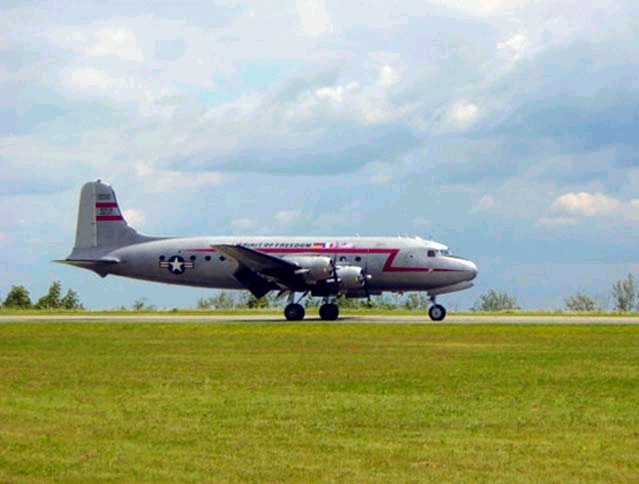
M3 Half-Tracks + C-54s = Yet another no excuse for Task Force Smith
The M3 half-track while not a great armored personnel carrier (open top, wheels in front mire in ground, fuel tank behind driver etc.), was small caliber bullet-proof with 1/4 inch steel hull and far more mobile and protected than the completely unarmored wheeled trucks Task Force Smith took into battle coming by way of a Navy Landing Ship Tank (LST) from Japan.
afvdb.50megs.com/usa/halftrackm5.html

www.globalaircraft.org/planes/c-54_skymaster.pl
C-54 Skymaster Specifications
|
Primary Function: |
Transport |
|
Contractor: |
Douglas |
|
Crew: |
Four; up to 50 troops |
|
Unit Cost: |
N/A |
|
Powerplant |
|
|
Four Pratt & Whitney R-2000-9 reciprocating engines rated at 1,450 hp |
|
|
Dimensions |
|
|
Length: |
93 feet, 10 in |
|
Wingspan: |
117 feet, 6 in |
|
Height: |
27 feet, 6 in |
|
Weights |
|
|
Empty: |
38,930 lb |
|
Maximum Takeoff: |
73,000 lb |
|
Performance |
|
|
Speed: |
275 mph |
|
Ceiling: |
22,300 ft |
|
Range: |
4,000 mi |
|
Armament |
|
|
N/A |
|
http://modelingmadness.com/reviews/korean/us/attardc54.htm
C-54Ds could carry 14.28 tons of cargo
Furthermore, tests and provisions were on USAF C-54s to carry loads UNDER ITS FUSELAGE as the photo of the M3 Stuart light tank underslung proves. The C-54 could easily carry roughly 25, 000 pound payloads and still have plenty of fuel (10, 000 lbs.) to fly from Japan to South Korea.

The U.S. Army knew they would be operating half-tracks for a very long time and should have cemented the C-54/half-track air-mech combination during WW2 so it would have been well-known and ready for the Korean war. Enough half-tracks were available after WW2 down-sizing to equip ALL infantry units.
The M3 half-track empty was 15, 300 pounds thus leaving lots of payload for heavy machine guns or better yet---75mm recoilless rifles and ammo to ward off enemy T34/85 medium tanks by moving to take flank and rear shots where the T34 is most vulnerable instead of being static, dug-in to the ground and having the enemy approach with its thickest frontal armor facing as what actually took place.
Air-Mech-Strike Modeling: 1:72 scale C-54 + M3 Half-Track = TF Smith Rethink
C-54
www.squadron.com/NoStock.asp?item=MC0034
www.internethobbies.com/ma1mcdodcska.html
M3 Half-Track
www.squadron.com/ItemDetails.asp?item=HE31106
www.squadron.com/NoStock.asp?item=MH13408
C-82 "Packet": first to parachute drop vehicles from inside



Here a M22 Locust light tank rolls off a C-82 mock-up for airlanding! And a truck/jeep are straight-in loaded rigged for parachute airdrop.

Best seen in the first 1965 "Flight of the Phoenix" movie starring Jimmeeeee Stewart.
XC-120: Gavin's KIWI pod concept

www.youtube.com/watch?v=RCbOobGmRBc




www.wpafb.af.mil/museum/fta/fta1197.htm
The U.S. Air Force Museum web page states:


The basic mission of the XC-120 is to test the practicability of cargo pack carrying aircraft. It is essentially a modification of the C-119B utilizing as many of the C-119B parts as possible.
The special design of the detachable cargo compartment (designated pack) allows full utilization of the aircraft. The pack is detached at the target base, and the aircraft can return immediately.
Hoisting provisions are incorporated in the carrier (airplane less pack) for maximum cargo loads of 20,000 lb. A glider tow attachment fitting is installed on the end of the pack.
Crew of five include pilot, co-pilot, navigator, radio operator, and crew chief. No combat protection is provided. Fuel cells are bladder type.
Aircraft data sheet www.wpafb.af.mil/museum/fta/c120des.htm
Characteristics Description www.wpafb.af.mil/museum/fta/xc120cs.htm
Photo gallery www.wpafb.af.mil/museum/fta/c120pg.htm
A report on the XC-120 at the time stated:

The role of transport aircraft in the combat mission cannot be undervalued. These aircraft transported personnel, equipment, spare parts and other supplies to keep fighters and bombers flying. In late 1950, eight different transport aircraft were undergoing testing at Wright Air Development Center [WADC] . These included the Fairchild XC-120 Packplane with a detachable cargo compartment. The Fairchild XC-120 Packplane, a converted C-119B, had a removable cargo compartment. Only was one built.
In gaining experience with the C-82 and C-119 Packets, it became obvious that detachable pod aircraft would have radical implications in the field of military logistics, with subsequent civilian applications similar to those of the truck-trailer combinations of the highways. This led to the experimental XC-120 Packplane, under flight test in 1950. Fairchild hoped to use this aircraft to work out the details and final configuration of the ultimate production article.
Fairchild believed that the detachable-fuselage transport airplane can provide answers to many of the most pressing logistical problems. Most of the military planners involved in transport work agree with us, and already thinking on the eventual use of such an airplane is far in advance of the specific plane's present configuration or performance.
The primary military advantage of the detachable fuselage cargo plane lies in the extreme versatility achieved through this basic airplane design. For instance, the military transport as it exists in operational use today-in the C-119, the C-124, the C-97-is completely equipped to carry out every mission required of it. Consequently, when used as a standard cargo carrier, it must carry, as dead weight, hundreds of pounds of equipment which are needed when the same plane is to be used as a paratroop plane.
By designing different types of interchangeable fuselages for different missions this waste is limited, and every pound carried contributes directly to the success of the mission at hand.
Fairchild believed that three types of carrying compartments should be designed for the one basic airplane. A fuselage to be used in carrying paratroops and their supplies. A fuselage to be used primarily as a cargo carrier, leaving out such specialized paratroop equipment as monorails, parapacks, and drop doors. This would give completely unobstructed cargo space, with additional payload capabilities resulting from the elimination of unnecessary paratroop equipment. It would also permit the installation of other specialized equipment to make the "pod" an integral machine-shop, radar station, hospital, or similar built-in permanent unit. An open rack arrangement, to he attached to the carrier portion of the plane at points similar to those where the "pods" are attached. This rack would be much lighter in weight than an entire fuselage, and thus would permit the carrying of bulky, heavy items too large to go into the present fuselage. Capable of being dropped by parachute, the rack makes it possible to transport by air an almost unlimited range of items.





Airborne Warfare by General James Gavin
Click on picture for full size or link underneath for no captions version

no captions
General Gavin as the U.S. Army's Head of Research and Development employed young talent like then Captain Hal Moore to come up with improved parachutes and later tracked armored fighting vehicles. This was the first "heavy drop" of a platform-loaded artillery howitzer using a delayed opening, two-state cargo parachute system, which we take for granted today. Here the extraction chute pulls the load out the back of the C-82.
After the extraction chute has cleared the load from the aircraft it pulls out the main cargo parachute which is set to deploy vertically so the load comes down on its platform. Platform airdrop loads enable the entire gun and even prime mover vehicle and ammunition to be dropped as an intact unit compared to the WW2 artillery pieces that were dropped in pieces by underwing bundles (most WW2 cargo planes did not have a twin or t-tail for a large, unobstructed rear opening for large parachute loads to slide out) widely scattered on the drop zone.
Gavin here has a jet KIWI transport with forward swept wings probably an idea he got studying captured German scientist documents on how to delay sonic boom compressibility to get faster speeds.
Both jet engined and prop-driven KIWI carrying planes are shown here taking off from a CONUS airfield/runway. The artist did a great job bringing General Gavin's ideas and gives you a real 1940s George Pal science fiction movie feel.
General Gavin clearly sees KIWI pods like our "BATTLEBOXes" as living shelters for Forward Operating Bases (FOBs). The KIWI pods like today's ISO containers also carry all the vital supplies they need to survive and can be configured for different tasks, ready upon air delivery to go into action. Here General Gavin has an arctic scene and today as we speak, scientists are living in the South Pole in Jim Brennan's SeaBox living quarters made of modified shipping containers.

Gavin also realized such modular shelters mean the entire base can be moved in an instant to a new location as required, so no time or money is wasted on inferior static buildings you cannot take with you on peaceful expeditions or expeditionary warfare.

no captions
More proof that the current USMC is living off the legacy of the past lusting to re-enact WW2 beach assaults. We do not get a clear signal from the NAVSPECWAR community whether its safe to drop SEALs in a rubber boat 5-10 feet above the water from the rear ramp of a C-130 using LAPES. Richard Gabriel in his book, Military Incompetence says it was tried in the 1983 Grenada invasion but with disastrous results. If the carrier aircraft is a seaplane, it simply lands on the water, comes to a slow taxi or halt, then detaches the floating KIWI pod. The Geiger Board of 1946 said to avoid nuclear targeting of the vulnerable and obvious surface fleet, marines should come ashore by seaplanes. An actual "Flying LST" was fielded, the R3Y Tradewind but the WW2 re-enactment bureaucracy with billion dollar amphibious ships for Navy officers to play Captain Kirk killed the whole seaplane option when they found a flimsy technical excuse to kill programs. In the case of the R3Y it was problems with their engines that gave them their excuse and voila! a U.S. Navy without ANY aircraft capable of landing in the water. That we could have amphibious KIWI pods that would be the only part of the carrier plane to touch the water, then take-off is a level of sophistication several steps ahead of the current marine and naval mind.
Notice as far back as 1947, General Gavin has TRACKED tanks coming out of his KIWI pods to render fire support for his beloved Paratroopers who realize OPEN TERRAIN when they see it = DROP ZONE for them. Another of the tracked tanks is shooting a barrage of rockets to saturate bombard the enemy, yet another capability absent in today's Navy/Mc team. The tragedy is that 60 years later AMERICA'S PARATROOPERS STILL DO NOT HAVE ANY TRACKED LIGHT TANKS AND PERSONNEL CARRIERS while the rest of the world's Airbornes do...to include impending foe, Red China's Paratroopers.

no captions

"Precision Guided Munitions" circa 1947. Clearly, when you read general Gavin's book he knows its not just nuclear weapons that demand we decentralize our maneuver units, but also precision guided high explosives, too. This is why for the Pentomic Army he had our Soldiers in air-transportable, armored M113s on tracks so they could fan out on the non-linear battlefield and keep moving even if there was no roads/trails via cross country and amphibious mobility.
The official history of the U.S. Army for that time period says the following:
www.army.mil/cmh-pg/books/amh/AMH-26.htm
The seven divisions stationed in the United States constituted the strategic reserve. Four of these-two airborne and two infantry-were designated in 1957 the Strategic Army Corps (STRAC) and were maintained in a high state of readiness for quick deployment in event of an emergency. The other three were earmarked as STRAC reinforcements and as a training base for expansion of Army forces should the crisis become prolonged or develop into a full-scale war.With the emphasis on mobility, even the larger and heavier weapons and equipment were designed to be air-transportable.
A program to produce ground and air vehicles with the necessary battlefield mobility led to the development of armored personnel carriers, such as the M113 with aluminum armor, that could move troops rapidly to the scene of operations while providing greater protection for the individual Soldier. Since
585
highways and bridges might be damaged or destroyed, dual-capability amphibious vehicles that could travel on rough terrain and swim across rivers and swamps freed the fighting units from total dependence upon roads.
What today's planners don't realize is that what was required for a nuclear battlefield is required today with PGMs in a Surveillance Strike System (SSC) that can be as equally devastating but in a more localized way: units ON TRACKS not wheels. We need GREATER PHYSICAL mobility, firepower, protection and livability features not less regardless if tied in to a "Mother May, I?" computer network to alleviate the anxieties of senior officials.

THE AMAZING DETAILS OF GENERAL GAVIN'S VISION

1. General Gavin's goal is to get THE ENTIRE Army "Airborne" and capable of 3D maneuver by aircraft delivery. Today's C-5s and C-17s make this a reality, we just have to CONTAINERIZE everything the Army owns so we do not waste precious time break bulk loading & unloading the USAF's current internal cargo volume T-Tail airlifters and the Army's internal volume CH-47 heavy lift helicopters.
2. Nore that the ideal KIWI pod carrier is still a specially designed aircraft that the pod snaps into for maximum efficiency since the aircraft doesn't carry the dead weight of a large internal volume cargo fuselage. The aircraft depicted here is like the XC-120: a CH-54 SkyCrane but with fixed instead of rotary wings.
3. Once a KIWI pod system is fielded all kinds of options become possible from the very aggressive to the very safe. The most aggressive is DROPPING the pod from high altitudes and gliding in or a few feet above the ground or water; if the carrier aircraft is a Burnelli ESTOL design the slightly above stall speed would be just 60 mph so a LAPES without a parachute or perhaps with a tail parachute on the KIWI pod may not be so severe an impact that the pod gets damaged. People inside are another matter. If its a land carrier plane, with tracked or air cushion landing gear ON THE KIWI pod itself, the plane could detach the pod once firm contact with the ground is made and pull up to return to flight back to base. The conservative option would be to land then could come to a taxi or stop and then detach the pod.
The KIWI pod has tracks to propel itself over the ground after detaching from its carrier aircraft.
4. The KIWI pod. First notice the two cargo cranes in back to load/offload supplies on pallets. There's a side door for Paratroopers to enter/leave the KIWI pod.
5. There are two sets of tracks which is incredible that General Gavin proposes this since it enables a vehicle to run over a land mine and still have 3 sets of tracks intact to keep going. On top of the KIWI pods are two machine gun or autocannon turrets to defend itself from enemy attacks or to attack the enemy, whichever happens first.
6. LOOK WHAT'S COMING OUT OF THE KIWI POD!!
Why its a LIGHT TRACKED ARMORED FIGHTING VEHICLE...sort of like a M113! Notice on its front are two mine roller wheels to sacrifice themselves if a land mine is run over to keep the main vehicle's tracks intact to stay mobile. And right behind it is either a Paratrooper on a motorcycle and/or pedal bike!
7. Here is retired LTC Chuck Jarnot's "T-MARS" minimalist 227mm rocket launcher described in our AMS book to offer a barrage of rockets to saturate the Paratrooper's enemies for maximum "bang" with least amount of weight for air delivery purposes. Certainly General Gavin saw our own and the Russian and German WW2 barrage rockets on trucks and trailers and wanted the capability continued. Where are they today? Heavy units have 227mm rockets on very heavy MLRS tracked launchers and a few Airborne units are getting the HIMARS FMTV truck with a single 6-rocket MLRS 227mm rocket pack...otherwise there are no ground rockets in our Army light units and marines today! Gavin's trailer mobile rocket system still has merit.
The Current Future Combat System (FCS) of 2006

8. 60 years later, the Army is still playing with "futuristic" concepts like FCS when we could have had them back in 1947! Compare the current "Future Combat System" of 2006 (see pic above) to Gavin's of 1947...his vision is actually more revolutionary, creative and practical because its PHYSICALLY offering capabilities while the current FCS is all about joining hands mentally with Tofflerian computer networks and embracing PHYSICAL WEAKNESS when we still live in a very large PHYSICAL world full of real, PHYSICAL enemies! Here Gavin shows a future TANK with 4 sets of tracks to like today's Bv206S keep moving in event of a landmine attack. Notice he has the driver in the hull center like today's M1 Abrams heavy tank. The turret has twin autocannon like the German Geopard for a high rate of fire to shoot down aircraft or ground targets.

Another amazing concept from General Gavin: Airborne Combat Engineers arriving inside KIWI pods with ALL the gear they need to scrape out and pave a runway for an assault landing zone. Gavin has a front bulldozer blade and a backhoe with operator facing rearward like on today's John Deere 510 combination front end loader and backhoe. He even has a sprayer vehicle that today could be Rhino Snot [Envirotac II] instant soil pavement for follow on echelon aircraft to land. Also notice he has a small 2.75" or 5" rocket barrage tracked vehicle that may even be UNMANNED. So much for the "new" and "revolutionary" unmanned ground vehicle concepts we hear today.

Lastly, General Gavin was THE driving force behind the Army getting thousands of helicopters. It also cost him an early retirement when he made lots of enemies at the Pentagon to get this to happen. Here he's got some help from the legendary Frank Piasecki, another (still living) legend and maverick with a tandem rotor heavy lift helicopter with what looks strangely like a detachable 40 foot ISO shipping container underneath as armored half tracks drive in and out from front/rear ramps long before the C-5 was created with them in the 1960s.
General Gavin's KIWI pod concept was and still is far ahead of its time.

The piston-engined C-120 simply did not have enough extra power to spare for the extra tare weight of a detachable pod. Today's C-130/C-27J turboprops and C-17 turbofans can enable a modular pod equipped plane to deliver pods from high altitude stand-offs to evade enemy air defenses or at lower altitudes in safer situations to minimize cargo parachute trouble/expense. The pod system would work but anti-physical DoD is not interested and wants to play with mental gadgets to steer firepower when Planet Earth is still a very big place where MANEUVER is the key to changing peoples and governments. We have the world-wide ISO shipping container system to be our "KIWI pods" we just need to design a fixed-wing cargo plane around these "BATTLEBOXes". The S-64 SkyCrane can carry one ISO container now snug up into its skeletal body (see description below) for VTOL flight profiles. Pods would enable every unit in the U.S. Army to be READY-TO-FIGHT at all times with "BATTLEBOXes" ready to operate as soon as they are delivered by air, land or sea.
Single ISO shipping container BATTLEBOX carrying aircraft, circa 1968
AIRCRAFT HAVING A DETACHABLE POD
Robert H. Reno

More details:
www.google.com/patents?vid=USPAT3361396&id=i4ZvAAAAEBAJ&pg=PP1&dq=pod+aircraft#PRA1-PT3,M1
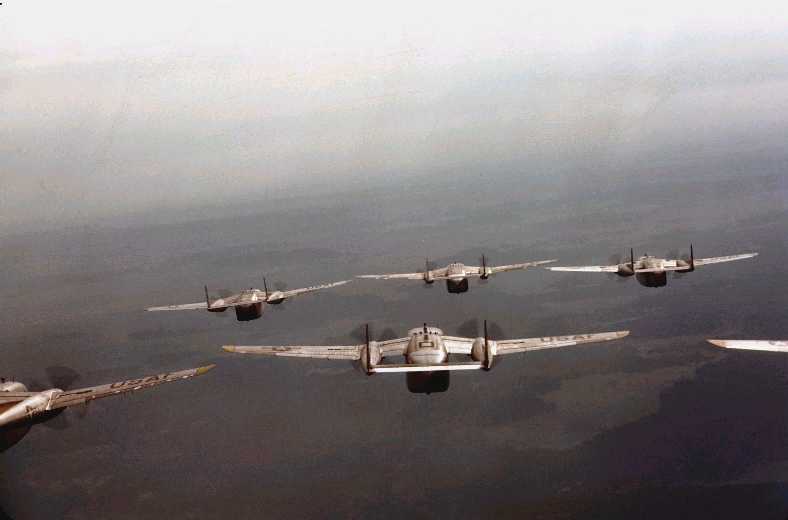
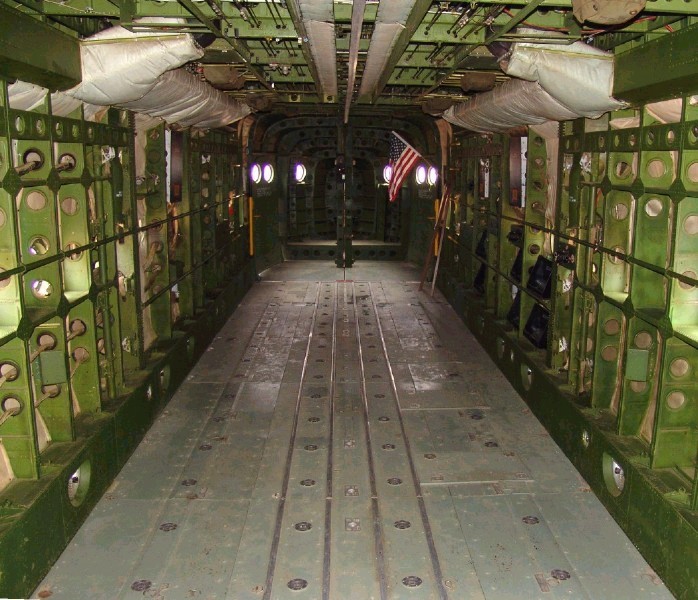
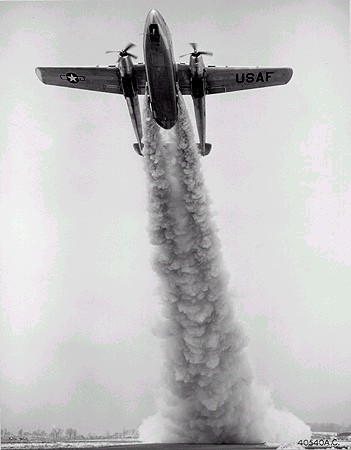
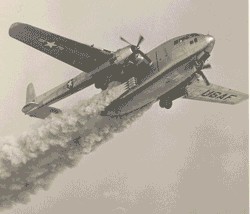
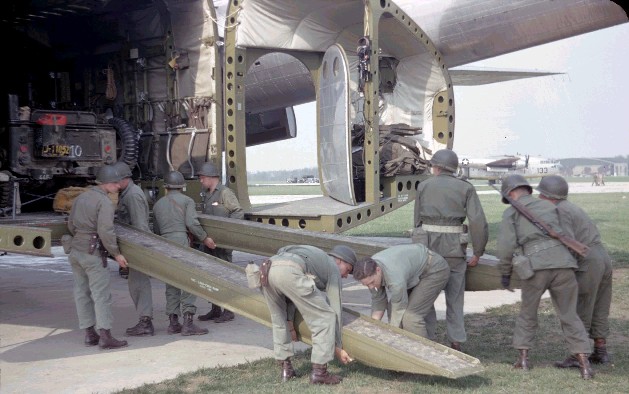


Photo of C-119s airdropping Paratroops into combat in Korea
Animated C-119 "Flying Box Car"
Story of C-119 Korean War Airborne Operations
"Official" history of Korean War Combat Jumps

C-119 dropping Paratroopers animation
C-119 POD SYSTEM


Where was the Air-Mech for Task Force Smith? How about Sea-Mech? There was no excuse.
Task Force Smith was named for Lieutenant Colonel Charles B. Smith, commanding officer, 1st Battalion, 21st Regiment, [[24th Infantry Division (United States)|24th Infantry Division]]. Though this division had M24 Chaffee light tanks (they needed hydraulic fluid for their 75mm guns) and M3 half-tracks but no one in the Army thought beforehand of getting the fluid for the M24s and flying them by USAF C-119 and C-124 Globemaster II aircraft to give the TF needed mobility, armor protection or firepower. Another option was to use LSTs and move the M24 light tanks and half-tracks by sea, again this was not considered. What was done was to move a hodge-podge of wheeled trucks. Appleman states in CHAPTER VI: "American Ground Forces Enter the Battle" of his book, South of the Naktung, North to the Yalu;
www.kmike.com/Appleman/Chapter6.htm
The next day, 4 July, Smith's divided command reunited at P'yongt'aek, and was joined there by a part of the 52d Field Artillery Battalion. This artillery contingent comprised one-half each of Headquarters and Service Batteries and all of A Battery with 6 105-mm. howitzers, 73 vehicles, and 108 men under the command of Lt. Col. Miller O. Perry. It had crossed from Japan on an LST 2 July, disembarking at Pusan late that night. Two trains the next day carried the unit to Taejon. There General Church ordered Perry to join Smith at P'yongt'aek, and about 2100 that night Perry's artillery group entrained and departed northward. Because of the destroyed railroad station at P'yongt'aek, the train stopped at Songhwan-ni, where the artillerymen unloaded and drove on the six miles to P'yongt'aek before daylight.
Therefore, its clear TF Smith had at least enough sealift to properly mechanize itself had the infantry-centric persons in charge had though to do so in light of the open Korean terrain.
The 1943 U.S. Army Infantry Division's Reconnaissance Troop Mechanized (RTM) shows 5 x M3A1 half-tracks that were C-119 air-transportable
http://niehorster.orbat.com/013_usa/43_org/div-inf/div-inf_recon.html
If a light tank company were attached to the 24th ID, then:
http://niehorster.orbat.com/013_usa/43_org/div-arm/div-armd_tank-lt.html
It would have at least 17 x light tanks and another half-track in a Light Tank Company
http://niehorster.orbat.com/013_usa/43_org/div-arm/div-armd_tank-lt.html
However, we know the 24th ID had 24 x M24 Chaffee light tanks in a tank company at the outbreak of the Korean War
www.usm.edu/armyrotc/militaryhistory/Lsn%2020-Korean%20War,%20TF%20Smith,%20and%20Inchon.ppt
The book, M3 half-track in action by Jim Mesko on page 12 states the M3's empty weight was 15, 300 pounds, the vehicle was 7.29 feet wide, 20.75 feet long, and 8.8 feet high (reducible for air transport)
www.61tcs.org/c-119_facts.htm
C-119 "Flying Boxcar"
The first C-119 was the `A' model made by Fairchild in Hagerstown, MD November 1947 with the first flight December 17, 1947, #CQ 769 It had Pratt & Whitney R-4360-4 engines with the three blade prop. 3000HP
Extensive modifications were made and the first C-119B # 48-319 emerged.
Then after only 55 x C-119B models were produced the C-119C was produced' A total of
347 x "C" models were produced with 41 being manufactured by Kaiser at their Willow Run, MI facility. The 306 aircraft were manufactured by Fairchild at their Hagerstown, MD Plant. The `C' model had the Pratt & Whitney R-4360-20W engine with the Hamilton Standard four blade prop. The marines received 55 x R4Q-1 ( The Nave designation ) Aircraft. The `C' model had the vertical fins on the tail booms, carried 2800 gallons of 110/145 fuel, 36 foot, 6 inch tail booms carrying 48,000 pounds on a typical mission and 54,000 overloads.
Dimensions:
Wingspan = 109ft 3in. Fuselage length - 60ft 6 1/8in Overall length = 86ft 5 1/4in Height = 27ft 6in
Cargo Compartment:
Height = 8ft Width = 9ft 2in Length = 36ft 11in Cargo Floor Area = 353 sq. ft. Empty Weight = 39,000 Gross Weight = 64.000 Payload = 32,000 Max Speed ( mph ) 253 @ 17.900ft Cruise Speed (mph) 162 @ 5,000ft Initial Rate of Climb (fpm) 852 Service Ceiling (ft) 21,580 Range (statute miles) 1415
Accommodations:
Troops 42 / 62 42 normally, 62 with center isle Liters 35
The C-119 was the work horse of the Korean War. It could carry 75mm Howitzers, 37mm Guns, 40mm Anti-Aircraft Guns and Carriages, 2 1/2 6X6 Trucks, Half Tracks, Large & Small Aircraft Engines and Cradles, Propellers and a wide variety of Military Equipment. These Aircraft were also equipped with a Monorail System allowing Dropping twenty 500lb Bundles through Paratainer Doors in the floor at the forward end of the cargo Section. The "Clam Shell" doors at the rear opened to allow the loading of the heavy equipment.
Eventually the production of 415 x `C' models was accomplished.
The outbreak of the Korean War necessitated the transfer of 55 x C-119's to Ashiya, Japan on the Island of Kyushu. The majority coming from Sewart AFB Smyrna, TN
The Aircraft were fitted with Auxiliary Tanks in the cargo Bays holding an additional 1,005 gal. for the flight over the Pacific.
Vietnam saw a new C-119G with J-85 jets under wing pods and four (4) 7.6mm Miniguns. These were followed by 52 AC-119G ` Shadow' Gunships. The first 26 were armed with four Miniguns delivering 12,000 rounds per minute with a special Gunsighting System, Flare Launchers, Armor Protection and carried a ten man crew.
The succeeding 26 ships designated AC-119Ks added two Vulcan Gatling Cannon and forward firing infrared radar, side-looking radar and Doppler navigation, these later aircraft were designated `Stinger'.
Six C-119s from Ashiya were loaned to the French in Indochina to assist in their battle for Dien Bien Phu. This eventually became 12 aircraft. These originally were flown by CAT crews while French crews were trained in the Philippines. Eventually Military personnel from Ashiya were employed in the maintenance of the loaned aircraft at Cat B Indochina. Fifteen other C-119's were tasked with flying six round trips to Indochina daily from Clark AFB Philippines. It took six hours to fly the 1,000 mile leg to Haiphong..
C-119's were known to have dropped bombs, napalm, trucks, jeeps, guns, and a bulldozer as well as all the troop paradrops.
The Americans had the airlift to Air-Mech but Screw up Task Force Smith, but the French in Indo-China with less make Air-Mech History

How did the French air-mech 10 x M24 light tanks into Dien Bien Phu?
MYSTERY
Ralph Zumbro help needed here: French must have used C-119s to fly in the M24 light tanks?
We have evidence that French had C-119s and that they landed at Dien Bien Phu.

www.globalsecurity.org/military/systems/aircraft/c-119-specs.htm
www.globalsecurity.org/military/systems/aircraft/c-119-pics.htm
You got to take away fuel to get from Hanoi and back and the weight of the crew etc.
So here's the question----
How far did the French disassemble their M24 light tanks to save weight?
Could you detach the entire turret and add it later?
How much weight could you save removing all the guns?
There is evidence that a special unit did the reassembly of the M24s at Dien Bien Phu:
www.thehistorynet.com/vn/bl_foreign_legion/index3.html+m24+tanks+dien+ bien+phu&hl=en&ie=UTF-8
2nd Foreign Legion Tank Repair Company (2nd CREBLE): Organized on July 1, 1951 to replace an inactivated unit within the Colonial Infantry Regiment of Morocco, the 2nd CREBLE was based at Haiphong, where it performed depot maintenance and repaired tanks and amphibious vehicles. A mobile armored repair platoon was based at Hanoi. The majority of the unit's personnel were German by 1953. An element of the company was airlifted into Dien Bien Phu to assemble the ten M-24 tanks that had been flown in, dismantled in sections. The unit was inactivated in Saigon on December 31, 1955.
what does this mean?
Would you want a heavy tank hull without tracks/roadwheels ie the means to drive itself off the C-119 airplane?
Want to see how a M24 light tank would look in pieces?
www.ferreamole.it/ images/m24/m24_01.htm
FACTS
1. The French amazingly flew in 10 disassembled 17-ton M24 Chaffee light tanks with short-barrel 75mm guns to the ill-chosen Dien Bien Phu location in 1953 with PISTON ENGINED AIRPLANES. We are researching the details.
2. The squadron of 10 x M24 light tanks enabled the French to hold out for 55 days even though they did not command the high ground, leading counterattacks against superior numbers of enemy infantry while pummeled by artillery fire from surrounding hills.
3. The ONLY unit to fight its way OUT of Dien Bien Phu was the M24 light tank squadron. This is extremely significant.
Had the ENTIRE Dien Bien Phu force been air-mechanized with troop carrying M24s then in December after the satellite base camps fell, they could have BROKE OUT via TRACKED ARMORED MOBILITY and avoided decisive engagement that led to their strategic defeat.
Why were M24 light tanks not flown by C-124s to bolster TF Smith in 1950?

www.youtube.com/watch?v=eqbBx_3GjDY
http://en.wikipedia.org/wiki/C-124
"First deliveries of the 448 production aircraft began in May, 1950 and continued until 1955."
Absurdly, TF Smith 3 years earlier had a "mini-Dien Bien Phu" when it failed to bring ANY tracked tanks to the fight even though we know now C-54s could have carried M22 Locust tanks underslung. C-124s were available to fly in the company of 20+ M24 light tanks the 24th Infantry division had but as infantry narcissists neglected to supply with things like hydraulic fluid for their 75mm guns.
TF Smith PPT Slide show (see slides 9 & 10)
www.usm.edu/armyrotc/militaryhistory/Lsn%2020-Korean%20War,%20TF%20Smith,%20and%20Inchon.ppt
Had the M22 been fitted with the 57mm anti-tank gun instead of the impotent 37mm gun it could have knocked out North Korean T34/85 medium tanks. We too, could have flown in disassembled M24 light tanks but didn't. You have to hand it to the French for having technotactical creativity to fly in M24 light tanks and tow F8 Bearcat fighters into Indo-China but their brass lacked skill in the operational art.
We don't believe in half-baked light infantry that just looks different from heavy forces as a fashion/ego statement. The reason why anyone should want "light" is to get a MOBILITY DIFFERENTIAL as Stan Crist puts it. That is the maximum mobility through and OVER (by aircraft) closed terrain to offer "3D maneuver" that compliments a main body 2D maneuver. the AMS Study Group has broken new ground in understanding warfare as shown in the PPT slides below:
www.geocities.com/transformationunderfire
The point is just as Captain (now LTC) Woodgerd ended his article....if the French had more LIGHT tanks for its LIGHT infantry it would not have been defeated at Dien Bien Phu.
Absolutely true.
Despite being stupid and not occupying the high ground, they were indeed in OPEN TERRAIN in the often muddy, low ground. This means they needed 3D maneuver from light tanks not what they had which was only 1D maneuver...after aircraft delivery only a foot slog through closed terrain. If they had had light tanks that can carry infantry (APCs) en masse even as screwed up as their situation was they could have rejected burrowing in and decisive engagement and simply drove their tracks and themselves out of the valley.
IF YOU CANNOT OUT-RUN THE ENEMY (MOBILITY DIFFERENTIAL) DO NOT GET SURROUNDED! (Custer at Little Big Horn, LZ X-Ray, Khe Sanh etc.)
What is a tank?
ANYTHING that is tracked and armored.
Did most WW1 tanks have turrets?
NO.
Did they carry infantry?
YES.
When we fully understand what a "tank" is in generic terms we can then fully understand their potential instead of the current fractured "us" and "them" Heavy vs Light, cligues and the illogical labels like "Main Battle Tank" they use to not understand generic battlefield FUNCTIONS.
Now fast forward to today.
If we fly in foot infantry into a Taiwan under CHICOM bombardment it will have to burrow into the ground and will be in a decisive engagement win or die situation. Wheeled Strykers will be immobilized by shredding their tires or simply unable to leave roads/trails--just like TF Smith. I also see the American light infantry narcissism no different from French infantry narcissism, both are egomaniacs without any humility to admit to laws of physics limitations and the moral courage to DO SOMETHING ABOUT IT: ie; get LIGHT TANKS ie; M113 Gavins.
If American light infantry were to get 10.5 ton M113 Gavin light tanks then it could indeed fly (3D maneuver) to any location in the world and never have to be decisively engaged if we put our best armor and weaponry on these platforms.
FURTHER READING:
members.lycos.co.uk/Indochine/ops/dbpwilde.html
Dien Bien Phu - A Fatal Gamble
By Wild Bill Wilder

Stars in recent 2004 remake of "Flight of the Phoenix" movie starring Dennis Quaid.
Bristol 170: the nose-loading cargo plane!

Brilliant Army air-mech theorist, LTC Michael Woodgerd in 1987 as a Captain wrote an amazing U.S. Army ARMOR magazine article "French armor at Dien Bien Phu" on the French use of M24 Chaffee light tanks at the strongpoint in 1953. Writing recently to the AMS-SG, he reveals the truth behind the mystery of how the French dis-assembled the M24 light tanks and airlanded them in:
"Mike,
Well, well. This is quite a blast from the past. I was just looking over that old article and some material recently. Side note. The nicest part of that Armor Magazine article (the magazine staff did a wonderful job on layout, cover, etc.) was receiving a letter from the French officer who had been Lt. Preaud and by then was General Preaud commanding the 4th Airmobile Div [or something similar to that -- the letter is at home on my wall].
I would have to look at some photos/check some books to see which aircraft they used. I do have the photo of the assembly line where they reattached the turrets to the chassis out in the open. Can't recall how much else was taken off as far as track, roadwheels, etc. I'll check.
C-47s flew in most parts and Bristol 170s the chassis/turrets. They were absolutely flown in by cargo aircraft and reassembled. They were not airdropped.
There were 29 x C-119 Flying BoxCars in Indochina. They were flown almost exclusively by American pilots in a company named Civil Air Transport Company -- sort of an Air America operation. All my data indicates pure airdrop missions. The Bristol 170s also had a clamshell door arrangement and they landed on the main airstrip at Dien Bien Phu.
The tanks came in with the turrets off. Legion mechanics placed them back on and did other rebuilding. They made an assembly line operation and the turrets rested on 55 gallon drums until a crane mounted on a truck lifted the turrets back onto the chassis."
AMS-SG to LTC Woodgerd: "Thank you, Sir!! You've solved a mystery! And expanded our knowledge with another way we can air-mech combat vehicles to achieve 3D maneuver!
Air-Mech-Strike Model Building: 1:72 scale C-119C + Dodge truck or M3 Half-Track
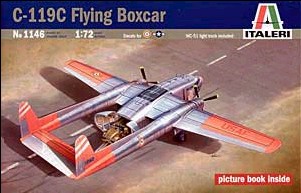
www.squadron.com/NoStock.asp?item=IT1146
M3 Half-Track
www.squadron.com/ItemDetails.asp?item=HE31106
www.squadron.com/NoStock.asp?item=MH13408


www.youtube.com/watch?v=fkRG193B7hk
NEW VIDEOS!
CV-2 Caribou's Raw STOL capability
www.combatreform2.com/airmobileCV2CARIBOUshorttakeoffandlanding.wmv
Note: plane is overall 50, 000-130, 000 pounds lighter than an empty to loaded C-130 and can land on much more unimproved dirt runways/grassy fields.
Air Mobile Concept of Use
www.combatreform2.com/airmobileCV2CARIBOUstoltransportandAIRBORNEoption.wmv
STILL PHOTOS:

CV-2s could carry 4x4 jeeps with troops + machine guns + 106mm recoilless rifles/TOW ATGMs...
U.S. Army Golden Knights free-falling from Caribou over Laurenburg-Maxton airport, NC
Best Caribou web site on the www
Airdrop CDS bundles by Caribou in Vietnam
Complete aircraft histories: many Caribous still flying!
NEW! Turboprop Caribous! www.ausairpower.net/Turbo-Caribou.html
Before service politics got in the way of field/combat practicality, the U.S. Army had its own STOL cargo aircraft that could self-deploy from CONUS to anywhere in the world, then resupply forward U.S. Army/SF camps and artillery FOB "firebases" in Vietnam. The 28,500 pound gross weight aircraft could clear a 50 foot obstacle after a take-off run of just 370 yards! Being able to land where C-130s and C-123s couldn't land, airstrips were built to "CV-2" specifications as the yardstick. If you saw the film, "The Green Berets" starring John Wayne, their final mission has them parachuting from a Caribou to do a VIP snatch mission. A great plane! Wish we had the turboprop Buffalo successor or something like it (JCA) in service now.
The man who deserves the most credit for getting the Army the Caribou was General Gavin.
http://usacac.army.mil/CAC/csi/RandP/airpower.pdf
In "Inter-Service Rivalry and AirPower in the Vietnam War", pages 29-30, British author Dr. Ian Horwood writes:
The budgetary squeeze of the New Look, the ongoing expansion of Army aviation and the development of new weapons continued to create friction within the Joint Chiefs of Staff and the Department of Defense over service roles and missions. This prompted Secretary of Defense, Charles E. Wilson, on 26 November 1956, to issue a memorandum on the "Clarifi cation of Roles and Missions to Improve the Effectiveness of Operation of the Department of Defense.' In this memorandum, Wilson limited Army aviation to four roles: observation, airlift, medical evacuation and liaison. The memorandum specifically forbade Army aircraft from providing close air support and specifi cally limited the Army's airlift role to application "only to small combat units and limited quantities of material to improve local mobility, and not to the provision of an airlift capability suffi cient for the large-scale movement of sizable Army combat units which would infringe on the mission of the Air Force.'[70]The Secretary re-imposed an empty weight restriction on Army helicopters at a maximum of 20,000 pounds and reiterated the 5,000 pounds weight limit for fixed-wing aircraft, a category in which he now included convertiplanes and VSTOL types. As usual, the Secretary saw fit to redefine the parameters of the combat zone as extending one hundred miles forward and one hundred miles to the rear of the front line, and he also resolved an ongoing dispute between the Army and the Air Force over intermediate range ballistic missiles by assigning their operational employment to the latter service and to the Navy for ship-based variants. [71]
The limitations imposed on the Army by the 1956 Wilson memorandum were later to be criticized by the then Army Chief of Staff, General Maxwell Taylor, who blamed the Air Force for recruiting the Secretary in its "resistance' to legitimate Army efforts to escape from its "dependence' on the former service. [72] Testifying before Congress in 1958, General Gavin argued also that strict interpretation of the Wilson memorandum would be both inefficient and distort the manner in which the Army carried out its aviation roles. According to Gavin, even the limited airlift mission permitted the Army could not effectively be fulfilled with fixed-wing aircraft of less than 5,000 pounds empty weight. Therefore, these tasks would have to be performed by helicopters which were more complex and expensive than equivalent fixed-wing aircraft. [73]
This was probably correct, as far as it went; however, the 1956 memorandum, or at least its outcomes, may have proved more accommodating to the Army than Gavin thought. In the first place, the secretary had doubled the area for which the Army might justifiably claim primary authority. Evidence that the Army would actually be permitted to exercise this authority was provided elsewhere in the memorandum where Wilson granted the Army exclusive responsibility for the development of tactical surface-to-surface missiles whose range did not exceed the depth of the combat zone-that is two hundred miles. Furthermore, while a weight limitation was re-imposed on Army helicopters, placing a theoretical cap on their capabilities, the new authorized maximum weight was fi ve times that established by the Bradley-Vandenberg Agreement of May 1949. Given that the Air Force was less enthusiastic about helicopters than fixed-wing aircraft, this part of the agreement might be seen as a classic compromise, permitting Army aviation development where it would least upset the Air Force, while placing severe limitations on Army fi xed-wing aircraft, about which the Air Force was more concerned. This may not have been the perfect arrangement for the Army, but it did leave the way clear for further Army aviation development, and something like this formula would re-emerge in the 1966 McConnel-Johnson Agreement during the Vietnam War. In any case, the weight limitations in the 1956 Wilson memorandum were not always strictly applied.
Even the loss of the IRBM may have been, in one respect a gain for Army airmobility. Experience with airborne forces in the Second World War alerted the Army to the vulnerability of its all-wooden gliders. The Army, therefore, developed the XCG-20 all metal glider. This metamorphosed into the C-122 powered "assault transport' which had the advantage of not requiring a tug aircraft to tow it, and its payload, into battle. [74] Further refinements led to the C-123 Provider. However, as part of the agreement creating the independent Air Force, the Army had to buy its aircraft through the former service. General Gavin has claimed that the Air Force, having no requirement of its own for an assault transport, over-developed the C-123 into a replacement for its C-119 Flying Boxcar, considerably increasing its weight in the process. [75] The resulting aircraft was unsuitable for the small, minimally prepared air strips from which the Army intended it to operate. According to the Air Force, however, the C-123s were transferred to logistic roles in support of Air Force strike aircraft because, in joint exercises, they were found to be too vulnerable in combat. [76] The Army decided, therefore, to purchase the already developed DHC-4 Caribou STOL transport aircraft from De Havilland Aircraft of Canada.
As a sweetener for his controversial IRBM decision, Secretary Wilson acceded to a request by the Army Chief of Staff for Army procurement of the DHC-4 which, at approximately 17,000 pounds empty weight, far exceeded Wilson's own limit for Army fixed-wing aircraft. However, in his 1956 Roles and Missions memorandum, the Secretary specifi cally reserved for himself the right to make such exemptions and mentioned the DHC-4 as an example. 77 Army operation of the DHC-4-which it re-designated CV-2-was to prove as controversial in the 1960s as had the IRBM issue in the 1950s. The dispute between the Army and the Air Force over the former service's operation of the CV-2 in Vietnam was to result in the 1966 decision by which the Army renounced its CV-2s to the Air Force (where they were again re-designated as C-7s) in return for the Army's retention of the Armed helicopter. Following his resignation in 1958 over what he believed to be the Army's lack of preparedness for limited war, General Gavin gave his thoughts a further public airing in his book, War and Peace in the Space Age. Here he explained that the Army had learned precisely the opposite lessons from the Second World War to those absorbed by the Air Force. According to Gavin, the war's strategic bombing campaigns had shown the classical airpower theorists like Giulio Douhet and Billy Mitchell to be in error. Airpower, said Gavin, was not the ultimate weapon. Its real importance lay in the mobility and firepower it offered to the Army.
The Air Force, however, remained obsessed with strategic bombing, particularly the delivery of nuclear weapons. For Gavin, the very creation of an independent air force-one of the classical airpower theorists' central themes-was perhaps an error in itself. If the Second World War showed the importance of army-air cooperation, then had not the services separated "at the very time when they should have been becoming more closely associated?' Gavin also pointed out that the marine corps had held on to its own aircraft. [78]
LTG Tolson writes the "official" Army version of events (with a slight rotorhead bias that wimps out in the face of the USAF misuse of the disastrous 1947 Key West Agreement to deny the Army aircraft with wings that don't move) in VIETNAM STUDIES: AIRMOBILITY 1961-1971, DEPARTMENT OF THE ARMY, WASHINGTON, D. C., 1989 Library of Congress Catalog Card Number 72-600371, First Printed 1973-CMH Pub 90-4:
www.army.mil/cmh/books/Vietnam/Airmobility/airmobility-fm.html
The Caribou came into the Army by the sheer persistence of a few perceptive representatives of deHaviland Aircraft Corporation of Canada and a few equally perceptive Army aviation enthusiasts who recognized the natural affinity of the deHaviland aircraft to the Army environment. Starting with the Beaver-which was designed as a "bush pilot's dream," and progressing to the reliable, but somewhat clumsy Otter-the Caribou seemed a natural to those Army planners who saw a significant gap between the Army's organic capability and the C-130 Air Force transport.The Caribou was the second exception by the Secretary of Defense to his memorandum on the weight limitations for Army fixed-wing aircraft. Its very size threw down a gantlet to the Air Force bureaucrats. It could carry as much as the venerable C-47 and land and take off of remarkably short, unimproved airstrips. It had a rear end loading door which facilitated rapid cargo handling and vehicle roll-on/off loading/unloading, and was relatively easy to maintain and operate. The Air Force saw this 32 passenger aircraft as a second invasion of "its domain" and the projected rise of the Army's inventory at a time that the Air Force aircraft inventory was declining [EDITOR: their own fault for creating the "Death Spiral"] was bound to cause more heat than light.
The Caribou proved to be an extremely useful addition to the United States aircraft inventory and did yeoman service in Vietnam. Later, it would be transferred to the Air Force in 1966 as part of another Army-Air Force agreement, but in the early 1960's the Caribou and the Mohawk were the two major symbols of Army-Air Force disagreement and more time was devoted to these systems than to the entire airmobility concept itself.
Unquestionably, the Caribou filled a serious gap in the United States inventory. Its short field characteristics, pay load, and light "footprint" made it an ideal aircraft in the counter-insurgency environment.
A not-well-known fact is that the Caribou airplane predated our major helicopter commitment to Vietnam by five months. On 21 August 1961, an experimental "Y model" Caribou landed at Saigon under the auspices of the Advanced Research Project Agency. The Advanced Research Project Agency had its own charter to test almost any device, technique, or prototype that it felt might have application in our counter-insurgency efforts. Consequently, the Agency was able to cut through the red tape of Service disagreements and expedite those tests it deemed appropriate.
The Advanced Research Project Agency Caribou flew up and down the length of Vietnam going into airstrips normally limited to much smaller aircraft such as the O-1 or U-6 Beaver. Initially, it specialized in resupply of Special Forces outposts that were inaccessible by road and that normally were supplied by either airdrop or an occasional helicopter. In December 1961, while this aircraft was stationed at Da Nang, the Caribou was requested to support the Army of the Republic of Vietnam 2nd Engineer Battalion which was attempting to improve the primitive airfield at A Shau. In view of the rainy season, the Vietnamese Air Force did not consider it suitable for either O-1 or U-6 aircraft; and, because of the constant cloud cover, air drops from C-47's were impossible. The Caribou navigated through the valleys to A Shau and landed on the wet primitive strip for the first time. Resupply parachutes from previous air drops and troops due for rotation were the first load out. The troops crowded to board the aircraft since none of them believed that the Caribou would dare to come back. However, the Caribou did return many times bringing rice, fresh food, and pierced steel planking to improve the runway. The loads of succeeding trips were dictated by priority, the weather always posing a threat. Finally, a complete road grader was moved in, 5,500 pounds-at-a-time.
On December 17th, this Caribou took the President of the Republic of Vietnam and his official retinue into A Shau. Shortly thereafter, on Christmas Day, it landed President Ngo Dinh Diem and 37 additional passengers at a remote Montagnard outpost at Mang Buk in the II Corps Tactical Zone. This strip, not quite 1,000 feet long, was at an altitude of 4,000 feet and hemmed in by mountains. The Caribou had made an enviable reputation in Vietnam long before the first complete company of aircraft arrived in Southeast Asia.
On 23 July 1962, the 1st Aviation Company (Fixed-wing Light Transport) was self-deployed from the Continental United States to Thailand. In December the company was moved to Vung Tau, Republic of Vietnam. A second Caribou company, the 61st Aviation Company, was also self-deployed from the Continental United States in July 1963 and based at Vung Tau first. It was not until early 1963 that Commander in Chief Pacific approved the proposed test plan for the Caribou company, but by that time the Caribous had been integrated into most of the daily planning at the corps level.
The Army Caribou pilots took justifiable pride in their proficiency at bringing this big twin-engine airplane into the shortest possible strip. Even the old Southeast Asia hands of "Air America" were impressed when this lumbering bird made its unbelievably slow, steep approach into some of the primative airstrips. The two following examples were typical.
Sixty-five miles southwest of Saigon and just one-half mile north of the Mekong River, the Cao Lanh airstrip resembled an aircraft carrier's deck about three feet out of water. It was typical of the Delta strips with one noteworthy exception-its runway was only 55 feet wide. Since the Caribou had a main gear track of approximately 26 feet, and since a five to ten knot cross wind usually prevailed at Cao Lanh, the pilots had to exercise extreme precise directional control prior to and immediately after touchdown. While maintaining sufficient airspeed to facilitate directional control, they had to constantly guard against coming in too fast on the short 1,300 foot runway. From May to September the shoulders of this airstrip were too wet and soft for the aircraft to leave the runway. Consequently, the Caribou pilot had to make a half turn at the end of the runway, then shut down the inside engine while the local Army of the Republic of Vietnam security force pushed the aircraft back for another start, and then complete his turn. Nevertheless, the Caribou flights served this strip three times a week.
Probably the shortest strip used consistently by the Caribou was Tra My in I Corps. Tra My was 830 feet long and lay in a valley floor requiring very steep descents and maximum performance climb-outs even for aerial delivery. At each end of the strip was an abrupt embankment. There was no room for a short landing or an overrun. The first landing was made by Captain Ephriam M. Goss and CWO P. Crossan. After three attempts, Captain Goss touched down twelve feet from the west embankment and came to a skidding halt eight feet from the east embankment. Needless to say, a hasty effort was made to lengthen the strip.
During the first six months of formal testing in early 1963, the Caribous flew 47,563 passengers and carried over 3,800 tons of cargo in over 9,000 sorties. Its availability rate was consistently high. It proved a boon to Army logistical support in Vietnam. General Rowny, who was in charge of the tests being run by the Army Concept Team in Vietnam, stated:
"The first Caribou tests there used the plane to support Green Berets located in inaccessible places. Later, all sorts of cargoes were lifted into all kinds of fields. Montagnards were resettled (complete with chickens and cattle); fuel was delivered to stranded helicopters; casualties, when they occurred in large numbers, were quickly lifted to hospitals; spare engines and parts, fresh water, food and other vital cargo were lifted. Soon there were more demands for the Caribou than we could meet. Added to its advantages of reliability and versatility was its availability. There were no long lead-times needed for processing requests; no tortuous channels to go through. If a commander felt he needed logistical help he merely called his supporting Caribou detachment commander. Seldom was a request denied; almost never was he disappointed with the performance. The Caribou tests were highly successful-the light cargo plane seemed assured a place in the Army inventory."
Like the Mohawk, the history of the Caribou is somewhat tangential to the history of airmobility in the Army. It did perform a logistics role in a gross weight and performance category that was unique. The next plane in size was the C-123B which had a gross weight of 55,700 pounds compared to the Caribou's 28,500 pounds, and the single wheel load of the C-123 was almost double that of the Caribou. Consequently, the Caribou could operate repeatedly and routinely into airfields that were denied to the C-123 and later the C-130. For example, in 1963, the Caribou could operate into 77 percent of all airstrips in Vietnam while the C-123 was limited to just 11 percent of these airfields. The big question at this time was whether the Caribou should be employed under the corps senior advisors or whether it should be integrated into the Southeast Asia airlift system. Strong differences of opinion existed.
In 1964, the 61st Aviation Company introduced the low-level extraction system [LAPES] to Vietnam. In this technique the Caribou flew over a restricted drop area, at an altitude of about ten feet, and a drag chute attached to the load which was to be deployed pulled the load out of the ship through the rear door. Faster than the time it takes to tell, the load skidded across the ground until it came to a safe rest. Using this system, a narrow stretch of road was an acceptable drop zone. During my visit to Vietnam in August 1964, the only complaint I heard about the Caribou was that there weren't enough of them.
John Pike in his superb Global Security web site writes:
www.globalsecurity.org/military/systems/aircraft/index.html
The Caribou was first flown in 1958 as the DHC-4A, and the U.S. Army acquired the CV-2 Caribou the following year. Starting with the U-6A Beaver -- which was designed as a "bush pilot's dream," and progressing to the reliable, but somewhat clumsy Otter -- the Caribou seemed a natural to those Army planners who saw a significant gap between the Army's organic capability and the C-130 Air Force transport. Initially procuring 173 in 1959, the De Havilland Caribou was the largest Army fixed-wing aircraft. Initially designated AC-1, the aircraft was redesignated CV-2 in 1962 and retained that designation for the remainder of its Army career. When responsibility for all fixed-wing tactical transports was transferred to the U.S. Air Force, the Caribou received the designation C-7.Two piston engines are mounted in the wings leading edges, and the engine nacelles extend beyond leading edges. Powered by two Pratt & Whitney engines of 1,450 hp each, it cruised at 149 knots with a service ceiling of 27,500 ft. It is designed to take off and clear a 50-foot obstacle in a distance of 1040 feet with zero wind. With a 20-mile per hour headwind, the takeoff distance over a 50-foot obstacle is just 460 feet. Its landing distance is just over 590 feet while clearing a 50-foot obstacle. These characteristics enabled the Caribou to operate out of tiny jungle landing strips, from beachheads, or from improvised military landing strips as short as 850 feet. The wings are high-mounted with straight leading edge and forward-tapered trailing edge from engines to the blunt tips. The fuselage is slab-sided with a solid, rounded nose and stepped cockpit. The tail flats are mid- to low-mounted on the tail fin and tapered with blunt tips. The large fin is tapered with blunt tip.
The Caribou was the second exception by the Secretary of Defense to his memorandum on the weight limitations for Army fixed-wing aircraft. In 1951 an Army-Air Force memorandum of understanding (MOU) allowed 2 exceptions on weight limitations: OV-1 [AO-1] Mohawk Medium Observation Aircraft and AC-1 [CV-2] CV-2 Caribou Medium Tactical Transport (MTT). In the early 1960's the Caribou and the Mohawk were the two major symbols of Army-Air Force disagreement. The CV-2 was to bridge the gap between the U.S. Air Force (USAF) C-130 and Army capabilities. Its very size threw down a gantlet to the Air Force strategists. It could carry as much as the venerable C-47 and land and take off of remarkably short unimproved airstrips. It had a rear end loading door which facilitated rapid cargo handling and was relatively easy to maintain and operate. The Air Force saw this 32 passenger aircraft as a second invasion of its domain and the projected rise of the Army's inventory at a time that the Air Force aircraft inventory was declining was bound to cause more heat than light.
The Caribou proved to be an extremely useful addition to the United States aircraft inventory and did yeoman service in Vietnam. A not-well-known fact is that the Caribou airplane predated the major helicopter commitment to Vietnam by five months. On 21 August 1961, an experimental "Y model" Caribou landed at Saigon under the auspices of the Advanced Research Project Agency. The Advanced Research Project Agency had its own charter to test almost any device, technique, or prototype that it felt might have application in our counter-insurgency efforts. Consequently, the Agency was able to cut through the red tape of Service disagreements and expedite those tests it deemed appropriate.
The Army ferried the CV-2s to Vietnam in 1962 where their excellent short-field performance and 3-ton payload served as a tactical transport airplane. The Caribou flew up and down the length of Vietnam going into airstrips normally limited to much smaller aircraft such as the O-1 or U-6 Beaver. Initially it specialized in resupply of Special Forces outposts that were in accessible by road and that normally were supplied by either air drop or an occasional helicopter. The Army Caribou pilots took justifiable pride in their proficiency at bringing this big twin-engine airplane into the shortest possible strip. Even the old Southeast Asia hands of "Air America" were impressed when this lumbering bird made its unbelievably slow, steep approach into some of the primitive airstrips.
The Caribou filled a serious gap in the United States inventory. Its short field characteristics, pay load, and light "footprint" made it an ideal aircraft in the counter-insurgency environment. The next plane in size was the C-123B which had a gross weight of 55,700 pounds compared to the Caribou's 28,500 pounds, and the single wheel load of the C-123 was almost double that of the Caribou. Consequently, the Caribou could operate repeatedly and routinely into airfields that were denied to the C-123 and later the C-130.
The very existence of the Caribou in the Army inventory changed one Air Force program-the Fairchild C-123 "Provider." This latter aircraft was scheduled to be phased out of the active Air Force inventory in 1961, with a few programmed to the reserves and the remainder to be declared surplus. When Secretary of Defense Robert S. McNamara suggested that the Air Force turn over the C-123's to the Army (to train on this type aircraft prior to the receipt of the Caribou) , the Air Force suddenly discovered new and pressing Air Force requirements for the C-123. Thus the Army Caribou protagonists not only pushed the Caribou into being, but-incidentally-saved the C-123 for much-needed duty in Vietnam.
Dong Xoai from the air

Photos courtesy of USAF C-7 Caribou Association, www.c7acaribou.com great pics!
The Caribou aircraft performed so well in Vietnam that the Air Force demanded that the Army turn them over to the Air Force, because they were performing missions that the Air Force considered its own better than the aircraft the Air Force had at the time. The Army released the CV-2s to the Air Force in 1966 under an Army-Air Force agreement. Prior to the Air Force assumption of the Caribou, most were already under centralized management under Military Assistance Command, Vietnam, and were participating in the Southeast Asia airlift effort. However, one-fourth to one-half of their resources were dedicated to specific Army support. The 7th Air Force in Vietnam, which had been upgraded from the 2d Air Division on 2 April 1966, was severely critical of the Army's method of operation of its Caribou assets. They believed that the Caribou should be incorporated into the Air Force managed Southeast Asia airlift and consequently be more productive from a ton-mile basis. [EDITOR: BS. Shortly after getting the Caribous from the Army, the USAF retired them. So much for "pressing requirements" when really it was selfish bureaucratic greed]
The Army traded the Caribou for an end to all restrictions on helicopters. It is for this reason, many consider the Caribou to be the most significant aircraft in Army Aviation history.
The Army kept several prototypes, Tail #59-3079 being the fifth prototype. The yellow and white paint scheme represents the Golden Knights colors, the Army's Parachute Team, who used this plane from 1973 to 1985.

The turboprop Caribou was called the C-8 Buffalo and is still in use around the world. See its amazing STOL capabilities in the video below!
www.youtube.com/watch?v=y7lRlpPbERo
Caribou right rear area
Caribou side-view
Caribou rear ramp/upper door area
Army Golden Knights jumping from a Caribou still owned by the Army
THE FIGHT TO REGAIN LOST CARIBOU CAPABILITIES: JOINT CARGO AIRCRAFT (JCA)

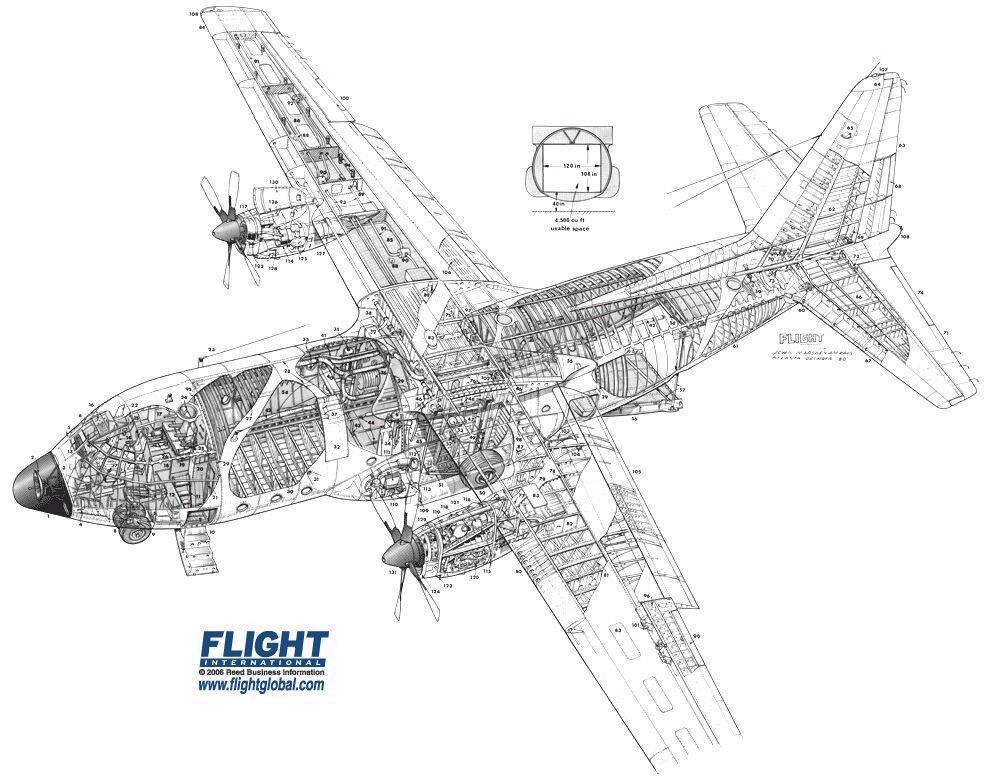
While Lockheed TALKED about building a "Baby Herk" (see drawing above), Alenia in Italy actually built one for small runways at small FOBs! (C-27)
USAF, Aussies, RAND want COIN STOL transports: need Mini-Gavins
Joe Katzman of DID discovered this revival of interest in STOL for COIN (sub-national conflict) operations.
www.defenseindustrydaily.com/rand-on-counter-insurgency-airlift-03561
The RAND COIN airlift report at this link:
www.rand.org/pubs/monographs/2007/RAND_MG565.pdf
Here's what the Aussies want:
www.ausairpower.net/ADA-5190-Analysis.html
Notice complaint that the as-is 10.5 ton M113 Gavin is a bit heavy for the C-27J Spartan that recently won the U.S. Army/USAF JCA competition. Our Mini-Gavin @ 6.5 tons empty solves this and gives them light mechanized, all-terrain (to include closed terrain) armored, decisive maneuver.
BREAKING NEWS! DoD DOES SOMETHING RIGHT!
www.defenseindustrydaily.com/joint-cargo-aircraft-we-have-a-winner-03372/
Joint Cargo Aircraft: We Have a Winner
29-Jun-2007 06:48 | Permanent Link
Related stories: Contracts - Awards, New Systems Tech, Americas - USA, Logistics, Transport & Utility, Boeing, EADS, Finmeccanica, Raytheon, L3 Communications

C-23B Sherpa
DID's coverage of the WALRUS super-heavy cargo airship's cancellation noted complaints from combat commanders that C-130s were not able to get equipment close enough to the front lines due to short airfield restrictions. Delays in buying a small cargo aircraft to fill that role, replace aging C-23 Sherpas et. al., and ferry troops, supplies, and/or small vehicles within a theater of operations were making that problem worse. "The JCA Program: Key West Sabotage?" looked at the different levels of urgency and priority in the U.S. Army and U.S. Air Force and the resulting Congressional SNAFUs, and covered early-stage developments.
JCA could be worth up to $6 billion before all is said and done, and the finalists were a familiar duo. After EADS-CASA's CN-235 and a shortened version of Lockheed Martin's C-130J were disqualified for failing to meet requirements, JCA became yet another international competition between EADS-CASA's C-295M vs. Alenia's C-27J. The decision was expected in March 2007, but it seems we now have a winner. Oddly, we can't quite tell yet how much they've won - and of course, there's a GAO protest in the works...
Canned Feud: The Transport of Seville vs. the Spartan Salesmen

C-295 hits American chill
EADS-CASA partnered with Raytheon for the JCA competition. Their finalist the C-295M has a longer fuselage that can carry more cargo pallets than the C-27J, comes with a nifty pallet loading system, and is cheaper to maintain and fly. On the other hand, it lacks the internal dimensions and/or floor strength required for tactical loads like Humvees, small helicopters, et. al. Wins have included Spain, Algeria, Brazil, Finland, Jordan, Poland, and Portugal.
Alenia partnered with L-3 Communications and Boeing to offer the C-27J Spartan, aka. "Baby Herc" due to its profile, engine, and avionics commonality with the C-130J Hercules. EADS-CASA claims the C-27J's fuel and maintenance needs give it operational costs that are over 50% more expensive than the C-295's; but C-130J commonality may bring those numbers down slightly, and the C-27J's internal dimensions and floor strength give it the flexibility to carry light tactical loads. Wins include Italy, Greece (who had some issues but appears to have resolved them), Bulgaria, Lithuania, and Romania.
Surprisingly, word was that the U.S. Army wanted the C-295 despite its tactical limitations, and the USAF wanted the C-27J despite is operating and maintenance costs. If the rumors about service preferences were true, the USAF got its way - and the Army got more tactical flexibility.
Hello, My Baby, Hello, My Honey...

C-27J Spartan
The GMAS team's C-27J "Baby Herc" will replace the U.S. Army's 43 C-23 Sherpas, and fill some roles currently flown by the C-12 (based on the Beechcraft King Air twin turboprop) and C-26 Metroliner (based on the Fairchild Metro 23 twin turboprop) aircraft. In practice, it will also augment the U.S. Air Forces' aging and partly-grounded fleet of C-130E/H intratheater airlifters, and replace a number of missions that are using very expensive-to-operate CH-47 helicopters as in-theater supply aircraft.
The new Joint Cargo Aircraft will be in high demand from the first day they're delivered. The USAF has been making extensive use of intra-theater transports, and even C-17s with their short-field landing capabilities, in order to reduce the number of road supply convoys in Iraq. The C-27J's ability to use even shorter runways will expand the number of sites available for use in Iraq, Afghanistan, and other fronts of the war. Maj. Gen. Marshall K. Sabol, Air Force deputy chief of staff for Air, Space and Information Operations, Plans and Requirements, adds that the under-utilization of the C-130 is another reason the JCA program makes sense:
"The Air Force flew C-130 Hercules aircraft many times in Iraq, carrying just a few passengers or a single pallet of medical goods, because that is what the warfighters needed at that moment, he said. This is not a very efficient use of an aircraft, but the warfighters' needs come first."
Meanwhile, state National Guard forces have seen their air transport assets dwindle as C-130s are based elsewhere in realignments, or just not flyable. They will be clamoring to host C-27Js, whose short-field landing capabilities will be very welcome in the at-home disaster relief role.
Under the joint Memorandum of Understanding signed in June 2006, JCA could grow into a $6 billion program. Initial plans contemplated 145 aircraft - 75 USAF and 70 Army - but the first orders goes beyond the Army's projected number, and Finmeccanica projects a possible total of 207 JCA aircraft over the next 10 years.
The C-27J team is led by GMAS, a company owned 51% by Alenia Aeronautica and 49% by L-3 Communications. L-3 is formally the prime contractor within the USA, and Boeing Integrated Defense Systems is also a partner. Rolls Royce will supply the AE2100 engines.
A Great Big Bunch Of You: Contracts and Key Events
June 26/07: Tell 'em what they've won... uhmmm.... Stephen Trimble of Flight International Magazine says JCA should stand for "Just Confusing Aircraft":
"The plot continues to thicken on the mystery of the Joint Cargo Aircraft contract. As I reported in Flight International magazine this week, I have received three different official estimates for cost and aircraft quantity, The joint programme office says the contract will cost $2 billion to buy 78 aircraft [DID: $26.15M each]. L-3 Communications, the selected prime contractor, claims the $2 billion will buy 55 aircraft [DID: $37.1M each]. The U.S. Air Force, meanwhile, tells me that they're both wrong and that the whole $2 billion figure is a "misprint". According to the USAF, the actual cost is $1.5 billion and it's going to buy 40 aircraft [DID: $37.5M each]. I have not seen a more confusing post-contract award scenario yet."
June 22/07: The Team JCA partnership led by Raytheon Company and EADS CASA North America files an award protest with the US Congress' Government Accountability Office.
The protest centers on 3 key claims: (1) That the JCA source selection board rated Team JCA equal to its competitor on all non-price factors in its criteria, including technical, logistics, management/production and past performance. (2) That they beat its competition's price by more than 15% (3) That there were errors in the specific evaluation of data and the application of the evaluation criteria. Raytheon release.
June 12/07: L-3 Communications Integrated Systems, LP of Greenville, TX received a firm-fixed price contract estimated at $2.04 billion for up to 78 Joint Cargo Aircraft (C-27J Spartan). This includes pilot and loadmaster training, and contractor logistics support for the United States Army and Air Force. A total of 4 bids were received under the full and open competition in response to the March 17, 2006, request for proposals (Team L-3/Alenia's C-27J, Team Raytheon/EADS-CASA C-295M or C-235, Lockheed Martin's C-130J).
The contract consists of three 12-month ordering periods for Low-Rate Initial Production, plus two 12-month options for Full-Rate Production. Work in the United States will be performed at Waco, TX; Aircraft manufacture will occur in Pomigliano (near
Naples) and Turin-Caselle, Italy (and The Czech Republic). Work is to be complete by June 30, 2012. The U.S. Army Aviation and Missile Command at Redstone Arsenal, AL issued the contract (W58RGZ-07-0099). GMAS release [PDF format] | Finmeccanica release [PDF format] | L-3 release [PDF format]
Additional Readings
Alenia/ L-3/ Boeing JCA Team (C-27J) official site
EADS-CASA/ Raytheon Team JCA (C-295M) official site
The Aviation Zone - Beech C-12 Huron
Global Security - C-26 Metroliner
DID - DynCorp Receives $30.9M to Upgrade USAF VIP Transports. But the upgrades don't include defensive systems, whose absence is a problem in theater. The JCA will be equipped with defensive systems.
DID (Aug 2/07) - RAND on Counter-Insurgency Airlift. Lots of implications for the JCA; it mostly serves to make a strong case for the buy.
U.S. Air Force Link (June 13/07) - C-27J Spartan named as Joint Cargo Aircraft
U.S. Air Force Link (Jan 15/06) - Hub-and-spoke missions provide tactical airlift in Iraq. The JCA aircraft would be expected to play strong roles in these kinds of missions.
Inside the Air Force, via USAF Aim Points (March 27/06) - Could nimble JCA become 21st century 'surrogate' for C-130 fleet?
Ongoing Sub-National Conflicts (SNCs) in Iraq/Afghanistan provided the pressure to make DoD adapt...
RAND realizes small STOL fixed-wing airlifters are needed for SNCs:
Inside The Air Force
March 30, 2007
Pg. 1Air Force Moves To Build JCA Support With States, Foreign Partners
The Air Force has launched a pair of campaigns -- one aimed at its foreign counterparts and another at state and territorial governors -- designed to refine its final requirements for a Joint Cargo Aircraft in a bid to expand the base of support for the fledgling program, which it is developing with the Army, domestically and around the world.
Gen. T. Michael Moseley, Air Force chief of staff, in a previously unreported undertaking last fall directed the service to gauge international interest in creating a multinational program to promote foreign sales of the Joint Cargo Aircraft as a way to form new military-to-military relationships across the globe.
"There is a strategic partnering opportunity here that is very, very useful. And Joint Cargo Aircraft will be-- we hope -- much less expensive than the C-130," Moseley said in a March 29 telephone interview with InsideDefense.com. "So there is a whole different level of strategic partnering and coalition opportunity, I believe, with this airplane." And earlier this month, Moseley sent a letter to all of the state and U.S. territorial governors soliciting their feedback on any unique air mobility needs the service should consider in defining its requirements for the Joint Cargo Aircraft.
"I believe this Joint Cargo Aircraft is something that can be pretty exciting on any number of levels," Moseley said. Army and Air Force officials at the JCA Joint Program Office in Alabama are in the final stages of selecting an off-the-shelf twin-engine cargo plane capable of landing on short, austere runways.
Army and Air Force officials in the program office are working to hammer out the final requirements as they prepare to select one of two candidate aircraft in early May.
Competing for a piece of the nearly $5 billion prize to build 104 aircraft for the Army and Air Force over the next six years are the C-27J Spartan, developed by Alenia Aeronautica and L-3 Communications and the C-295, being pitched by the Raytheon-EADS CASA North America group. Moseley said two governors have already called to express their appreciation for his March 13 letter and he expects substantive responses on specific requirements for each of the states will be forthcoming.
And there is also "significant interest" on the international front, said Bruce Lemkin, Air Force under secretary for international affairs, who is spearheading the project to form a multinational JCA program.
On Nov. 28, the Army and Air Force hosted a Joint Cargo Aircraft International Conference attended by 25 nations. A follow-on conference is planned for August, after an aircraft design -- and an Air Force configuration -- is selected. This fall, Lemkin hopes to gather letters of intent to join the JCA international program and by the middle of 2008 have formal agreement in place for participation. At an air show in Australia last week, he huddled with numerous foreign air chiefs to update them on a new effort to establish a multinational JCA program, Lemkin said in a telephone interview. "Quite a few countries are very interested," he added.
Moseley believes JCA could be a key vehicle in building new relationships. "We're looking at a new way to form strategic partnerships," the Air Force general said. "For smaller countries who can't afford the Joint Strike Fighter or larger cargo aircraft, this might be something they could actually get into."
The Air Force chief believes that the Joint Cargo Aircraft could be used in a manner similar the F-16, which the Defense Department has successfully marketed around the world. The proliferation of the F-16 has helped foster extensive opportunities for the Air Force to forge military-to-military ties around the world by training together, sharing tactics and concepts of operations as well as intangible benefits of individual relationships.
"It provides another basis for countries that have the will to join us in coalition operations," Lemkin said. "It has the potential to be very big and mutually beneficial."
Moseley pointed to the new plan to establish a U.S. Africa Command and expectations of policymakers that the Defense Department will increase its attention on that continent in the future. "Imagine the countries in Africa that cannot afford Joint Strike Fighters, or C-17s or even C-130s. Imagine an opportunity on a continent that big where the countries are fairly huge to be able to partner with them the capability like this," said Moseley. "Or even emerging countries that are rebuilding air forces in the Middle East or anywhere else."
Back at home, Moseley hopes to use feedback from governors to refine the JCA requirement and help influence the selection of the aircraft, he said. "The right JCA will both meet your requirements and fill a vital new capability within the Total Air Force's airlift core competency," Moseley wrote the governors. "To help ensure that happens, I would appreciate your comments on a periodic basis and I will provide you feedback as we proceed." In the interview, he noted Air Force officials have already taken stock of the active and reserve component and Air Force Special Operations Command needs. "Now how wonderful would it be to marry those with the international potential partners and governors as they see their state mission?" he said. "You expect me as the service chief to look for the piece of hardware that meets that cross section of requirements," he added.
The Army's portion of the current program is a $1.8 billion effort to procure 46 aircraft through 2013, with the first two aircraft purchased this fiscal year. The Army's total requirement is for 75 aircraft. The Air Force is setting aside $3.1 billion in its six-year spending plan to buy 56 aircraft; its first purchases would not be until 2010 when the service plans to buy eight aircraft. Its total requirement is 70 aircraft.
--Jason Sherman
The C-27J is an AMAZING, fully AEROBATIC cargo plane that can take evasive action to evade ground fire and enemy aircraft!

With multiple-bladed props, the C-27J is also very QUIET to avoid detection by the enemy in the first place. Here's some video:
We rounded off the numbers so you can GET A GRASP OF WHAT'S HAPPENING....TO SEE SIZE/PERFORMANCE RELATIONSHIPS.
CV-2/C-7 Caribou
$10M ($800K in 1960 dollars)
2 piston engines
100 foot wings
17, 000 lbs empty
26, 000 lbs. Max
4.5 ton payload: CANNOT carry M113 Gavin tracked armored fighting vehicle
2, 000 foot runway
1, 000 mile range
200 mph
can land on snow
OBSERVATION: with heavy block piston engines, it can only carry what a turbine engined Blackhawk helicopter can carry though internally so its 2x as fast and can go 6x the range. With piston engines, cannot carry its own weight, only 50%. However ENTIRE loaded weight of aircraft is just 18 tons so you get the light ground pressure to land nearly anywhere
C-8 Buffalo
$15M ($1.2M in 1960 dollars)
2 turboprop engines
100 foot wings
20, 000 lbs empty
40, 000 lbs max
10 ton payload: CAN carry M113 Mini-Gavin tracked armored fighting vehicle
2, 000 foot runway
500 mile range
270 mph
can land on snow
OBSERVATION: so you add turboprop engines to same aircraft now you can carry 100% of your own weight and go 70 mph faster but fuel load was not increased so since you are burning more your range goes in half x.5. Weight has gone up by a ton for some reason not associated with lighter turbine engines but ENTIRE loaded weight of aircraft is just 20 tons so you get the light ground pressure to land nearly anywhere
C-27J Spartan
$71M
2 turboprop engines
100 foot wings
20, 000 lbs empty
40, 000 lbs max
10 ton payload: CAN carry M113 Gavin or Mini-Gavin tracked armored fighting vehicle
2, 000 foot runway
1,000 mile range
250 mph
can land on snow
OBSERVATION: someone has fixed the narrow cargo hold of the Caribous/Buffalos, added efficient propfans and more fuel; result is 1, 000 mile range but a bit less speed because the fuselage is fatter and offers more drag. Great candidate to apply ESTOL technologies to see how short a runway can be for daily operations; far more efficient than the V-22; if the price for using ESTOL C-27J is say a less than 1000 foot runway (less than three football fields) you are only 3.5 more 1/2 football field in space larger than what a CH-47 or V-22 needs to land VTOL
C-295
$xxxM
2 turboprop engines
100 foot wings
20, 000 lbs empty
40, 000 lbs max
10 ton payload: CAN carry Mini-Gavin tracked armored fighting vehicle
2, 000 foot runway
1,000 mile range
250 mph
can land on snow
OBSERVATION: only slightly larger than the narrow cargo hold of the Caribous/Buffalos, added efficient propfans and more fuel; result is 1, 000 mile range. Great candidate to apply ESTOL technologies to see how short a runway can be for daily operations; far more efficient than the V-22; if the price for using ESTOL C-295 is say a less than 1000 foot runway (less than three football fields) you are only 3.5 more 1/2 football field in space larger than what a CH-47 or V-22 needs to land VTOL
C-130J Hercules
$69M
4 turboprop engines
130 foot wings
70, 000 lbs empty
155, 000 lbs max
20 ton payload: CAN carry M113 Gavin or Mini-Gavin tracked armored fighting vehicle(s)
3, 000 foot runway
1,500 mile range
400 mph
can land on snow
OBSERVATION: The fuel need of the Herk's 4 engines creates a very heavy 35 ton aircraft resting on just 4 fat tires at the fuselage and 2 at the nosewheel that needs a firm runway that denies the Army, the cow-pasture, land-anywhere mission flexibility. USAF and LM refuse to apply aggressive technologies like tracked landing gear and/or air cushion landing systems to open up the places Herks can land to be ESTOL. This forces Army/marines to make FOBs with very large runways or to rely on international airports and breaking loads down into another transportation step to get to Soldiers
V-22 Osprey
$80M
2 turbine engines
6 x 20 foot long rotary wings (120 feet total)
50 foot fixed wings
20, 000 lbs empty
30, 000 lbs max
5 ton payload: CANNOT carry M113 Gavin tracked armored fighting vehicle
no runway
500 mile range
250 mph
noisy
VTOL: needs a 1/2 football field size open area to land; can land on water,
snow
OBSERVATION: the great under-achiever. Cannot lift its own weight, only 10, 000 lbs at best---what a Blackhawk helicopter can do. Drag with rotors in forward position greater than anticipated, can only attain 250 mph speeds. Plagued with all kinds of safety/complexity/maintenance/tactical issues making it unable to fly aggressively in combat, can't have door guns to defend self; no spare payload for nose armament; simply too heavy and too complex. As a helicopter to do VTOL its rotors are too small; as a fixed-wing plane, its rotors are too big to slice through the air
CH-47F Chinook
$22M
2 turbine engines
6 x 30 foot long rotary wings (180 feet total)
25, 000 lbs empty
50, 000 lbs max
10 ton payload: CAN carry M113 Gavin (sling-load) and Mini-Gavin (internal load) tracked armored fighting vehicle
no runway
300 mile range
150 mph
noisy
VTOL: needs a 1/2 football field size open area to land; can land on water,
snow
OBSERVATION: this is the Army default intra-theater transport. While the Chinook can lift an amazing 100% of its own weight VTOL, it does so at a huge fuel and maintenance cost, and its slow and noisy making it prone to being shot down. CLEARLY, we need a CH-47G "Super Chinook" compound helicopter with wings and pusher props so at speed the rotors are unloaded and engine power can be reduced to get 250 mph of speed and at least 1, 000 miles of range.
C-23 "Sherpa": Caribou capabilities by another name newly discovered "revelation" by current generation of Soldiers ignorant of their own military history
The C-27J Spartan is far better than C-23 Sherpa....let's hope the JCA gets funded and fielded ASAP.
The real story here is that the USAF doesn't want to operate twin-engined turboprop fixed wing transports to resupply forward Army bases (live in the dirt) with 2,000 foot or less runways---refer to the Caribou controversy from Vietnam.
www.geocities.com/air_mech_strike/aircraftphotos.htm
The C-23 is weak (CANNOT carry M113 Gavin tracked armored fighting vehicle for AMS 3D maneuver) and cannot parachute drop supplies despite boasts that it can, the C-27J is better for a number of important reasons for the Non-Linear Battlefield (NLB):
www.geocities.com/airbornemuseum/nlmb.htm
You'd also think that if flying at 200 mph is significant and proven with the C-23 to eliminate ground fires that the Army would get off its ass and make its helicopters fly faster through VTDP compound helicopter technology?
Also notice that even the slacker National Guard is smart enough to paint their C-23s in sky gray camouflage so they do not get shot down unlike the stupid active Army stuck in "Fulda Gap" green.
C-23 Sherpa: "The Aircraft That Can" in Iraq
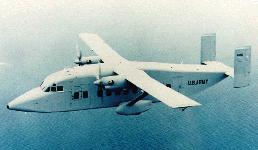
Stars & Stripes
This article is provided courtesy of Stars & Stripes, which got its start as a newspaper for Union troops during the Civil War, and has been published continuously since 1942 in Europe and 1945 in the Pacific. Stripes reporters have been in the field with American soldiers, sailors and airmen in World War II, Korea, the Cold War, Vietnam, the Gulf War, Bosnia and Kosovo, and are now on assignment in the Middle East.
Stars and Stripes has one of the widest distribution ranges of any newspaper in the world. Between the Pacific and European editions, Stars & Stripes services over 50 countries where there are bases, posts, service members, ships, or embassies.
By Juliana Gittler,
Stars and Stripes European Edition
(Photos by Juliana Gittler / S&S) Boxy and utilitarian C-23 Sherpas at Balad air base wait to carry cargo and people to airstrips around Iraq.
Sgt. Eric Muse, flight engineer with the 171st Aviation Regiment, Co. H, at Balad, Iraq, looks out the rear door before takeoff in the C-23 Sherpa.
A C-23 Sherpa belonging to the Army National Guard returns from a mission in Iraq.
From the cockpit of the C-23 Sherpa, the view over Iraq is crisp and clear - probably because it's 100 feet or less to the ground. The pilots, including Chief Warrant Officer 4 Ken Long, pictured, keep the Sherpa low and fast to reduce exposure to attacks.
Cleveland Joyner, left, directs a forklift to deliver cargo in a C-23 Sherpa as Staff Sgt. Rudy Aleman readies the load.
BALAD AIR BASE, Iraq - Fourteen hours before takeoff, the operations center of the 171st Aviation Regiment, owner of the C-23 Sherpa, gets a call that absentee ballots must absolutely, positively get to an airfield southwest of Mosul.
Can it do it?
Of course.
Chief Warrant Officer 4 James Jackson, operations officer, adds an extra stop on a planned flight to Mosul.
Throughout the evening, he'll continue to change the cargo list: adding a needed box of blood for one stop and a crew of F-16 mechanics to another. Each time the phone rings, the mission can change.
"The Sherpa is the aircraft that can," said Lt. Col. Steven Campfield, commander of the 6th Battalion, 52nd Aviation Regiment, which includes the Sherpa company. "I would say the Sherpa has been the workhorse in this theater."
It moves critical supplies such as blood, repair parts and ammunition to anywhere with an airstrip.
For safety, pilots fly low and fast, racing along at 200 miles per hour, 100 feet above ground or occasionally lower.
"We dodge power lines," said pilot Chief Warrant Officer 4 Dave Smith. "We're down there with the helicopters for the most part."
Danger in a Tin Can
Back in the States, Sherpas have the same mission, moving small groups of people and medium-size cargo loads.
"All we really did was lift up, change the scenery and add the threat," said Maj. John D. Boyer, company commander.
The threats, surface-to-air missiles, small-arms and indirect fire, force pilots to fly in a safety zone barely off the ground, a place many pilots have flown before.
"A lot of [flying] tactics are determined from reaching back in our brains to our helicopter days. Although you're moving a lot faster than a helicopter, it's not very different," Boyer said.
At a low altitude, pilots use vision, not instruments, to navigate. Pilots and crew stand constant watch for wires, towers, hapless birds and anything suspicious on the ground.
"When we first got here, everything was out of the ordinary," said Sgt. Eric Muse, flight engineer. "That was kind of unnerving."
Very few Sherpas have been attacked and none have been hit. The speed and low flights mean that by the time the enemy sees the plane, it's gone.
"You always worry about it, but you get used to it," said Chief Warrant Officer 4 Ken Long.
It's often the more banal obstacles that are a concern.
"When you're going 200 miles an hour, a 3-pound bird can have a huge impact," Smith said.
"All of us have hit birds," Jackson added. "I've seen some birds do some really bad things. Large flocks of small birds, they look just like a big cloud in front of you."
It's low enough to see rocks and shrubs, and smiles -or not - on people's faces.
"You can see their expressions, it's great," Muse said.
Pilots say flying low isn't necessarily difficult but requires intense concentration and can tire out a crew quickly.
"It's demanding at low altitude," Smith said. "It's physically demanding."
And unlike during higher-elevation flights, crews can never take a breather and rely on autopilot.
On hot days, the cockpit can reach 130 degrees and the heat causes greater turbulence.
Out of the Sky
Sherpas belong to the Army National Guard. They've been in use in the States for more than a decade but are now proving their mettle.
The aircraft came to the Army unexpectedly, said Dale Chrisenberry, company maintenance officer.
In the 1980s, Congress bought 12 from a company in Northern Ireland. The Army tried using them, then handed them to the National Guard. Congress bought a total of 44 for the Guard after they proved effective in moving people and cargo in the United States.
They served a limited role in the Persian Gulf War, moving cargo in the rear. For Operation Iraqi Freedom, they were brought in to Kuwait to take some burden off other means of transportation, Chrisenberry said.
To cut flying time and distance, the unit moved this year to Balad, a more central city in the country. From the hub there, pilots circle out to local airstrips, from Mosul in the north to Kuwait in the south.
The C-23 can move quickly around the theater and provide similar supply capabilities as the CH-47 Chinook.
"They needed something in the theater that could do what the Chinook does but with less down time for maintenance," Chrisenberry said. "There's nothing in the middle but the C-23."
Sherpas move about a half million tons of cargo a month and have ferried 9,000 people in six months, Campbell said.
"We can move 200 pounds of blood to Mosul in two hours," he said.
In July, with a day's notice, the company raced blood and ammunition to Fallujah to replenish marines fighting there.
Not Built for Looks
Most people are surprised when they see the boxy prop.
"That's one thing we're actually kidded about," Chrisenberry said. "It looks like an antique."
The planes, all about 20 years old, are made of aluminum boxes welded together. Inside, the ceiling is 6 feet high. They're made cheap and are perfect for cargo.
"It's a very durable aircraft. It's not built for looks," Chrisenberry said.
For passengers, the ride can be uncomfortable, particularly in summer when turbulent air builds at low levels, giving it more of a roller coaster ride than a cruising plane.
"It's a trickledown effect," said Chief Warrant Officer 3 Jerry Baker. "Once one person goes, several go."
The ride might be exhilarating or dreadful, depending on your constitution, but the aircraft is certainly memorable. So, too, is its function.
And it's likely to play a role in the Army's future inner-theater, midsize transportation plan.
"What we're doing here is proof of concept," said Boyer. "This is definitely going to change Army aviation indefinitely."

C-27J Spartan landing in the dirt!
The differance between a 2, 000 foot runway STOL plane for resupply and a 3, 000 foot STOL C-130 plane in terms of Forward Operating Base construction is huge.

C-130 Hercules pilot lining up for a short landing!
The differance between a twin-engined Caribou or C-27J and a 4-engined C-130 is an order of magnitude that an Army unit can ill afford to have to pay for in combat engineering. A 2, 000 foot runway STOL cargo plane that weighs just 20, 000 pounds just needs the ground to be leveled and Rhino Snot poured on top. A 3, 000 foot runway STOL cargo plane twice as heavy needs double the width and assurances that it can hold the 150, 000 pound loaded weight of a C-130. During the famous Howze Board demonstration to Secretary Defense MacNamara in 1962, the USAF tried to land a C-130 in the dirt so it could convince him the Army didn't need the Caribou. It got stuck and the Army got the Caribou! We have pics of a C-130 that busted the PAVEMENT at the Bell facility in Texas a few years back...so just imagine what it would do to unsurfaced DIRT!
The Hill
June 6, 2006Army, Air Force Push To Restore Money For Cargo Plane
By Roxana Tiron
The Army and Air Force are working to persuade authorizers and appropriators to fund the joint cargo-aircraft program fully.
The Senate Armed Services Committee cut $109 million from the Army's request for $113 million for the plan and sent shudders through the Army's aviation leadership, which had budgeted on getting the money from a canceled helicopter program.
"I am working with all those folks," Brig. Gen. Stephen Mundt, director of Army Aviation Task Force, said during a Pentagon press conference on Friday, "They all have different issues. ... That is why it is so fun."
Sen. Richard Shelby (R-Ala.), a defense appropriator, recently said that "the joint cargo aircraft is a good program and I am going to do everything I can to fund it."
The Army has been pushing for the program for a couple years and was joined by the Air Force this year.
Senate authorizers said it is premature to buy any planes until the needs of both services are analyzed. They did not slash the Air Force's request of $15 million for what it calls the light cargo aircraft.
It was Sen. John McCain's Armed Services Airland Subcommittee that initially recommended the cut. Mundt said he has met McCain and will do so again as necessary. "He wants to make sure that all the analysis has been done," Mundt said.
He characterized his meetings with McCain as a "very good dialogue."
An Army analysis found that it needs 145 new planes to replace its aging C-23 Sherpas and C-12 Hurons. The Air Force accepted the Army's analysis, as did the oversight Pentagon panel. Now the Air Force is conducting its own study to see how many planes it will need, Mundt said.
He stressed that both forces would buy the same aircraft. Differences may occur only in the kind of accessories the two need, he added.
The two services are expected to sign a memorandum of agreement. The Army has already done its part, but the Air Force has a longer vetting process, Pentagon officials say. "Words are very important," said Mundt, who signaled that the Air Force should be signing soon.
He painted a dire picture if the Army is not able to secure the full funding. The service urgently needs the aircraft, he said, and lack of money would delay delivery by two years. The Army wants its first aircraft in 2008; the Air Force is slated for 2010.
Vying for the contract are a team of L-3 Communications, Alenia North America and Boeing, offering the C-27J Spartan; a team made up of Raytheon and the European Aeronautic Defence and Space Co. (EADS), offering the C-295; and Lockheed Martin, which came late into the game with its short-fuselage version of the C-130J.
Mundt said the Army does not want any C-130s in its inventory and that Lockheed Martin would have to prove that a shorter version of the cargo workhorse can fit the Army's requirement to land on runways of 2,000 feet. He has been explaining this to congressional supporters of the C-130.
C-123 "Provider": originally an X-20 assault glider with revolutionary t-tail/rear ramp, made into a powered STOL aircraft, the C-122 then developed further
www.pointvista.com/WW2GliderPilots/postcg4agliderdesigns.htm
Some insight into the glider program from a site visitor who was an engineer with the Glider Branch and part of the design team that developed the C-123: Lew Stowe, a civilian engineer with the Glider Branch, was part of the design team that developed the glider version of the C-123. He is the originator of the rear door design that has been so successful on the C-123, C-130, and C-141 cargo planes. According to this account, Mr. Stowe battled the aerodynamics people at Wright Field who thought the lift/drag coefficient of the aircraft with this rear door design would be too low. "Every time I see cargo being snatched out of the rear of a 130, and now the 17, I give thanks to Lew that he stuck to his guns."
General Gavin from 1947 onward in Airborne Warfare and then in 1958 in War and Peace in the Space Age called on the new USAF to embrace operating hundreds of troop transports to deliver lightweight tracked AFVs like the Ontos to effect an Army "Sky Cavalry" 3D maneuver capability to learn from the Korean debacle. While part of Project Vista, their final report called on the USAF buying hundreds of C-124s for long-range strategic mobility and hundreds of C-123s for shorter-range tactical mobility into short grassy fields that are smaller than what the mighty C-130 could fly into. Michael Stroukoff's genius began with modifying the metal CG-18 assault glider into a powered STOL aircraft, the C-122 which progressed into the C-123. Even though the USAF obsessed with trying to win wars by Douhet-style strategic bombing didn't want to fully support Army 3D maneuver with enough transports, the C-123 did get into action in smaller numbers where it could operate from small airfields. Stroukoff's work on the Pantobase ski system with the C-123 was legendary and still needed today despite the pampered USAF's rejection of capabilities to operate from dirty locations.
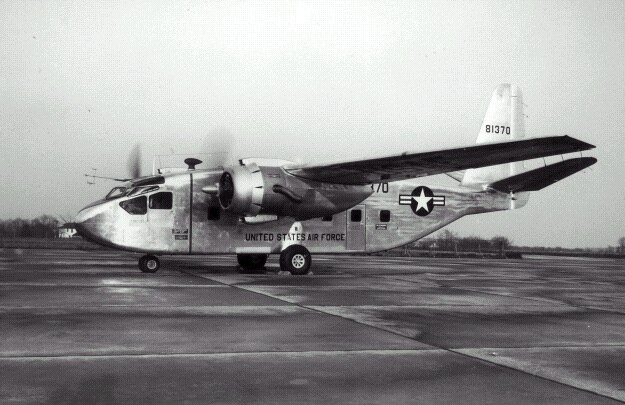
The C-122 Avitruc
The very existence of the Caribou in the Army inventory changed one Air Force program-the Fairchild C-123 "Provider." This aircraft was scheduled to be phased out of the active Air Force inventory in 1961, with a few programmed to the reserves and the remainder to be declared surplus. When Secretary of Defense Robert S. McNamara suggested that the Air Force turn over the C-123's to the Army (to train on this type aircraft prior to the receipt of the Caribou), the Air Force suddenly discovered "new and pressing Air Force requirements" for the C-123. Thus, the Army Caribou protagonists not only pushed the Caribou into being, but-incidentally-saved the C-123 for much-needed duty in Vietnam where it could land on short runways, not as shoert as the CV-2 but drastically shorter by 1, 000 feet than the C-130's 3, 000 feet.
Best seen in the fabulous films, "Air America" starring Mel Gibson and "Operation Dumbo Drop".

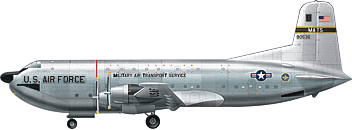








Air-Mech-Strike Model Building: C-124 Globemaster II + M24 Chaffee light tank = Air-Mech diorama
An excellent kit review of the resin 1:72 scale C-124 Globemaster II
www.cybermodeler.com/hobby/kits/ani/kit_ani_2067.shtml
www.nostalgicplastic.com/moreinfo.cfm?FROM=Search&KIT=1568
Hasegawa makes a 1:72 scale M24 light tank kit
http://shopping.msn.com/reviews/shp/?itemId=671155553
...so if you could cut the nose doors open on the resin C-124 you could make a diorama of it loading/off-loading from it.
C-130 "Hercules": can airdrop/STOL airland light tanks, parachute combat drops





Part 1: Early Design Requirements, Tactical JATO take-off (not Fat Albert), M551 Sheridan light tank LVAD-LAPES airdrop and airland off-load; Boundary Layer Control STOL just 400 feet with pod-mounted jet engines under the wings
www.youtube.com/watch?v=-nC3SKrrsT4
Part 2: Vietnam Sustainment & Disaster Relief
www.youtube.com/watch?v=Jcfp6fUm4J4
Part 3: Siege of Khe Sanh: LAPES, GPES, LVAD; Daisy Cutter Bombs, Gunships
www.youtube.com/watch?v=gUKeW6Td1xs&mode=related&search=
Part 4: AC-130 "Spectre" gunships continued...ABCC pallet, DC-130 drone launching & mid-air recovery system, Fulton Surface-To-Air (STAR) "SkyHook", Hurricane Hunters
www.youtube.com/watch?v=dLoz0H-44e8
Part 5: Hurricane Hunters continued...Arctic Herks, Admiral Byrd's Ford Tri-Motor flight over South Pole in 1928, LC-130 ski-equipped
www.youtube.com/watch?v=hzQWEfEIuks
Vietnam, Congo, Kolwezi, Grenada, Panama; airland Air-Meched M113 Gavins for hostage rescue/assault at Entebbe
Air-Mech-Strike Model Building: 1:72 C-130 + M113A3 Gavin or Scorpion light tank = air-mech diorama showing airland off/on load
C-130H
www.squadron.com/ItemDetails.asp?item=IT0015
and C-130J Hercules STOL/airdrop transport plane 1:72 scale kits together as an "air-mech" package
www.squadron.com/ItemDetails.asp?item=IT1255
with either a 1:72 scale M113A3 Gavin...
www.squadron.com/ItemDetails.asp?item=TR07240
...or a 1:72 scale British Scorpion/Scimitar light tank to your customers in your mini-catalogs....
www.squadron.com/ItemDetails.asp?item=AX01320
FYI: the AirFix kit gives you the option of a 30mm Rarden cannon instead of the 76mm Scorpion gun to make the model a Scimitar....
U.S., Italy, Canada and the IDF use M113 Gavins and the British use Scorpions (in the past) Scimitars (today) so this would match the USAF, CAF, ITAF and RAF markings of the C-130s....to do an Entebbe raid with a M113 "Zelda" the builder would have to buy IAF decals...
www.squadron.com/ItemDetails.asp?item=SY4812
www.squadron.com/ItemDetails.asp?item=SY7211
C-141 "Starlifter": airlanded Paratroops into Grenada, parachute airdropped Paratroopers into Panama
Grenada: turning point of the Cold War
Starlifters dropping 82nd Airborne Paratroops: door exits, mass tactical exits
IL-76 "Candid": simultaneous Paratrooper and vehicle exits via non-static-line deployed parachutes
www.youtube.com/watch?v=FsyAgGO2YYU
AN-12 "Cub"
BMD-1 airdrop followed by Paras with drogue chutes without our static-line BS
AN-22 "Cock"
www.youtube.com/watch?v=oy3ooUYEpDk
C-5 "Galaxy": first to parachute airdrop M551 Sheridan light tanks into combat in Panama in 1989

Light Tanks: forgotten weapons of war in U.S. arsenal?
www.youtube.com/watch?v=50cpPAVoxJQ
C-17 "Globemaster III": can STOL airland in under 3,000 feet, airdrop up to 30-ton vehicles, airlift 80+ tons at-a-time


www.youtube.com/watch?v=0v47tzBXuQg
On Rhino Snot dirt strip in Afghanistan
www.youtube.com/watch?v=nfI4gSz4RJk
LVAD
www.youtube.com/watch?v=x-ppX5wY5pU
Cargo Above the Fuselage: Guppies and Flat Beds
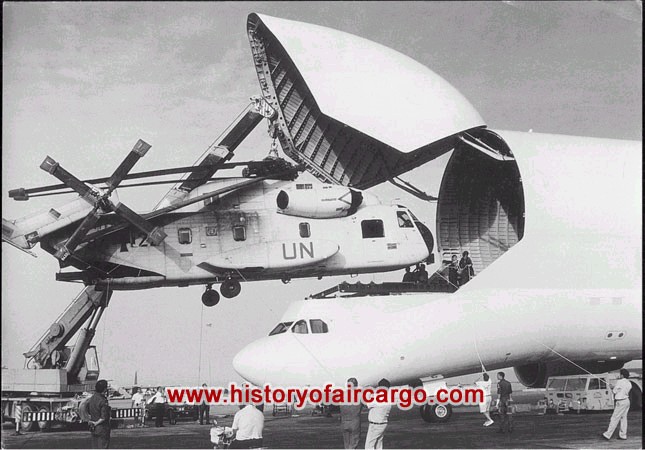



R3Y Tradewind Turboprop Transport "The Flying LST"

Martin

Mars and Howard Hughes H4
www.youtube.com/watch?v=eo8VxPC6JlI




H4 Assembly
www.youtube.com/watch?v=BCfC7brPk8Q
Howard Hughes H4 take-off
www.youtube.com/watch?v=UIhhrOhDzxA
We are not big fans of current cheesy looking CGI, but the recent film, "The Aviator" starring Leonardo DiCaprio does an EXCELLENT job showing Howard Hughes triumphing over all the nay-sayers and taking the Spruce Goose into the air. Contrary to popular belief, the Hughes Hercules was only supposed to fly at low altitudes exploiting ground effect to lift large numbers of troops. Had we used such giant seaplanes/flying boats thousands of lives would have been saved that instead were lost to German submarines (U-Boats) sinking slow, conventional sealift ships in WWII. Today the prevalence of space-based surveillance, makes the surface sealift ship an "endangered species" not likely to make it to destination against a wide array of mines, anti-ship missiles, and stealthy diesel-electrivc submarines lying in wait. One solution is a boat that FLIES and doesn't leave a wake in the water = the WIG craft.

"Caspian Sea Monster"

"Eaglet"
www.youtube.com/watch?v=nOtSfb-P1C8
NEW! Boeing's New WIG Aircraft: the "Pelican" is unveiled!


U.S. PATENT DETAILS: www.google.com/patents?vid=USPAT6848650&id=
Air-Cushion Landing Systems
The key "thorn in the side" of fixed-wing aircraft landing is not actually a lack of sizable open, areas to land on, but THE SURFACE of those areas to accept rolling, rubber-tire landing gear. If we were smart, we would eliminate this need by using air cushions landing systems (ACLSs) to levitate the aircraft a few inches off the ground as it rolls to a landing or takes-off, to break contact with the ground and its requirements to be flat/paved for tires to roll. Once ACLSs are accepted as a paradigm for the USAF, the gap would be closed between V/TOL requirements/capabilities and what STOL aircraft can do, making a stronger Air-Mech-Strike force requiring less combat engineering and being more unpredictable to enemies by not needing runways or USAF CCT soil surveys to verify assault landing zones. The Russians are already flying ACLS aircraft, even though Bell proved the technology in the 1960s on Lake ampibians and a turboprop Buffalo aircraft (think Caribou on steroids)...we have the technology..do we have the WILL?

"Credible Sport" for Iran Rescue II
www.youtube.com/watch?v=8YOtm9UCQEc
C-130 JATO
www.youtube.com/watch?v=qSYIvKr_d5c
www.youtube.com/watch?v=sDuXTZioM0g

Recently, the supersonic Concorde crashed for the first time, killing 110 plus people. What got it was not supersonic flight, but a piece of metal on the runway that busted its fragile air-filled tires, which shredded and were sucked up into its engines causing a in-flight fire. Its obvious that air-filled tires are questionable in civilian life's pressures as seen in the Firestone SUV tire recalls; why would we want to base Army combat vehicles on them or high-performance aircraft? Perhaps its time we take a fresh look at how we take-off and land aircraft in the 21st Century? This is where the most crashes occur. General Gavin in his book, Airborne Warfare stated we need a "cow pasture airplane", and he is still right. He suggested tracked landing gear. We tinkered with it in the 1950s. Perhaps with today's single-piece, flexible "band track" technology we can make this lower-ground pressure, less needy for paved runways solution work? Sounds a lot safer than relying on air-filled rubber tires ready to burst at any second. There are several studies out there urging the USAF to get away from operating aircraft from easily targeted fixed hard runways.
B-36, C-82 with tracked landing gear systems!
Tilt-wing-engine systems

The Germans were the first to realize vertical take-off and landing (VTOL) could be possible by tilting the engines down with their Focke-Achgelis FA 269 concept, but it was not until after the war that they got to make this concept work in a flying prototype. The reason was simple: their Fieseler Storch ESTOL observation plane could take-off and land under 100 feet and this was more than good enough for land combat operations in light of the fact that they were unable to fight on the sea surface without aircraft carriers.





Boeing Advanced Tactical Transport (ATT) Tilt-Wing candidate
Blended Wing/Body Boeing 797: Extreme STOL Burnelli aircraft

After the 9/11 terror attacks that used airliners as suicide planes, Americans today have an all-time low trust in air travel---and rightly so---its not just terrorist acts, either---its the needless and insufferable aircraft crashes, caused by unimaginative aircraft designs best depicted in the film, "Fearless" and smug, cavalier attitudes by the air travel and aircraft manufacturer industry. Why doesn't America transfer unsafe, unused jet airliners to DoD to solve U.S. military airlift and strategic mobility problems???

...and fly her citizens in crash-worthy, extremely Short Take-Off and Landing (ESTOL) Burnelli jet airliners with tracked landing gear? Legendary X-1 pilot and Burnelli design advocate Chalmers Goodlin was recently on CNN's Lou Dobb's Moneyline TV program detailing the need for crash-worthy aircraft.


The U.S. Congress should take action just like when railroads refused to put air brakes on trains and fund a crash-worthy Burnelli ESTOL airliner as the solution to America's air travel problems, and mandate airline companies fly them. Recently, it appears Boeing has finally realized this and is now pushing its model 797:


The new 797 is in direct response to the Airbus A380 which has racked up 159 orders, but has not yet flown any passengers.
Boeing decide to kill its 747X stretched super jumbo in 2003 after little interest was shown by airline companies, but has continued to develop the ultimate Airbus crusher 797 for years at its Phantom Works research facility in Long Beach, Calif.
The Airbus A380 has been in the works since 1999 and has accumulated $13 billion in development costs, which gives Boeing a huge advantage now that Airbus has committed to the older style tubular aircraft for decades to come.

There are several big advantages to the blended wing design, the most important being the lift-to-drag ratio which is expected to increase by an amazing 50%, with overall weight reduced by 25%, making it an estimated 33% more efficient than the A380,and making Airbus's $13 billion dollar investment look pretty shaky.
High body rigidity is another key factor in blended wing aircraft, It reduces turbulence and creates less stress on the air frame which adds to efficiency, giving the 797 a tremendous 8800 nautical mile range with its 1000 passengers flying comfortably at mach .88 or 654 mph (+-1046km/h) cruising speed another advantage over the Airbus tube-and-wing designed A380's 570 mph (912 km/h) The exact date for introduction is unclear, yet the battle lines are clearly drawn in the high-stakes war for civilian air supremacy.

Imagine if a Burnelli-type Boeing 797 Extremely Short take-Off and Landing aircraft had air cushion landing gear?
The aircraft/hovercraft Burnelli concept is courtesy of Mr. Ernest Zavala who is writing a book on the history of Burnelli aircraft.
Burnelli air cushion landing gear ESTOL aircraft would become a defacto seaplane, able to land in oceans, rivers and lakes...and would be able to land almost anywhere on land without actually needing hard surfaces for wheels to roll on....the Russians have already put into production such a combination airplane/hovercraft even though it was Bell Aircraft in the 1960s/70s that first conceived of flying prototyle aircraft with this revolutionary landing/take-off system.....who needs costly, unsafe V/STOL hybrids if you can land almost anywhere in an extremely short distance irrespective of the terrain type?
Imagine setting up our troops anywhere around the world in less than 12 hours after leaving their U.S. home base and deploying them to surround the enemy in all terrain? Ride on a cushion of air and set them down without having to "daisy" bomb an area for landing an aircraft. Talk about them not knowing where we will strike!
Blended Wing Body & Burnelli with CAT Pods
DISTRIBUTION A:
Approved for public release; distribution is unlimited.
Document created: 1 September 04
Air & Space Power
Journal - Fall 2004
|
Editorial Abstract: In the 1930s and 1940s, two intriguing innovations surfaced: (1) a cargo aircraft with a detachable, missioni-zable fuselage module and (2) the ability to conduct long-endurance flights (nearly a month in duration). This article explores the potential operational impact of combining these two innovations into a new, global-range, modular aircraft system that provides significant new options for air mobility, deployment, and airpower-projection missions. |
Global
Air Mobility and Persistent
Airpower
Operations
As Operation Iraqi Freedom (OIF) highlighted, timely air mobility and
sustainment of U.S. military forces continue to require attention. An article in Air Force Magazine addressing early mobility lessons-learned from OIF noted that "demand for airlift far exceeds supply, and senior USAF officers say it is time to expand the fleet. . . . Airlift forces were pressed to their limits. .. . Gen. Tommy R. Franks, commander of US Central Command, was forced to modify his original war plan to live within USAF's 'constrained' airlift fleet. . . . [According to Gen John W. Handy, commander of the joint-service US
Transportation Command and the Air Force's Air Mobility Command,] 'I firmly
believe we need another Mobility Requirements Study.' "1
In May 2004, the Department of Defense initiated a mobility capability
study-called for in the strategic planning guidance of 2004. According to Joint
Staff briefing charts, the study will "identify and quantify mobility
capabilities required to meet the end-to-end, full-spectrum mobility needs for
all aspects of the national military strategy.2 Also of interest,
the secretary of defense's goal of being able to "deploy to a distant theater
in 10 days, defeat an enemy within 30 days, and be ready for a new fight within
another 30 days . . . will be used as a benchmark in the new study."3
This article proposes an approach for leveraging technological and operational innovation in global air mobility that can provide a highly flexible, time-responsive means of globally positioning and sustaining US military forces-not only on the land but also persistently in the air. This approach, embodied in the technological and operational features of an air-mobility concept known as the configu-rable air transport (CAT), offers a new alternative to the force commander for addressing the mobility, sustainment, and airpower-projection needs of twenty-first-century warfare.
The CAT is envisioned as a C-5-sized aircraft that has more than twice the unrefueled range of the C-5 and that carries an interchangeable module in lieu of the traditional fuselage. Thus-like a fighter or bomber-this aircraft can be configured for a particular mission by loading the appropriate airlift or airpower module. Depending upon the mission, the flexible CAT could carry modules for Airborne Warning and Control System (AWACS), missileer, traditional cargo, tanker, Army or Marine fire support (gunship), Navy sea patrol, emergency communications for the Department of Homeland Security, fighting forest fires, or international humanitarian relief, among others. Mission by mission, if warranted, individual aircraft in the CAT fleet could be reconfigured to respond rapidly to changing air--mobility, sustainment, and airpower-projection needs worldwide.
This mobility-system concept should prove attractive for modernizing the aging elements of the current air-transport fleet for two reasons. First, the CAT would provide a modern, global-range aircraft with standardized performance, basing, support, crew, and training that could offer, through the use of missionized modules, a modernization path for many of today's transport aircraft such as the C-5 airlifter, as well as the E-3 AWACS, KC-135 tanker, E-8C Joint Surveillance Target Attack Radar System (JSTARS), C-9 aeromedical-evacuation aircraft, and the B-52 bomber. Second, the use of missionized modules enables the introduction of new mission capabilities without reducing current ones or requiring costly and time-consuming modification of the CAT aircraft. Together, these features provide an attractive acquisition option for developing a new mobility system that would not only replace a broad range of aging aircraft as they reach the end of their economic lives, but would also continue to provide state-of-the-art warfare capabilities through the development and introduction of new or upgraded mission modules.
The article begins by examining an earlier modular aircraft-the Fairchild XC-120. Following a technical description of the CAT and its mission modules, the advantages of using these modules for transporting war materiel are addressed, with particular attention to establishing high-throughput global air bridges, prepositioning forces at regional bases, and rapidly moving air and land forces forward into bare bases. The article concludes with a description of how the multiday endurance capability inherent in such a new global-range transport, when equipped with airpower mission modules, would enable persistent airpower operations to be employed. This would provide new options for flexible and highly responsive global airpower projection similar to that proposed by the Navy in its "sea strike" and "sea basing" concepts. It would also provide new options for homeland security.
Fairchild XC-120 "Pack Plane"
In 1949, shortly after the initiation of production of the C-119 "Flying Boxcar" transport for the Air Force, that aircraft's manufacturer, Fairchild, experimented with a design variation that incorporated a detachable fuselage module (fig. 1). Called the XC-120 "Pack Plane," the transport aircraft lent itself to rapid reconfiguration in support of a variety of missions. One description of the XC-120 mentions that modules could deliver cargo as well as serve as shops, weather stations, emergency hospitals, and tankers.
|
Figure 1. Fairchild XC-120 pack plane with detachable module. Courtesy of History Office, Air Force Aeronautical Systems Center. |
The Air Force ordered production of over 1,100 C-119 aircraft but did not pursue the XC-120. Since then, other approaches for designing a modular air transport have undergone conceptual definition in the United States and overseas. Like the XC-120, these did not attract serious interest by potential government or industry customers. Instead, industry stayed with the traditional tubular fuselage and wing-tail transport design that yielded aircraft optimized for and generally dedicated to a single mission, such as passenger carriage, large-cargo transport, and so forth. Today, as the Air Force assesses future air-mobility and airpower needs and solutions, the idea of a modular transport aircraft deserves renewed investigation.
Configurable Air Transport
The CAT is a C-5-/747-class aircraft that uses a blended-wing-body (BWB) design capable of carrying one interchangeable, missionized module (fig. 2).4
The BWB concept is a modern version of the Burnelli lifting fuselage and
Northrop flying-wing concepts of the 1920s, 1930s, and 1940s.5 Since
the mid-1990s, the National Aeronautics and Space Administration and the
commercial aircraft industry have conducted technical evaluations of BWB
designs and identified their potential for signifi-cant improvements in
aircraft performance and reduced empty weight.6
|
Figure 2. Configurable air transport and detachable module. (Prepared by Dennis Stewart and Isiah Davenport, General Dynamics, Advanced Information Systems.) |
Using a modified BWB for the CAT offers several advantages over traditional wing-tubular fuselage designs. In addition to having ample volume to carry the quantity of fuel needed for global range-usually 7,000 nautical miles (nm) or more-it also has sufficient volume for stowing the long landing gear required for the modular concept and for installing active self-defense systems, such as air-to-air missiles and directed-energy weapons.7 The central area of the BWB, located behind the cockpit and over the module, can accommodate approximately 100 passengers in a manner similar to the C-5 Galaxy's upper deck. Alternately, one could configure the CAT's upper deck to provide crew-rest facilities for global-range cargo-delivery missions and for the new operational concept of persistent airpower operations, discussed later. Another design advantage is that the flat lower surface of the BWB design facilitates the mating of the large mission modules. Finally, the BWB's top-mounted engines should enhance survivability, reduce noise during takeoff and landing, and enhance multimission flexibility. For instance, this engine location opens up clear lines of sight for sensors and weapons mounted on the module, providing improved flexibility to configure modules to support a broad range of electronic and force-application missions. It also may enable the CAT to conduct amphibious operations, such as combat search and rescue or at-sea replenishment, with an appropriate amphibious landing module.
The conceptual CAT configurations in this article's illustrations reflect
sizing to provide the same cargo volume as the C-5 but with approximately twice
the unrefueled range. As a baseline for comparison, the C-5 is capable of
carrying a maximum aircraft cargo load (ACL) of 178,000 pounds (89 tons) to an
unrefueled range of approximately 3,200 nm. It has a maximum peacetime takeoff
weight of 769,000 pounds, a wingspan of 223 feet, and a maximum fuel capacity
of 51,150 gallons (322,500 pounds).8
Drawing upon a conceptual BWB aircraft design assessed by Boeing for an
800-passenger transport, the CAT concept carries a C-5-equivalent maximum
planned ACL of 178,000 pounds (89 tons) to an unrefueled range of approximately
7,000 nm. This payload would correspond to 27 x 463L pallets, each with an
average load of approximately 6,600 pounds. These figures yield an aircraft
with a maximum takeoff gross weight of about 820,000 pounds, a wingspan of 280
feet, and a maximum fuel load of about 40,000 gallons (270,000 pounds).9
The BWB-based improvement in unrefueled global range of the CAT, when carrying the same payload weight as the C-5, has significant economic and operational advantages because of the reduced need for air refuelings and en route bases. This, in turn, leads to a reduction in both mission costs and total mission assets required. For example, aerial refueling costs approximately $175,000 for every 10,000 gallons.10 For a global-deployment mission of 6,000 nm, the C-5 requires two KC-135 tankers transferring a total of 28,600 gallons.11 Using the global range of the CAT to replace just one such C-5 air-refueled mission each month yields a mission cost reduction of approximately $6 million per CAT per year-or approximately $300 million for each CAT over its expected 50-year lifetime.
The typical CAT module would measure about 150 feet in length, 30 feet in width, and 17 feet in height. Internally, the module would have a 67-feet-by-27-feet flat floor (1,809 square feet) with a clear ceiling height of approximately 12 feet. The flat floor could accommodate 27 x 463L cargo pallets or rolling stock, with additional cargo stowage in the nose and tail cones. An unfurnished module would have an empty weight of about 75,000 pounds. Its upper surface would mate to the lower surface of the BWB by means of an electrically powered clamping system. The module's power system, on the order of 2,500 horsepower, would power an air-cushion system providing module-mobility on the ramp and enabling the module to be positioned for mating to the CAT.12 The self-contained power system would also provide auxiliary electrical power and environmental control for the module in flight and primary power when on the ground.
The modules would come in several basic configurations. One intended for frequent use (e.g., day-to-day cargo movement; AWACS; missileer; tanker; passenger transport; and aeromedical evacuation) could be fabricated using conventional methodology for aircraft design and assembly. Such a module would likely have a useful life of 25 years or more. Those intended for the surge transport of war materiel, including modules configured to support bare-base operations, could be built using alternative manufacturing methods and materials when lower production costs and increased production rates are emphasized. The goal would be an "expendable" module design enabling the economical production of hundreds of "war-ready" modules for placement in ready storage during times of peace, while also enabling the rapid and affordable replenishment of modules expended during hostilities.
Cargo Handling and Transport
Cargo handling and transport involve the basic operations of receiving, organizing, loading, transporting, unloading, warehousing, and distributing cargo from the point of origination to the end user. Several approaches have sought to improve the throughput efficiency of this process, starting with the most obvious of increasing the speed of the transportation system. After attainment of the maximum economic cruise speeds, further improvement requires a more fundamental change in the cargo-handling process.
Land-Sea Cargo Transportation Using Standardized
Intermodal Containers
For land-sea cargo transportation, a revolutionary improvement in throughput occurred in the mid-1950s by applying an idea that originated in the late 1930s-using standardized, intermodal cargo containers for both land and sea transportation.13 This approach resulted from recognizing that loading cargo containers from trucks to ships and back to trucks was far more time efficient than the millennia-old manual handling of individual pallets, boxes, bags, vehicles, and so forth [EDITOR: "break bulk"]. The new containerized approach reduced the nonrevenue-generating time of both ships and trucks by lessening the time spent waiting and finally loading and unloading. Consequently, one needed fewer ships, trucks, and dockside workers for a given throughput and revenue-generating capacity. Because of today's improved material-handling automation, computerized tracking of cargo containers, permanent dockside material-handling equipment, and well-trained personnel, workers need fewer than 50 hours dockside to unload and load a 3,000-container "lift-on/lift-off" cargo vessel. Ship-utilization efficiency-the time actually spent transporting cargo and generating revenue-comes to approximately 85 percent for transpacific use.
Module Loading and Unloading from the CAT
Similarly, the CAT modular concept speeds the loading and unloading of the
cargo, thus improving the overall transportation-utilization efficiency of the
aircraft and minimizing the required ramp space. Examination of movies of the
XC-120 module's unloading operations and a simplified visualization of
detaching a module from the CAT suggest that it may be possible to drop a
module in as little as 10 minutes following arrival at the designated
module-release spot on the ramp. For the one-way transfer of cargo into an air
base, the CAT would land, taxi, drop the module, taxi, and then take off
without stopping the engines. The total time spent on the ground might amount
to only 20 minutes. By way of comparison, the C-5's ground time for unloading cargo without refueling or reconfiguration is 120 minutes.14
Attaching a module to a CAT, however, will be more complex. We could use an automatic mating system on the CAT that precisely locates the module and provides guidance cues so that the pilot can accurately taxi the aircraft into position above the module. After final alignment of the module using the air-cushion system, the actual mating would take about 10 minutes since it would involve the same basic aircraft and module operations used to drop a module-only conducted in reverse.
A preliminary time allocation, consistent with the assumptions above,
indicates a total CAT time on the ground of approximately 140 minutes: 10
minutes for taxiing following landing, 10 minutes to drop the module, 60
minutes to taxi and refuel the aircraft, 20 minutes to taxi and position the
CAT to pick up the next module, 10 minutes to pick up a module, 20 minutes for
anomaly resolution and final checks, and 10 minutes to taxi to the runway for
takeoff.15 Without refueling, the total time would approach 80
minutes. If crews could refuel the aircraft and load/unload the module
simultaneously by using the mobility of the modules to move them to and from
the CAT during refueling, then the total ground time would also come to about
80 minutes. The C-5, for comparison, requires 500 minutes of planning ground
time for unloading cargo, refueling, reconfiguring the cargo compartment, and
loading cargo.16
Simple Model of a CAT Air Bridge
A first-order system-dynamics simulation of a CAT air bridge identified the number of aircraft needed, based on assumptions for flight frequency and ramp-space requirements at the aerial port of debarkation (APOD). This model simulated a global-delivery mission to a distance of 6,500 nm without air refueling or en route base stops-for example, one way from McGuire AFB, New Jersey, to Qatar in the Persian Gulf. At an assumed departure rate of three CATs per hour, 84 aircraft would establish a constant-throughput air bridge, delivering 72 modules carrying an average of 4,400 tons per day (using a planning cargo load of 61.3 tons) for an airlift capacity of 28.6 million ton-miles per day.17 Using the assumptions stated above for ground operations for nonsimultaneous unloading/loading of modules and fueling activities, one would need seven ramp parking places at the APOD to swap modules, refuel the CATs, and prepare for the return flight. The total round-trip time from departing the aerial port of embarkation (APOE) to departing for the next trip is approximately 31.5 hours. One would also need a minimum of seven ramp parking spaces at the APOE. Turning to the C-5 once again, one sees that the ideal maximum daily cargo throughput for 52 arrivals per day, assuming seven ramp parking places, carriage of the maximum ACL, no reduction for ramp-queuing inefficiencies, no loading constraints, and no en route air refueling or basing constraints, would amount to 3,200 tons.
This simple air-bridge model was applied to the movement of a 5,000-person Army brigade with 12,000 tons of materiel to a distance of 6,500 nm. A planning cargo load of 61.3 tons was assumed, as was the fact that each CAT could also carry up to 100 Soldiers in the upper deck. With a 20-minute departure spacing, the 84 CATs completed the movement of personnel and cargo in approximately 95 hours from the time the first aircraft departed the continental United States (CONUS) until the last one returned and had been unloaded and refueled. With a 30-minute departure spacing, 56 CATs completed the needed 196 missions in approximately 127 hours. Focusing on the 10-day deployment goal of the aforementioned mobility-capability study, one sees that each 84-CAT air bridge would be capable of delivering 41,000 tons of war materiel or about three Army brigades.
One criticism of the comparison of air-bridge models of the CAT and C-5 points out that the cargo in the module unloaded from the CAT is not necessarily unloaded, whereas the ideal throughput for the C-5 includes unloading the cargo. This is not actually the disadvantage it appears to be. The primary objective of using modules for moving cargo is to improve utilization efficiency of the transport aircraft. Detaching the module, moving it away from the aircraft parking spaces, and then unloading it all help to ensure a high CAT-utilization efficiency by preventing difficulties in unloading cargo-engines on rolling stock that will not start, jammed cargo restraints, lack of sufficient unloading crews or equipment, and so forth-from interfering with the processing and departure of the CATs. Further, depending on available ramp space, it is not necessary to unload the modules immediately since they provide environmentally protected and controlled storage of the cargo. A ramp area of 2,500 feet by 600 feet at the APOD could store approximately 100 modules containing 6,100 tons of war materiel. Also, with appropriate training, the arriving troops (as in the above example of the Army brigade) could unload their own equipment without the need for large numbers of Air Force personnel. Additionally, the emptied modules could serve as temporary shelter until their return.
Overcoming Limitations on Fuel Availability
Like other large air transports, the CAT requires a secure and plentiful supply of fuel. In the air-bridge example cited above, if the CATs required refueling at the APOD, the daily pumping requirement would reach approximately three million gallons. To meet these needs, the base would require a substantial hydrant-fueling network and fuel-storage capacity. Since forward locations will probably not include such facilities, one approach for establishing high-throughput transport of modules into an area like this would involve flowing the CATs through a network of regional bases (described in the following section) to the APOD. (Andersen AFB, Guam-a potential regional base in a global CAT distribution network-has a fuel-storage capacity of approximately 66 million gallons.)18 The global-range capability of the CATs permits them, unlike the C-5s, to fly 3,000 nm from the regional base into the APOD and return the same distance to the base without either refueling at the APOD or air refueling en route. One could establish APODs to handle a throughput of up to 2,900 tons per day, with a planning cargo load of 61.3 tons, at forward locations that would otherwise not be available due to a lack of aircraft-fueling capacity. A continuous 3,000 nm air bridge from the regional base to and from the APOD, with 30-minute spacing, would require 28 CATs. Moving the Army brigade, for example, would require about five days to complete. Because the aircraft would not have to refuel at the APOD, they would need only three ramp parking spots to sustain this throughput.
Global Distribution Network
One could establish a network of CONUS and overseas regional bases-for example, eastern and western CONUS, Hawaii, Guam, Alaska, Diego Garcia, and western Europe-to support the rapid global delivery of CAT modules to APODs located in most locations of interest (fig. 3). The longest route length, using a great circle, comes to 5,200 nm. The unrefueled global range of the CATs would allow them to move between these bases without en route air refueling. With this operational model, including an overlay of 3,000 nm operating radii from each of the bases, CATs transporting modules would then fly from the CONUS APOE to pick up the loaded module and then to the APOD, using regional bases for fueling and crew rotation. Returning CATs would pick up empty and unneeded modules and bring them back through regional bases to CONUS terminals for reuse.
Materiel Prepositioning and Rapid Delivery
Prepositioning of materiel to support the rapid deployment of military forces has become increasingly important. The CAT modules provide a means to environmentally protect, preload, and securely store the first-entry combat forces' air-transported equipment, supplies, and forward-base facilities in the CONUS and at regional bases without using permanent ware-houses. After activation of such forces, crews could "float" the modules containing stored equipment on the modules' air cushions to the designated module-loading location on the ramp to await arrival of the CATs and initia-tion of the air bridge to the designated APOD.
Prepositioning of preloaded modules integrates well with the global unrefueled range of the CAT. The CATs' ability to fly to an unrefueled range in excess of 10,000 nm (without modules) allows the rapid repositioning of these aircraft with minimal or no demand for en route basing or air refueling. In case of an emergency, designated CATs conducting normal air-mobility missions worldwide would land at a US or allied air base, drop their modules, and refuel. Less than 90 minutes after landing, the CATs would be en route to the designated regional base, where they would pick up prepositioned modules and carry them forward to an APOD or, as discussed later, under-take airpower-projection missions.
CAT Tanker
A tanker module will allow CATs to function as strategic tankers. For
mission-assuredness purposes, such a module would have twin, high-capacity
refueling booms to support the refueling of large aircraft such as the B-1,
B-2, C-17, and C-5, as well as other CATs. The tanker module would have an
off-load capacity of approximately 200,000 pounds at an operating radius of
3,000 nm from the CONUS and regional bases (fig. 3). On a shorter-duration
mission-radius of about 500 nm-additional fuel from the CAT's wing tanks could
increase the off-load capacity up to approximately 350,000 pounds. The KC-135E,
in comparison, has an off-load capacity of 101,200 pounds and 10,500 pounds at
mission radii of 500 nm and 2,500 nm, respectively.19
|
Figure 3. CAT module and tanker coverage from the CONUS and regional bases |
Modules providing tanker capability can be equipped to dispense fuel while parked on the ground. With a storage capacity of approxi-mately 35,000 gallons and a self-powered fuel-pumping system, these modules could store and dispense fuel at forward bases-an important feature since ever-more US aircraft and ground equipment use the same JP-8 fuel. Hence, CAT tankers could use the module to escort tactical aircraft to an in-theater air base and then leave the module to support local air and ground operations.
In addition to the use of tanker modules for dedicated air-refueling missions, all CATs will probably feature permanent, wing-mounted refueling systems to air-refuel fighters and unmanned aerial vehicles (UAV). Installing a lower-capacity boom on one wing and a probe-and-drogue system on the other would permit all CATs, regardless of the transport or airpower-projection mission performed, to serve as emergency en route tankers and permit airpower-projection CATs to "top off" fighter escorts.
Bare-Base Support
The forward deployment of military forces often requires the establishment of operations at bare bases-that is, air bases or commercial airports where the runways, taxiways, and ramps are usable or rapidly repairable but where the supporting capabilities, such as fuel storage and power generation, are either not available or not readily repairable. To support the deployment of military forces into these bases, the Air Force uses prepackaged, transportable bare-base kits called Basic Expeditionary Airfield Resources, assembled at the bare base by Air Force civil-engineering teams.
CAT modules provide a new approach for these kits. Instead of using tents and erectable buildings, base personnel could utilize special versions of the CAT war-ready module for shelter. We can easily visualize the establishment of initial tactical air operations at a bare base using missionized CAT modules (fig. 4). In this example, a delivery rate of up to four modules per hour reflects the circumstance that CATs would not pick up modules for the return flight and that these aircraft do not need refueling. This delivery rate yields a total timeline of approximately seven hours:
|
Figure 4. Bare-base buildup. (Prepared by Dennis Stewart and Isiah Davenport, General Dynamics, Advanced Information Systems.) |
] Time = 0 hour. Initial security forces and base-opening civil engineers arrive via C-130s. Planned module locations have been preestablished, based upon satellite and UAV surveillance information.
Time = +2 hours. CATs deliver three modules for air base defense, and crews move them on the modules' air cushions to defensive locations away from the ramp. Two modules contain surface-to-air missiles and Phalanx-type air defense guns, while a third contains an antimissile/aircraft laser and target-acquisition radar. Laser defenses would also protect against artillery, mortar, rocket, and similar munitions. Operating crews for these defensive systems, as well as additional Air Force civil engineering teams, fly to the bare base in the upper deck of the CATs that deliver these modules. A fourth CAT, on the ramp (fig. 4, upper right), delivers the first Army module containing more ground-defense equipment.
Time = +3 hours. Four Army modules (fig. 4, lower left) containing up to 245 tons of equipment and 400 soldiers arrive. After they empty the modules, personnel use them for temporary quarters and protection against chemical, biologi-cal, and small-arms attack.
Time = +5 hours. Six modules designed to support tactical air operations arrive and are placed at the far end of the ramp. Personnel erect air-supported canopies between the modules to provide shelter for conducting maintenance and weapon loading on the tactical aircraft (fig. 4, lower right). Air Force civil engineers as well as operational-support personnel arrive in the CATs that transport these modules.
Time = +7 hours. The final four modules containing fuel, water, and munitions arrive, as do the tactical aircraft in preparation for initiating local air operations. Subsequent deliveries replenish these modules and return the empty ones for restocking.
The bare-base CAT modules would be specially designed for this application, providing nuclear, chemical, biological, environmental, acoustic, and ballistic protection for forward-deployed forces. They might also contain active self-defense capabilities, including tactical lasers. The auxiliary power system used to run the air cushion would also provide electrical power and environmental control. The configu-ration of the interior of the modules would incorporate many specialized logistical-support functions that would normally require the erection or assembly of separate facilities-air and space operations centers, secure communication facilities, crew quarters, hospitals, mess facilities, maintenance shops, small-arms arsenals, fuel-storage areas, munitions shelters, recrea-tion facilities, and so forth. Upon completion of the mission, crews would reload the modules on the CATs for return to the CONUS for cleaning, repair, and replenishment. Many of these modules would also prove useful in -humanitarian-relief operations. A key feature of this use of CAT modules is the ability to repack and relocate them quickly. In the example above, four CATs with tanker support could relocate these modules to another base 1,000 nm distant in about 20 hours, thus providing substantial flexi-bility for repositioning theater air forces as the operational campaign unfolds.
Persistent Airpower Applications
In early 1929, shortly after Charles Lindbergh's famous 34-hour flight in 1927, Maj Carl Spaatz and Capt Ira Eaker of the US Army Air Corps initiated an effort to investigate long-endurance flight.20 In the Air Corps's three-engine Fokker C-2A Question Mark, they, along with Lt H. A. Halverson, Lt E. R. Quesada, and Sgt R. W. Hooe, established an initial endurance record of just over 150 hours, involving 42 air-refueling and resupply hookups. In one of many endurance efforts undertaken later that year, Dale Jackson and Forest O'Brine established a new record of 420 hours in a single-engine Curtiss Robin, increasing the record in 1930 to 647 hours in the same plane.21 Five years later, brothers Fred and Algene Key extended the record to 653 hours (27 days), again in a single-engine Curtiss Robin.22 In this 1935 record flight, the Keys completed 432 hookups to transfer fuel, oil, and supplies and flew a ground track of over 52,000 miles.
Almost 70 years later, one has trouble locating these endurance records in the history books. Contemporary planners regard the 40-hour missions of B-2s as remarkable and assume they are pushing the edge of the envelope of human and hardware endurance. Yet, clearly this is not the case. In fact, this area of potential technology exploitation can lead to the establishment of a new paradigm of persistent airpower operations in which we could fly critical military capabilities into forward air bases. Such capabilities would provide persistent deterrence or force application when land bases are unavailable/threatened or when sea-based forces have not yet arrived. With suitable onboard areas for crew rest and multiple flight crews, persistent airpower operations with CATs would begin to emulate naval operations with a corresponding influence on the types of airpower capabilities used, joint operations undertaken, and Air Force and joint doctrine executed.
In December 2002, Vice Adm Cutler Dawson and Vice Adm John Nathman of the US Navy discussed the advantages of the persistent forward projection of sea power:
Sea Strike is a vision of what we
will become as well as the focus of our capability today. It is about far more
than putting bombs on target, although the delivery of ordnance remains a
critical function. At its heart, Sea Strike is a broad concept for naval power
projection that leverages C5ISR (command, control, communications, computers,
combat systems, intelligence, surveillance, and reconnaissance), precision,
stealth, information, and joint strike together. It amplifies effects-based
striking power through enhanced operational tempo and distant reach. It takes
U.S. power to the enemy 24 hours a day, 7 days a week, creating shock and awe
both immediately and persistently. Sea Strike is what it takes to win in the
21st century.23
Similarly, in January 2003, Vice Adm Charles W. Moore Jr., U.S. Navy, and Lt Gen Edward Hanlon Jr., U.S. marine corps, discussed the twenty-first-century advantages of sea basing:
Sea Basing is the core of "Sea
Power 21." It is about placing at sea-to a greater extent than ever
before-capabilities critical to joint and coalition operational success:
offensive and defensive firepower, maneuver forces, command and control, and
logistics. By doing so, it minimizes the need to build up forces and supplies
ashore, reduces their vulnerability, and enhances operational mobility. It
leverages advanced sensor and communications systems, precision ordnance, and
weapons reach while prepositioning joint capabilities where they are immediately
employable and most decisive. It exploits the operational shift in warfare from
mass to precision and information, employing the 70% of the earth's surface
that is covered with water as a vast maneuver area in support of the joint
force.24
We could realize many of the operational advantages inherent in "sea strike" and "sea basing" through persistent airpower operations involving CATs. Operating from the network of regional bases described earlier, groups of perhaps as many as eight CATs with appropriate airpower modules could patrol designated areas within a 3,000 nm radius of the regional or CONUS base for periods of several days (fig. 5). CAT tankers operating from these same bases would air-refuel the patrolling CATs every 12 to 18 hours. These "air battle groups" would provide the ability to rapidly establish air superiority, demonstrate national resolve, support allies, and, if necessary, project airpower without the need to first establish forward land-operating bases within the theater of operations. These persistent airpower operations would emulate deep-ocean naval operations but with the advantage that the entire surface of the planet would become accessible.
|
Figure 5. CAT AWACS, cargo, unmanned combat air vehicle (UCAV) flying tender, and direct-fires-support module. (Prepared by Dennis Stewart and Isiah Davenport, General Dynamics, Advanced Information Systems.) |
Such an air battle group might consist of CATs carrying the following types of modules:
Integrated flight-operations center, AWACS, and JSTARS for battlespace situational awareness and battle-group command and control (C2).
Airborne laser for missile defense and self-defense of air battle group.
Standoff-attack module carrying 50 2,000-pound missiles capable of Mach 7 speed and a range of 1,000 nm for rapid, precision strike.
Ballistic-missile-defense module carrying 40 3,000-pound air-launched antiballistic missiles for defense against theater ballistic missiles.
Direct-fires-support module carrying twin 155 mm cannons; multiple tactical lasers; and medium-range, precision-attack munitions to provide sustained fires support for special operations forces and to defend US and allied forces, including forward bases.
UCAV flying tender carrying two Mach 3.5 UCAVs and 400 precision-attack munitions to conduct battlespace surveillance and attack.
CAT tankers for refueling fighter escorts.
Just as the U.S. Navy puts its carrier battle groups to sea during times of increased threat as a show of force and to increase forces deployed forward, the air battle group offers similar possibilities for airpower. These unique CAT advantages-global unrefueled range, which enables the quick repositioning of CATs; rapid mission reconfiguration using airpower modules prepositioned at regional bases; and multiday endurance with refueling-allow the Air Force to rapidly assemble, project, and sustain airpower virtually anywhere in the world. Within 12 hours or less, if CAT air battle groups are already airborne, the Air Force could provide a first and signifi-cant response to threatening forces or could engage attacking forces with substantial, long-range, precision firepower. Within 24 to 36 hours, we could globally reposition, refit, and send forward 10s of additional CATs to sustain the initial airpower operations and link up with other arriving joint forces. CATs could become core elements of the military's "first-response" air and space force.
The CAT concept would also support homeland defense. CATs flying multiday air-patrol missions could undertake missions such as ISR, ballistic and cruise missile defense, countersmuggling detection, negation of captured airliners or ships, C2, and airborne communications. CAT modules similar to those used for forward bare-base support could be used for postattack support in areas temporarily isolated from ground access and communication. Finally, one could possibly adapt CAT tanker modules to support fighting forest, pipeline, and urban fires resulting from terrorist attack or other causes.
The CAT UCAV flying-tender module (figs. 5 and 6) highlights the flexibility in new operational approaches enabled by the CAT and its modules. In this concept, a CAT serves as the flying tender for two 15,000-pound UCAVs, rearmed and refueled by the tender module. Preliminary estimates indicate that each UCAV could carry four 250-pound precision-guided weapons to an operating radius of 750 nm at a cruise speed of Mach 3.5. Assuming the CAT orbits 300 nm outside "Red's" border, the UCAVs could strike targets and conduct surveillance up to 450 nm inside of Red. At this maximum combat radius, the UCAV would have a mission cycle time of approximately one hour. Each CAT tender and its twin UCAVs could attack eight targets each hour or approxi-mately 200 targets per day. At closer distances, each tender's UCAVs could attack up to 24 targets per hour. The CAT's UCAV tender module would carry approximately 400 250-pound munitions-enough for 100 reloads of the UCAVs.
|
|
|
|
Figure 6. Left: a CAT's UCAV flying-tender module. Right: an in-flight UCAV rearming. (Prepared by Dennis Stewart and Isiah Davenport, General Dynamics, Advanced Information Systems.) |
The UCAVs on each tender could also conduct 50 or more ISR sweeps within the battlespace during each 24 hours to augment other air and space capabilities. Advanced communication systems, perhaps using direct-line-of-sight lasers, would link the UCAVs and the tender aircraft to provide real-time C2 of the former throughout most of the mission. Further, outbound UCAVs could relay ISR data identifying high-priority targets to the C2 CAT, which could then relay updated target lists to inbound UCAVs, thereby providing a responsive deep-strike capability.
CAT Crisis-Augmentation
Capabilities
The Air Force relies upon the CRAF to augment organic military-transport capabilities during times of crisis. The versatility of the CAT offers a new approach to providing crisis augmentation. A government-owned, contractor-operated fleet of CATs, notionally called Eagle Air (fig. 7) and manned by Air Force Reserve and retired aircrews, could perform the bulk of the day-to-day movement of CAT modules to support peacetime operations of the US military and humanitarian and peacekeeping operations of the US government. For one weekend a month and two weeks each year, the CATs and their Reserve crews would train with the assigned active duty air-mobility units. In times of crisis, these Eagle Air CATs could then quickly activate, integrate into their active duty units, and conduct virtually all of the air-mobility and airpower-projection missions.
|
Figure 7. A CRAF Eagle Air CAT loading Army rapid-deployment modules. (Prepared by Dennis Stewart and Isiah Davenport, General Dynamics, Advanced Information Systems.) |
Conclusion
[We need] a future force
that is defined less by size and more by mobility and swiftness, one that is
easier to deploy and sustain, one that relies more heavily on stealth,
precision weaponry and information technologies.
-President George W. Bush
Transforming the ability to move and sustain U.S. military forces is, as President Bush stated, critical to preparing U.S. military forces for the future and providing the president with the military capability needed to effectively protect and defend the United States and its allies.25 This article has attempted to respond to this need by describing how advanced aeronautical technologies, combined with an innovative modular system architecture, offer the potential to significantly increase the air mobility and sustainment of US military forces. In particular, the article has sought to show how the air mobility aspects of the secretary of defense's goal of being able to "deploy to a distant theater in 10 days, defeat an enemy within 30 days, and be ready for a new fight within another 30 days" may be achievable. Further, the article has tried to demonstrate that this modular-system architecture may provide a cost-effective means of modernizing our aging air-transport fleet with an innovative aircraft system that provides air mobility, sustainment, and airpower-projection capabilities that will significantly enhance the responsiveness and agility of U.S. military forces well into the future.
Notes
1. John A. Tirpak, "The Squeeze on Air Mobility," Air Force Magazine 86, no. 7 (July 2003): 23, 24, 25, http:// www.afa.org/magazine/July2003/0703mobility.asp.
2. Jason Sherman, "DoD Study May Pit C-17s, Fast Ships vs. Fighters," Defense News, 21 June 2004, 1.
3. Ibid., 8.
4. The CAT is one of 66 futures war-gaming concepts defined and assessed in the Air Force Technology Seminar game conducted by the Air Force Research Laboratory in 2000-2001 in partnership with the Air Force Directorate of Strategic Planning.
5. "Northrop's Flying Wing Airliner," in Glen Edwards and the Flying Wing: The Diary of a Bomber Pilot, The Warbird's Forum, November 2003, http://www.danford.net/ paxwing.htm.
6. "The Blended Wing Body: A Revolutionary Concept in Aircraft Design," NASA Facts Online, 24 April 2001, http://oea.larc.nasa.gov/PAIS/BWB.html.
7. The notional CAT design includes a landing-gear configuration derived from the design of the B-58 bomber of the late 1950s. The B-58 had a high wing-about 7.5 feet-and carried a large centerline fuel pod. Its landing-gear design used a simple structural configuration and fold mechanism that yielded an extremely light landing-gear weight fraction, despite its long length.
8. Air Force Pamphlet (AFPAM) 10-1403, Air Mobility Planning Factors, 18 December 2003, 12, table 3, http:// www.e-publishing.af.mil/pubfiles/af/10/afpam10-1403/afpam10-1403.pdf; C-5 Galaxy Fact Sheet, http:// www.af.mil/factsheets/factsheet.asp?fsID=84; and C-5A/B Galaxy, http://www.fas.org/man/dod-101/sys/ac/c-5.htm.
9. These estimates are based on aircraft size and performance for a large Boeing BWB conceptual aircraft. See "Boeing Blended Wing Body Large Commercial Transport," Jane's All the World's Aircraft, 14 July 2003, www.janes.com.
10. This assumes an average air-refueling cost of $17.50 per gallon of fuel, as reported in "B-52 Re-engining, Financing Plan Endorsed," Aerospace Daily, 8 April 2003.
11. AFPAM 10-1403, Air Mobility Planning Factors, 18, table 11.
12. As an interesting point of comparison, General Motors recently showed a concept car that included a 1,000-horsepower V-16 engine.
13. This idea, originated by Malcolm McLean in 1937, was not put into practice until 1956. His Sea-Land Corporation initiated the concept of commercial, containerized cargo transport. See http://americanhistory.si.edu/ onthemove/exhibition/exhibition_17_2.html. In 1950 the United States Army developed a similar concept called "CONEX" that saw extensive use in Vietnam; it has led to today's military use of intermodal containers.
14. AFPAM 10-1403, Air Mobility Planning Factors, 14, table 5.
15. This scenario assumes a hydrant system for refueling with two hookups to the aircraft, each with an average flow rate of 450 gallons per minute. Onloading 30,000 gallons of fuel would take approximately 45 minutes.
16. AFPAM 10-1403, Air Mobility Planning Factors, 14, table 5.
17. For C-5 planning cargo load, see ibid., 12, table 3.
18. A1C Claudia Garcia-Strang, "Andersen to Have Largest Fuel Storage Contractor to Turn Over New Tanks Soon," PACAF News, 17 October 2002, http://www2. hickam.af.mil/newsarchive/2002/2002217.htm.
19. AFPAM 10-1403, Air Mobility Planning Factors, 17, table 10.
20. "Flight of the Question Mark," USAF Museum History Gallery, http://www.wpafb.af.mil/museum/history/ postwwi/fqm.htm.
21. Capt Franklyn E. Dailey Jr., USN, retired, Socked In! Instrument Flying in Northern Latitudes, 2002, appendix A, "Aviation Events, 1929-31," http://www.daileyint.com/ flying/flywara.htm.
22. "Curtiss J-1 Robin: 'Ole Miss,' " Smithsonian National Air and Space Museum, http://www.nasm.si.edu/research/ aero/aircraft/curtiss_j1.htm.
23. Vice Adm Cutler Dawson and Vice Adm John Nathman, USN, "Sea Strike: Projecting Persistent, Responsive, and Precise Power," US Naval Institute Proceedings 128, no. 12 (December 2002), http://www.usni.org/ proceedings/Articles02/PROdawson12.htm.
24. Vice Adm Charles W. Moore Jr., USN, and Lt Gen Edward Hanlon Jr., USMC, "Sea Basing: Operational Independence for a New Century," US Naval Institute Proceedings 129, no. 1 (January 2003), http://www.usni.org/ proceedings/Articles03/PROseabasing01.htm.
25. Department of Defense, Transformation Planning Guidance, April 2003, 3, http://www.defenselink.mil/brac/ docs/transformationplanningapr03.pdf.
James Michael Snead (BSAE, University of Cincinnati; MSAE, Air Force Institute of Technology) is the lead for Agile Combat Support in the Aeronautical Systems Sector, Plans and Programs Directorate, Air Force Research Laboratory (AFRL), Wright-Patterson AFB, Ohio. He has also served as a science and technology engineer at AFRL, focusing on futures war gaming and future war-fighting concepts. Other positions at Wright-Patterson include lead structures engineer, Aeronautical Systems Center; chief flight-systems engineer/ lead structures engineer, National Aerospace Plane Joint Program Office; and project engineer, Transatmospheric Vehicle Project Office. Currently Mr. Snead is chairman of the American Institute of Aeronautics and Astronautics (AIAA) Space Logistics Technical Committee.
Disclaimer
The conclusions and opinions expressed in this document are those of the author cultivated in the freedom of expression, academic environment of Air University. They do not reflect the official position of the U.S. Government, Department of Defense, the United States Air Force or the Air University.
This material is declared a work of the U.S. Government and is not subject to copyright protection in the United States.
Configurable Air Transport (CAT)

James Michael Snead*
Air Force Research Laboratory, Wright-Patterson AFB, OH 45433
This paper describes a concept of a large flying fuselage transport aircraft that carries the cargo or missionized payload in several large, detachable modules instead of carrying this cargo or payload internally as in current aircraft designs. The paper addresses the application of this concept to the global military airlift missions of air refueling, materiel transport, and persistent air power projection. The paper concludes with a brief discussion of the extension of this module-based aircraft design to other emerging military and commercial air transport needs.
Nomenclature
ton = 2,000 lbs. or 907 kgs.
I. Introduction
Common characteristic of all production transport aircraft has been the use of the classic wing-fuselage-tail design incorporating a cargo compartment permanently a part of the tubular fuselage. This "constraint" has resulted in aircraft generally dedicated to a particular set of mission capabilities frozen at the time the aircraft is manufactured or, as in the case of installing passenger-to-cargo conversion kits, when an existing aircraft is remanufactured into a different mission configuration.
In the late 1940s Fairchild addressed the operational constraints imposed by traditional fixed aircraft configurations with an experimental variant of the United States Air Force C-119 aircraft. To build this XC-120, the C-119 was modified to replace the fuselage section below the wing carry-through structure with a hardback capable of carrying a detachable module. Referred to as the "Pack Plane," the XC-120 demonstrated the feasibility of a different and more mission-flexible transport aircraft design approach where a transport aircraft's mission capabilities can be expanded through the use of an easily changed module where the module's mission capabilities, e.g., passenger, cargo, bomber, tanker, etc., defines the aircraft's mission capabilities.
While the XC-120 modular aircraft did not proceed into development, it remains an interesting and potentially revolutionary idea. This paper pursues the application of this concept to modern air transport systems. It briefly summarizes previous applicable flying wing/fuselage design efforts, explores the application of the flying wing/fuselage concept to modern modular transport aircraft, discusses possible design approaches for a long-range air transport aircraft, and discusses potential acquisition and operational advantages of such an aircraft for commercial and military transport operations. The paper concludes with a brief discussion of the potential extension of this module-based aircraft design to smaller fixed-wing and rotor aircraft.
________________________________________________________________________________
* P.E., Aerospace Engineer, AFRL/XPA, james.snead@wpafb.af.mil, Senior Member
II. Background
A. XC-120 Pack Plane
The C-119 and the XC-120 were tactical transports designed to transport troops and light equipment to the front lines of battle. The primary modifications of the C-119 to yield the XC-120 were the elevation of the cockpit from a nose position on the C-119 to the XC-120's position above the wing and the accompanying changes in the fuselage aft of the cockpit to provide a mating surface, below the wing carry-through structure, for the detachable module. The only other apparent significant modification was the replacement of the single forward landing gear with twin forward landing gear incorporated into redesigned engine nacelles. These modifications did not apparently degrade the performance of the aircraft as the 9 ton maximum payload of the C-119 was retained. A newsreel from the late 1940's shows the detachment of the module from the aircraft. Figure 1 shows frames from this movie.

Electric hoists incorporated into the modified fuselage lowered the module to ground level where small landing gear, suitable for low-speed towing, were manually attached to each corner. The total time to detach and remove a module appeared to be about 10 minutes. The narration accompanying the newsreel mentions potential applications of the XC-120 for cargo and tanker airborne missions as well as transporting modules designed for leaving at forward bases-hospitals, weather stations, etc. In addition to the practical demonstration of the feasibility of designing an aircraft with a detachable module, the XC-120 showed how this could be incorporated into a conventional wing-fuselage-tail configuration without undue difficulty. Rather than look at applications of the modular construct to modern versions of the wing-fuselage-tail configuration-still potentially useful for tactical transport aircraft designs with short takeoff and landing capabilities as discussed at the end of this paper-this paper focuses on the application of the modular construct to another revolutionary transport aircraft design from the 1930s and 1940s-the flying fuselage.
B. Flying Wings/Flying Fuselages
Since the late 1800s, surprisingly, aircraft designers have pursued designs that maximized aerodynamic and structural performance. This design approach led to configurations that minimized aerodynamic surfaces not directly producing lift. British aeronautical pioneer John W. Dunne initiated this with the Dunne biplane tailless aircraft in 1912.1 Subsequent designs included the Horten, Junkers, and Northrop flying wings in the 1930s and 1940s, and the Burnelli concept patented in the mid-1940s. The Northrop B-2 bomber, currently in service with the United States Air Force, is the only production application of the pure flying wing concept while the Space Shuttle orbiter and the F-117 fighter represent modified flying wings incorporating rear-mounted control surfaces. A key design constraint for flying wing transports is the vertical height of the required internal cargo or passenger compartment. As the Fig. 2 photograph of the B-2 shows, even with a respectful span of 172 ft, a substantial fuselage bulge was required to provide suitable volume for the cockpit and bomb bay for a flying wing designed to cruise at high subsonic speeds for intercontinental distances.
One way to address this design constraint is to make the aircraft sufficiently large that the thickness of the wing can accommodate a reasonable cargo or passenger compartment height. However, with respect to reasonable sized airliners, Nickel and Wohlfahrt, circa 1990, conclude: "It seems to be impossible with current technology to design a commercially viable all-wing airliner where the passengers and freight are almost completely integrated in the wing."2

Figure 1 - Fairchild XC-120 with detachable module

Figure 2 - B-2 flying wing
American Institute of Aeronautics and Astronautics 3
Figure 3 - Burnelli-designed UB-14

Figure 4 - Boeing Blended Wing Body Concept in USAF Configuration
The second way to address this design constraint is to move away from a pure flying wing to a modified design where the center wing section is of a different aerodynamic shape, i.e. a thicker airfoil shape, to permit an increased compartment height while the outer wing sections maintain an optimized aerodynamic shape. The Burnelli CB-16 twin-engine passenger aircraft, built in 1928, and the UB-14, built in 1934, represent the first applications of this concept (Fig. 3) Although this was not a pure flying wing-due to the use of twin aft booms to mount control surfaces-it did introduce the concept of a monoplane design where the passenger compartment was an integral part of the lift-generating surfaces. Today, this is referred to as a "flying fuselage" design.
C. Blended Wing Bodies
In the late 1980s examination of the aerodynamic efficiency of traditional wing-fuselage-tail transports indicated little improvement since the introduction of the first jetpowered transports.3 Seeking to identify a new design paradigm yielding improved subsonic transportation efficiency, conceptual aircraft designers returned to the central idea of the flying wing/flying fuselage that aerodynamic and structural efficiency improvements could be achieved by maximizing the lift generated per pound of aircraft. The resulting aircraft designs were referred to as Blended-Wing-Body (BWB) configurations (See Fig. 4).

During subsequent years the BWB concept underwent several configuration changes as aerodynamic, stability and control, structural, propulsion, safety, market considerations, etc. were factored into the aircraft conceptual designs.4 Taking advantage of improved multidisciplinary design optimization computer capabilities, several trimmed and balanced BWB configurations have been identified that are predicted to provide substantial performance and economic advantages over traditional wing-fuselage-tail designs incorporating comparable levels of technology.5 Both civilian and military applications of these concepts have been addressed.6 Even with these BWB designs, however, the key constraint of traditional wing-fuselage-tail aircraft discussed in this paper-that of the mission capability of the specific aircraft being frozen at the time of its manufacture-remains in effect. While the design of the BWB design is flexible to both scaling (e.g., increasing the payload weight and volume) and adaptation to different missions (e.g., a military tanker), once manufactured the BWB will remain a passenger aircraft or a tanker aircraft, as examples, for the duration of its expected 30+ year life unless remanufactured into a new mission configuration.
D. Existing Transports
Cargo and passenger transport characteristics of a module-carrying future transport are discussed later in this paper. Relevant characteristics of current transport aircraft are summarized in the following:
1. C-5 Galaxy [7]
Developed in the 1960s, the C-5 Galaxy is a subsonic transport designed to provide air mobility for primarily the United States Army (USA). The C-5 is capable of moving all USA equipment including main battle tanks, large bridging equipment, and most helicopters. It has three pressurized cabins for materiel and personnel transport. The lower cabin is used primarily to transport cargo. It is 36.91 m (121 ft) in flat floor length, 5.79 m (19 ft) in usable width, and 4.15 m (13.6 ft) in height at the aircraft centerline. The upper forward cabin is located above the lower cabin immediately behind the cockpit. It is 11.99 m (39.3 ft) in length, 4.2 m (13.8 ft) in maximum width, and 2.29 m (7.5 ft) in height at the centerline. This cabin is used to transport aircraft personnel including a relief crew for long missions. The upper aft cabin is also located above the lower cabin, but aft of the wing carry through structure. It is 18.2 m (59.7 ft) in length, 4.2 m (13.8 ft) in maximum width, and 2.29 m (7.5 ft) in height at the centerline. The aft
American Institute of Aeronautics and Astronautics 4
cabin is configured to transport 75 passengers situated in six-abreast seating with a single isle. The C-5 has a wingspan of 67.88 m (222.7 ft) and a fuselage length of 75.54 m (247.8 ft). The outer fuselage width is approximately 7.3 m (24 ft). The nominal cargo dimensions are 5.79 m (19 ft) in width by 2.74 m (9 ft) in height. The typical depth of the fuselage is approximately 7.6 m (25 ft). A typical cross-section through the aft fuselage is shown in Fig. 5.
The C-5s main cabin is configured for two-abreast vehicle and military cargo pallet loading with the additional ability to load oversize vehicles along the centerline. Fixed-width cargo rails for two-abreast loading of the 463L pallets or one centerline loading for air (dropped) deployed pallets. The C-5 has a total of 36 pallet positions. The C-5 has the ability to squat such that the floor of the cargo cabin is at truck-bed height to facilitate cargo loading.
The C-5 has a maximum gross weight of 381,000 kgs. (840,000 lbs.).8 The Allowable Cabin Load (ACL)-the maximum payload that can be carried on a 3,200 nm mission-is 80,700 kgs. (178,000 lbs.) while the "planning" cargo load is 55,600 kgs. (122,600 lbs.).9 The ACL for passengers is 73 passengers based on 181 kgs. (400 lbs.) per passenger. The number of passengers carried for planning purposes is 51. These passengers can be carried in addition to the cargo. 9
2. C-17 Globemaster III [10]
Developed in the 1980s, the C-17 Globemaster III is a subsonic transport designed to augment the USA mobility capabilities of the C-5. The C-17's cargo compartment has a 20.8 m (68.2 ft) flat floor length and a usable width of 5.5 m (18 ft). Its maximum height is 3.75 m (12.3 ft) underneath the wing carry through structure and 4.1 m (13.5 ft) aft of the wing carrythrough structure. The outer fuselage width is 6.86 m (22.5 ft). The C-17 does not have separate cabins for passenger transport. Rather, it utilizes fold-down seats that are permanently-mounted against the cargo compartment's side walls. The C-17's cargo compartment is configured for cargo similar to that of the C-5. It holds twin rows of 9 x 463L pallets (18) or a single row of 11 pallets. The C-17 has a wingspan of 51.8 m (169.8 ft) with a fuselage length of 53 m (174 ft). The nominal cargo dimensions are 5.5 m (18 ft) in width by 2.74 m (9 ft) in height. The fuselage depth is approximately 6.6 m (21.6 ft). A typical cross-section through the aft fuselage is shown in Fig. 5.
Somewhat smaller than the C-5 with a maximum gross weight of 265,300 kgs. (585,000 lbs.), the ACL for a 3,200 nm mission is 58,960 kgs. (130,000 lbs.) while the planning load is 40,800 kgs. (90,000 lbs.).9 The ACL for passengers is 101 with 90 used for planning. Unlike the C-5, the passengers are carried in lieu of cargo. [9]
3. KC-10 Extender
The KC-10 Extender is a modified commercial McDonnell Douglas DC-10 that includes a centerline air refueling boom, underwing hose-reel pods for probe/drogue aircraft refueling, and lower cabin fuel cells for additional fuel carriage. The first aircraft was delivered in 1981. It is comparable in size to the C-17 with a maximum weight of 268,900 kgs. (590,000 lbs.) with a maximum usable fuel load of 154,200 kgs. (340,000 lbs.). [11] The KC-10 has the capability to carry 27 pallets.[11] For airlift missions, the maximum ACL is 74,400 kgs. (164,000 lbs.) [11] and the planning load is 29,600 (65,200 lbs.).9 The passenger ACL is 75 while the number of passengers for planning is 68.9 Both internal cargo and passenger weight are carried in lieu of offloadable fuel for the air refueling mission.

Figure 5 - Comparison of transport aircraft cross-sections aft of wing (drawn to the same scale)
American Institute of Aeronautics and Astronautics 5
4. Boeing 747-400 [12]
First developed in the 1960s, the latest version of the Boeing 747 provides both passenger and cargo transport. Comparable in size to the C-5, the 747 has a maximum gross weight of 397,700 kgs. (877,000 lbs.) with a maximum payload of approximately 67,100 kgs. (148,000 lbs.). The wing span is 64.9 m (213 ft) and the fuselage length is approximately 69.8 m (229 ft). The outer fuselage width is 6.5 m (21.3 ft) while the height, aft of the forward upper cabin, is 6.93 m (22.75 ft). The depth through the forward, upper cabin is 7.7 m (25.25 ft)-about the same as the C-5. For cargo transport, the main cabin is configured to carry two 2.43m (8 ft) by 2.43 m (8 ft) cargo containers side-by-side without reconfiguring the aircraft interior. With removal of the ceiling, 3 m (9.8 ft) tall cargo containers can be carried aft of the upper cabin. The lower cargo compartment is designed to carry containers 1.6 m (5.3 ft) tall by 4.72 m (15.5 ft) wide. A typical cross-section through the aft fuselage is shown in Fig. 5.
5. C-130 Hercules
Developed in the 1950s, the C-130 Hercules remains the U. S. Air Force's primary tactical transport. What is of particular interest is the fact that the cargo compartment dimensions and weight limits dictate what cargo can be airlifted forward into the battlespace. The U.S. Army's selection of the air mobile combat vehicles for the "Stryker" Brigade Combat Team (SCBT) and development of the Future Combat System's (FCS) air mobile combat vehicles, both described below, were governed by the lift and cargo cabin dimensions of the C-130. Most C-130s have a cargo cabin that is 12.2 m (40 ft) long, 3 m (119 in) wide, and 2.74 m (108 in) high. The newer C-130J-30 has a stretched cargo cabin length of 16.8 m (55 ft). The C-130J has a maximum payload capacity of 19,000 kgs. (42,000 lbs.) while the stretched C-130J-30 has a maximum payload capacity of 20,000 kgs. (44,000 lbs.). The ACL for the C-130 is 15,400 kgs. (34,000 lbs.) while the planning load is 10,900 kgs. (24,000 lbs.). Both of these are for a mission distance of 2,000 nm.9 The C-130 ACL for passengers is 90 while the number of passengers for planning is 80. Like the C-17, the C-130 carries passengers in lieu of cargo. [9]
E. Air Mobile Cargo
The following examples are representative of the types of air mobile cargo considered in the design of the cargo transport capability of a new strategic airlifter.
1. 463L Military Pallet System
Military loose cargo transport is accomplished using the 463L pallet system comprised of cargo pallets, netting, pallet loaders, and on-aircraft pallet rails and restraints. This pallet system is used on all current Air Force transports and on some large cargo helicopters. These pallets can also be carried on commercial air cargo aircraft through the use of adjustable rails. The pallets are 2.24 m (88 in) by 2.74 m (108 in) and can be loaded to a height of approximately 2.44 m (96 in) with a maximum weight of 4,500 kgs. (10,000 lbs.).13 (See Fig. 6.) For mission planning, the average loaded pallet weight is assumed to be 1,800 kgs. (4,000 lbs.).14 For general cargo transport, both the C-5 and C-17 use parallel rows of loaded 463L pallets with the 2.24 m (88 in) pallet dimension oriented laterally. For airdrop delivery of cargo, a single row of pallets, with the 2.74 m (108 in) dimension oriented laterally, is loaded along the aircraft centerline to permit deployment while in flight.
The Air Force has several types of materiel handling equipment (MHE) to load the 463L pallets on to the military transport aircraft. The largest is the 27,200 kgs. (60,000 lbs.) 463L Aircraft Loader which lifts the pallets to the aircraft's cargo floor height and then uses floor roller systems to roll the loaded pallets onto the aircraft. Smaller 18,100 kgs. (40,000 lbs.) and 11,300 kgs. (25,000 lbs.) aircraft loaders are also used. The 463L system also includes various forklifts to transport and position loaded pallets at the aerial ports.
2. Military and Commercial Intermodal Containers
Intermodal containers are cargo containers of standardized dimensions used to transport cargo via ship, rail, and truck. (See Fig. 7) The military's version of the intermodal container is called a MILVAN while the commercial version is referred to as an ISO (for International Organization for Standardization) container. As the name implies,

Figure 6: Loaded 463L pallet
American Institute of Aeronautics and Astronautics 6

Figure 7: Intermodal container
this concept, commercially originated in the 1950s by Malcolm McLean based on his idea from the 1930s, keeps the cargo in the same container while the container is transshipped from one mode of transportation to another. (Note the similarity to the XC-120 concept.) The American version of the containers-the current world standard-are 2.44 m (8 ft) wide and 2.44 m (8.0 ft), 2.59 m (8.5) or 2.9 m (9.5 ft) tall. Lengths vary from 3 m (10 ft) to over 15.2 m (50 ft) in length. The 6.1 m (20 ft) and 12.2 m (40 ft) lengths are the standard sizes used in large volume oceanic and rail transport. "MILVAN" containers are 6.1 m (20 ft) long. The European version, referred to ISO 02, is 2.59 m (8.5 ft) in width, sized to accommodate the slightly larger commercial pallet size used in Europe. MILVAN and ISO Intermodal 6.1 m (20 ft) containers generally have a maximum gross weight of 20,300 kgs. (44,800 lbs.) although some special versions, such as the sideopening and tanker containers, have higher maximum gross weights. The 12.2 m (40 ft) ISO intermodal container has a maximum gross weight of 30,500 kgs. (67,200 lbs.). From a military doctrine point of view, the 6.1 m (20 ft) container is used primarily early in a military contingency and would be the primary size container to be airlifted in support of such operations.[15]
MILVAN and ISO intermodal 6.1 m (20 ft) and 12.2 m (40 ft) containers are air mobile using the 463L rail system on military transports.16 The 6.1 m (20 ft) long containers can be mounted on a two- or three-463L pallet train or on a 6.1 m (20 ft)-long 463L adapter ISO/Air Cargo pallets. With this ISO/Air Cargo Pallet, the maximum container gross weight is 11,300 kgs. (25,000 lbs.). With a two-pallet train, the maximum container gross weight would be 15,000 kgs. (33,000 lbs.) for the C-5 in any location and 20,300 kgs. (44,800 lbs.) for the C-17 on the centerline. With a three-pallet train, the maximum container gross weight for the C-5 increases to 20,200 kgs. (44,500 lbs.) while the C-17 constraints remain the same. For a 12.2 m (40 ft) long container, a five-pallet train is used and the maximum gross weight for the container is 20,400 kgs. (45,000 lbs.). Note that only the larger two 463L Aircraft Loaders would be able to load or unload containers with the maximum permissible weights. Most Air Force Air Mobility Command CONUS fixed aerial ports are also equipped with 20,700 kgs. (50,000 lbs.) capacity forklifts capable of handling up to the 12.2 m (40 ft) long containers. [17]
A general note, with respect to container weights, is that the maximum container weights are only achieved with dense cargo such as munitions. For example, the "Stryker" combat vehicle, discussed below, while slightly longer than a 6.1 m (20 ft) long container weighs less than the maximum container weight. It is assumed that the maximum ISO/Air Cargo Pallet cargo weight of 11,300 kgs. (25,000 lbs.) represents a suitable maximum container weight for aircraft design purposes.
3. Mobile Shelters and Facilities
Mobile shelters and facilities are modularized military logistical support capabilities such as medical facilities and aircraft logistical support facilities. They are comparable in size to the MILVAN container and are air mobile. The maximum gross weight of the mobile facilities is 9,100 kgs. (20,000 lbs.). For military air transport, each shelter/facility is mounted on a two-train of 463L pallets. Within permissible individual and total weight limits, the C-5 can transport 10 mobile facilities, the C-17 can transport 3 mobile facilities, and the C-130 can transport 2 mobile facilities. [18]
4. Commercial Air Cargo Unit Load Devices
Unit Load Devices are containers and pallets used to transport cargo using commercial aircraft. The devices are used in both the main cabin and the lower cabin, if the aircraft is appropriately equipped. The standard container/pallet footprints are 2.44 m (96 in) x 3.18 m (125 in) or 2.24 m (88 in) x 3.18 m 125 in). An oversize pallet has footprint dimensions of 2.44 m (96 in) x 6.1 m (238.5 in). The maximum loaded height is up to 2.44 m (96 in) and, in special circumstances, up to 3 m (118 in). Gross weights are up to approximately 6,000 kgs. (13,273 lbs.).
5. "Stryker" Brigade Combat Team
The U.S. Army is currently deploying the "Stryker" Brigade Combat Team (SBCT). It is comprised of a mixture of wheeled combat and support vehicles. The "Stryker" combat vehicle weighs approximately 16,400 kgs. (36,250 lbs.) and
American Institute of Aeronautics and Astronautics
7

Figure 8: "Stryker" combat vehicle being unloaded from a military cargo aircraft
is 7 m (275 in) long, 2.72 m (107 in) wide, and 2.64 m (104 in) tall (See Fig. 8). The possible need for improved armor to protect against new threats holds open the possibility that the weight of the Stryker combat vehicle may grow to approximately 19,500 kgs. (43,000 lbs.).* The largest noncombat vehicle is the Heavy Expanded Mobility Tactical Truck (HEMTT). Of the different HMETT configurations, the largest is 10.85m (427 in) long, 2.44 m (96 in) wide, and 2.57 m (101 in) tall. These trucks have an empty curb weight of approximately 17,200 kgs. (38,000 lbs.) without any additional armor protection. The SBCT encompasses approximately 14,000 tons and 3,500 personnel. Three days of sustainment, not including fuel and water, adds an additional 2,500 tons. The air mobility support group required to receive the embarking equipment and personnel at the Forward Operating Location (FOL) requires 900 tons of equipment and approximately 1,000 personnel.19
6. Future Combat System
The future U.S. Army air mobile fighting force is called the Future Combat System (FCS). It may take the place of the "Stryker" combat vehicle. Because of the constraints on tactical air mobility, the current emphasis is on a family of FCS vehicles comparable in physical size to the Stryker so that tactical air transport via the C-130 is possible. For the purpose of this paper, consistent with a general design philosophy of providing performance margin for future growth, the maximum FCS weight is assumed to be 22,700 kgs. (50,000 lbs.).
7. Personnel transport
The aisle height in passenger compartments in commercial transports is typically 1.93 m (76 in) or greater. Long distance seat accommodations, designed to enable passenger rest during long transoceanic flights, are up to 0.64 m (25 in) in width and have a seat pitch of up to 2.1 m (83 in) to permit the seat to recline into a flat bed. Typical aisle widths are 0.56 m (22 in) with an aisle located next to every seat, except for the outboard seats, to provide for the minimal disturbance of sleeping passengers.
III. Future Air Force Mobility Aircraft Capability Needs
Lessons-learned from recent United States military operations have reemphasized the importance of air mobility capabilities and heightened senior-level interest in identifying and resolving possible gaps in meeting anticipated future air mobility needs. Two air mobility areas pertinent to the discussion of the conceptual design of a future military transport aircraft are air refueling and force deployment and sustainment, and initial response and persistent airpower operations. Each of these areas is discussed in the following.
A. Air Refueling
Developed initially during the 1950s as a critical element of United States nuclear deterrent capabilities, tankers provide a core air mobility capability enabling global access for United States and allied military air forces. The United States Air Force provides the bulk of these tanker resources through its 530 KC-135 Stratotanker and 59 KC-10 Extender aircraft.
1. Current Air Force Tanker Performance
The primary Air Force tanker missions are to escort and provide en route refueling to other aircraft during deployments and to refuel combat aircraft, such as fighters, during operational missions. Approximate values for the unrestricted takeoff weight offload capacities vs. deployment range of the KC-135E/R and KC-10 are shown in Fig.9
* This increase of approximately 3,200 kgs. (7,000 lbs.) is taken from page 28 of the Ref. 19.
The 14,000 tons includes 1,225 tons of added armor weight as noted on page 28 of the Ref. 19.
Recall that the new C-130J and C-130J-30 have a maximum payload of 19,000 kgs. (42,000lbs.) and 20,000 kgs. (44,000 lbs.), respectively.
American Institute of Aeronautics and Astronautics
8
0 25 50 75 100 125 150 175 200 0 1000 2000 3000 4000 Deployment Range (nm) Fuel Transfer (1000 lbs.) 5000 6000 225 250 Single KC-10 Fuel Offload Single KC-135R Fuel Offload Single KC-135E Fuel Offload Single F-15C Fuel Onload

Figure 9: Approximate KC-135E/R and KC-10 Deployment Fuel Offload Capabilities and F-15C Onload Need
20* The F-15C deployment refueling needs are also shown in Fig. 9.21 From this information a single KC-135E, still using early turbojet engines, can support one F-15C for approximately a 3,200 nm deployment. The KC-135R, with the newer CF-56 turbofan engines, can support the deployment for approximately 3,700 nm while the KC-10 can support the deployment for approximately 4,800 nm.
2. Deployment Mission Ranges
The increasing scope of global military missions and the potential for political or active denial of established en route bases increases the needed deployment mission range. Figure 10 shows a notional routing network connecting CONUS Aerial Ports of Embarkation (APOE) with Forward Support Location (FSL) bases located on U.S. territory and in allied countries. Air deployment missions would utilize this network to move air forces from their permanent bases to Forward Operating Locations (FOLs) from which air operations would be undertaken. In this architecture, the maximum great circle route length required to reach any base in this network is 4,500 nm. This route length connects Diego Garcia to Guam and would represent the longest non-stop route segment for forces deploying from, for example, Hawaii to Diego Garcia via Guam. The maximum great circle route length that enables any base to be reached from any other base is 8,800 nm. Obviously, depending on the circumstances of the time, not all of these air routes may be available due to political limitations on overflight and the presence of threats. Additional strategic bases in Japan, Australia, the former Soviet Union, and the Middle East, for instance, would add robustness to this network.
To provide margin for non-optimum flight paths, a new strategic tanker sized to support the deployment of fighter aircraft over this route structure would be designed for a mission distance of approximately 5,200 nm-representing a 15% margin. For the new strategic tanker to be capable of self-ferrying directly to any base from any base, the design mission distance would be approximately 10,000 nm-again representing approximately a 15% margin.
* These offload capacities are based on the allowable takeoff gross weight for a 10,000 ft, sea level, standard day takeoff. The offload capacities have been increased to eliminate the 1-hour orbit time included in the offload values shown in the reference.

Figure 10: Notional CONUS APOEs and Worldwide FSL Network and Connecting Great Circle Routes
American Institute of Aeronautics and Astronautics 9
3. Deployment Mission Fuel Offload Needs
The tanker design mission fuel offload needs are based on a mission to ferry fighter aircraft 5,200 nm. The F-15C has a total internal and external fuel load, with two conformal fuel tanks, of approximately 10,400 kgs. (23,000 lbs.).22 The ferry fuel burn rate is approximately 5,000 kgs./hr (11,000 lbs./hr).23 The required fuel reserves at the destination is 3,400 kgs. (7,500 lbs.).24 Using an average cruise true air speed of 447 knots, shown in the example calculations of Ref. 24, the required fuel onload for ferrying an F-15C 5,200 nm would be 50,000 kgs. (110,400 lbs.).* (This calculated F-15C fuel onload is also shown in Fig. 9.) Ref. 23 shows that the fuel burn rate for the F/A-22A is approximately 20% greater than the F-15C. Applying this adjustment yields a design mission fuel onload for a single fighter of approximately 60,000 kgs. (132,500 lbs.). A second tanker deployment mission would be to ferry fighter aircraft from an FSL to an FOL. The tanker would provide air refueling of the fighter and then would return to the FSL without necessarily landing at the FOL. For force recovery, the tanker would fly to a rendezvous point near the FOL and then air refuel the fighter as both aircraft return to the FSL. Using the same example values as above, the single fighter fuel onload, for a 3,000 nm deployment or recovery of the F/A-22, is approximately 32,000 kgs. (70,600 lbs.).
B. Force Deployment and Sustainment
1. National Defense Strategy
The current National Defense Strategy, in what is referred to as the "1-4-2-1" strategy, "directs a force sized to defend the homeland, deter forward in and from four regions, and conduct two, overlapping 'swift defeat' campaigns," ... where "the force must be able to 'win decisively' in one of the two campaigns."25 Further elaboration by the Office of Secretary of Defense calls for the future capability to deploy forces to a distant theater in 10 days, defeat an enemy within 30 days, and ready the force for redeployment within another 30 days. This operational deployment construct is referred to as "10-30-30." Key to the successful implementation of this strategy is achieving force agility-"the ability to rapidly deploy, employ, sustain and redeploy capabilities in geographically separated and environmentally diverse regions."26
2. Army Deployment
To meet this 10-30-30 objective, the U.S. Army is "undergoing a near-total restructuring, moving away from the old hierarchy of brigades, divisions, corps and armies to a more flexible modular structure based on so called Units of Action (UA). ...[T]he UA will be the smallest combined-arms unit in the Army. ... Maneuver UAs plus other UAs specialized for strike, reconnaissance, support and force protection can be organized into larger Units of Employment (UEs)..."27 The SBCT, discussed above, represents a transitional step from previous heavy armor battalions to the future UA populated using the FCS, also discussed above. The current Army objective is to be able to deploy the SBCT within 96 hours. A Rand report assessed the potential use of C-17s, using the planning load factors stated above, to conduct this deployment. With an allocation of 60 x C-17s, the SBCT could be deployed to an FOL at a radius of 1,325 nm from the CONUS Aerial Port of Embarkation (APOE) or FSL.28 This deployment required in excess of 4 C-17s per hour for the 4 days of the deployment. However, as noted in the report, this operational rate was believed to be unrealistic given the "quality of airport infrastructure in much of the world."
Using the notional network, the coverage for deployment of the SBCT within these analysis parameters is shown in Fig. 11. A comparison with the 3,000 nm deployment mission radius from a CONUS base or FSL to a FOL is also shown. With the exception of the coverage of Europe and northern Africa, the baseline C-17 mission provides substantially less useful coverage of other areas of the world, compared with a 3,000 nm deployment mission radius, when undertaken from the bases included in the notional network.
* The average cruise true air speed is based on the KC-10.
For comparison from the same reference, the F-117 and F-15E have fuel burn rates of approximately 4,200 kgs./hr (9,200 lbs./hr) and 5,800 kgs./hr (12,700 lbs./hr), respectively.
The 3,000 nm deployment mission radius used for comparison was selected to provide good global coverage with significant overlap to permit many FOLs to be reached directly from two or more FSLs.
American Institute of Aeronautics and Astronautics 10
3. Air Forces Deployment
The Air Force now operates under the Air Expeditionary Force (AEF) construct emphasizing mobile and rapidly deployable air and space forces. In organizing, deploying, and sustaining these forces, the military's "unit-type code" (UTC) is used to "bin" warfighting materiel and personnel. Deployed AEFs are comprised of selected UTCs integrated together to provide a specific mission capability from a specified operating location. A UTC may range from as few as two people with minimal materiel to upwards of hundreds of personnel with hundreds of tons of materiel. Recently, a wing vice commander stated "We are no longer a wing-based Air Force; we no longer live in a wing-based world. We are now a UTC-based Air Force; we now live in a UTC-based world."29 Air mobile deployment of AEFs involve ferrying aircraft and transporting containerized and palletized cargo, mobile facilities and shelters, wheeled vehicles, fuel, water, and passengers. For the projection of air and space power, the Air Force objective is to globally deploy and initiate operations for the first AEF within 48 hours and five AEFs within 15 days.
C. Persistent Air Power Operations
For many years during the Cold War with the Soviet Union, U.S. strategic nuclear air forces maintained persistent armed air operations to ensure an ability to respond rapidly to a surprise nuclear attack on the United States. This operational concept was expensive, using the aeronautical technologies of the 1950s and 1960s, and was discontinued as confidence in land- and sea-based ballistic missiles and remote intelligence gathering improved. With a suitably design aircraft-range, payload flexibility, crew accommodations, and sufficient on-board consumables such as food, water, and oil-new transport aircraft would be able to remain flying for many days. The famous Voyager round-the-world aircraft record of the 1990s showed both the capability to remain flying for many days and to cover large geographic distances. In the 1930s, the world record for air-refueled flight was established at 29 days and involved over 450 air refuelings and resupply. This was done in a single-engine aircraft and a two-person crew.
Applying the persistence of sea force projection to air power is a new military construct. From Fig. 11, using the CONUS and FSL bases shown in the notional network, each 3,000 nm radius represents an area of responsibility. Airborne battle groups, consisting of large subsonic transports configured with air refueling, command and control, intelligence, and power projection capabilities, would fly multiday missions within their area of responsibility. Patrol patterns within the area of responsibility would constantly shift to enhance survivability, increase uncertainty in potential adversaries, and enable air power to be effectively combined with sea power to provide an integrated military power projection capability. The airborne aircraft would be refueled with tankers operating from the bases in the network. As needed, the air power capabilities of the airborne aircraft would be augmented through the use of tactical aircraft operating from these same bases. For example, the F/A-22 would use its efficient supersonic cruise capability to takeoff and rapidly join up with the airborne battle team to enhance air superiority, provide defense against airborne and surface threats, and provide additional power projection capabilities.

Figure 11: 1,325 nm and 3,000 nm mission radii from the FSLs in the notional network
American Institute of Aeronautics and Astronautics 11

Figure 12: Initial CAT configuration
As with sea battle groups, air battle groups provides an effective means to project U.S. military power and establish U.S. military presence in troubled areas of the world. Air battle groups enable this to be undertaken anywhere on the planet, undeterred by land-sea geography and, to a lesser degree, local weather conditions.
IV. Configurable Air Transport
The Configurable Air Transport (CAT) concept is of a flying fuselage military transport/tanker aircraft optimized to carry large, centerline-mounted modules in lieu of significant internal cargo or passenger volume. For the purpose of this paper, the CAT concept is discussed from the point-of-view of a multi-mission military airlifter. However, civilian applications of this aircraft concept are also discussed.
A. Origination of CAT Concept
Application of the XC-120 modular concept to traditional wing-fuselage-tail aircraft configurations has been explored several times in the intervening half century. Integrating a sufficiently large module into a traditional aircraft design has proven to be a challenge in that, like the XC-120, mounting the landing gear and aft control surfaces in a manner that enables efficient high-subsonic flight for long-distance cargo transport is difficult.30 In the 1980s and 1990s several large transport aircraft concepts were explored to provide a means of airlaunching reusable and expendable space access systems. Some of these ideas involved mounting the launch system on the top of a large commercial transport-usually a Boeing 747-in the manner the Space Shuttle orbiter is carried. Other designs, typically involving supersonic or hypersonic release of the space launch system, carried the launch system in a lower centerline, submerged position in the fuselage to reduce drag during the acceleration to separation velocity and to enable gravity-assisted separation of the launch system from the "mother" aircraft. Many of these mother aircraft configurations, due to the aerodynamics of supersonic and hypersonic flight, were tailless aircraft designs.
With technology advancements in airframe and propulsion systems, the projected performance of the reusable space access systems improved to the point that subsonic separation from the mother aircraft appeared possible. Submerged carriage of the reusable space access system was no longer required and the tailless mother aircraft designs for supersonic and hypersonic separation evolved into a flying wing concept with the reusable space access system attached to the bottom, centerline of the wing using a mounting adapter. The subsonic flying wing design also had the advantage that its thick wings provided sufficient volume at the required fore-aft locations to stow the long landing gear required to provide sufficient clearance for carriage of the reusable space access system during takeoff and landing. This internal landing gear stowage would also leave a clean lower surface of the mother aircraft's wing that would enhance safe separation of the two vehicles. Affordability considerations in assessing the viability of such a space access concept led to the exploration of alternative missions for the mother aircraft. Examination of historical information identified the XC-120 and subsequent cargo module concepts. The potential of the flying wing design to carry a large cargo module was clearly apparent. Further, the flying wing approach promised the potential of identifying an efficient high-subsonic cruise speed capability due to the improved long landing gear integration and the elimination of the tail booms.
B. Initial CAT Utility Study
During the later 1990s and early years of this decade the author conducted a military utility study of a flying fuselage aircraft configured to carry a single large module. Study efforts focused less on aircraft design and optimization and more on identifying and addressing, from a conceptual perspective, issues and advantages associated with a modular military air transport aircraft. These study results was presented in "Global Air Mobility and Persistent Airpower Operations."31 As shown in Fig. 12, the initial CAT configuration was a large aircraft with a single, centerline-mounted module. For simplification of the mobility analyses addressed in the cited article, the payload was sized to be the same as the C-5. This resulted in a large aircraft with an expected gross weight of about 371,900 kgs.
American Institute of Aeronautics and Astronautics 12
(820,000 lbs.), a wing span of approximately 85.3 m (280 ft), and an unrefueled global range of approximately 8,000 nm. The module was approximately 45.7 m (150 ft) in length, 9.1 m (30 ft) in width, and 5.8 m (19 ft) in height. These values were not based on specific conceptual design analysis of the CAT, but were based on published BWB aircraft size, range, and payload conceptual design information. This reflected an early emphasis on addressing the question of the potential military utility of a modular air transport. As discussed in Ref. 31, there appears to be significant military utility for a modular air transport not only for deploying military forces but also for providing a global range air platform for conducting persistent airpower missions.
C. Updated CAT
1. Design Needs
Using the previously discussed cargo transport and military mission needs, the Table 1 parameters are used to update the conceptual design of the CAT. Note that these parameters do not address oversize and extra heavy cargo such as the Abrams M-1A1 main battle tank. The fleet of C-5 and C-17 aircraft is expected be able to meet these air transport needs for the foreseeable future as well as provide unique mission capabilities such as paratroop airdrop.
Design Need Value Rationale
Table 1: Updated CAT Design Parameters
American Institute of Aeronautics and Astronautics 13

Figure 13: Updated CAT cargo module cross-section (right) compared with C-5 (left)
7 - 463L Pallets SBCT Vehicle Military Facility Military Facility 6 - Commercial 96" x 125" Pallets 16.8 m (55 ft) �� �� �� ��

Figure 14: Updated CAT cargo module flat floor layout
MILVAN/ISO Intermodal container 2.6 m (102 in) wide x 2.6 m (102 in tall x 6.1 m (20 ft) long; 12,100 kgs. (26,700 lbs.) average with ISO/air cargo pallet Enables transport of typical military-used containers Commercial air cargo container 2.24 m (88in)/2.24 m (96 in) x 2.44 m (96 in) tall x 3.18 m (125 in) @ 6,000 kgs. (13,273 lbs.) max Enables transport of commercial containers for interoperability Module maximum payload weight 24,200 kgs. (53,400 lbs.) Two ISO containers and associated ISO/air cargo pallets Module average payload weight 12,700 kgs. (28,000 lbs.) Seven 463L pallets with average loads CAT average planning load 42,200 kgs. (93,000 lbs.) Three sets of average loaded 463L pallets plus 19 military passengers and 6 crew members
2. Updated Module Configuration
The original CAT configuration envisioned a large cargo module with approximately the same internal volume, flat cabin floor area, and payload capabilities as the C-5. This was primarily done to permit comparisons of the CAT and C-5 in terms of cargo throughput for deployment missions. In this paper, an alternative module configuration will be explored. From Table 1, the design payload cross-section, which encompasses the identified cargo, is 3.18 m (125 in) wide by 2.74 m (108 in) tall. A module cross-section built around this design payload cross-section, and compared to the C-5, is shown in Fig. 13. The shaded box in the right cross-section represents the composite payload envelope. This updated CAT module is approximately 3.76 m (12.3 ft) tall and 4.27 m (13.9 ft) wide. The inside CAT module cabin height is 2.84 m (112 in) to provide a modest increase over the 2.74 m (108 in) height of the C-130. The updated cargo module's flat floor is 3.33 m (131 in) wide by 16.8 m (55 ft) long-the same length as the new C-130J-30. As shown in Fig. 14, this provides for the carriage of:
(a) Seven 463L pallets with an average total weight of 12,700 kgs. (28,000 lbs.);
(b) The maximum SBCT vehicle length with the maximum FCS vehicle weight of 22,700 kgs. (50,000 lbs.);
(c) Two 6.1 m (20 ft) military facilities or ISO containers with a maximum weight of 24,200 kgs. (53,400 lbs.; including two ISO/air cargo pallets); and
(d) Six commercial 2.44 m (96 in) pallets with an average pallet weight of 4,000 kgs. (8,900 lbs.) or seven commercial 2.24 m (88 in) pallets with an average pallet weight of 3,500 kgs. (7,600 kgs.).
A perspective view of the updated CAT cargo module is shown in Fig. 15. This conceptual design uses a forward fairing and an extended tail cone encompassing a traditional folding ramp. The overall module is approximately 30.5m (100 ft) long, 3.8 m (12.4 ft) tall, and 4.3 m (14 ft) wide without the wheel fairings. The cargo bay is 2.8 m (112 in) tall and 3.3 m (131 in) wide. Comparable measurements for the C-130 are 2.7 m (107 in) tall and 2.8 m 109 in) wide. (Note that illustration in Fig. 15 represents simply a sketch of the module and does not reflect any structural or aerodynamic optimization analyses.)
American Institute of Aeronautics and Astronautics 14

Figure 15: Updated CAT module
The assumed empty weight of the cargo module is 11,300 kgs. (25,000 lbs.) based on a comparison with the fuselage/hull weight of the C-130H.* The maximum loaded weight of the module would be approximately 35,600 kgs. (78,400 lbs.) when carrying two ISO containers. The average loaded weight of a module carrying 463L pallets would be 24,000 kgs. (53,000 lbs.). For passenger transport, the module would be configured with five 463L pallets configured with 48 seats, one 463L pallet with two containers for passenger baggage, and one 463L pallet configured with a galley and rest rooms. Using an assumed weight of 113 kgs. (250 lbs.) per passenger, the total passenger weight would be 5,400 kgs. (12,000 lbs.).
Passenger accommodations (e.g., seats, galley, and passenger consumables) would add approximately 5,900 kgs. (13,000 lbs.) for a total payload weight of approximately 11,300 kgs. (25,000 lbs.). The XC-120 demonstration, as seen in Fig. 1, showed that light-weight, mountable wheels were suitable for moving the approximately 11,300 kgs. (25,000 lbs.) module using a standard aircraft tow cart. A similar approach using internally-stowed wheels could be used for the larger 35,600 kgs. (78,400 lbs.) CAT module. These wheels would be electrically-powered, directionally-controllable, and electro-hydraulically raised and lowered. For separation of the module from the aircraft, the wheels would be lowered until in contact with the ground. The module-to-aircraft clamps would be released and the wheels would lower the module until sufficient height clearance between the module and aircraft is achieved. For short distance movement of the module on the ground-to clear the ramp area where the CATs are loaded and unloaded-the electrically-powered wheels, powered by an internal auxiliary power unit (APU) would be used. For movement of the module on the airport, an aircraft tow cart or a commercial truck cab would be used. For road or rail movement, the module would be elevated to enable it to be positioned above a "low-boy" trailer where the module's self-contained wheels would lower the module into position on the trailer. For module loading and unloading, the module would be backed up to a standard loading dock. The module's wheels would be used to position the module at the height of the loading dock and level it relative to the loading dock. Cargo pallets, mobile facilities, ISO containers, and wheeled vehicles can then be easily and rapidly loaded and unloaded. If a suitable loading dock is not available, the wheels can position the module at the appropriate height for use of the aft cargo ramp, offloading to flatbed trucks, or using special purpose cargo handling equipment. An unusual scheme for enhanced module ground mobility is to use an air cushion system employing a self-inflating skirt assembly built into the bottom of the module. The air cushion would be powered by a self-contained, 500 HP APU that would also provide power for the module's wheels, ramp and cargo door, environmental control, and internal power. This air cushion system would enable the module to be maneuvered off hard-surface ramps onto grass or graded earth for storage. It would also enable modules to traverse ground with modest tire ruts, ditches, or similar obstacles that would otherwise prove difficult to traverse with the module wheels.
3. Updated CAT Configuration
The updated CAT configuration, shown in Fig. 16, adopts a flying fuselage configuration following Burnelli's idea of embedding the cockpit and passenger compartment within the wing. This results in a flying fuselage design with a wing center body, sized to accommodate the cockpit and a modest passenger compartment that also incorporates a broad lower surface suitable for carrying three CAT cargo modules. This provides a basic CAT aircraft with the clean configuration of a pure flying fuselage with high cruise L/D ratio, high fuel fraction, and a long un-refueled range for rapid global movement of the aircraft. It also enables this same aircraft to be rapidly and easily mission configured through the addition of underwing-mounted cargo or mission modules.
* Recall that the standard C-130H has a flat floor length of 12.2 m (40 ft) and the updated CAT module has a flat floor length of 16.8 m (55 ft). Also, the CAT module is slightly wider and taller. For these reasons, the 11,300 kgs. (25,000 lbs.) CAT module empty weight used in this conceptual design is approximately 60 percent greater than the empty weight of the C-130H fuselage/hull.
The combat passenger weight is assumed to be 113 kgs. (250 lbs.) to provide an increased passenger baggage weight of 9 kgs. (20 lbs.) compared with the normal passenger and baggage weight of 104 kgs. (230 lbs.).
Based on the 8,200 kgs. (18,000 lbs.) maximum payload weight of the XC-120 and an assumed module weight of 3,200kgs. (7,000 lbs.).
American Institute of Aeronautics and Astronautics 15
4. Back-of-the-Envelope Estimate of the Updated CAT Size and Payload Performance
The updated CAT configuration carries three modules and a total of 25 passengers, aircraft flight crew, and relief crew in the passenger compartment internal to the CAT. The total weight of the three average weight modules (24,000 kgs.; 53,000 lbs. each) is assumed to be 72,100 kgs. (159,000 lbs.). The weight of the 19 passengers at 181 kgs. (400 lbs.) each for the passenger, baggage, and combat gear) and 6 flight crew (at 104 kgs.; 230 lbs. each) is approximately 4,100 kgs. (9,000 lbs.). The total weight of the loaded modules and personnel is 76,200 kgs. (168,000 lbs.). The net cargo weight is 38,100 kgs. (84,000 lbs.); 42,200 kgs. (93,000 lbs.) including personnel and crew. An alternate configuration is carrying just two maximum weight modules (35,600 kgs.; 78,400 lbs. each). In this case, the modules plus the passengers and flight crew weighs 75,200 kgs. (165,800 lbs.). The net cargo weight is 48,400 kgs. (106,800 lbs.); 52,500 kgs. (115,800 lbs.) including passengers and crew. Table 1 of Ref. 3 summarizes an early commercial BWB aircraft design study focused on an 800 passenger/7,000 nm commercial transport. The resulting design had a takeoff gross weight of 373,200 kgs. (823,000 lbs.), an operating empty weight of 186,900 kgs. (412,000 lbs.; 50%), a fuel burn of 96,600 kgs. (213,000 lbs.; 26%), a cruise specific fuel consumption of 0.466 (lbs./hr)/lbs.thrust, a wing span of 85.3 m (280 ft), an aspect ratio of 10, an optimized wing loading of 512.6 kgs./m2 (105 lbs./ft2), a thrust/weight of 0.226, a cruise lift-to-drag ratio of 23, an effective trapezoidal wing area of 728 m2 (7,840 ft2). Using the Ref. 32 takeoff performance analysis methodology, this three-engined BWB has an effective takeoff CL of 1.57 for a design field length of 11,000 ft.* Based on an average passenger plus baggage weight of 104 kgs. (230 lbs.), this 800 passenger BWB has a design payload weight of approximately 84,400 kgs. (186,000 lbs.) or approximately 22% of the takeoff gross weight.
A simple linear scaling of this BWB for a range of 5,200 nm and a payload of 76,200 kgs. (168,000 lbs.) yields a takeoff gross weight of approximately 261,000 kgs. (575,000 lbs.), a payload fraction of approximately 29%, and fuel fraction of 19%. Assuming that the reconfiguration of the BWB from internal payload carriage to an external payload carriage with three modules results in a net 15% decrease in the cruise lift-to-drag ratio from 23 to 19.6, a linear scaling of this adjusted BWB yields an approximate gross weight of the CAT of 295,000 kgs. (650,000 lbs.) with
* This is assumed to represent a balanced field length. The effective takeoff CL value is based on the analysis methodology of Ref. 32.

Figure 16: Updated CAT with 3 Modules
American Institute of Aeronautics and Astronautics 16
a fuel burn of 66,700 kgs. (147,000 lbs.) (22,000 gal., 23%). The 76,200 kgs. (168,000 lbs.) payload is 26% of the takeoff gross weight. The updated CAT's scaled effective trapezoidal wing area would be approximately 576 m2 (6,200 ft2). Retaining the aspect ratio of 10 yields a wing span of approximately 76 m (249 ft).* As noted in Table 1 above, at the maximum gross weight the CAT should be capable of taking off at sea level with a balanced field length of 10,000 ft. Applying the Ref. 32 takeoff performance methodology for a CAT with four engines and a net 10% reduction in the BWB's effective takeoff CL, the required field length can be achieved with an engine thrust-to-weight ratio of 0.26. For the tanker mission, the CAT should be able to takeoff in a sea level balanced field length of 8,000 ft. The tanker mission payload weight would be 60,800 kgs. (134,000 lbs.), including 60,100 kgs. (132,500 lbs.) in fuel offload and 680 kgs. (1,500 lbs.) for the crew. The tanker takeoff gross weight would be 280,000 kgs. (617,000 lbs.). Applying the Ref. 32 methodology shows that the clean CAT would be able to achieve the desired balanced field length of 8,000 ft with an effective takeoff CL of 1.55-comparable to the value calculated for the referenced BWB.
In these back-of-the-envelope CAT sizing calculations, the original BWB empty weight fraction of 50 percent was not changed. Recall that the BWB carries the entire payload internally. With an assumed average combined payload density of about 7 lbs./ft3 for passengers and baggage, the adjusted BWB with 168,000 lbs. of payload has approximately 680 m3 (24,000 ft3) of interior, pressurized compartments-equivalent to a 279 m2 (3,000 ft2) home-inside the thick centerbody (see Fig. 4). The CAT, on the other hand, has a slender centerbody with a more modest internal pressurized compartment. The structural weight associated with the carriage of the payload, rather than being included in the aircraft empty weight as with the BWB, is included in the module empty weights accounted for as part of the total payload weight. Hence, maintaining the 50 percent empty weight fraction is assumed to provide sufficient margin for growth in engine weights due to the increased thrust-to-weight ratio, the increase in the number of engines, the longer landing gear, the module-to-wing structural adapters, and the air refueling pods.
5. Module Carriage
As shown in Fig. 16, the updated CAT carries up to three modules attached to the module adapters mounted on the lower wing surface. The module adapters contain the clamps for restraining the modules, provide power, environmental control, communications, and other interfaces between the aircraft and the module, and provide for the distribution of the module loads into the wing primary structure. The module adapters also include a hatch providing access from the module to a lateral pressurized walkway within the wing that interconnects the modules with the passenger compartment in the wing centerbody. The modules are spaced laterally with approximately a 3 m (10 ft) gap to minimize interference drag at high subsonic cruise velocities. Longitudinally, the modules are located towards the aft end of wing centerbody such that the loaded module center of gravity aligns within the aircraft's center of gravity envelope. This enables any combination of module locations to be used without exceeding the aircraft's longitudinal center of gravity limits. Vertically, the modules are located such that the bottom of the module is approximately .76 m (30 in) from the ground. This locates the floor of the module at approximately 1.22 m (48 in) from the ground and permits direct unloading of the module onto flatbed trucks while the module remains attached to the aircraft.
6. Module Mating/Demating
The late 1940's film of the unloading of a module from the XC-120-from which the photographs in Fig. 1 were taken-shows that the process of attaching and detaching the module is fairly simple. On the XC-120, electric winches on the aircraft were used to raise and lower the module once the mating latches were released. The overall process of manually installing the four sets of wheels, attaching the four straps, lowering the module, detaching the straps, attaching a tow bar and connecting the tow truck appeared to take about 10-15 minutes. With the use of electrically-deployed and controlled wheels and latches, the time required to release and lower a module may be as short of five minutes. Hence, for a one-way transfer of cargo modules, the total time that the CAT would be on the ground-land, taxi, sequentially detach three modules, taxi, and takeoff-might amount to only 30 minutes and be accomplished without shutting down the engines. For comparison, the C-17's ground time for expedited unloading without refueling or reconfiguration is 95 minutes.33
A preliminary time allocation for a typical CAT module delivery and pickup at a CONUS APOE base or FSL is approximately 150 minutes: 10 minutes for taxiing following landing, 15 minutes to sequentially demate the three
* The CAT conceptual design retains the wingtips shown in most BWB conceptual designs to provide an increased effective aspect ratio and improved cruise L/D.
An assumed net 10% reduction in the effective CL reflects a cleaner CAT configuration, compared with the BWB, but also includes the effect of the increased drag due to the three modules.
American Institute of Aeronautics and Astronautics 17
modules, 60 minutes to taxi and refuel the CAT, 20 minutes to taxi and position the CAT and modules for mating, 15 minutes to sequentially mate the modules, 20 minutes for anomaly resolution and final checks, and 10 minutes to taxi to the runway for takeoff.* Without refueling, the total ground time to drop modules and pickup modules would be approximately 90 minutes. The C-17, for comparison, requires nearly 400 minutes of planning ground time for unloading cargo, refueling, reconfiguring the cargo compartment, and loading cargo.34 For only unloading and refueling the aircraft, the C-17's planning ground time is 195 minutes.
D. Simple Army Combat Brigade Delivery Mission Analysis
The potential benefits of using the modular CAT, compared with the C-17, for transporting Army air-mobile combat brigade can be identified through the use of first-order analysis of base cargo throughput.
1. Mission Assumptions
The air mobility mission modeled is to transport the combat brigade from its permanent base through an intermediate FSL to a FOL. At the FOL, the combat brigade vehicles, equipment, and personnel would be transferred to C-130s or equivalent tactical airlifters already positioned at the FOL. The global reach element of this mission assumes a mission range of 5,200 nm-the longest network leg distance. An adequate fuel supply, supported by a permanent fueling hydrant system, is assumed at the departing and FSL bases. Adequate aircraft and module parking locations at both bases is also assumed. A stockpile of war-ready modules is assumed to be available to support the combat brigade deployment. The regional reach element of this mission assumes a mission radius of 3,000 nm from the nearest FSL in the network to the FOLs. Adequate fuel supplies and parking locations are assumed at the departing FSL. No fuel is assumed to be available at the FOL to support regional airlift-all available fuel and fueling equipment are assumed to be prioritized to support the tactical airlift of the combat brigade. In this simulation the Army air mobile brigade, as discussed earlier, is comprised of 14,000 tons of vehicles and equipment, 3,500 personnel, and 2,500 tons of initial sustainment for three days of operation. The supporting Air Force contingent is 900 tons and 1,000 personnel. The total deployment, assumed to a single FOL, is 17,400 tons and 4,500 personnel.
2. CAT Mission Capability
For the global reach element, the CAT is assumed to be capable of transporting three modules over a distance of 5,200 nm without requiring air refueling. For the regional reach element, the CAT is assumed to be capable of delivering three modules from the FSL to the APOE and then returning to the FSL with three empty modules without refueling at the APOE or air refueling. Each module is assumed to carry seven 463L pallets loaded to an average weight of 1,800 kgs. (4,000 lbs.). The average module payload is 12,700 kgs. (28,000 lbs.) or 14 tons. The total payload, for three average-loaded modules, is 38,100 kgs. (84,000 lbs.) or 42 tons. The total payload for two maximum weight modules would be 47,200 kgs. (104,000 lbs.) or 52 tons. For this mission module, three average-loaded modules are used. No credit for passenger transport in the upper deck is assumed. For passenger transport, as described above, each passenger-configured CAT module carries 48 passengers. At an assumed combat passenger and baggage weight of 113 kgs. (250 lbs.) each, the total passenger weight is 5,400 kgs. (12,000 lbs.) or 6 tons. The 4,500 personnel to be transported have a total weight of 510,200 kgs. (1,125,000 lbs.) or 562.5 tons. To account in the simulation for the lower loaded weight of the passenger-figured module vs. a cargo module, the weight of the passengers must be increased by the ratio of the average-loaded payload to the passenger payload weight. This ratio is 14 tons / 6 tons = 2.33. The adjusted passenger weight is approximately 1,300 tons. With this adjustment in passenger payload weight, the combat brigade deployment, and supporting Air Force personnel, constitutes the movement of 17,400 + 1,300 = 18,700 tons.
3. C-17 Mission Capability
The C-17 carries 18 x 463L pallets for a total average load of 32,600 kgs. (72,000 lbs.) or 36 tons. However, the average planning load for the C-17 is 40,800 kgs. (90,000 lbs.) or 45 tons.35 This higher value will be used in the analysis. For passenger transport, the C-17 also has the ability to transport 144 passengers using a combination of palletized seats and the normal cargo cabin sidewall seats. At 250 lbs. each, the total passenger weight is 16,300 kgs.
* This timeline assumes a hydrant system for refueling with two hookups to the aircraft, each with an average flow rate of 450 gallons per minute. Onloading 22,000 gallons of fuel would require approximately 30 minutes.
American Institute of Aeronautics and Astronautics 18
(36,000 lbs.) or 18 tons. To account in the simulation for the lower total weight of passengers, the weight of the passengers must be increased by the ratio of the average planning load to the passenger payload weight or 45 tons / 18 tons = 2.5. The adjusted passenger weight is approximately 1,400 tons. With this adjustment in passenger payload weight, the combat brigade deployment constitutes the movement of 17,400 + 1,400 = 18,800 tons. For both the strategic and regional airlift missions, the C-17 will require air refueling. For this analysis, it is assumed that the necessary tankers are available to support the C-17 missions. For the regional airlift mission, the C-17 is assumed to be refueled at the FOL.
4. FOL Throughput Estimation
Using the analysis methodology of Ref. 36, the payload throughput at the FOL can be estimated. For this analysis, the FOL is assumed to operate 24 hours per day with a queuing efficiency of 85 percent. The aircraft specific inputs are the C-17 and CAT payload, of 45 tons and 42 tons, respectively, and average aircraft ground time of 3.25 hours and 1.5 hours, respectively. The independent variable is the number of aircraft parking locations (referred to as the maximum on ground or MOG).
The throughput calculation is:
Max Throughput = MOG �� A/C Payload �� Airport Operating Hours �� Queuing Eff. χ A/C Ground Time Using the C-17 and CAT payloads and ground times described above, the maximum FOL throughput is shown in Fig. 17. This comparison assumes that the C-17 is not reloaded with cargo or reconfigured. However, the C-17 is refueled. The CAT is not refueled at the FOL as it has sufficient performance to return to the FSL without air refueling. The CAT does, however, load returning modules. From this simple analysis, the CAT provides approximately a 100 percent increase in throughput.
The same analysis yields an estimate of the number of aircraft per day landing at the FOL. This estimate is shown in Fig. 18. As expected, it also shows that the CAT provides approximately a 100 percent increase in the number of aircraft being unloaded each day or enables a reduction by approximately one half of the number of parking locations required at the FOL. The effective tonnage required to be transported for the "Stryker" Combat Brigade Team, as discussed above, is 18,700 tons and 18,800 tons for the CAT and C-17, respectively. The number of days required to complete delivery of the total tonnage, as a function of the maximum number of aircraft parking locations, is shown in Fig. 19. The dependent variable (vertical) axis scale has been set to a maximum of 10 days consistent with the emerging national military strategy to delivery the initial ground forces within 10 days. In reviewing the analysis results shown in Fig. 19, note that the time required to delivery of the brigade to the FOL must be augmented by the time required to airlift the brigade from its permanent or temporary base to the FSL, the time to move the brigade forward using tactical transports or land transport, and the time required to prepare the brigade for combat. Hence, the total time permitted to delivery the tonnage at the FOL may be of the order of 4-6 days, not the total 10 days. 0 1,000 2,000 3,000 4,000 5,000 6,000 1 2 3 4 5 6 7 8 9 10 MOG Tons / Day CAT C-17

Figure 17: C-17 and CAT Maximum FOL Throughput (tons/day) as a Function of the Maximum Number of Aircraft Parking Locations (MOG)
American Institute of Aeronautics and Astronautics 19
E. Application to Airborne Missions
The primary advantage of the CAT concept is that a common strategic transport aircraft can be used for a variety of airborne missions through the use of missionized modules. The C-130-size cargo modules can be used for this purpose or, if needed, super modules, as shown as a generic shape in Fig. 20, can be used. Such a super module may be up to 26 m (85 ft) in length, 18.3 m (60 ft) in width, and 4 m (13 ft) in height and have an internal flat floor area of approximately 280 m2 (3,000 ft2). The super module's gross weight may be up to 72,600 kgs. (160,000 lbs.) without exceeding the CAT takeoff gross weight limits. Partially fueling the CAT for takeoff and then air refueling would enable the gross weight of the super module to increase further. Examples of the use of a super module would be a new integrated command, control, and intelligence center or a flying hospital complete with operating and intensive care facilities. In both of these examples, the mission can be carried out either in the air or while the module is parked at an FSL or FOL. An expeditionary hospital facility at a FOL, as shown in Fig. 21, would use a super module for the surgical and diagnostic facilities and use regular modules for patient care facilities, medical personnel rest quarters, on-site power generation, supplies warehousing, and similar applications. The patient care facilities would be capable of both providing care while on the ground or while returning critical patients to CONUS for continued medical care. Not only does the CAT provide broad mission flexibility by carrying a wide range of different missionized modules, it also provides an affordable path for modernizing existing airborne missions as current aircraft (e.g., AWACS) reach the end of their economic life. Rather than starting a new aircraft procurement in each instance- 0 20 40 60 80 100 120 140 160 1 2 3 4 5 6 7 8 9 10 MOG Aircraft Unloadings per Day CAT C-17

Figure 18: FOL Aircraft Unloadings per Day 0 1 2 3 4 5 6 7 8 9 10 1 2 3 4 5 6 7 8 9 10 MOG Days to Complete Brigade Delivery C-17 CAT

Figure 19: Days to Complete Brigade Delivery - Vehicles, Palletized and Containerized Cargo, Personnel, and Initial Combat Sustainment
American Institute of Aeronautics and Astronautics 20
usually resulting in an entirely different airframe with different performance, training, basing, and logistics support needs-the CAT approach enables new mission modules to be quickly developed and deployed. This approach takes advantage of the expected 50-year life of a new large transport fleet to reduce future operating costs through minimization of transport aircraft types in service while enabling mission capabilities to be easily updated.
V. Extensions to Other Mission Areas
A. Modular Solutions to Other Military Needs
The Department of Defense is experiencing a broad need for new and improved air mobility not seen since the 1950s and 1960s. In addition to the apparent need for global air mobility and air refueling capabilities, there is interest in a new fixed-wing, short takeoff or landing (STOL) tactical transport to support the air mobility of the Army's FCS. There is also Army interest in a light-than-air vehicle for supporting forward force deployment and sustainment and there is a joint Army and Marine Corps interest in a heavy helicopter that can also support FCS transport and sustainment.

Figure 20: CAT with Super Module
Power generation Rest quarters Supplies Water, O2, etc. Patient care facilities Ambulance drop-off point Surgical & Diagnostics

Figure 21: Notional FOL hospital facility
American Institute of Aeronautics and Astronautics 21
All of these needs share the common payload weight and envelope generally defined by the Army's FCS. This commonality offers the possibility that the standard cargo module developed for the CAT could become the standard cargo module used by these other three vehicles. This new air transportation architecture would have the ability to pick up a loaded module at the manufacturer's location in CONUS or the military depot and rapidly deliver the module directly to the warfighter anywhere in the world. The en route need to unload and reload cargo, vehicles, and personnel from one aircraft to another would be eliminated resulting in significant reductions in needed support personnel and equipment and throughput deliver time.
B. Commercial Air Freighter Uses
Boeing Company's 2004 forecast for freighter aircraft anticipates a worldwide demand for nearly 3,000 new air freighter aircraft by 2023.37 Assuming an average aircraft cost of $200M ($FY05), the potential sales approaches $600B ($FY05). Module-transporting aircraft could capture a significant share of this future market. Commercial aircraft, like all other commercial transport systems, generate revenue only when moving. As seen with the comparison of the CAT and C-17, the modular construct enables fewer aircraft to provide the same throughput. For commercial aircraft, this could result in increased return on investment and provide possible operating advantages to airfreight companies operating such module-transporting aircraft. It is possible that a large strategic transport aircraft family providing value to both military and commercial users could develop using a common module much as the military now uses the intermodal container. It is further possible that the integration of regional fixed-wing, heavy helicopter and lighter-than-air modes of transport, discussed above, would enable the airfreight company to provide global door-to-door pickup and delivery of user-owned modules. This would provide a paradigm shift in air cargo capabilities; potentially further stimulating growth in global air cargo delivery.
C. Commercial Passenger Transport
The market for under 175-passenger aircraft, during the next 20 years, will approach 17,000 aircraft.38 A CAT carrying three passenger modules will carry approximately 150 passengers. Introduction of modularity into the passenger market provides several interesting advantages discussed briefly in the following:
1. Airport Design
The combination of the passenger module and the ease of detaching and attaching the module to the aircraft enable the current mode of airport ramp operation of having the passenger aircraft unload passengers at the terminal to be replaced by a system where the module is detached from the aircraft and moved to the terminal. The aircraft proceeds to refueling and crew rotation, and then on to picking up another module. The aircraft is not dedicated to a particular route, but picks up the next module ready for departure. The aircraft does not approach the terminal permitting the terminal to be more compact in size.
As shown in Fig. 22, the arriving module enters the terminal-now configured like a train station-where, at the first stop, the passengers disembark; at the second stop the baggage and cargo are unloaded directly into the baggage carousels; at the third stop the module is cleaned and restocked for the next use; at the fourth stop, departing �� �� �� �� �� Arriving passengers disembark Baggage loading equip. Departing passengers seating Baggage unloaded to carousel Module restocking Module cleaning Rest rooms Door �� �� �� �� �� Arriving passengers disembark Baggage loading equip. Departing passengers seating Baggage unloaded to carousel Module restocking Module cleaning Rest rooms Ramp Gate 1 Gate 2 Door Ramp

Figure 22: Notional Airport Gate Design for Passenger Modules
American Institute of Aeronautics and Astronautics 22
passengers embark; and at the final stop the cargo and passenger baggage is loaded. At this point the module departs the terminal and moves, under its own power, to the location on the ramp where the aircraft will pick it up. Note that all module operations are inside providing enhanced passenger comfort and minimizing outside support operations that usually slow ground turn around times and create operating delays. Walking distance in the terminal from the passenger drop-off point to the module loading area should also be reduced. These changes may result in improved utilization of the aircraft and return on investment. They may also enable more efficient passenger movement through the airport, a smaller airport terminal footprint, and a smaller required investment in funds and purchased land to build new airports. It is possible that urban airports, incorporating passenger modules and STOL regional transports, can be tucked into downtown areas not normally considered as potential airport sites. At the existing hub airports, this approach may enable greater passenger throughput without increasing the size of the terminal.
2. In-Flight Security
In-flight security remains an important terrorist denial issue. The passenger modules provide additional separation of the flight crew from the passenger compartment both during flight and for access to the aircraft while it is on the ground. While this may not prevent hostilities directed at the passengers, it would prevent the aircraft from being taken over and used as weapons against ground targets.
3. Passenger and Cargo Mixed Operations
The interoperability of passenger and cargo modules enables various mixes of passenger and cargo modules to be adjusted for the hour of the day, day of the week, and season of the year. Passenger modules may be carried during the day and cargo modules at night. During mid-week, when passenger service is usually less in demand, more cargo modules can be carried. During seasonal demands for passenger travel, e.g., during the holidays, additional passenger modules can be carried to increase seat availability. With the ability to carry both passenger or cargo modules, the distinction between "passenger" and freighter" aircraft would go away yielding opportunities for increased revenue generation compared to dedicated conventional aircraft. This, combined with the increased aircraft utilization rate, may yield significant operating advantages.*
D. Sky Yachts
Private ocean yachts provide the means for wealthy people to own sea-mobile quarters that can be moved from place to place. While it may appear at first to be frivolous, privately-owned modules configured as "sky yachts" could be moved via the same module-carrying aircraft. This would enable individuals to take personal quarters to locations not accessible by sea. The sky yacht also provides an alternative to owning or leasing a jet aircraft for corporate use. With a growing global economy, this provides corporate executives with air-mobile offices and quarters that would, to a degree, minimize the burden of frequent and extended business travel. Rather than moving from hotel to hotel, they would temporarily "dock" their sky yacht at the airport's "marina," conduct meetings in secure offices in the module, sleep in their cabins, and depart when business is concluded. They would also be capable of conducting business meetings or resting in the private quarters during the flight as the sky yacht is moved to the next location.
VI. Conclusion
Fairchild's innovative idea for a modular air transport has been updated by combining it with the equally innovative Burnelli flying fuselage aircraft design approach to yield a strategic military transport that provides extensive mission flexibility with the global range necessary to rapidly deploy, project, and sustain U.S. military power. The focus of this paper was to update the author's previous idea for such a Configurable Air Transport or CAT with a refined configuration better suited to the particular future air transport needs of the U.S. Army's airmobile Future Combat System. The refined approach-still, however, very much just a "sketch" of an idea-retains the advantages of using an easily and rapidly changeable module while reducing the size of the module to enable cross-platform utilization with fixed-wing, STOL tactical transports, lighter-than-air craft, and heavy helicopters.
* It is also possible that specialized cargo modules would be developed for carrying fresh fish, flowers, other food items, horses, race cars, etc. -all examples of specialized air cargo delivery missions. This would further increase the operating advantage of a modular aircraft since the aircraft would not need to undergo specialized reconfiguration to transport such cargo.
American Institute of Aeronautics and Astronautics 23
Just as containerized cargo using standardized intermodal shipping containers has revolutionized terrestrial surface transportation and brought about significant reductions in transportation cost and speed, standardization of a cross-platform air module could achieve similar improvements in military and commercial air mobility. At a minimum, it provides the Air Force with an interesting concept to be further explored as new air strategic and tactical air mobility and air power projection capabilities are explored.
Acknowledgements
The author acknowledges the contribution of John Livingston, Dave Hammond and Dale Kristof, all of the U.S. Air Force Aeronautical Systems Center at Wright-Patterson Air Force Base, for their assistance in developing and refining the CAT concept. The author also acknowledges the conceptual depictions of the original CAT configuration developed by Dennis Stewart and Isiah Davenport, General Dynamics, Advanced Information Systems. Finally, the author wishes to recognize the fundamental ideas originated at Fairchild Corp. and by Vincent Burnelli that may now bear fruit.
References
1. Nickel, K., and Wohlfahrt, M., Tailless Aircraft in Theory and Practice, AIAA, Inc., Washington, DC, 1994, pp. 2.
2. Nickel, K., and Wohlfahrt, M., Tailless Aircraft in Theory and Practice, AIAA, Inc., Washington, DC, 1994, pp. 19.
3. Liebeck, R.H., Page, M.A., and Rawdon, B.K., "Blended-Wing-Body Subsonic Commercial Transport," AIAA 1998-16309, pp. 2.
4. Kiebeck, R., "Design of the Blended-Wing-Body Subsonic Transport," AIAA 2002-0002.
5. Roman, D., Gilmore, R., and Wakayama, S., "Aerodynamics of High-Subsonic Blended-Sing-Body Configurations," AIAA 2003-554.
6. Liebeck, R.H., "Blended Wing-body Design Challenges," AIAA 2003-2659.
7. "C-5 Handbook," USAF Air Mobility Warfare Center Logistics Division, June 1995.
8. Air Mobility Planning Factors, Air Force Pamphlet 10-1403, 18 Dec 2003, Table 2, pp.11.
9. Air Mobility Planning Factors, Air Force Pamphlet 10-1403, 18 Dec 2003, Table 3, pp.12.
10. "C-17: First Look Aircraft Systems Handbook," USAF Air Mobility Warfare Center Logistics Division, May 1995.
11. Air Mobility Command Data Book, May 2004.
12. "747-400 Airplane Characteristics for Airport Planning," Boeing Commercial Airplanes, Airplane Description, Section 2, December 2002.
13. "Joint Tactics, Techniques, and Procedures for the Use of Intermodal Containers in Joint Operations," United States Department of Defense, Joint Publication 4-10-7, January 8, 1997, pp. II-41.
14. "Joint Tactics, Techniques, and Procedures for the Use of Intermodal Containers in Joint Operations," United States Department of Defense, Joint Publication 4-10-7, January 8, 1997, pp. V-9.
15. "Joint Tactics, Techniques, and Procedures for the Use of Intermodal Containers in Joint Operations," United States Department of Defense, Joint Publication 4-10-7, January 8, 1997, pp. II-22.
16. "Joint Tactics, Techniques, and Procedures for the Use of Intermodal Containers in Joint Operations," United States Department of Defense, Joint Publication 4-10-7, January 8, 1997, Chapter III, Section C. Air Transportation, pp. III-10-12.
17. "Joint Tactics, Techniques, and Procedures for the Use of Intermodal Containers in Joint Operations," United States Department of Defense, Joint Publication 4-10-7, January 8, 1997, pp. V-9.
18. "Joint Tactics, Techniques, and Procedures for the Use of Intermodal Containers in Joint Operations," United States Department of Defense, Joint Publication 4-10-7, January 8, 1997, pp. II-38.
19. A. Vick, D. Orletsky, et. al., "The Stryker Brigade Combat Team: Rethinking Strategic Responsiveness and Assessing Deployment Options," Rand Report MR1606, pp. 17.
20. Air Mobility Planning Factors, Air Force Pamphlet 10-1403, 18 Dec 2003, Table 10, pp.17.
21. Air Mobility Planning Factors, Air Force Pamphlet 10-1403, 18 Dec 2003, pp. 9.
22. Jane's All the World's Aircraft online.
23. Air Mobility Planning Factors, Air Force Pamphlet 10-1403, 18 Dec 2003, Table 9, pp.17.
24. Air Mobility Planning Factors, Air Force Pamphlet 10-1403, 18 Dec 2003, pp. 9.
25. "National Military Strategy if the United States of America," 2004, pp. 18.
26. "National Military Strategy if the United States of America," 2004, pp. 6.
27. "Medium Armor and the Transformation of the U.S. Military," Lexington Institute, Sept 2004, pp. 5.
28. A. Vick, D. Orletsky, et. al., "The Stryker Brigade Combat Team: Rethinking Strategic Responsiveness and Assessing Deployment Options," Rand Report MR1606, pp. 21-22.
29. R. Singleton, "The UTC World: Safety Implications," Flying Safety, March 2004.
30. Logan, M., "2020: Future Vision for Global Air Cargo," AIAA 98-0437, Table I, pp. 5.
31. J. M. Snead, "Global Air mobility and Persistent Airpower Operations," Air Force Air and Space Power Journal, Fall, 2004, pp. 41-53.
32. D. R. Raymer, "Aircraft Design: A Conceptual Approach," Third Edition, AIAA, 1999, pp. 90.
American Institute of Aeronautics and Astronautics 24
33. Air Mobility Planning Factors, Air Force Pamphlet 10-1403, 18 Dec 2003, Table 5, pp.14.
34. Air Mobility Planning Factors, Air Force Pamphlet 10-1403, 18 Dec 2003, Table 5, pp.14.
35. Air Mobility Planning Factors, Air Force Pamphlet 10-1403, 18 Dec 2003, Table 3, pp.12.
36. Air Mobility Planning Factors, Air Force Pamphlet 10-1403, 18 Dec 2003, pp.5.
37. "Demand for Freighters," www.boeing.com/commercial/cmo/3-6.html
38. "Traffic and Fleet," www.boeing.com/commercial/cmo/3-1.html
Russian M52 Pod-Equipped Heavy Lift Turbofan Aircraft



Nuclear-Powered Aircraft: Want to Fly Forever?

PART 1: Introduction
www.youtube.com/watch?v=Z5W6G9jy8-Q
PART 2: nuclear passenger and ASW seaplanes; P6M Seamaster in flight, NB-36 proves adequate shielding possible, direct air cycle spits out contaminated exhaust
www.youtube.com/watch?v=hKgiPBw0ZH4
PART 3: indirect sycle engine using molten metal as coveyor of the heat to the turbines, USN wanted rightfully a nuclear-powered version of the P-6M SeaMaster
www.youtube.com/watch?v=d75SVxjH0PU
PART 4: Soviet M-50 Bounder flies with nuclear power?, JFK takes-over
www.youtube.com/watch?v=N9stM4ULCpQ
PART 5: Russians indeed had flown nuclear powered TU-95 Bear aircraft 40 times--just didn't shield the crew!, USAF lusting for nuke power for BS GlobalHawk UAV
www.youtube.com/watch?v=dKlrVniKPHM
www.megazone.org/ANP/atomair.shtml
Well, I've gotten enough responses that I'm obligated to post this article. It was written by Vincent Cortright, and was contained within the March, 1995 issue of Aviation History.
Dream of Atomic Powered Flight
Even in 1944, while bombs were still raining down on Germany from radial-engine Boeing B-17 Flying Fortresses, planners in the U.S. Army Air Forces (USAAF) were looking ahead to a new power source for aircraft that was even more revolutionary than the German jet- and rocket-propelled fighters attacking those bombers. The USAAF got most of its information from a then ultra secret organization known only as the Manhattan Project; barely a year later the Boeing B-29 Superfortress Enola Gay dropped a single bomb on Japan that dramatically revealed to the world the terrific power of nuclear fission.
For a time after World War II, the dreaded mushroom cloud was the only image the public associated with atomic power, but soon this frightening image was almost displaced by a happy "nucleomania." What the then recently discovered wonder drug penicillin was to medicine, atomic power would be to industrial society. It was envisioned that atomic bombs would be detonated over the Arctic to melt the ice cap and thus give the world a more moderate climate, an early form of global warming. There would be atomic-powered cars, trains, helicopters, cargo ships, rockets, and truck-mounted portable generators. There would even be an atomic-powered blimp, designed for the Navy by Goodyear and three times the size of its ordinary over-the-Super-Bowl blimp.
And, of course, there would be atomic-powered airplanes.

Because the airplane was virtually the symbol of 2Oth-century progress, designs for the nuclear version often were wild flights of fancy. One design was for a huge seaplane the size of Howard Hughes' Spruce Goose. Another showed what looked like a gigantic arrow with the atomic engine at the tail and the crew compartment perched far forward at the tip of the arrowhead. Then there was the "sky-train" design, in which conventional airplanes used their engines only during takeoff and landing and were towed like gliders most of the way by immense nuclear planes that stayed aloft for weeks at a time, cruising the major air routes.
But the USAAF was not interested in flights of fancy for the Cold War also had begun with the Atomic Age. The service wanted a bomber powered by a nuclear reactor that would give an airplane almost unlimited range. Just a pound of uranium theoretically could propel an airplane around the world nonstop 80 times-so great a range, a joke went, that it would only have to land periodically so the crew could re-enlist.
Officially, serious research on a nuclear-powered airplane began in 1948 with a program called NEPA-Nuclear Energy Propulsion for Aircraft. NEPA was managed for the Atomic Energy Commission (AEC) by the Fairchild Engine and Airplane Corp. Despite what the media said about the new Atomic Age, there was very little that was glamorous about NEPA. In fact, it became a sort of unwanted stepchild among government research programs. Its headquarters was a woebegone tar-paper shack behind the AEC's library in Oak Ridge, Tenn. Much more serious than that was opposition to the program from senior scientists. The noted atomic physicist J. Robert Oppenheimer was among them. He believed that a nuclear plane could not be built and advised younger colleagues about the professional danger of being associated with it.
This conflict prompted the AEC in 1948 to call for a review of NEPA by the Massachusetts Institute of Technology. Its "Lexington Report" surprised some opponents when it concluded that a nuclear plane was feasible given an overriding national interest in tackling the enormous technical problems-and as long as approximately a billion dollars was spent over 15 years to do so. The report also postulated, as future events were to prove correct, that such a long development time meant that some other technology (such as the guided missile) could render the nuclear plane obsolete by the time it was finally completed.
That was a gamble the AEC and the U.S. Air Force, renamed when it became a separate service in 1947, were prepared to take. By 1951, development had begun in earnest, with contracts going to General Electric (GE) for an aircraft-mounted reactor and to Convair and Lockheed for a suitable airframe in which to mount it. The first flight was confidently scheduled for 1956. For its part, Convair decided to modify two standard B-36H bombers, then the largest bomber in the world, to accommodate the reactor power plants. These airplanes were redesignated X-6s. A third B-36H, redesignated NB-36H, was set aside as a flying laboratory not to be atomic powered but to carry aloft a test reactor to evaluate radiation shield requirements. While they were at it, the whole NEPA program was redesignated ANP for Aircraft Nuclear Propulsion.
It was a good beginning, full of promise; but it was only when the project engineers started to closely study how to build a nuclear plane that they realized the staggering technical problems. The main problem was, and always would be, how to make an adequately shielded reactor that was still light and powerful enough for use in an airplane.
The reactor could be one of two types. The first and most widely used was the "slow" model, in which the neutrons are slowed by a bulky moderating substance, such as graphite or water to a low enough speed for a self-sustaining chain reaction to take place. This type of reactor was relatively easy to design and operate. However the shielding was usually made of a specially prepared concrete 5 to 10 feet thick and weighing about 200 tons, too much even for the heavy-lifting capability of the B-36H. The "fast" model ran on higher speed neutrons, the same kind that activate an atomic bomb. Such a reactor could be made the size of a 3 to 4 foot sphere and weigh approximately 50 tons. But the heat generated would be very high, at least 2,000 degrees Fahrenheit-four times as hot as the slow reactor. Unless the engineers made materials that could withstand such heat, the reactor would simply melt itself.
GE's solution for the X-6 was to design a single, large, air-cooled reactor that had a core of 143 pounds of uranium dioxide fuel elements riddled with air passages and sandwiched between rings of stainless steel. Four J-53 turbojet engines were manifolded to the front and rear ends of the reactor; air from the compressor sections of the jets passed directly through the core and then out the exhaust nozzles. The all-up weight of the power plant came to about 128,000 pounds, 60,000 pounds of which was shielding.
The GE design employed the so-called direct or open system. Air was ducted straight through the reactor, emerging super hot to replace the heat formerly generated by the burning of fossil fuel (such as kerosene) in the jet's combustion chamber. The reactor-jet power plant was to be mounted inside the X-6 in its aft bomb bay with the four J-53s underneath the aft fuselage in an exposed group. The total amount of shielding was divided. A large tank of water surrounded the reactor itself (water acting not only as a shield but also as a reaction moderator in the core). A circular, lead-and-steel Gamma-ray shield, 80 inches in diameter and 4 inches thick, was immediately behind the forward Crew compartment.
Even with all that shielding, a worrisome amount of radiation still could get through. For a plane designed to stay aloft perhaps weeks at a time, the cumulative effect might be too much. And it was not enough just to protect the crew; airplane parts were also vulnerable. For example, radiation will sometimes transform rubber tires into a glassy or molasses-like substance.
Despite these problems, the first serious setback to the ANP program was political rather than technological. In 1953, the Eisenhower administration was looking for ways to fulfill its campaign promise to trim the federal budget. The ANP was singled out for severe cutting. Secretary of Defense Charles Wilson claimed that even if the X-6 could be built, it would be no more than a flying platform to prove that nuclear flight was feasible-it would not be a militarily useful aircraft. "I am not interested, as a military project, in why potatoes turn brown when they are fried," he declared, a pointed reference to the ANP and what he thought was its philosophy of doing something "because it is there." Wilson also called the X-6 a "shitepoke"-a Texas nickname for a species of heron. "That's a great big bird that flies over the marshes," he explained, ".. .that doesn't have much body or speed to it or anything, but it can fly" The ANP however had some powerful friends, principally in Congress' Joint Committee On Atomic Energy "I do not care how big it is," said one representative, "and I do not care how much it costs. I want the Department of Defense to propel an airframe with nuclear power 50 feet off the ground, 20 miles an hour if need be, but move it." It was this kind of support that kept money coming through to the ANP but at a steep price. The scheduled X-6 test flight in 1956 was indefinitely postponed.
Still, even with continued funding, the question of military usefulness dogged the ANP. Its rationale from the beginning had been that a nuclear plane would be the world's first true intercontinental bomber It would be able to travel supersonically from an inland base in the United States to strike any place on earth without the need for politically uncertain foreign bases or vulnerable aerial refueling. But as shielding and heat-transfer problems made completely atomic-powered supersonic flight less likely a proposal was made in 1955 for a so-called hermaphrodite system. Officially known as the 125-A weapon system, it used both conventional and nuclear power.
It was also called the "nuclear cruise, chemical dash" technique. Along with the thrust provided by the reactor-heated air from the main combustion chamber there was a separate chamber directly behind it for burning chemical (fossil) fuel only. This combination allowed the aircraft to cruise for periods on atomic power alone and, when near the target or under attack, to boost its speed with the chemical fuel to 2,000 mph for short periods.
The Air Force wanted weapon system 125-A by 1963. But project engineers soon discovered not only that the necessity of carrying liquid fuel decreased payload but also that mating nuclear and chemical engine technologies added needless complexity to a program that had yet to build a flyable aircraft. "It was as though the Wright brothers had been asked to build the F-86 Sabre Jet," said one critic. All in all, it began to appear that the projected 125-A mission could be performed much better by an intercontinental ballistic missile (ICBM), the development of which was proceeding faster than expected.
A further complication entered the AMP when indecision cropped up about the basic nuclear-engine design. The Pratt & Whitney Aircraft Division of United Aircraft, which, since 1953, had a small contract with the AEC, seemed to be making rapid progress on a design that GE had considered at the start and then rejected. It employed the so-called indirect (or closed) system, which, instead of ducting air straight through the core, transferred the reactor heat to a heat exchanger by pipes filled with a liquid metal, such as sodium. The jet's air would be heated by pipes from the exchanger and not by passing through the reactor itself-heated second hand, so to speak. The advantage of this was that liquid metal is a much better conductor of heat than air so the reactor could be made smaller and thus operate with about 50,000 pounds less shielding than the direct system.
The disadvantage, as GE was always quick to point out, was that the weight and complexity of the heat exchanger with its network of 18 miles of tubing carrying molten metal under high pressure, nearly canceled out the shielding decrease. Less quickly pointed out by GE was that the relative simplicity of the direct system had severe disadvantages as well. The shielding would have to be heavier, and, because the air would go directly through the core, far more radioactivity would be released into the atmosphere. Indeed, this problem was serious enough to warrant a separate study by the Air Force, appropriately named Project Halitosis.
Support was to swing back and forth between the two systems for several years, but, since GE was further along in its work, it was the first to build and test its design, at least on the ground. As an experiment, GE took the dependable J-47 engine, already used in the Air Force's Boeing B-47 Stratojet bomber and modified it to use a nuclear heat source. This was then redesignated the X-39 engine.


In 1955, on a test site in Idaho, the X-39 was run on a ground test stand in what was called the Heat Transfer Reactor Experiment No. l (HTRE-l). Engineers tested a complete aircraft power plant consisting of a reactor, a radiation shield, two X-39 engines, ducting, control parts and instrumentation; the whole assembly was called a core test facility because it was designed for the insertion of different reactor cores as they were developed. In January 1956, the engines were operated successfully but, because there had been no attempt to restrict the weight of the shielding, they would not have been flyable. Later in 1957, other cores that were tested, HTRE-2 and -3, did reduce the weight somewhat. The HTRE-3 assembly produced enough thrust to theoretically sustain a flight at 460 mph for about 30,000 miles. However radiation levels were still a problem; at one point in the tests, controls failed and released enough radioactivity to contaminate 1,500 acres.
This was steady but very slow progress, and what made the slowness all the more vexing to the ANP program was the relative speed and concrete results of the U S. Navy's concurrent nuclear program. Aside from minor efforts toward the atomic-powered blimp and a turboprop seaplane called the "Princess Program" after the Sanders-Roe Princess (a huge 10-engine British seaplane), the Navy's main goal was to develop power plants for submarines and surface warships. And in this they were eminently successful.
With the forceful, sometimes ruthless, leadership of Admiral Hyman Rickover, the world's first atomic-powered submarine, USS Nautilus, was launched on January 21, 1954. Progress had been rapid on that project because it was found to be much easier to float shielding than to fly it. Nautilus had the reliable Westinghouse water-moderated "slow" neutron reactor and the sub was able to submerge and run safely even with the great weight of its power plant. In comparison, an aircraft nuclear power plant would have had to be one-twentieth the size and to operate at five times the temperature.
Vexing, too, was the fact that Maj. Gen. Donald Keirn, Admiral Rickover's counterpart at the AMP project, did not have the same sweeping powers to get things done. Infighting and empire building among the Air Force, the AEC and the main contractors were needless irritations added to the already formidable technical problems. (incidentally it was Keirn, then a colonel, who had been one of the original Air Force planners of nuclear flight back in 1944.)
Not surprisingly enthusiasm began to wane for the AMP in the mid-1950s, even among its powerful congressional allies. Funding might have been canceled entirely had not the program received one final, enormous boost-on October 4, 1957, the Soviet Union launched Sputnik and beat the United States in the race to put a man-made satellite into orbit.
In the aftermath of tile launch there was near hysteria in the United States about supposed inadequacies in scientific matters. It was no secret that for years the Soviets had had their own atomic-powered aircraft program, and they had sometimes boasted of being on the verge of nuclear flight, but relatively little attention was paid to it in the West. Now things were different. "If Russia beats us in the race for atomic bombers, our security will be seriously endangered," groused Senator Henry "Scoop" Jackson, and a virtual cascade of alarmist statements burst forth. "Coming on the heels of the Sputnik fiasco," another congressman complained, "a Russian victory in this field could well prove disastrous to world confidence in America's scientific abilities"-a statement reflecting the focus on the propaganda value of winning a race and not on the United States' security in the Cold War.
Now the goal of the ANP was to rush some kind of atomic-powered airplane-even a "shitepoke" flying platform-aloft within three years. This was called the "Fly Early" proposal-the sooner the better in the view of the ANP's supporters, finer all, America's prestige was at stake.
Two years later, in 1959-a year that would be pivotal for the ANP-Washington was still debating Fly Early when the Air Force submitted another proposal for a militarily useful atomic-powered mission. This was the CAMAL (continuously airborne missile-launcher and low-level) system, in which a nuclear bomber carrying ballistic missiles would remain aloft for weeks at a time, patrolling just outside the enemy's radar range and thus supplementing the proposed submarines and land-based missiles. Such a plane also could be flown on low-level, below-radar sorties, carrying conventional bombs deep into enemy territory.
It was an ingenious and farsighted scheme, yet it failed. What turned out to be the straw that broke the CAMAL proposal was the exceptional performance of the then new Boeing B-52 Stratofortress, which made the great risk and expense of a nuclear plane much less attractive. Adding weight to those doubts was the result of remarkable advances in missile technology such as the 9,000-mile range of the then newly developed Atlas missile, which reduced the need for a flying launcher in the first place. Conversely if such an in-flight launcher was really deemed necessary the Defense Department calculated that for the cost to date of the ANP program 1,200 B-525 could be procured immediately not after more years of reactor and shield tests.
The year 1959 marked the beginning of the final decline of the nuclear airplane effort. Nine hundred million dollars had been spent on it since 1946, and not even a flying platform of any kind was near completion. Consequently President Dwight D. Eisenhower's budget message of January 1959 stated that until "the technical problems involved in operating a nuclear-powered aircraft safely are solved, there is no practical military value in attempting to build the airplane itself" and that any more money spent should be for basic research only especially research on better reactor materials. Herbert York, chief scientific adviser to the Department of Defense, was more emphatic when he declared that "no possible (within reason) ANP development program could lead to the kind of plane the military could depend on for important and useful missions before approximately 1970."
That kind of talk was anathema to the ANP's supporters in Congress. In a bid to rally support, on July 23, 1959, the Joint Committee on Atomic Energy began an unprecedented series of public hearings about the program; there had been only closed sessions (36 of them) up until then. The forces lined up for the debate were considerable, with Keirn and York leading, respectively the side for the nuclear plane to "Fly Early" and the side for the "Go Slow" option-the latter advocating a policy of concentrating more on basic research rather than racing the Soviets for what would be militarily useless nuclear night. "I think it is high time that we nail down once and for all what is meant by 'usefulness,"' retorted a congressman on the ANP side. "From my own point of view and that of the working engineers in the field, the most useful thing we can do at this point is to test out the propulsion system in actual flight as soon as possible."
Keirn, agreeing, asserted that even a primitive airplane would provide valuable test data; the barely adequate reactor materials that would have to be used could be replaced later by improved ones when they were developed. To which York responded that an airplane built now would divert money from the very research program developing those improved materials. And when (or if) they were developed, substitution into a primitive system might not be practicable. 'A change of materials in a reactor is not a minor thing," he said. "The only difference between a tennis ball and an orange is a matter of materials."
Just as in the case of the Lexington Report submitted 11 years earlier the result of the hearings surprised opponents of the nuclear plane, but this time pleasantly the public debate had unexpectedly caused support to wane for the ANP so much so that by May 1960 the program only narrowly won a vote (19 to 18) of the House Appropriations Committee to continue its funding (mainly due to the efforts of a then little-known member from Michigan named Gerald Ford). After the November presidential election, Eisenhower decided to let the incoming administration of John F Kennedy have the final say on the fate of the ANP.
Not only a new administration was ushered in but also a new way of thinking about government policy especially in the area of national defense, Kennedy's appointment of Robert McNamara as the new secretary of defense epitomized that shift. Formerly president of Ford Motor Co., McNamara had been told by Kennedy "to take a fresh look at everything and make it better" and what he looked at were the defense programs that might pass his cost-effectiveness test. He defined this as the maximization of military capabilities through the rational allocation of available resources-getting the biggest bang for the buck.
McNamara was a systems analyst who believed that most of the significant items of a defense program could be reduced to computer-processed numbers. Brought to its logical conclusion, this outlook came close to saying that, since the atomic bomb had changed the rules, now war itself need not be fought-it could be managed, instead, just like Ford Motor Co, As for the ANP it did not pass the cost-effectiveness test. McNamara wisely felt the need to distinguish between what was possible and what was needed, between what could be done and what should be done. Instead of the nuclear plane, he wanted to increase appropriations for ICBMs-to end the so-called missile gap-and for conventional war capabilities without greatly enlarging the Eisenhower-designed defense budget. The decision was made that the ANP not merely be cut back but rather be canceled entirely.
After briefly considering whether to continue development of Pratt & Whitney's indirect-system engine, Kennedy agreed to the cancellation, and in his March 28, 1961, national security message he said that "nearly 15 years and about l billion dollars have been devoted to the attempted development of a nuclear-powered aircraft; but the possibility of achieving a militarily useful aircraft in the foreseeable future is still very remote,.. .We propose to terminate development effort on both approaches on the nuclear power plant...and will avoid a future expenditure of at least a billion dollars which would have been necessary to achieve first experimental flight." Shortly afterward, the ANP program was terminated.
And that was that. Neither the United States, nor the Soviet Union, nor any other country was ever able to develop a true atomic-powered aircraft. But a nuclear plane of sorts did manage to fly This was the NB-36H test airplane, authorized along with the X-6 design back in 1951. Its original B-36H airframe had been extensively modified, most notably with a 12-ton shielded crew capsule in the nose, a 4-ton lead disc shield in the middle and a number of large air intake and exhaust holes to cool the reactor in the aft section. The reactor was a 1000-kilowatt design weighing 35,000 pounds and situated in a removable mounting in the aft bomb bay Its operation was observed from the crew capsule by closed circuit television. When the plane was not being flown, the reactor was kept in a specially prepared pit near the runway at Convair's Fort Worth, Texas, facility.

NB-36H flew with its radioactive cargo 47 times between 1955 and 1957, and, although it did not power the airplane, the reactor provided considerable data on the effects of radiation emitted during night. Flying alongside NB-36H on every one of its flights was a Boeing C-97 Stratocruiser transport carrying a platoon of armed marines ready to parachute down and surround the test airplane in case it crashed. This certainly deserved hazardous duty pay. Pity the poor troops assigned to this outfit, jocularly dubbed the "glow-in-the-dark platoon." Fortunately there never was a crash, and the test plane was eventually decommissioned at Fort Worth in late 1957. After languishing as a hulk for many months, it was scrapped.
This was a somewhat ignominious end for a program that had begun with such giant visions. The fatal flaw as McNamara and others pointed out, was that a small, light, high-powered and adequately shielded reactor had not been developed. In retrospect, it is clear that the Air Force should never have been involved in designing an airplane until the AEC had completed work on the reactor.

The Air Force planners had simply been hypnotized by the prospect of a fistful of uranium powering a bomber around the world. It might have given them pause to consider the fact that radiation from the biggest atomic reactor of them all, the sun, falling as light rays on the area of an airplane's wings, might have provided enough power to fly at high speed-if all the radiation could have been harnessed effectively.











ROTARY-WING

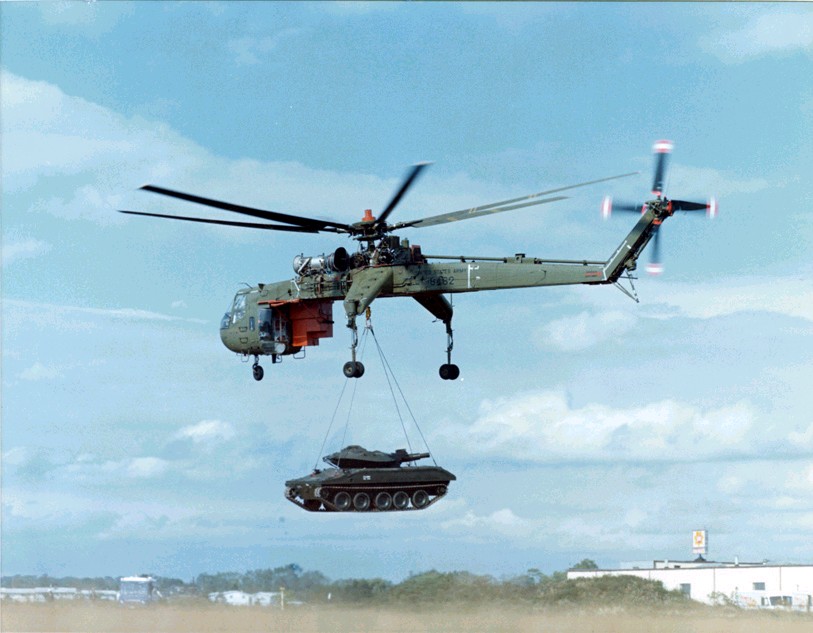
CH-54 SkyCrane lifting a 17-ton M551 Sheridan light tank; why in Vietnam the 25th light infantry Soldiers thought the 10-ton M113A1 Gavin light tracked AFV somehow weighed 13 tons and neded tracks/engine removed to fly by CH-54 is an embarrasing mystery, but is more proof that lightfighters given light tanks ad hoc is not going to maximize their potential and should be ORGANIC to these units so they can fully understand what they have.



MYTH #1 CORRECTED: We must first realize that its was the GERMANS who created and employed the first useful helicopters. Not the U.S.A. Before the helicopter the first useful vertical take-off and landing aircraft with practical application was the AUTOGYRO created by Spaniard Cierva. Both German helicopters and Japanese, Russian and American autogyros would take part in WW2 from the beginning to the end. American helicopters did not debut until the end of WW2.


MYTH #2 CORRECTED: The next lie going around comes from the egomaniac U.S. marines claiming they were the first to do helicopter this and helicopter that. The FACTS are the U.S. ARMY was the first U.S. military service to use helicopters in COMBAT in WW2. Everything else the gyrenes claim to have done in Korea are patented lies. No COMBAT helicopter air assaults into ENEMY held terrain were conducted in Korea, only rescues and the first combat rescue was done in 1945 by the U.S. ARMY using the Sikorsky R-4.
Furthermore, the USMC has botched helicopter development in an attempt to protect its Iwo Jima re-enactment ego 'n pork empire and is now saddled with packing thousands of marines like sardines into vulnerable surface ships that don't just have an unlikely nuke to incinerate them, but swarms of anti-ships missiles, sea mines and diesel-electric submarine torpedoes. Air-Mech-Strike options have been offered to the foot-slogger worshipping marines constantly over the years and they keep on blowing it by choosing the wrong helicopters. Details:
Before digressing into the various makes and models of helicopters, a reality check. The conventional helicopter due to retreating blade stall is limited to speeds ofd 250 mph if its pushed by extra thrust. If not, and its only thrust is from tilting the main rotor or rotors forward, speeds are in the dismal 150 mph range and helicopters are getting shot down today because of it.
Jet pods for Survival Speeds



Another revelation is we've known since the 1960s we can simply attach a jet engine to even just one side of a helicopter to boost its forward thrust to get 240+ mph speeds. Yet what's sickening is we did not do it for VIETNAM WAGING AT THE TIME we STILL HAVE NOT DONE IT TODAY. MEN ARE DYING NEEDLESSLY because our loser mentality U.S. military dominated by fly boy egomaniacs refuse to admit to ANY problems in their approaches to military aviation.
1. Bad dark green camouflage
2. Slow helicopter
3. Loud helicopter
4. Probably no or inadequate IRCMs
= ANOTHER AVOIDABLE TRAGEDY




American Stinger MANPADS SAM
www.youtube.com/watch?v=CyrDh2K7b8M
U.S. military refuses to make our helicopters fly faster with jet pods or Piasecki wings and vectored thrust units or quieter with NOTAR (pic attached) or even paint them in the right light gray camouflage color (U.S. Army's sin) to prevent them from being so easily shot down.
The V-22 is a mechanical monstrosity that cannot take-off and land quick enough to avoid shoot-downs lest it lose lift on one side and flips over. V-22s headed to Iraq will crash simply from being mechanically overcomplex and resultingly unreliable. The simple improvements we could make to existing helicopters to improve their survivability, the U.S. military refuses to do.
The excerpt below is a shame on both the Army and the Mc for sitting on their asses since 1960.
EXCERPT:
In the shape of the Cobra, the Army would have a real "helicopter fighter," but even this was likely to be replaced by a future "SA" or Surveillance Attack V/STOL aircraft that would also replace the O/AV-1 Mohawk fixed-wing aircraft. The Board anticipated that a number of 1960s aircraft research programs might contribute data to the SA, an aircraft that would have a maximum speed of mach 0.9. These programs included the British Hawker Siddely P-1127 jet V/STOL project, later developed as the Harrier combat aircraft, acquired by the British Royal Air Force and other world armed services including the united states marine corps. Thus, the Board was anticipating the use by the Army of dedicated "fighter" helicopters and jet-powered, V/STOL fixed-wing fighter aircraft. For the transport role between its secure bases and forward strips, the Army would, in the immediate future, use its CH-47 Chinook helicopters and its CV-2 Caribou fixed-wing transport planes, plus its UH-1 utility helicopters. The use of the CV-2 in Vietnam was to prove particularly galling for Air Force officers, many of which believed Air Force transport aircraft could better fulfi ll its role and that, in any case, all fixed-wing aircraft should be operated by the Air Force. The dispute over the CV-2 was to result in the 1966 decision by which the Army renounced its CV-2s to the Air Force (where they were re-designated C-7s) in return for the Army's retention of the armed helicopter.However, in the early 1960s, the Army had no intention of getting out of the fixed-wing business. The Rogers Board had declared that the ideal transport aircraft would combine the best attributes of the CH-47 helicopter and the CV-2 fixed-wing transport aircraft in a V/STOL airframe, but since these were then new aircraft, the Board deemed it too early to specify a replacement. As a result, the Army became involved in a tri-service V/STOL research program designed to yield what the Board described as a medium tactical transport (MTT) V/STOL aircraft which it hoped would replace the CH-47 and CV-2 around 1970.21 The resulting three- to five-ton (US) aircraft was unlikely to be a conventional helicopter and one of the research programs involved a "tilt-wing" design, a principle subsequently adopted by the marine corps with its V-22 Osprey transport aircraft.
The Board also anticipated a light tactical transport (LTT) V/TOL aircraft which might use similar technology and which would replace the entire UH- 1 utility helicopter fleet from about 1973 onwards. Thus, the Board suggested the replacement of the most numerous and important Army aircraft types by a family of aircraft, few of which might actually be helicopters in the conventional sense, including jet V/STOL fixed-wing aircraft and various other V/STOL designs such as tilting wings, tilting ducts, and gimballing propellers.
Most radically, the Board anticipated the development of an entirely new type of aircraft: the Artillery V/TOL platform, essentially a flying artillery piece it would provide the airmobile formations with indirect fire support from ground sites from which it could be rapidly re-deployed. To be available in the mid-1970s, the artillery V/TOL platform would have a secondary mission of providing direct fire support for ground units, both from the ground and from the air, furnishing the Army with yet another combat aircraft.[22]
The drafters of the Howze Report were clearly aware that, in proposing a massive increase in Army aviation, including the use of organic Army fixed and rotary-wing aircraft in the attack role, they were treading on extremely sensitive ground with regard to the division of roles and missions between the services, specifically between the Army and the Air Force. The Board was, therefore, at pains to point out that should the Army concept be adopted, the Air Force "will retain practically all of the vitally important functions it now carries with respect to the support of the land battle . . . " [23] This was really a polite way of acknowledging that the Air Force would lose at least some of those functions.
Here, the Board's conclusions may have been influenced by the Army's long-standing dissatisfaction with the quality of the close air support it received from the Air Force. Indeed, the Board suggested, by implication, the Air Force had failed to fulfill certain close air support functions and that these should, therefore, more properly be taken over by the Army. Andrew F. Krepinevich has argued that this was one of the driving forces behind airmobility, but not necessarily in the sense that the Army insisted on assuming the close support role in the fi rst instance. Rather airmobility's justification of Army attack aircraft served as a threat to force the Air Force into providing a better close air support service, or face the prospect of renouncing the role entirely.[24]
The Howze Board never intended the Army to be operating slow, loud, noisy helicopters past the '70s and to field V/STOL fixed-wing aircraft. It is possible to have carefully designed jets to be able to fly slow and agile enough to do CAS as the http://www.geocities.com/usarmyaviationdigest/fighterinabox.htm">A-37 Dragonfly, A-10 Warthog and SU-25 Frogfoot prove albeit the Harrier failed and even the former operate at an excessive fuel use precluding 24/7/365 MAS continuous overhead presence. Certainly for point A to B transport, both the Army and marines should already be using V/STOL jet aircraft and be progressed past tinkering with helicopters. An observation/attack prop plane would be needed to spot targets for the A-37s, A-10s, SU-25s to fly in from ground strip alert if their loiter times can't be improved by more fuel-efficient engines.
New York Daily News
January 23, 2007
Pg. 16Missile May Have Downed Copter
By News Wire Services
WASHINGTON - There is evidence that an Army helicopter was shot down in Iraq by a shoulder-fired missile, a senior military official said yesterday.
Searchers at the scene found a tube that could be part of a shoulder-fired weapon that may have been used to shoot down the aircraft, said the official, who requested anonymity because the investigation was still continuing.
A dozen U.S. Soldiers died when the Black Hawk helicopter crashed Saturday in the province of Diyala north of Baghdad.
Col. David Sutherland, commander of U.S. forces in the Iraqi province of Diyala, has said the crash is still under investigation.
An Al Qaeda-linked coalition of Iraqi Sunni insurgents calling itself the Islamic State in Iraq claimed yesterday that its fighters shot down the helicopter.
The posting's authenticity could not be independently verified, but it appeared on a Web site used as a clearing house for militant statements. The Islamic State in Iraq is believed to be the political wing of Al Qaeda in Iraq.
Also disturbing was the news over the weekend that insurgents were waved through checkpoints and allowed inside a provincial headquarters because they were wearing Iraqi and American uniforms and had American ID cards.
Five Americans died in the subsequent firefight Saturday.
The gunmen arrived in a convoy of seven white GMC Suburbans, a vehicle favored by Americans. After breezing through checkpoints, the force stopped at the police directorate in Karbala and took weapons but gave no reason, said police spokesman Capt. Muthana Ahmed in Babel province.
The light infantry narcissists want to ride around in helicopters instead of the armored tracks of the "mech pussies" and look sexy and look what it got them.
The damn helicopters are painted in idiotic dark green, they are too loud and too slow...and we're damn tired of hearing Army Aviator excuses why they SAY they are doing the best they can.
You strap a jet engine and you don't even need wings and you can get up to 242 mph as the Lockheed XH-51 proved in 1964.

How about having less people in each chopper and those that are inside wearing bail-out parachutes so if they get a missile warning they can bail out before being blown up?
The question is how many more have to die before they wake up and change?
And yes, stopping flights does not count as adapting. Adapting means meeting the problem head-on and SOLVING it not hiding from it hoping it goes away so you can go back to business-as-usual.
Los Angeles Times
January 26, 2007Iraq Crash Killed Key U.S. Officers
The copter went down last weekend. A missile strike is suspected.
By Associated Press
BAGHDAD
Two colonels, a lieutenant colonel and two command sergeants major were among the 12 U.S. Soldiers killed last weekend in the crash of a Black Hawk helicopter northeast of Baghdad, the Pentagon said.
It appeared to be the largest number of key officers and command sergeants killed in a single incident since the Iraq war started nearly four years ago.
The helicopter went down Saturday in Diyala province, one of the volatile regions in the Iraq conflict.
The Army has said the cause of the crash is under investigation. But a Pentagon official has said debris indicates the helicopter was hit by a surface-to-air missile.
Ten of the dead were members of the National Guard, making the crash the deadliest single combat incident for the Guard since at least the Korean War, said Mark Allen, a National Guard Bureau spokesman.
A Pentagon statement Wednesday said the victims included Col. Brian D. Allgood, 46, the top Army surgeon in Iraq, and Col. Paul M. Kelly, 45, assigned to the Joint Force Headquarters of the Virginia Army National Guard in Blackstone, Va.
Also killed were Command Sgt. Maj. Marilyn L. Gabbard, assigned to the Iowa National Guard, and Command Sgt. Maj. Roger W. Haller of the Maryland National Guard.
Command sergeant major is one of the Army's highest enlisted ranks.
The other victims were Lt. Col. David C. Canegata of the Virgin Islands National Guard; Maj. Michael V. Taylor of the Arkansas National Guard; Capt. Sean E. Lyerly of the Texas National Guard; 1st Sgt. William T. Warren of the Arkansas National Guard; Staff Sgt. Darryl D. Booker of the Virginia National Guard; Sgt. 1st Class John Brown of the Arkansas National Guard; Staff Sgt. Floyd E. Lake of the Virgin Islands National Guard; and Cpl. Victor Langarica of the 86th Signal Battalion, Ft. Huachuca, Ariz.
If Helicopters are Too Slow and Short-Ranged, How do we get them to the Foreign Battlefield?

The two main ways to transport short-range conventional VTOL helicopters is by ships and by large fixed-wing transport aircraft.

In 1956, the Royal Navy and marines were the first to do a COMBAT helicopter air assault from the sea. Earlier U.S. Army and marine helicopter troop movements during Korea were NOT TACTICAL and done behind safe friendly lines.
In 1995, U.S. Naval Institute PROCEEDINGS magazine accepted an article by 1st Tactical Studies Group (Airborne) Director Mike Sparks proposing small OH-58D Kiowa Warrior "killer bees" be located on the Navy's new Patrol Coastal (PC) ships via adding a small helipad to give the SEALS an air insertion & attack capability.


They paid him for the article, but never printed it. Did someone scare them off? Would it "rock-the-boat" (pardon the pun) too much?
www.globalsecurity.org/military/systems/ship/pc-1.htm
Its ironic, since according to John Pike of GlobalSecurity the Navy discovered the PCs were too large for coastal inshore work ie; get close enough to deliver SEAL teams by small RIB boat. Pike says:
"They have limited endurance for their size, and their combat systems and ammunition allowance do not compare well with similar ships in most other navies. They are about ten times the size of their predecessors but carry about the same payload. It was belatedly discovered that they are too large for the close inshore work for which they were intended."
Maybe if they had printed Sparks' article and added helicopter pads for small helicopters back in '95 the Navy wouldn't be getting rid of the PCs and giving them to the Coast Guard? Here's proof that A/MH-6 Little Birds were used during the 1983 invasion of Grenada to evacuate casualties onto Navy ship decks. Ironic that at the time, DoD and the Army denied that "Killer Egg" A/MH-6s were used in the operation despite amateur video going public showing the "black helicopters" in action. Here, 23 years after the fact, is a picture from DoD of a Little Bird during Grenada delivering a wounded Soldier to a Navy deck.

How did the Little Birds get to Grenada? They were flown INSIDE USAF C-130 STOL transport planes two-at-a-time and airlanded at nearby Barbados.

As a matter of fact, small O/A helicopters can be carried inside USAF transport planes carrying paratroopers who can first jump in to secure the drop zone, which then becomes an "assault (landing) zone" for the helicopters to be airlanded shortly afterwards, as the photo below proves.

Transmission-Less Helicopters and Converti-planes: Technology Ignored to our Own peril
Its clear today that the overly complex, powered rotor helicopter of Igor Sikorsky became esconced by President Roosevelt's brilliant ordering of the U.S. Navy to obtain 100 small aircraft carriers made from cargo ships and to have helicopters capable of doing anti-submarine warfare (ASW) onboard to defeat German U-boats and Japanese submarines. However, as a liberal Democrat, the political "pork" of the northeast where Sikorsky, Bell, Piasecki and Vertol made complex powered helicopters strangled simpler helicopters that could indeed go faster at less costs and maintenance headaches. James McDonnell in Missouri offered many improved simpler helicopters only to have them rejected for military service by political forces. The legacy of this corruption is our troops have been damned to slow (under 150 mph), noisy helicopters easy to shoot down and cannot fly often to do maneuver air support (MAS) and far enough to do long-range Air-Mech-Strike 3D air-ground maneuver. For a history of McDonnell's helicopters click on the link below:




The McDonnell XV-1 could go 200+ mph in the Korean war era yet the U.S. military-industrial complex would rather sell our troops conventional helicopters that fly slower and get them shot down to be killed, wounded or captured! Establishment histories complain that the XV-1 was piston-engined but the defeatist Army didn't even bother to see what it could do with a gas turbine engine.







H-21s in early Vietnam combat!
S-58 (UH-34) Choctaw


UH-1 "Huey": first U.S. turbine-engined helicopter



Late in 1954, General Gavin had appointed Howze as Head of the Army's Aviation Office in the Department of Defense. This title was later changed to Director of Army Aviation. In this role, Howze presided over the development of the UH-1 helicopter which was to provide the backbone of Army airmobility assets in the 1960s. Developed on the behalf of the Army by the Air Force, the UH-1 program only narrowly escaped cancellation by the latter service when technical problems with the rotor blades emerged. After Army protests, the Air Force agreed to persevere with the project and the technical difficulties were resolved.[80]
The Huey could sling load jeeps, M274 "Mules" and light artillery pieces (barely). General Howze in his book; A Cavalryman's Story: Memoirs of a Twentieth-Century Army General reveals that the Hueys were stripped of everything in order to lift the 105mm howitzers and could only do it a short hop away from the reviewing stands! THE SINGLE-ENGINED HUEYS NEVER LIFTED 105mm HOWITZERS IN THE HOT AIR OVER VIETNAM.


"On April 1969 a Bell UH-1 research compound helicopter established an unofficial world speed record for a rotary wing aircraft in level flight when it flew at 316 mph, accoding to a Textron Bell release. The high performance helicopter was performed under a contract with the U.S. Army Aviation Materiel Laboratories. Tests were being made to investigate rotor characteristics during operation at high advance ratios (0,716), high blade Mach numbers and aircraft maneuvers. The modified YH-40, the fourth aircraft of the UH-1 series, built in 1956, has a Lycoming T53-L-13 as its primary engine and two Pratt and Whitney JT12-A3 engines with 3300 pounds of static thrust each, on its wingtips. The aircraft features and integrated control system which allows conversion from conventional helicopter controls to airplane type controls as air speed increases above cca 150 knots."
U.S. Naval Aviation News, June 1969
The twin-jet engine pod-equipped UH-1 flew an amazing 316 mph but the Army never fielded this modification even though it would have saved thousands of lives lost from the 4, 000 helicopters lost during the Vietnam war.

Current helicopters are still too slow and noisy and thus easily shot down, but unimaginative egomaniacs at Army Aviation Branch are dedicated to being screwed up, its a passion of theirs to add no-fly zones to wherever they are to add to their continual excuses for not flying. They are so efficient at justifying BS, they will soon un-work themselves out of a job and existence, surrendering Army low level airspace and 3D maneuver to the enemy.
CH-47 "Chinook"




CH-47G "Super Chinook" Compound Helicopter Needed for 21st Century
Chinooks dropping Paratroopers at LeapFEST '2000
CH-47D Chinooks taking the fight to the enemy at high altitudes in Afghanstan!
PODS: you got it. The Germans thought of it first!


CH-54 "SkyCrane": pod concept but not fully exploited (YET)

SkyCrane carrying an ISO Container


Here 25th Light Infantry Division "Tropic Lightning" Soldiers with M113 Gavins sling-load them to a CH-54 SkyCrane for transport into battle. Lightfighters from that time period could employ light tracked armor without feeling emascuilated, so should today's light infantry since it would make them MORE COMBAT CAPABLE. For the whole story of this historic "Air-Mech" operation: AMS Ground Vehicle Photos
NEW VIDEO! CH-54 SkyCrane Pod System in Action











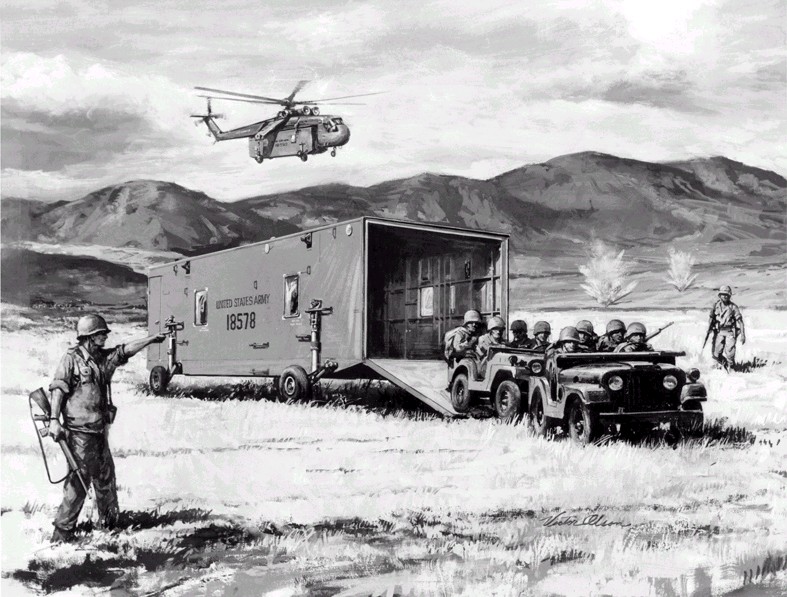
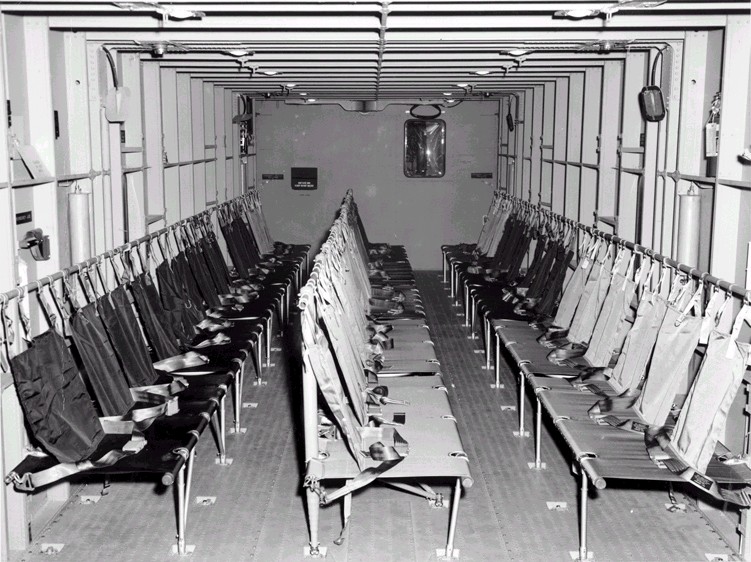
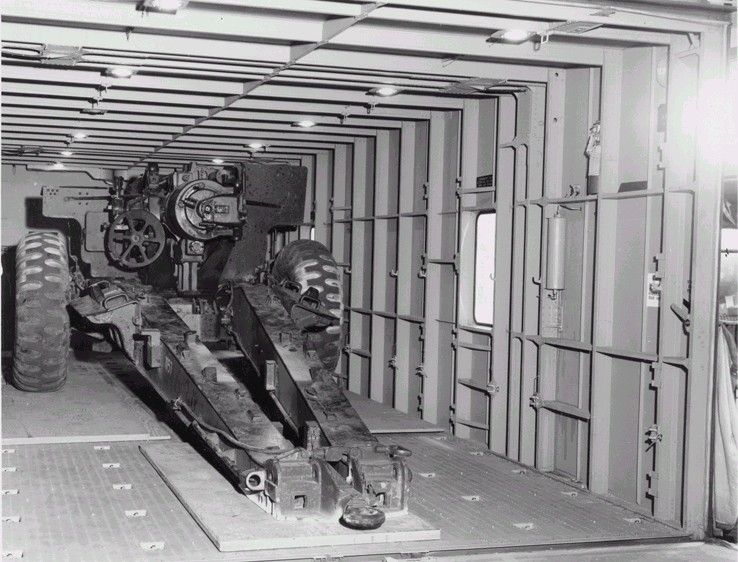
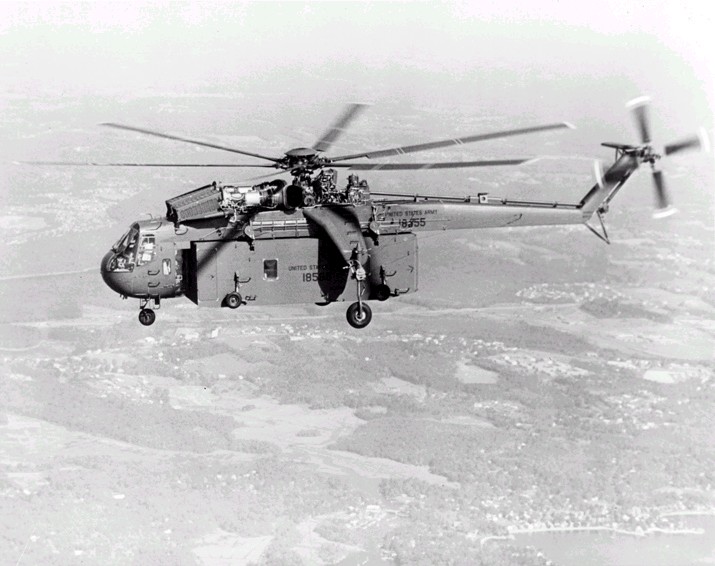
Another Air Mobility Division innovation we've lost but need to regain is the Gavin Kiwi Pod concept, except using ISO container "BATTLEBOXes" as the pods.
If the Army had brains they'd buy at least 50 x New S-64/CH-54s from Erickson AirCrane and develop a "BATTLEBOXfuel" to avoid convoys getting whacked by roadside bombs.
Fiddler's Green reports:
www.fiddlersgreen.net/AC/aircraft/Sikorsky-SkyCrane/info/sketch-ref.jpg
Other research has found that the U.S. Army's CH-54 Tarhe ("SkyCrane") heavy lift helicopter's universal cargo pods also proved very useful, for they could be used to carry up to eighty-seven troops in addition to serving as mobile hospitals, command posts or barracks.
If the Army were smart, its next Chinook should be a Piasecki SpeedCrane type helicopter that can transport ISO container "BATTLEBOXes".
Details: www.combatreform2.com/nextchinook.htm
Historical Discovery Below from Naval Aircraft Combat Developer, George Spangenberg.
Our observations:
If the Army was not so foolish wanting 22 tons for the XCH-62 Heavy Lift Helicopter (HLH) to lift the MICV (the early version of the now 33-ton Bradley) we could have had a SkyCrane that could lift 18 tons to lift M113 Gavins EASILY or the heaviest 40 foot ISO Container Battle boxes. Carry people in a pod, what's the mental block here?
We think we are going to make the same mistake with the 20-25 ton FCS that needs a non-existant FTR/JTR/HLH with a huge fuselage. At the end of the day, we might have another BS medium weight ground vehicle with no V/TOL aircraft to fly it. Not enough money even in the U.S. of A.
We need to stop trying to lift ground vehicles that are too heavy and make the light ones we have more combat capable (multiple armor layers, 1-man autocannon turrets etc.) and fly them with EXISTING AIRCRAFT for our 3D forces and use the heavier vehicles for 2D maneuver forces. Two basic forms of maneuver for the open and closed terrain types we find on planet earth.
The CH-47F has progressed to where it can carry the 10.5 ton M113A3 Gavin for short distances (about 50 miles). We should take the CH-47F's twin engines or the CH-53E's 3-engines and splice them to a SkyCrane so we can lift the 17-ton M8 Buford AGS light tank as well as ISO containerize the entire U.S. Army to get it out of its garrison doldrums and be packed and ready for war at all times. The SkyCrane configuration eliminates the sling load swinging and 100 mph speed restrictions that happens when you can't load the M113 Gavin or M8 Buford into the CH-53E's fuselage. We could make the fuselage bigger like the USMC's CH-53K but then you lose 2 tons of payload and can't lift ISO Battle Boxes.
GET RID OF THE FUSELAGE!



http://216.239.41.104/search?q=cache:Sm5mQ84_5-YJ:www.georgespangenberg.com/history2.htm+convair+p6y&hl=en&ie=UTF-8
George Spangenberg:
The next program that also is not on the chart is the CH-53E and that's because it didn't get started until after the chart was drawn, and also an HLH which also would not have been on there because it turned out to be an Army program. The whole effort really started when they deployed the CH-53A which you will remember was started in '63, flew in '64 and then deployed in early '67 to Vietnam. When it reached Vietnam the marines found that they had a problem, they had so few of these helicopters available to them and if one went down in enemy territory they could not retrieve it. The other helicopters, CH-46 for example, could be picked up either by the Army Chinooks or the 'Cranes, CH-54, or by the H-53s and brought back. It apparently became a severe enough problem that the marines got together and came up with a requirement for a crane-type helicopter with self-retrieval capability. In other words, if one went down a similar helicopter could go in and pick it up. The marines were really working quite closely with Sikorsky at the time and Sikorsky then came up with a study for a modification of the CH-53 in which they added a seventh blade, increased the rotor diameter from 72 to 81 feet, added a third engine of the same type as the other two and went to a crane-type configuration similar to the CH-54 which was also one of their designs, of course. At the time it was estimated that configuration would give a lift capability of about eighteen tons and that became really the selling point for the program. NAVAIR was willing to buy the design. In other words, if performance and the weights were agreed upon, we wanted to buy it on a directed procurement. However, the ASN (R&D) decided that we should have a competition and let other manufacturers bid. The program then ran into budget problems. The crane configuration of course was a pretty specialized one and eventually when everyone finally got together on the specification requirements, a conventional fuselage on the helicopter was required. We ended up losing a couple tons worth of lift capability when we did that so the helicopters that resulted were more like a sixteen ton lift capacity.We had proposals from Sikorsky, Vertol and Hughes, that I remember, perhaps there were others too. The Hughes was the least attractive of the three proposals. Vertol submitted a version of the Chinook. The Chinook was always a competitor for the CH-53 but the height of the helicopter was enough so that Vertol never did get around to really working out an arrangement where it fit well on the ships. The tandem arrangement of course always gave a nice compact spot, an advantage for shipboard use. Well, Sikorsky ended up winning the competition and we had only lost a couple of years fooling around with the competition rather than going with them in the first place. But it's also clear that having a conventional fuselage on the design was a good decision.
When the item went into the budget it was unfortunately called the "marine HLH." At the time the Army also had an item in the budget for an "HLH", and as presented initially, the marine version was described as an 18 ton lift, the Army design as 22 1/2 ton lift capability. The Army wanted the ability to lift any of the containers that went on container ships which explained the 22 1/2 ton lift requirement. It was basically a crane-type helicopter, although they could put container pods on the bottom to carry people as well. The Army did not have their program well defined and for several years they refused to define their long-range plans and only talked about technology, an R&D program, or a prototype program.
At the time within OSD there was an active duty Army colonel assigned to DDR&E. Naturally, he pushed very strongly for all Army programs over those of the competing services and did his best to, I'll say, mislead, he probably said, to educate, his bosses into the fact that we could have a joint program, with no need for separate marine HLH and Air Force HLHs. In his version of the DCP (the Development Concept Paper), part of the acquisition process at the time, he claimed by combining the two programs the country could save a half a billion dollars. This related to the one billion that McNamara had claimed that he could save on the joint TFX program. The Navy's stand on the DCP was actually signed by the assistant secretary of the Navy, the R&D secretary, Mr. Frosch. It seemed to him that we could probably save money by doing separate programs, that the extra costs that the marines would suffer from the size of the Army HLH was enough to pay for the development of the Navy HLH. Well, it became a big issue for a long time. The general feeling was that among those that just glanced at numbers that you certainly ought to be able to compromise with a single project if you're only talking the difference between 18 tons and 22 tons. Unfortunately, that wasn't the whole story.
The Army requirement also said they should do the lift at what I believe was a 4,000 foot altitude and at 95 at that altitude, a tough requirement. The marines also had a high temperature requirement but it was 90 at sea level, really our standard hot day requirement for the Navy.
After the big argument on the DCP and with nobody being able to agree, a joint Army-Navy-Industry study was set up in which the participants tried to arrive at a common helicopter to serve the needs or meet the requirements of the two services. It turned out about as expected that the biggest one that the marines could accept provided too little capability for the Army and the smallest one the Army would accept was too big for the marines to operate from most of our ships.
About the same time there was a budget hearing in the Congress and Mr. Foster, who was then DDR&E, was asked a question, "Why can't you combine them?" and in widely read testimony he promptly said, "Oh, we can. There's no problem to that." He obviously did not know the background at all. Well a joint program then got directed, despite the studies, by Mr. Packard, then DepSecDef. It was an extremely stupid decision and since Mr. Packard was not a stupid man, all I can conclude is that he had to have had bum dope. Eventually the working level part of the Navy and of course the marines finally got to see Secretary Chaffee, Secretary of the Navy, and appealed to him. He would not permit us to go directly to Mr. Packard but he said give him the dope and he would go to Packard, which he did. Packard made the decision then, "Well, we'll go ahead with this joint competition with the Army requirements being specified as the most difficult to meet but that it also should have shipboard compatibility requirements." If the industry proposals then confirmed the statements that we were making to Packard, he would reconsider the decision.
So the next step of course was to run the competition. Actually the Army ran it. But we had to work with them on getting the specs out and then of course later we had to evaluate the proposals when they came in. The Navy's main input to the spec of course was just ship compatibility. The marines wanted full shipboard compatibility with the LPH-2 (a former Essex class CV) and this of course gave them more problems than if they had specified a larger ship. OSD finally directed the Navy, or the marines really, to require shipboard compatibility only with the larger LHA class, the first ship of which was under construction. Since the total number of these ships wasn't really very large there was a lot of opposition to the fact that the shipboard compatibility requirements had been cut back. The Army set up their typical remote location kind of an evaluation board. Evaluation was held at Ft. Eustis, I believe. We had one representative that we sent down there and then evaluated the helicopters in place at NAVAIR. We had five competitors who submitted proposals -- Boeing Vertol, Sikorsky, Hughes, Kaman and even Gyrodyne. All the designs came in just about as we expected. The Army versions running about 120,000 pounds gross weight, and really impossible to operate in any normal way from ships. Obviously you could put them aboard the big carriers and you could operate from the decks of the LHAs but there wasn't much clearance with the island and getting them down below was impracticable. The Army ended up by recommending the Boeing Vertol design, a tandem helicopter similar to the ones that -- well, it was a big Chinook in a crane version. Had 90 foot rotors, was 150 feet or so long, with a huge operating spot on any ship. We obviously couldn't accept any of the designs.
Eventually Packard reviewed the situation. Some of the Army DDR&E people still wanted the joint program I presume because they thought that we would never get approval for two heavy lift helicopters at once. So we really argued that we (the marines) didn't have a heavy lift helicopter, we certainly were on the low side of what the Army was trying to do. Packard finally allowed us to get started again with the CH-53E. We finally got a go-ahead for the CH-53E in November of '71, a decision delayed from January of '68, so we had almost a four year delay between the time we wanted to buy the capability and the time we were allowed to get started. The situation then went from bad to worse as the acquisition system was being changed by the proponents of prototyping, "fly-before-buy", and so on. The CH-53E production release got delayed until actually 1976, although Sikorsky had built two prototypes and then two preproduction models before that production release. The first real production delivery didn't come about until late in 1980. I've always used the program as one of our best examples of how not to buy aircraft. It's very, very expensive to stretch things out that long. If a program is going to take ten or fifteen years to go from concept to fleet it's going to have a lot of changes and the costs are going to skyrocket. And when it gets there it may well be obsolete A schedule comparison of the CH-53A with the CH-53E should be instructive. If you compare the two programs, the E obviously took years longer. In fact the first production E was the fifth actual aircraft built. It was delivered some nine years after go-ahead while the fifth A was delivered in less than two years from go-ahead. The four-year delay in getting the E started was about four times as long as the delay introduced in the 53A program by those in OSD who forced the poorly conceived Tri-Service Transport Program on the services. Again, it's not the right way to buy aircraft.
To finish up the HLH, the Army went ahead with its Vertol design, but advertised it as only a technology program, with some calling it a prototype program. In their Congressional testimony, they claimed they had made no cost estimates of either the engineering development or production. This caused them all kinds of trouble in Congress of course and why they took that tack I'll never know. If they had never made any cost estimates as they claimed they should never have been allowed to get started and all the delays could have been avoided. They ran the program for a while, let an engine contract, but eventually cancelled the program after a year or two. I think that probably ends my official involvement with helicopters. I had retired before the Black Hawk and the UTTAS came along. Those were programs that probably should have ended up by replacing the CH-46 as well. A replacement for the 46 could have been a marinized version of the Army's Blackhawk."
EXCLUSIVE TO THE AMS-SG! MEET THE CH-53E SkyCrane!

We spliced a very-hard-to-find 1/72 scale model kit MH-53E Sea Stallion's 3 engines, main and tail rotors to a 1/72 scale CH-54/S-64 SkyCrane to illustrate what we could do today to effect SeaBasing and Air-Mech-Strike. No model kit exists for a 17-ton M8 Buford AGS so we did the best we could and hooked up a 8-ton Scimitar light tank with a sizable turret to illustrate somewhat that the CH-53E SkyCrane could be the AMS delivery means for a M113 MTVL Gavin/M8 Buford/Tracer 3D maneuver force. Note that the CH-53E SkyCrane has Infared CounterMeasures (IRCM) and an in-flight refueling probe to extend its range indefinitely if tankers are available.

Maximum power, minimum weight: CH-53E SkyCrane sheds 6 tons of CH-53E fuselage to become a 20-ton cargo lifter!

Note the powerful 3-engined CH-53E powertrain & 7-bladed rotor system

The streamlined CH-53E SkyCrane should fly as-is @ 200 mph!
The extra lift capability is contained within the SkyCrane's compact body
SEL: Streamlined External Loads
Instead of hanging AMS combat vehicles by sling-loading which reduces speeds to 100 mph or less without evasive maneuvering, SEL enables the SkyCrane to fly at full speed, aggressive flight profiles to evade enemy air defenses and get combat power to the ground faster.
Other views:
CH-53E SkyCrane SEL Front-View SEL SEL on the ground
SLING-LOADS: Winch-Up/Winch-Down from a hover
However, SEL does not preclude the AMS tracked combat vehicle from being winched up/down from a hover to offer deliver into tight spaces where the CH-53E SkyCrane cannot land.

A M113A3 Gavin infantry fighting vehicle is winched up to the hovering CH-53E SkyCrane
We don't have to wait 10 years and spend $10B to get a mythical "JHL" (was called FTR before) to do this; the S-64/CH-54 SkyCrane has 5 winches that can not only winch loads up and down from a hover, it can SECURE THE LOADS SNUG AGAINST ITS SKELETAL BODY SO IT CAN FLY AS FAST AND AS AGGRESSIVELY AS POSSIBLE. We can have the best aspects of sling-loading; not having to land and an ability to jettison loads while not having the bad side effects of slow, straight-line flight speeds that consumes massive amounts of fuel due to increased aerodynamic drag. Best of all, Erickson AirCrane makes NEW S-64s today, so there's no excuse why HQDA doesn't buy 25-50 immediately to stop TALKING about "Sea Basing" and start DOING it. Unless of course, the rotorheads like being fuked up, they like not being able to carry vehicles except by sling-loading so they have a built-in excuse not to fly into enemy territory....
MEET THE CH-54 SKYCRANE & ITS MULTIPLE WINCH SYSTEMS

MODULAR PODS = 3D Maneuver Air Assault "Battle Boxes"

In addition to AMS combat vehicles by SEL, CH-53E SkyCranes can lift a family of modular "Battle Boxes" in the ISO container format. Here, a Battle Box has delivered infantry with a Wiesel tracked AFV towing a 105mm howitzer artillery piece.
Army Back-Stab: XCH-62 Heavy Lift Helicopter [HLH] Prototype Destroyed to Cover up the sins of a failed U.S. Army Aviation Branch


XCH-62 in 1992...and the job it should have been doing since 1992....
As the North Vietnamese Army began to bust the South's firebases inherited from us with short-range 105mm tube artillery outgunned by the former's 130mm guns, we realized in the next war to avoid be outgunned we have to be able to fly in long-range artillery since the roads might be held by the enemy who made it difficult to get our 175mm self-propelled howitzers (SPHs) to the firebases where they were desperately needed. The Heavy Lift Helicopter (HLH) was exactly what we needed but the marines with their selfish, narrow minds had already brain-dumped how their own bases were under constant fire because they were outgunned (Khe Sanh and Camp Carroll) and congress wanted to not fund anything reminding them of Vietnam. Thus, the promising and still needed HLH was cancelled.
Recently the snobs at Fort Rucker to cover their asses of not doing their job of improving Army aviation so it can deliver ALL parts of Army maneuver units to the battlefield decided to destroy a symbol of what they should be doing, which is "air-meching": they demolished the Boeing Vertol XCH-62 prototype without telling anyone.
THE SYMBOL OF WHAT WE SHOULD BE DOING MUST BE DESTROYED AT ALL COSTS!

Many of us would have found a home for the XCH-62 and raised the money to move it. As you can see above in 1992, the XCH-62 was prominently displayed on the grass in front of the museum that's now vacant. They could have put a M113 Gavin or an early Bradley Fighting Vehicle underneath to make an inspireed display. Nahhhh....that would just remind everyone that ever since Army Aviation became its own branch/ego "flying" club its been all down hill. The father of Army aviation, General Gavin DID NOT WANT IT TO BECOME ITS OWN BRANCH/BUREAUCRACY/EGO CLUB but to stay connected to the rest of the army so helicopters would be developed that would help out the rest of the Army.
www.globalsecurity.org/military/systems/aircraft/h-62.htm
Specifications |
|
|
Manufacturer |
Boeing Vertol |
|
Length |
27.2 m (rotor turning) |
|
Width |
28.0m (rotor diameter) |
|
Height |
8.7 - 11 m (overall) |
|
Armament |
none |
|
Weight |
maximum weight: 70 Tons |
|
Payload |
19.2 tons @ 4,000 feet, 95°F temperature, out-of-ground effect 33.6 tons @ sea level, 90°F, in-ground effect |
|
Propulsion |
3 x Allison T701 turboshaft, rated at 5945kW |
|
Crew |
|
|
Speed |
|
|
Vertical Rate of Climb |
feet per minute |
|
Range |
|
The XCH-62 was a tandem-rotor, shaft-driven, heavy-lift helicopter. The XCH-62, an HLH under development at the time, was viewed strictly as a "flying truck" to be used only over friendly territory. This big "flying crane" -- the XCH-62 -- would be capable of carrying 20 tons over a distance of nearly 40km.
The U.S. Army Heavy Lift Helicopter [HLH] specification was approved in May 1971 for a 22-ton payload class helicopter. The only XCH-62 built (Serial number 73-22012) was put into storage at the US Army Aviation Museum at Fort Rucker Alabama prior to completion when the program was cancelled in October 1974. The Sikorsky S-73, not built, was the Sikorsky entry for the HLH program.
The HLH was intended to be a multi-service helicopter and as such would be available for lifting most of the heavier items of Navy and Marine Corps equipment during operations on shore which me beyond the capability of the CH-53E There were also some items of essential Army tactical equipment which were heavier than the defined lift capability of the CH-53E. The Army anticipated that with fuel and range trade-offs these, too, could be lifted by the HLH.
The Army was using the CH-54 helicopter, which was generally capable of lifting in the neighborhood of 9.5 to 11.5 tons at sea level, depending on differing operating conditions. It also used the CH-47C, the latest version of which could lift approximately 10 to 12 tons as governed by existing operating conditions.
The primary mission of the HLH would be the unloading of containerized cargo. Its 22.5 ton design point was based on the need to lift 20-foot containers having a 22.4~ton gross weight capacity. In fiscal year 1972, about 80 percent of these containers used in overseas military shipments carried cargo weighing less than 16 tons. There were only three items shipped that could gross a 20-foot container, one being ammunition. However, restrictions on the transportation of ammunition had for reasons of security and safety up to that time the, limited the use of containers for this purpose. The Army expected the magnitude of containerized ammunition shipments to increase, having obtained the approval from the regulatory agency in February 1973 to ship ammunition in its Government-owned MILVAN containers for a period of one year. The Army was also working on resolving remaining difficulties in order that it till also be able to ship ammunition in commercial containers which it uses extensively. The average gross weight of cargo shipped overseas in 20-foot containers would increase once the Army began to use them for this purpose on a regular basis.
The lift capability of a helicopter must be understood in terms of the environmental conditions and load factors in which it operates. Altitude and temperature, for example, are two factors which influence lift capability. Generally, the lift capability is greatest at sea level with low temperatures and diminishes at higher elevations and higher temperatures.
Qn June 25, 1971, the Army awarded a contract to the Boeing Vertol Company for the critical components phase of the Heavy Lift Helicopter development program. It provided for the design, construction and test of critical components of a 22.5~tom payload helicopter. The critical components comprise such items as the rotor drive system, cargo handling system, ada flight control system. From this phase the Army expecte to gain increased technical knowledge to reduce the risk of developing a 22.5 ton helicopter, and a cost data base to assure that cost estimates for such a helicopter were credible.
The HLH would be used by the Army for both logistical and tactical missions. The logistical mission involves the off-loading from ship-to-shore of containerized cargo. The HLH is needed in situations where it alone could provide this lift capability -- situations such as arise pat unimproved ports where cranes were not available on shore to perform this service. The tactical mission involves lifting heavy tactical equipment such as vehicles, artillery pieces and construction equipment for onshore operations.
The HLH still left the Army without the capability of lifting some of its heavy tactical equipment at higher elevations unless fuel and range were reduced. This is because the lift capability diminishes as elevation increases. At 4,000 feet above sea level, 95°F, for example (the Army's prime operating condition for tactical missions), the lift capability of the HLH was estimated to be 19.2 tons.
One experimental machine -- the Model 347 -- was initiated in January 1969. Vertol began a cooperative program with the Army to develop the Model 347 advanced-technology helicopter. This involved a rebuild of an existing CH-47A, #65-7992, featuring a fuselage stretch of 110"; four-bladed rotors; an aft pylon extended upward 30" to increase the distance between rotor planes (thus reducing noise levels); retractable landing gear; and elements borrowed from the Soviet Mil organization's heavy lift helicopters, including hydraulically actuated detachable wings permitting incidence control throughout the aircraft's flight envelope to improve range and payload; and a "booth" that could be extended from under the nose to house a pilot for control of crane loads.
The initial flight was on 27 May 1970 at the Vertol Division's Center 3 Flight Test Facility at Eddystone, Pennsylvania. The machine was later fitted with a fly-by-wire flight control system, and was run through evaluations for several years in the early 1970s.
Some of the Model 347's features were used to help design the XCH-62 HLH and CH-47D, including reliability improvements, flying qualities, flight control systems, external handling systems, and new hydraulic systems. Regardless, the Army could not economically justify the four-bladed rotor system or fuselage modifications in future Chinook Models. Following completion of it's test program, the Model 347 was retired from service and donated to the Army Aviation Museum.
In 1983, NASA and DARPA ( Defense Advanced Research Projects Agency) plans were initiated to resume a Heavy Lift Research Vehicle [HLRV] test program, with a possible first flight in 1985, but was cancelled again.
The helicopter sat in storage until 1987 when it was decided that it should be placed in to the U.S. Army Aviation Museum at Ft Rucker AL. In December 2005 the XCH-62 Boeing HLH helicopter at the U.S. Army Aviation Museum, Fort Rucker, was intentionally destroyed and removed The following answer was provided by Steve Maxham, Director, U.S. Army Aviation Museum [narrow-minded, snobby asshole]: "The operative reason for this item being de-accessioned is that it was never an aircraft. It never flew. It was essentially an incomplete concept model, the shell of an idea. The contract for production was halted mid-way through the project. It was never structurally completed. It was never mechanically completed. It was never electrically harnessed. There was only one rotor head produced, the second was not. There were only blades made for the one head. There were no drive train components. The upper structures both fore and aft were never manufactured. The interior was never completed. In no way, shape, or form did it qualify as an aircraft, historic or otherwise."
www.globalsecurity.org/military/systems/aircraft/h-62-milvan.htm
XCH-62 Heavy Lift Helicopter [HLH] "MILVAN" ISO Shipping Containers

In 1969 the Army requirements for a Heavy Lift Helicopter specified one that could lift a 23-ton payload at 4,000 feet altitude, 95F temperature, hover out of ground effect, 500 feet per minute rate of clime, and the ability to transport the load 100 nautical miles. These requirements were developed from a study which shows that to have a 95 percent probability of mission success a helicopter must be capable of lifting its designed payload under these environmental conditions, and in a hover out-of-ground effect. The payload requirement was based upon the Army's need to lift the following item of essential equipment: maximum loaded MILVAN container (22.4 tons), mechanized infantry combat vehicle (22 tons), self-propelled medium artillery (22.5 tons), bridging (20 tons), dozer (23 tons), air defense artillery (19-20 tons), and mobile supply vehicle (20-21 tons).
The Army subsequently received DOD and Congressional approval for an alternate helicopter design with a 22.5 ton payload at sea level, 95'F temperature, hover out-of-ground effect. At 4,000 feet altitude, 95F temperature, hover out-of-ground effect, the Army estimated the lift capability of the HLH to be approximately 19.2 tons. If this capability was realized thr Army believed in 1973 that the HLH would be capable of lifting the essential tactical equipment enumerated above by reducing the amount of fuel carried and the mission range. The helicopter's lift capability would be influenced by atmospheric and other factors. Thus, just as it estimated a 19.2.ton lift capability for the shore based missions, so did the Army estimate that given the operating conditions of sea level, 90°F, hover in-ground effect, the HLH would be able to lift containerized and other cargo weighing up to 33.6 tons.
The HLH design point was fixed at 22.5 tons so that it could handle cargo transported in containers which have a gross maximum capacity of 22.4 tons. This is the capacity of the MILVAN container, of which the Amy owned 6,700 in 1973. But by far the larger portion of the DOD's containerized shipments overseas were made under contract with commercial haulers. The 20-foot commercial container has the same 22.4.ton capacity as the MILVAN. The larger commercial containers have greater capacity. The larger containers accounted for more than 70 percent of the cargo moved. The HLH was expected to lift one of the larger-sized containers too, depending on thetr cargo-laden gross weight.
Prior to the 1970s most shipments had been by conventional breakbulk fleet. Breakbulk ships were slated to be replaced by a fleet featuring a containerized shipment system so that the percentage of containerized cargo outbound from the United States was expected by the Amy to increase by 1975 from 50 percent to about 75 percent of all cargo shipped. It was estimated by the Amy that in a combat environment ammunition represented about 60 percent (by weight) of the dry bulk cargo that would be shipped to a theater. The shipment of ammunition in the continental United States involved certain safety and security risks and was one reason why containers had rarely been used up to the early 1970s for this purpose. The Army was trying to resolve these problems so that it would be able to use containers for ammunition shipments.
The Army, in testimony before congressional committees, had stated that the Heavy Lift Helicopter's greatest impact on the operations of all types of maneuver forces would be its ability to lift the fully loaded MILVAN container in ship-to-shore and aerial port clearance movements. Army testimony was intended to cover not only the MILVANs but also the more frequently used standard commercial containers. The majority of cargo shipped overseas was loaded into 35- and 40-foot containers.
At sea level the HLH would be capable of lifting all of the larger containers loaded up to 22.5 tons and under certain conditions, some whose gross weight was higher. Although the larger containers carry most of the military cargo shipped overseas, the HLH design point of 22,5 tons was based on the proposed use of the 20-foot container loaded to its gross 22.4.ton weight. The Army statistics showed that the HLH would have been capable of lifting virtually all shipments in 20-foot containers made from the Continental United States during the fiscal year 1972.
Amy officials also stated in testimony that there were three categories of items that would fill a MILVAN container to its maximum gross weight -- ammunition, spare parts and items such as engineering barrier materiel. Due to constraints on the transporting of ammunition, MILVAN containers had rarely been used to ship this item. The Army expected the use of MILVANs for ammunition shipments to increase as a result of progress made towards resolving several of the attendant problems. It was trying to resolve problems connected with the use of commercial containers for ammunition shipments so that these, too, could be used for this purpose.
Three factors which had limited the use of MILVANs and commercial containers for ammunition shipments were (1) the difficulty of achieving economic cube utilization with ammunition-laden MILVANs, (2) problems with safety and security, and (3) the limited number of available ammunition ports which could handle these shipments.
The Army, in an Ammunition Container Criteria Study, found that then-current ammunition a pallet configurations were such that the utilization of the M.1 MILVAN payload capacity of 22.4 tons was impracticable, except for the most dense items such as bombs and large caliber projectiles. Cube utilization is particularly important in moving any cargo overseas in containers since both port handling and trans-oceanic line-haul costs are based on volume rather than weight. Significant economic penalties are incurred when container cube is poorly utilized. As of early 1973 the Army was revising its ammunition pallet configuration to permit better utilization of the full 20-foot container capacity of 22.4 tons.
The use of containers for the shipment of ammunition had also been limited by safety and security factors which required placing restrictions on transporting ammunition over highways and rail lines. Storage loading and movement of ammunition is closely regulated by various agencies including DOD, the Department of Transportation, the Coast Guard, and the Bureau of Explosives.The safety questions had been resolved to the extent that MILVAN containers were certified by the Department of Transportation in February 1973 for the shipment of ammunition for a period of one year. The Army was trying to resolve problems connected with the shipment of ammunition in commercial containers so that these, too, could be utilized for this purpose.
Most ports had only a limited capability for handling the shipment of containerized ammunition. The port facilities were being upgraded so that more will be able to handle containerized shipments.
www.globalsecurity.org/military/systems/aircraft/h-62-usn.htm
Heavy Lift Helicopter [HLH] Shipboard Operations

Sometime after 1992, the XCH-62 was pulled from the front of the museum probably because some asshole Army aviator officer didn't like that it reminded him that him and his peers were not "all that" they think they were. Here was a helicopter that was bigger than his helicopter (penis) so he had to hide it so folks wouldn't see he was lacking.
Subsequent to the publication of the Specific Operational Requirement the Navy and industry studied various methods to satisfy the Navy's needs for a helicopter with increased lift capability. One of these studies concluded that a lift capability of 17 to 18 tons was the minimum acceptable for the support of Navy operations. The primary recommendations from two other studies were: 1. An 18 ton HLH should be developed and procured as expeditiously as possible. 2. Strong consideration should be given to the development of a heavier lift vehicle in the 25 ton range to meet the outstanding requirement for large volume transport of fully laden containers and for movement of other military hardware in this payload class.
The Army in 1969 proposed to begin development of an HLH capable of lifting 23 tons under environmental conditions of 4,000 feet above sea level and 95°F temperature. Army requirements documents dating from 1969 showed a need for a helicopter designed to lift, as its primary load, equipment weighing up to 23 tons at 4,000 feet above sea level.
In August 1969, the Navy recommended to DOD that engineering development of the HLH be initiated and that immediate authorization be granted to the Navy to prepare and issue Requests for Proposals to contending contractors.
At that time, congressional interest was expressed in an HLH that would satisfy the requirements of both the Army and the Navy. A DOD task force studied the matter and concluded that a single helicopter could not be designed that would meet the Army's minimum heavy lift requirements and still be shipboard compatible. The primary obstacle was that an HLH of a size and weight needed to achieve this lift capability would be too large to be based on Navy amphibious assault ships.
In early 1970, a joint Army and Navy Working Committee was formed to study the development of a joint service HLH. A Navy HLH ationale paper used by the Committee stated that the Navy and marine corps missions supported a requirement for an HLH with a capability to lift 18 tons under the ambient conditions of sea level, 90°F temperature. The Comittee found that acceptance of a compromise multi-service HLH with a 22.5 ton payload would deny its use on service force, amphibious assault and landing platform dock ships because of its projected size and weight.
After the Congress expressed an interest in an HLH that would satisfy Army, Navy and marine corps requirements, DOD approved a program on September 17, 1970, which specified joint Army and Navy development of a compromise HLH design aimed at meeting multi-service requirements, starting with the development of critical components. The Army was designated as lead service for the phased development program.
After the Congress directed that the new helicopter be designed so that it could be usable by both the Army and the Navy, the Army accepted DOD's proposal that it reduce its requirement to a helicopter that would lift 22.5 tons at sea level, 95F, in an effort to make the helicopter shipboard compatible. With the design thus reduced, the HLH would still be too large to meet the Navy's shipboard basing requirement, namely, hangar deck basing on the amphibious assault ships (LHA and LPH classes). It could be used for Navy land based heavy lift operations. The 16-ton CH-53E, which the Navy was developing at that time, would be small enough to be operated, maintained and based on Navy amphibious ships, specifically, the LHA and LPH.
In October 1970, the Navy requested reconsideration of the September 17th decision. The Navy stressed the requirement for shipboard compatibility, the urgent need to support amphibious assault operations, and the lack of desire to expend any Navy funds toward the approved HLH which it felt it could not use. In considering their request DOD stated that the joint Army and Navy HLH would be sized and configured to meet minimum essential needs and that other alternatives could be considered later at the program review.
The DOD approved a program on September 17, 1970, which specified joint Army and Navy development of a heavy lift helicopter rated at 22.5 tons at sea level, 95°F temperature, starting with the development of critical components. Shortly thereafter, the Secretary of the Army was appointed the Source Selection'Authority and requests for quotations were released to industry in November 1970. In its Request for Proposals, the Army specified that the helicopters were to be designed within certain size snd weight limitations so that they would be shipboard compatible with the LHA.
In February 1971 the Army received proposals from five contractors for the requirements phase of the development program. Each contractor submitted its own HLH design concept. The Source Selection Evaluation Board determined that two of the designs proposed were in accordance with the limited dimensional and weight details contained in the request for quotation. However, the Source Selection Advisory Council concluded that none of the proposed designs were fully compatible with the LHA (amphibious assault ship) from an operational point of view. It further concluded, however, that the Boeing/Vertol design had a higher degree of LHA compatibility than the other designs and showed a much higher degree of appreciation of the operational requirement.
On May 7, 1971, DOD approved the award of the HLH contract for critical components to Boeing/Vertol and authorized the Navy to submit a Development Concept Paper (DCP) for a smaller helicopter, the CH-53E, that would meet its shipboard basing requirements. In May 1971, DOD notified four congressional committees (House and Senate Committee on Appropriations and House and Senate Committee on Armed Services) that the 22.5 ton HLH design will meet the shore based requirements of all services but will be too large to be routinely stationed on the LBA amphibious assault ship.
On October 14, 1971, a Defense Systems Acquisition Review Council (DSARC) meeting was held to discuss the draft DCP for an improved CH-53 helicopter program. There appeared to be considerable disagreement between the Navy and the DSARC concerning the need for the CH-53E. In commenting on the draft DCP, DSARC member(s) stated: "A review of analysis conducted to support an increased lift capability for satisfying marine and Navy requirements reveals that current DOD inventory helicopters are capable of lifting all critical combat or combat support loads in a marine amphibious assault. Further, these inventory helicopters in conjunction with the proposed DOD HLH performing the essentially shore-based missions could satisfy the Navy requirements."
On November 1, 1971, DOD authorized the Navy to proceed with the development effort for an improved version of the CH-53 helicopter, the CH-53E - limited to two prototype CH-53E's. The Conference Report on the 1972 Defense Appropriations Bill, dated 14 December 1971, directed the DOD to revise the Army heavy lift helicopter design so that it would be suitable for shipboard use by the Navy. By early 1973 the DOD, however, had not moved in the direction indicated by the Conference Report. In fact, DOD had eliminated from its advauced technology component program certain items which applied to shipboard compatibility requirements.

It had been the DOD position that it was not practicable or desirable to constrain the operational capabiltty of the Heavy Lift Helicopter so that it could be based on Navy ships. The quadricycle landing gear was eliminated from the advanced technology component program. By doing this, the Army eliminated the temporary basing/operation capability of the helicopter with the LPH and LPD class ships. Neither the Army's CH-47 nor the HLH had folding rotor blades and therefore were not deployable without physical restrictions.




www.youtube.com/watch?v=tJKnreNpnBc
MI-26 "Halo" Air-Mech of BMP-1 Infantry Fighting Vehicle




www.youtube.com/watch?v=O8OOwdwZhNI
Air-Mech-Strike Model Building: 1:72 scale Mi-26 Diorama
www.cybermodeler.com/hobby/kits/sf/kit_sf_72001.shtml
The Mi-26 Halo can air-mech a single BMP or two BMD and other type light tanks like the PT-76/BTR-50PK.
1:72 scale Mi-26
www.hobbyterra.com/product.asp?idProduct=1276
Modelers could purchase a 1:72 scale BTR-50PK or PT-76 light tank and make a sharp air-mech diorama with the Mi-26!
BTR-50PK
www.squadron.com/NoStock.asp?item=PT72054
PT-76 light tank
www.squadron.com/NoStock.asp?item=PT72053
Ka-226: Mini-Sky Crane with Pod

Without Pod...
Igor Sikorsky was Russian, too!
Not only can a hop 'n hover helicopter ill-afford dead empty weight in a fuselage, it needs stability in hovering in tight places and as far back as Vietnam, we had USAF Kaman HH-43s rescuing trapped Army troops in tight open areas because they are more stable at a hover than the tail rotor Huey.
www.aerospace-technology.com/projects/ka226
Kamov Ka-226 Sergei Light Multipurpose Helicopter, Russia

...with pod...Kamov announced the development of the new Ka-226 Sergei light multipurpose helicopter in 1990. Kamov developed the helicopter to meet the requirements of the TsENTROSPAS Russian Emergency Ministry, the Moscow City Government and Gazpromavia Airlines.
Search and rescue, medical evacuation, disaster relief and patrol variants have been developed for the Russian Emergency Ministry. Air ambulance, police helicopter, fire fighting and rescue variants have been developed for departments of the Moscow Government. A number of variants have been developed for gas field support operations for Gazprom.
Full-scale production lines for the Ka-225 have been set up at the Strela Production Association, based at Orenburg, and at the KumAPP Air Production Association, based in Kumertau. The Ka-226 entered service in 2002.
KAMOV KA-226 DESIGN
The design of the helicopter is based on the development of the proven "flying chassis" Ka-26 general purpose helicopter. Kamov has delivered 850 Ka-26 helicopters for the domestic and export markets since 1965.
The Ka-226 has interchangeable mission pods rather than a conventional cabin within the main fuselage.
The small size of the helicopter allows it to be used in urban environments and in congested areas close to the operational area of interest or the mission area. The co-axial contra-rotating rotor helicopter, characteristic of Kamov designs, is easy to fly and highly manoeuvrable. The absence of a tail rotor eliminates the threat of tail rotor accidents to ground crew.
KAMOV KA-226 COCKPIT
The flight deck is normally configured for single pilot operation and a second seat and dual controls are optional. Kamov will install the avionics and flight deck instruments to the operator's choice. A typical fit for Categories A and B visual and instrument flight rules (IFR) for poor weather operation includes a Honeywell Bendix/King avionics suite and a Bendix/King VHF radio KY196A. The navigation suite can include a Bendix/King KN53 Instrument Landing System, a KR87 automatic direction finder, a LCR 92 laser attitude heading reference system and a KLN90B global positioning system.
The instruments, displays, controls and night vision equipment allow safe night time flight. The helicopter is equipped with weather reconnaissance radar and thermal imaging systems for night patrol, reconnaissance and search operations.
The cabin is lightly pressurised, with ventilation and warm air heating.
KAMOV KA-226 CABIN
The cockpit and passenger sections of the cabin are fitted with crash resistant energy-absorbing seats.
The space to the rear of the flight deck is fitted with a quick-change and de-mountable cargo compartment or pod. This allows the fast installation of standard or special accommodation and mission equipment.
A standard cargo and passenger compartment can accommodate two bench sets for six passengers with a baggage / cargo compartment to the rear. A seventh passenger can be seated next to the pilot.
The cargo pod can also be fitted for passenger transportation with individual energy absorbing seats, mixed cargo and passenger or dedicated cargo transportation. A kit container for crew kit, rescue and medical packs is suspended from the starboard side of the helicopter. The cargo pod can be fitted with a winch ramp.
The ambulance version of the helicopter pod accommodates two stretcher patients, two seated patients and one medical personnel. For rescue missions the pod will accommodate six stretcher casualties.
With the cargo or passenger pod detached, the helicopter chassis can be fitted with other equipment such as surveillance equipment or an agricultural 1,000-litre chemical or seed hopper and spraybar. A positive pressure differential in the cabin protects the crew against contamination. The helicopter can also be operated without a passenger pod and with the open volume between the main landing gear fitted with a cargo net or cable for a slung load. The maximum underslung payload is 1,300kg.
KAMOV KA-226 PERFORMANCE
The helicopter has demonstrated long endurance and low fuel consumption flight, important performance parameters for patrol and rescue operations. The main 770-litre capacity fuel tanks provide a flight endurance of 4.24hr. With the 320-litre auxiliary tanks this is increased to 6.45hr.
A performance advantage of the helicopter, when working from bases at altitudes high above sea level and in mountainous terrain, is the high dynamic ceiling of 5,000m and static ceiling at 2,000m.
The helicopter has an 18,000hr life with a schedule service life of 25 years.
KAMOV KA-226 ENGINES
Two Rolls-Royce Allison 250-C20R/2 turboshaft engines are installed side by side over the fuselage aft of the rotor mast. The engines conform to the requirements of Category A FAR-29 for one engine inoperable safe flight. The engines are each rated at 335kW. Other engine options including Progress ZMKB AI-450, Turbomeca Arrius 2G and the Klimov VKK-800, which can be fitted to suit the customer's operating requirements.
The engines each drive individual driveshafts to the reduction gearbox supplied by OKBM Company in Voronezh.
The engine air intake is fitted with a hot air de-icing system. The de-icing systems include an alcohol windscreen de-icer, an electrical de-icer for the pitot tube, and electrothermal de-icing for the rotor blades.
The main fuel tanks have a capacity of 770 litres. Two optional external tanks provide an additional 320 litres of fuel.
Gidromash, based in Nizhny Novgorod, supplies the landing gear which consists of the main rear units mounted under the stub wings and the forward two-wheeled unit under the nose. The non-retractable landing gear has oleopneumatic shock absorbers and pneumatic brakes.
UH-60 "Blackhawk": battle-hardened successor to the Huey

Several fire departments use long "stork" legged "FireHawks" to carry water tanks and siphon hose to fight forest fires.

AMS-SG proposes longer legs and SEL attachment provisions be provided to carry so an ultra-lightweight TAFV like the Wiesel can be carried.



COUNTER-ROTATING MAIN ROTORS + PUSHER PROP
Sikorsky H-59 Advancing Blade Concept

The Army forced by preventable helicopter shoot-downs wants more speed 4 decades late and the corporate Sikorsky empire has offered the X2 which is nothing but a plate of ABC H59 program "left-overs" they are trying to cash-in on to maximize profits as they sit on their asses. Old man Sikorsky must be spinning in his grave. He would demand INNOVATION and taking risks to get the SPEED and SIMPLICITY we need on top of the payloads. Notice how close the H-59 variants with pusher prop tail units look like the 1st TSG (A)'s "MH-2001X" proposal in the animation down on this web page.

Sikorsky to Build and Test X2 Technology Demonstrator Helicopter
Jun. 01, 2005
Sikorsky Aircraft today announced plans to build and test a demonstrator for a new class of coaxial X2 Technology helicopters that maintain or improve on all the vertical flight capabilities of rotorcraft and whose high speed configuration will cruise at 250 knots.
The X2 demonstrator will feature a coaxial design (two rotors on the same axis) and a 'pusher prop' to supply auxiliary propulsion that will enable the aircraft to reach high speeds of 250 knots.
Sikorsky plans to build and fly its X2 Technology demonstrator helicopter at its Schweizer Aircraft subsidiary by the end of 2006. Preliminary design work for the demonstrator is finished and parts fabrication for the aircraft has commenced.
X2 Technology refers to a suite of technologies Sikorsky will apply to achieve new levels of speed and performance in coaxial helicopters. Coaxial helicopters feature two counter-rotating rotors on the same vertical axis.
The announcement came at the American Helicopter Society International's annual technical forum in Grapevine, Texas, where Sikorsky unveiled new scale models of X2 Technology helicopter concepts in various weight classes and configurations.
"We initiated X2 Technology convinced that the most productive and flexible helicopter is a helicopter which is capable of a significant increase in speed," said Sikorsky President Stephen Finger. "Customers are demanding greater speed but without sacrificing any of the unique capabilities that make helicopters the ideal platform for countless civil and military missions."
X2 Technology aircraft will hover, land vertically, maneuver at low speeds, and transition seamlessly from hover to forward flight like a helicopter. In a high speed configuration, one or more 'pusher props' are part of an integrated auxiliary propulsion system to enable high speed with no need to physically reconfigure the aircraft in flight.
The top cruise speed of helicopters in service today, roughly 150 to 170 knots, are only incrementally better than what they were decades ago due to the fundamental limits of conventional rotor systems.
Previous attempts to develop faster helicopters have resulted in degraded hover performance. Likewise, attempts at fixed wing or hybrid vertical lift aircraft have resulted in aircraft with less hover capability than helicopters.
Sikorsky selected the term X2 Technology in order to: describe a class of helicopters with a coaxial design and to describe the multiplying effects (2X, or times 2) of applying a suite of modern technologies to coaxial helicopters. These technologies include new rotor blade designs, advanced flight control laws, transmissions with greater horsepower to weight performance and the ability to seamlessly transfer power from the main rotor to the aft propulser, and active vibration control.
Sikorsky will also incorporate decades of company research and development into X2 Technology helicopters, including: the XH-59A Advancing Blade Concept Demonstrator which showed high speed was possible with a coaxial helicopter and auxiliary propulsion, the Cypher UAV which expanded company knowledge of the unique aspects of flight control laws in a fly by wire aircraft that employed coaxial rotors and the RAH-66 Comanche, which developed expertise in composite rotors and advanced transmission design.
Sikorsky Aircraft Corporation, based in Stratford, Conn., is a world leader in helicopter design, manufacturing and service. Sikorsky is a subsidiary of United Technologies Corporation (NYSE:UTX), of Hartford, Conn., which provides a broad range of high-technology products and support services to the aerospace and building systems industries.
Contact: Ed Steadham
Phone: 203-386-7143
Cell: 203-209-5170
esteadham@sikorsky.com
Joe Katzman's Defense Industry Daily (DID) has the best handle on the whole JHL situation....
COMBINATION FIXED AND ROTARY-WING AIRCRAFT
Future Transport Rotorcraft (FTR) now Joint Heavy Lift (JHL) candidates
The History of V/STOL Developments
Sikorsky X-Wing



S-61 with wings

Piasecki "Pathfinder" proves ducted flight controls; UH-60 is next!
No money for FTRs? or V-22s that can't be made to fly right?


Piasecki X-49A Speedhawk flight tests: quieter & faster = less shoot-downs
www.youtube.com/watch?v=Yu2CwHwxJYA
NEW! Upgrade your existing helicopters instead to compound configuration to attain 200+ mph speeds and 2,000 miles ranges with proven and safe technology:
Piasecki "Ring-Tails" and wings can be added to Army UH-60s; making them "SpeedHawks" and AH-64 "SpeedApaches" capable of diving attacks on enemy positions. Special pods can even make SpeedApaches into SF team insertion/extraction platforms...

AH-56 "Cheyenne" proves pusher prop/wings for higher speeds

Sikorsky S-72 proves stopped "X" rotor technology
NEW! AvPro's X-Wing

MH-2001X

CH-53E SPEEDCRANE: Strategic Reach
These are pics of the CH-53E SkyCrane modified into a fast compound helicopter with wings and Piasecki Vectored Thrust Ducted Propeller (VTDP) units for forward thrust and counter-torque directional control. This "SpeedCrane" could do 200+ mph and have a 2,000+ mile range.
Using a rolling take-off we get a 25% increase in payload via transitional lift thanks to the wings and forward thrust units.
Meet the CH-53E SpeedCrane!
SpeedCrane Lay-out
Rear Pilot who controls the winch and cargo hook-ups
VTDP Compound Helicopter Details
Carrying a Light tank by Streamlined External Loading (SEL)
Interface with a modular pod
GyroDyne: Free-Spinning Rotors Pushed by Forward Thrust





VIDEO: www.youtube.com/watch?v=y9633v6U0wo
Stow-Able Rotors
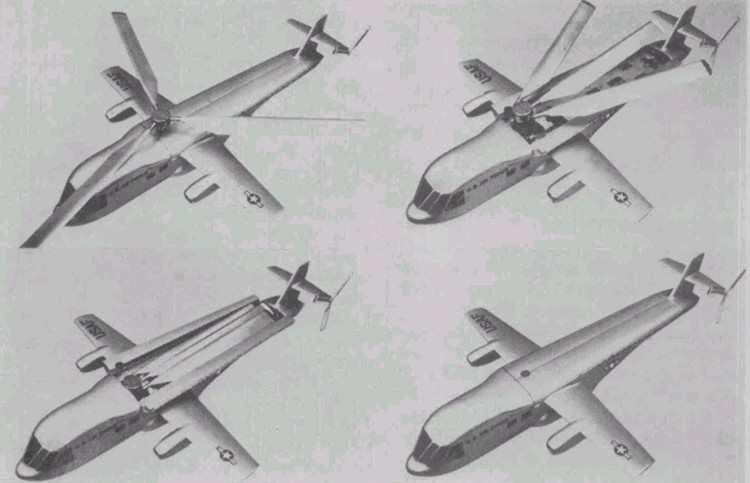
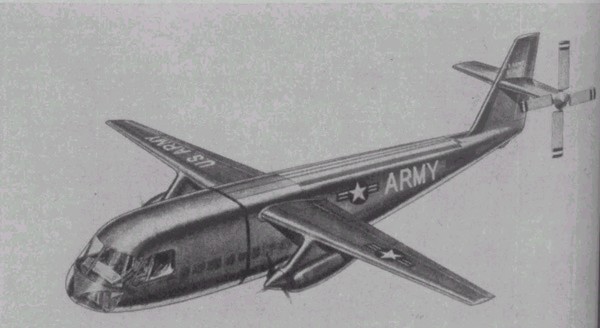
Lockheed proposed stowable rotor military transport

Vranek Disc Rotor
www.youtube.com/watch?v=CL0GkPEwKqQ
CarterCopter (CC)




Can the Carter Copter version of the V-22 save the program?
Quad-tilt-rotor

Mark Ash proposes we take the proven CH-47 and give it two small sets of wings with V-22 tilt rotors.




ANTI-GRAVITY

We offer this last form of aerospace aircraft with some degree of trepidation. Its shockingly clear that what really took place during WW2 and since then is far different than the lies we have been told. Not only did Nazi Germany have the atomic bomb, and used it against the Soviets, they created dozens of anti-gravity aerospace craft. Our 3D and 2D ground maneuver over-ran their Wunder Weapon labs in the nick of time. Another 6 months and we would all be speaking German now. Details:
Furthermore, over 250, 000 Germans escaped to South America to create the evil "4th Reich" and continued to operate anti-gravity "flying saucers" which threatened the world and even the American capital in Washington D.C. in a 1952 overflight display of power.


www.youtube.com/watch?v=TCRhMaE3yBM
Washington Post, July 28, 1952
"Saucer" outran jet, pilot revealsInvestigation on in secret after chase over capital
Radar spot blips like aircraft for nearly six hours - only 1.700 feet up
By Paul Sampson, Post Reporter
Military secrecy veils an investigation of the mysterious, glowing aerial objects that showed up on radar screens in the Washington area Saturday night for the second consecutive week. A jet pilot sent up by the Air Defense Command to investigate the objects reported he was unable to overtake the glowing lights moving near Andrews Air Force Base.
The CAA reported reported the objects traveled at "predominantly lower levels"-about 1700 feet. July 19. Air Force spokesmen said yesterday only that an investigation was being made into the sighting of the objects on the radar screen in the CAA Air Route Traffic Control Center at Washington National Airport, and on two other radar screens . Methods of the investigations were classified as secret, a spoken said.
"We have no evidence they are flying saucers; conversely we have no evidence they are not flying saucers. We don't know what they are," a spokesman added. The same source reported an expert from the Air Technical Intelligence Center at Wright-Patterson Air Force Base, Dayton Ohio, was here last week investigating the objects sighted July 19.
The expert has been identified as Capt. E. J. Ruppelt. Reached by telephone at his home in Dayton yesterday, Ruppelt said he could make no comment on his activity in Washington. Capt. Ruppelt confirmed he was in Washington last week but said he had not come here to investigate the mysterious objects. He recalled he did make an investigation after hearing of the objects, but could not say what he investigated.
Another Air Force spokesman said here yesterday the Air Force is taking all steps necessary to evaluate the sightings. "The intelligence people," this spokesman explained, "sent someone over to the control center at the time of the sightings and did whatever necessary to make the proper evaluation. Asked whether the radar equipment might have been mis-functioning, the spokesman said, "radar, like the compass is not a perfect instrument and is subject to error." He thought, however, the investigation would be made by persons acquainted with the problems of radar.
Two other radar screens in the area picked up the objects. An employee of the National Airport control tower said the radar scope there picked up very weak "blips" of the objects. The tower radar's for "short range" and is not so powerful as that at the center. Radar at Andrews Air Force Base also registered the objects from about seven miles south of the base. A traffic control center spokesman said the nature of the signals on the radar screen ruled out any possibility they were from clouds or any other "weather" disturbance. "The returns we received from the unidentified objects were similar and analagous to targets representing aircraft in flight," he said.
The objects, "flying saucer or what have you, appeared on the radar scope at the airport center at 9:08 PM. Varying from 4 to 12 in number,the objects appeared on the screen until 3:00 AM., when they disappeared. At 11:25 PM., two F-94 jet fighters fro Air Defense Command squadron, at New Castle Delaware, capable of 600 hundred mph speeds, took off to investigate the objects. Airline, civil and military pilots described the objects as looking like the lit end of a cigarette or a cluster of orange and red lights.
One jet pilot observed 4 lights in the vicinity of Andrews Air Force Base, but was not able to over-take them, and they disappeared in about two minutes. The same pilot observed a steady white light in the vicinity of Mt Vernon at 11:49 PM. The light, about 5 miles from him, faded in a minute. The lights were also observed in the Beltsville, MD., vicinity. At 1:40 AM two-other F-94 jet fighters took off and scanned the area until 2:20 AM., but did not make any sightings.
Visible two days
Although "unidentified objects" have been picked up on radar before, the incidents of the last two saturdays are believed to be the first time the objects have been picked up on radar-while visible to the human eye. Besides the pilots, who last saturday saw the lights, a woman living on Mississippi Ave., told the Post she saw a very "bright light streaking across the sky towards Andrews Air Force Base about 11:45 PM. Then a second object with a tail like a comet whizzed by, and a few seconds later, a third passed in a different direction toward Suntland, she said.
Radar operators plotted the speed of "saturday night's visitors" at from 38 to 90 mph, but one jet pilot reported faster speeds for the light he saw. The jet pilot reported he had no apparent "closing speed" when he attempted to reach the lights he saw near Andrews Air Force Base. That means the lights were moving atleast as fast as his top speed-a maximum of 600 mph. One person who saw the lights when they first appeared in this area did not see them last night. He is E.W. Chambers, an engineer at Radio Station WRC, who spotted the lights while working early the morning of July 20 at station's Hyattsville tower.
Chamber's said he was sorry he had seen the lights because he had been skeptical about "flying saucers" before. Now he said, he sort of "wonders" and worrys about the whole thing. Leon Davidson, 804 South Irving St. Arlington, a chemical engineer who made an exhaustive study of "flying saucers" as a hobby, said yesterday reports of saucers in the East, have been relatively rare. Davidson has studied the official report on the saucers, including some of the secret portions never made public, and analyzed all the data in the report.
Davidson, whose study of saucers is impressively detailed and scientific, said he believes the lights are American "aviation products"-probably "circular flying wings," using new type jet engines that permit rapid acceleration and relatively low speeds. He believes, they are either "new fighter," guided missiles, or piloted guided missiles. He cited some of the recent jet fighters, including the Navy's new " F-4-D, which has a radical "bat-wing," as examples of what the objects might resemble. Davidson thinks the fact that the lights have been seen in this area indicates the authorities may be ready to disclose the "new aircraft" in the near future. Previously, most of the "verified saucers" have been seen over sparsely inhabited areas, Davidson explained, and now, when they appear here, it may indicate that "secrecy" is not so important any more.
This is not to say that all UFOs are Germanic, some are indeed Satanic demons wence the Nazis got the technology from in the first place. By transplanting captured Nazi scientists to work in our weapons labs under Operation PAPER CLIP may have countered and defeated the 4th Reich secretly, but its now raised the possibility that America itself has become the "5th Reich" with its imperial RMA technological hubris for world domination of late.
Since those of the Wunder Weapon ilk are Cainite snobs in love with FIREPOWER its unclear if anti-gravity aerospace craft have or will be used to do 3D air-mech-strike MANEUVER employing the 50% humble Abel-like Soldiers without pretensions of making themselves into gods, but it is a possibility. Science Fiction movies like Aliens 2 have suggested the air-mech of ground vehicles by spacecraft.
